AFRICA XR REPORT











The Africa XR Report is a community initiative to map our extended reality ecosystem for the first time. Led by the editorial team of Judith Okonkwo, Dale Deacon, and Gareth Steele, it began as a zoom call between Dale, Arome and Judith in 2021. Community organisers with first-hand experience of how the XR industry continues to create jobs, empower artists, educate youth, solve business problems, and inspire experimentation.
The ecosystem is not without its challenges, however. As a tech-centric industry, there are socioeconomic barriers to entering this field, such as the availability and cost of hardware, expensive software, language and jargon, ethical debates, and internet access, to name but a few. These barriers present significant obstacles for the majority of the African continent. Despite this, some have forged a path in XR, making a name for themselves and inspiring others to get involved. One of the critical areas we chose to focus on is the celebration of those doing this inspiring work. These risk-taking digital adventurers are our role models.
A disproportionate amount of the recent discourse relating to XR has been driven by Facebook’s rebranding as Meta in October 2021 and the subsequent hype around the Metaverse. Current data from Statista (2022) shows that 21% of companies invested in the #metaverse believe the term refers to Facebook’s new name.
While the resulting hype certainly attracts some cynicism, there is no doubt that it has cast a spotlight on the extended reality technologies. Of course, there is much more to these technologies and the players, but often the conversation is steered away from talented individuals, inspiring projects, and aspirational ventures. That said, we feel that there is a need to share the stories of African developers, artists, businesses, makers, and teachers who spend their days exploring this new territory. Combine this with the remotefirst world that emerged driven by the pandemic, and it is clear that this is a topical and critical initiative.
As far as reaching the broader XR community in Africa, we weren’t starting from scratch. Dale started the weAReVR.jozi community, Judith started the AR/ VR Africa consortium, and Gareth is part of the Metaverse Crew. We’re also all members of other groups that strive to develop talent across the continent.
One of the pivotal areas we chose to focus on, is the promotion and celebration of those already doing inspiring work. These risk-taking adventurers serve as role models for other creators.
We feel that there is a need to share the stories of African developers, artists, businesses, makers, and teachers who spend their days exploring this new territory.
The African XR Report 2022 is an independent report of the African extended reality ecosystem by the community. Led by community organisers and volunteers Judith Okonkwo and Dale Deacon, this project was started to analyse the current extended reality landscape on the continent and draw attention to ongoing efforts to develop the XR technologies in Africa.
The report is presented in two parts, Part One reports on the survey conducted between February 2021 and January 2022. Part Two , which was carried out with support from Meta, celebrates the achievements and stories of the current state of XR on the continent. Meta provided this support in partnership with Africa No Filter, Imisi 3D, and Electric South we appreciate their support of this ecosystem initiative to tell our African XR story.
Thank you for your support - Abdou Khadre Diop, Adekemi Faturoti, Arome Ibrahim, Alexander Onukwe, Brian Afande, Christian Yves Fongang, Daniel Brai, Daniel Getachew, Daniel Osineye, Eugene Ohu, Hammed Arowosegbe, Helen Please, Ibukun Alade, Ifeoluwa Osunkoya, Ingrid Kopp, Joel Kachi Benson, Julian Okonkwo, Kabiru Seidu, Laurel Gbenafa, Mbangiso “Baso” Mabaso, Maged Farrag, MarieParisius Houessou, Mike Nsubuga, Mohammed Attef, Onome Ofoman, Opeoluwa Ojewale, Rick Treweek, Samia Chelbi, Syreeta Akinyede, Tegan Bristow, Toks Bakare, Tolulope Oni, Tulanana Bohela, Ulrico Grech-Cumbo, and Warith Adetayo. Cover art created in Quill by Shiferaw Yinessu (Ethiopia). Geometric artwork detailing by Tiisetso Mphuthi.
The project leads take full responsibility for this report’s research, analysis, and contents.
Judith Okonkwo Lead & Author Dale Deacon Lead & AuthorNjeri Mwagiru Research (Survey Design)
Lorna Okeng Research Engagement Lead


Mo Isu Research (Survey, Interviews)
Landry Fotso Research (Engagement, Data Analysis)


Mamadou Diallo Research


Oluwakorede Bolaji-Anibaba Research



Organisations
Net Info, Tunisia
Lab, Makarere University
Mellon University Africa
for Digital
Innovation Africa (CXI-Africa)
South
Human
The Future of Academia - South Africa
and Development - Nigeria
Collaborations - Uganda
- Tunisia
Abdou Khadre Diop Brian Afande
Christian Yves Fongang Dale Deacon Daniel Getachew Eugene Ohu Hammed Arowosegbe Ingrid Kopp
Joel Kachi Benson
Judith Okonkwo
Kabiru Seidu Laurel Gbenafa Maged Farrag Marie-Parisius Houessou Mbangiso “Baso” Mabaso Mike Nsubuga Mohammed Attef Onome Ofoman Rick Treweek
Samia Chelbi Tulanana Bohela Ulrico Grech-Cumbo TMRW - Ann Roberts / Carly Whitaker
Athenkosi Musoke, South Africa Chao Maina, Kenya Confident Niyizbyose, Rwanda Komakech Daniel, Uganda Idiat Shiole, Nigeria
Extended Reality (XR) is widely acknowledged as the umbrella term for the immersive technologies - virtual reality (VR), augmented reality (AR), and mixed reality (MR); and other aligned and similar technologies - the face filters on social media, spatial audio, haptic devices - that blur the line between physical reality and digital fantasy. While not a new concept, we see the term “metaverse” used to describe these same fields, although clear delineations are debated. Semantics aside, with a growing interest in XR solutions, there has been a lively debate between the proponents and critics of this burgeoning technological frontier.
Now more than ever, in response to the various pandemic induced lockdowns and restrictions around the globe, XR applications are being looked to as viable ways to realise personal and professional use cases to connect, imagine and learn. As a result, we’ve seen considerable growth in XR deployment across many industries. While quantifying this growth is an ongoing process, the African continent’s contribution to the global XR industry is not insignificant to us in the community. But how can we measure this? Unfortunately, there is little empirical data relative to other more established regions. Sources such as GrandView Research and Statista are predominantly focused on larger ecosystems in the US, Europe, Japan and China and can only tell us so much.
To address this issue, in Part One, we carried out a mixed-methods study utilising a survey, indepth interviews, and social media research to comprehensively analyse the African XR industry in 2021 and Q1 2022. While this is the most extensive study done to date, it is by no means all-encompassing. We were limited by language (the study was conducted in English), the reach of our call-for-participation advertising, and the scope of our personal and professional networks leveraged for the study. In the future, we aim to go deeper and broader in exploring the African XR ecosystem and its participants. That said, we’re excited to share with you our findings.
We had a higher mean than the average on the continent (19 years); over one hundred participants contributed to our survey, with 80% of respondents aged between 21 and 39.
A formally educated workforce:
79% of all respondents hold at least an undergraduate degree, with over twenty per cent holding masters degrees.
A possible indication that XR access is still severely restricted on a continent with 9% tertiary enrollment.
From the ground-up:
Freelancers and startups account for a large proportion of our respondents, with 69% working in organisations containing between 1 and 10 people. They represent the demographic that first began to experiment with XR on the continent.
response to the potentials of XR in education sector
of respondents aged between 21 and 39 79% of respondents hold at least an undergrad degree 69% work in organisations between 1 - 10 people 74%
of respondents have been unable to raise funding
4G mobile hotspots used to get online
knowledge - sought out via meetups, labs and workshops
needs for African businesses in XR
respondents use Meta hardware for VR
requirements for developing XR on the continent
Opportunity:
The education sector was the most cited as ready for disruption with XR solutions, with many respondents confident that this trend will continue.
Funding for XR remains the top concern for organisations and individuals on the African continent. 71% of respondents without funding indicate they have been unable to raise funding.
Getting online:
More people use 4G mobile hotspots to access the internet than any other method. Improved internet was the second most cited requirement for developing XR on the continent
XR learning resources such as formal courses, and as a consequence XR talent, are extremely limited on the continent.
Currently filling the gap are some community, private and non-profit initiatives, including meetups, labs, and workshops.
Business needs:
The top three needs for businesses are Funding, XR Hardware and XR Talent.
Getting Meta:
The use of Meta hardware and software dominated the survey results. The price point and quality combination have made this a market leader, winning over our respondents.
The top five requirements for developing XR on the continent, in order of importance, are Funding, XR Talent, Improved Internet, XR Learning and Resources, and XR Communities.

This section of the report contains the results of the Africa XR Report survey. Data derived from the survey is combined with social media research and information from interviews to provide insights about the African XR ecosystem in 2021. It complements Part Two, which details and celebrates stories and accomplishments from the African XR ecosystem

When the internet first made its way into the mainstream, it started with a series of technological innovations, like letting computers talk to each other over great distances or the ability to hyperlink from one web page to another. These technical features were the building blocks that enabled the functionality of the internet we know today: social networks, apps, websites, cloud storage, etc.
New building blocks have come into play with a move toward a spatially-focused metaverse. Digital events can host a crowd of avatars in a single server instance, motion-tracking tools can distinguish where a person is looking or where their hands and feet are, virtual environments can be commodified and traded like baseball cards, and so on. AR applications like Pokemon Go and quirky camera filters have normalised the use of tools that blend the virtual and the physical.
Similarly, several increasingly affordable consumergrade VR headsets have quickly grown the audience
for immersive media. Outside of advancements in hardware and software, we’ve seen similar strides in social initiatives that leverage these same technologies. As a result, these technologies are finding their way into classrooms, workshops, boardrooms, and living rooms.
These technologies can seem somewhat futuristic considering much of the continent’s discourse on digital media, over the past two decades, has (up until now) been dominated by smartphones.
The devices and platforms we use to interact with the emerging “spatial web” are changing, and the African continent’s contribution to this trend is not insignificant. But how can we measure this? Unfortunately, there is little empirical data to substantiate the claim that the African continent’s eXtended Reality (XR) efforts are making great strides. So we’ve compiled this, the first deep-dive report on Africa’s XR industry to address the issue.
The devices and platforms we use to interact with the emerging “spatial web” are changing, and the African continent’s contribution to this trend is not insignificant. But how can we measure this?
An African technology renaissance over the last decade and a half has given rise to new startup capitals in Cairo, Lagos, Nairobi, and Johannesburg, among others; an increasing influx of venture capital; the rising global profile of African tech talent (Google & Accenture, 2022); and a continental movement to shift the narrative from one of technology consumption to creation. Against this backdrop, we have witnessed the slow but inevitable rise of the African extended reality ecosystem.
The extended reality technologies have a chequered history in Africa. Sit long enough with adventurers in technology in Nairobi, Lagos, or Johannesburg, and you are sure to hear stories of experimentation with mixed results. The innovator in Lagos who tried to bring Augmented Reality products to the local market in 2013 wonders if he was just a bit too early; or the experimenter in Cairo, who leveraged international partnerships and found a
market in Europe for Augmented Reality that same year. Globally 2014 provided a significant milestone for the XR industry - Facebook’s purchase of Oculus; it would herald a steady build-up of activity over the next few years. The release of the Samsung Gear VR in November 2015 and the introduction of accessible consumer 3 DOF virtual reality in our homes. The release of the Oculus Rift and HTC Vive in quick succession in the first half of 2016; and the accompanying media frenzy querying if this would indeed be the year of VR.
And here we wondered the same, but some went even further. In 2015 Black Rhino VR set up shop in Kenya, bringing virtual reality to East Africa. Following events that same year, Electric South in South Africa and Imisi 3D in Nigeria went on to open their doors in 2016. Since then, their initiatives have continually supported and inspired communities and creators across the continent.
Black Rhino VR set up shop in Kenya, bringing virtual reality to East Africa. Following events that year, Electric South in South Africa, and Imisi 3D in Nigeria opened their doors in 2016. Since then, their initiatives have continually supported and inspired communities and creators across the continent.
Lagos VR Hackathon - a precursor to the AR/VR Africa Hackathons, attracted applications from as far afield as Botswana (for a physical event in Lagos, Nigeria). It also showcased emerging XR talent with hackers creating solutions for education, healthcare and tourism.
Oculus Connect brought together community leaders from ecosystems across the world, including Africa, to discuss global XR communities.
The continent’s first accelerator specifically focused on deep tech (including XR) - FB Startbegan in Lagos. In addition UNICEF ’s Innovation Fund selected two African XR startups to participate in its 2018 cohort in the same year. These programs provided rare injections of capital to XR innovators on the continent.
Microsoft sets up their Africa Development Centre in Lagos and Nairobi, the first XR engineering teams on the continent for a Big Tech company. A few months later, Nigerian Kachi Benson won the Golden Lion for the Best VR Story at the Venice International Film Festival.
AR/VR Africa’s hackathon goes hybrid for the first time, expanding it from a ten country event to one with 28 countries, the largest XR event on the continent. The Templeton World Charity Foundation gives the Lagos Business School a $234,000 grant for a two-year study on the use of VR for developing empathy and compassion.
The first African delegation to a global XR event showcasing XR African products and services attends Laval Virtual . African talent was also on display at the 78th Venice International Film Festival (VIFF) of La Biennale di Venezia. Venice VR Expanded played host to several Africanmade 360 films, VR worlds, and avatars.
The Africa XR Report. The community gets together to produce the first survey of the African XR ecosystem and receives funding from Meta in partnership with Africa No Filter, Electric South, and Imisi 3D to tell the stories of the ecosystem.
Before the phrase “metaverse” really caught on, many of us that worked in this field debated the semantics around “mixed reality”, “extended reality”, “immersive web” and so on (and we still do). Although there are established and rather clear definitions for each of these terms, there is a lot of overlap between them. The same can be said for the ambiguous space between web3 technologies and immersive media.
For the purpose of simplicity, whilst avoiding conflating terms, we’ve decided to discuss “XR” or “eXtended Reality” to describe the work that is done using immersive media. This umbrella term broadly covers the range of technologies (hardware and software) that allow us to blend the real and virtual worlds.
Spend enough time having discussions about this nascent ‘metaverse’, and inevitably, someone will reference fictional stories like Snow Crash, The Matrix, Neuromancer, The Lawnmower Man, Free Guy, Ready Player One, and many more that depict futures in which the populace regularly work, play, socialise, perform, and shop inside virtual environments. (Not to mention overcoming some dystopian existential crisis that typically drives these fantastical narratives forward). Combined with other pop culture ideas of holograms, camera filters, and heads-up displays, these stories serve as an imaginative reference point for what the Metaverse could look like. But what is the reality of the current state of the art?
To be clear, this report is not focused on web3 technologies as such. Many cryptocurrency and NFT projects describe them selves as “metaverse” initiatives often on the basis that a 2D image can represent an avatar, ie: representing one’s identity in the virtual world. By this same token (excuse the pun), I’d argue that a profile picture on a social media site (like MySpace, for example) is a metaverse company. I’d beg to differ.
describe the work done using immersive technology. This umbrella term broadly covers the range of technologies (hardware and software) that allow us to blend the real and virtual worlds.
For the purpose of simplicity, whilst avoiding conflating terms, we’ve decided to discuss “XR” or “eXtended Reality” to describe the work that is done using immersive media. This umbrella term broadly covers the range of technologies (hardware and software) that allow us to blend the real and virtual worlds.
Before the phrase “metaverse” really caught on, many of us who worked in this field debated the semantics around “mixed reality”, “extended real ity”, “immersive web”, and so on (and we still do). While there are established definitions for each of these terms, there is much overlap. The same can be said for the ambiguous space between web3 and immersive technologies.
For simplicity, we’ve decided to use “XR” or “eX tended Reality” to avoid conflating terms and
It’s important that we clearly delineate between blockchain technologies and immersive media technologies. They are not the same thing. Immersive media is a sensory technology. For example, an augmented reality project might allow me to see a floating goldfish swimming above my coffee table, a spatial audio experience would allow me to hear a chime coming behind me and to the left, and a pair of haptic gloves would allow me to feel the weight of a virtual cube. None of these examples has anything to do with ledgers, mining, or consen sus algorithms, which are an integral aspect of blockchain projects. Needless to say, there are projects that integrate blockchain tools and immersive media tools. Eg. ReadyPlay erMe collaborated with CryptoPunks to bring 2D NFT charac ters into VR and AR experiences. Clearly, there are XR compa nies that incorporate blockchain tech, and there are web3 companies that incorporate XR tech, but this report is focused on XR specifically.
This report is not focused on web3 technologies. First, we must delineate between blockchain and immersive technologies , which are not the same. Immersive technologies are sensory . For example, an augmented reality experience might allow one to see a floating goldfish swimming above a coffee table, a spatial audio experience would enable one to hear a chime coming behind them and to the left, and a pair of haptic gloves would allow one to feel the weight of a virtual cube. None of these examples has anything to do with ledgers, mining, or consensus algorithms, which are integral to blockchain projects.
There are, of course, projects that integrate block chain tools and immersive media tools. E.g. Ready PlayerMe collaborated with CryptoPunks to bring 2D NFT characters into VR and AR experiences. Like wise, XR companies incorporate blockchain tech, and web3 companies incorporate XR tech, but this report focuses solely on XR.
Our creators’ thoughts on the Metaverse:
Our creators’ thoughts on the Metaverse:
The Metaverse doesn’t exist in Africa

May take longer to be realised in Africa
The Metaverse offers many benefits
Hardware is a challenge for access
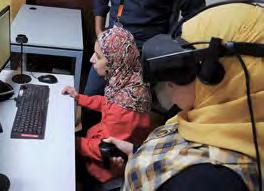
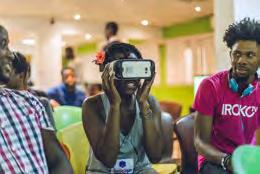
In 2020 , XR professionals across the continent came together during the pandemic to facilitate the ARVR Africa Hackathon, the largest XR hackathon of its kind on the continent. From XR community meetups in Lagos, Nigeria, the AR/VR Africa community has steadily grown, first holding a hackathon across seven countries in 2018 and last year facilitating the first African delegation to a global XR event at Laval Virtual 2021.


The community fostered here and elsewhere is wellpositioned to collate information about several nations in Africa. With our combined effort, we have produced a first of its kind report highlighting the potential of this industry for our continent, telling our stories, as we celebrate what has been and look to what is to come.
The growth of the XR industry on the continent does not rely upon any single document for its continued upward trajectory; we provide this document for our community and believe it will serve as a valuable primer for policymakers, investors, and aspiring creators.
The community fostered here and elsewhere is well-positioned to collate information about several nations in Africa. With our combined effort, we have produced a first of its kind report highlighting the potential of this industry for our continent, telling our stories, as we celebrate what has been and look to what is to come.
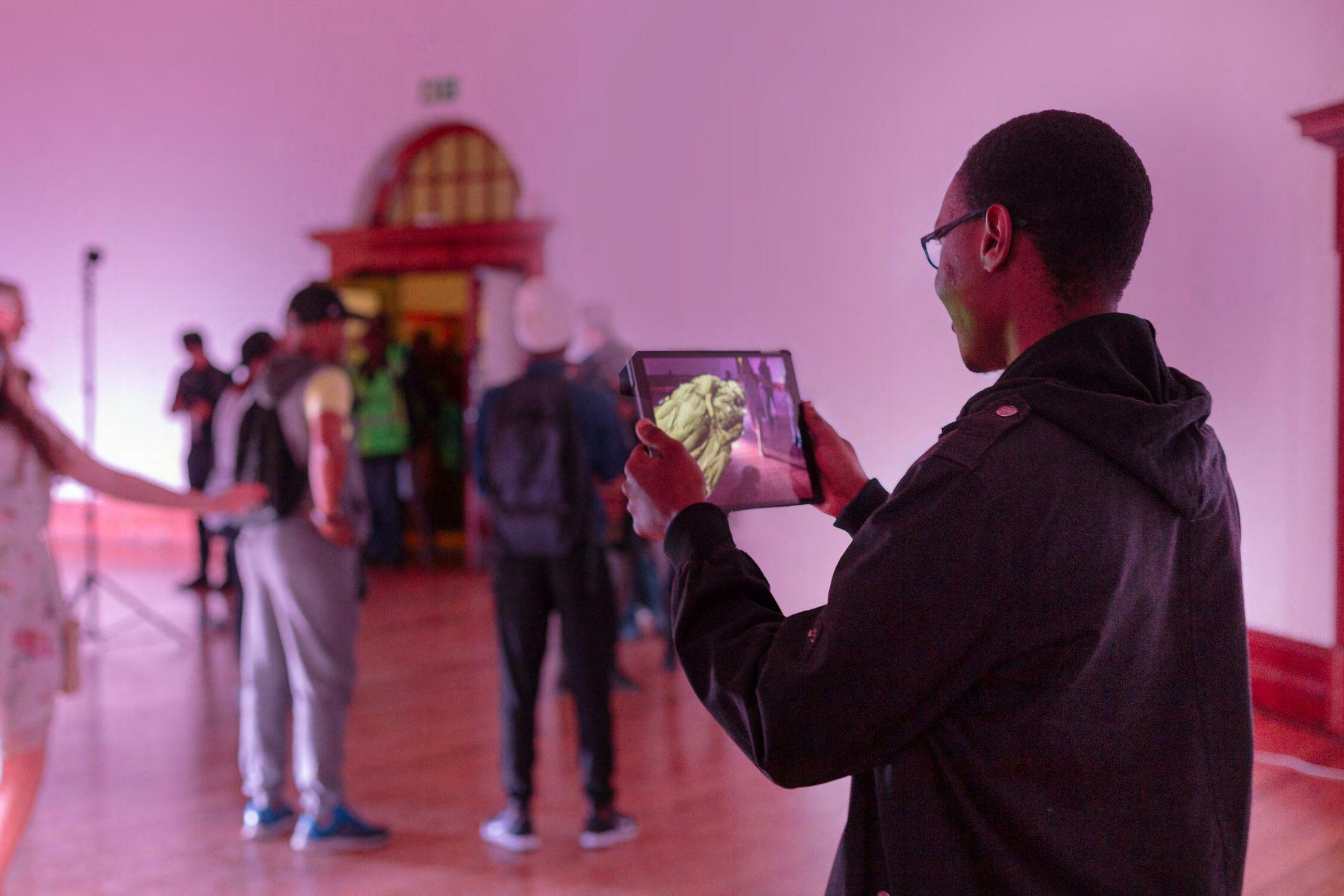

we designed this study with the highest standards of probity in consideration, we were committed to delivering (while detailing any shortcomings) the
Fortunately, we received sponsorship to dedicate the time and resources required to achieve our
For this mixed-methods study, we collected and considered data from several sources. Ultimately our goal was to utilise triangulation as a research strategy to reinforce the validity of our findings and compensate for the limitations of a single method approach (Noble & Heale, 2019). Therefore, we utilised both data and methodological triangulation as detailed below:
The survey was designed as a broad English language research instrument to obtain data from anyone engaging with the extended reality technologies on the African continent.
The survey was designed by a team with over 20 years of combined research experience in academic institutions in Africa and Europe.
The instrument collected general informa tion from all participants, including an overview of their career in XR and demo graphic information.
The instrument then accounted for variation according to engagement type for three categories of respondents - employees, freelancers, and academics . Finally, it consisted of several question types such as multiple-choice, open-ended, ranking etc.
Participants:
We received 163 valid responses for the survey; to reach the intended audience some outreach strategies were employed:
Paid social media advertising: Ads ran on three social media channels for three months to promote participation in the survey
Outreach:
The survey was shared with contacts in the research team’s network via email, WhatsApp and social media posts.
Direct engagement : the research team reached out to individuals in the XR industry, informing them of the survey and offering support where language might be a challenge.
In addition we provided survey completion incentives, initially this was the opportunity to enter a $100 Amazon voucher prize draw, subsequently we offered the opportunity to apply for a $1000 XR micro-grant.
Interviews were conducted between January and March 2022. Where possible, these were conducted in person or online via Zoom. All interviews were recorded either by the interviewer in person, a contracted stringer at the interviewee’s location, or by the interviewee, where they had professional audio recording equipment.
Participants:
29 potential interviewees were initially contacted; of this number, 21 interviews were completed during the research timeframe. Two additional interviews were carried out.
Interviewees were selected based on their activity in/engagement with the extended reality ecosystem on the African continent 1, with consideration given to representation from the five geopolitical regions on the continentas well as a variety of sectors.
23 completed interviews 5 geopolitical regions represented
Twitter is a valuable resource for user interest insights. As a social media platform, it is widely used by approximately 400 million people to share information about passions, interests, opinions and company activities in concise written form.
As a result, it was our selection to explore trends regarding XR on the continent over time and how much engagement there is with the technologies.
We employed scraping to locate tweets from Africa about AR, VR, MR, and XR from 2010 to 2022. While Twitter provides a tweet scraping API, it lacks a critical data component for usthe user’s location.
Therefore, we used snscrape, a scraping tool for social networking services, including Twitter. Using this library, we retrieved over 16000 tweets about XR in Africa from 2010 to February 2022.
tweets about XR in Africa (2010 -2022) years of tweets scraped
The following types of analysis were carried out:
Survey Data Analysis - the data was first cleaned, eliminating invalid responses (respondents outside Africa, duplicates). Further analysis was then carried out using SPSS .
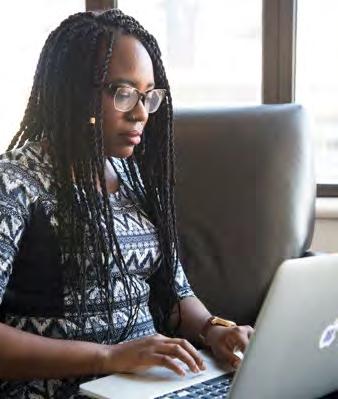
Qualitative Data Analysis - the interviews were recorded and transcribed before content and thematic analysis were carried out with MAXQDA.
Social Media Analysis - We initially analysed the data with Microsoft Power BI . We then used various libraries to analyse the emotions in the tweets, plot them, determine the countries the tweets have been posted in, locations in Africa where people are more interested in XR, what languages users interested in XR speak, and more.
The comprehensive nature of the survey was a recognised impediment to completion. Given the rigours of an industry survey, participants were asked to commit approximately 45 minutes in one sitting to complete the instrument. This was evident in the relatively low completion rate (21.6%) and average completion time (152 minutes).
Language proved to be another barrier. The survey was only available as an English language instrument; although half the continent uses English as an official or primary language, significant populations are francophone and lusophone, among other languages. While we were able to make some allowance with interpreters for Francophone participants in the in-depth interviews, we could only offer virtual bilingual support to French-speaking survey respondents.
Our reach for survey participants was also limited to our networks and communities; and the results from our ads on social media channels - Twitter, Instagram, and Facebook.
152 minutes to complete the survey (average) 21.6 % completion rate
2 languages covered 5 microgrants given to winning participants
ltd limited network reach


While we cannot determine causality, we see some overlap with other data sources. For example, our social media research picked up the most XR related tweets from Nigeria, South Africa, and Kenya in sequential order over the last 12 years, with Uganda in 6th.
While we may hypothesize the reasons for this – for instance, they are all countries with private initiatives running, specifically focused on creating access and providing XR resources - we know that our reach was limited across Africa. However, our network is robust in these countries. In addition, several variables, including language, internet access, import/ export regulations, censorship, social norms and culture, vary considerably from nation to nation within this vast continent.
Similarly, tallying the number of people active in the XR ecosystem has its challenges. Respondents must identify with the term XR, and on a
continent that is home to one-third of the world’s languages, that can be a problem.
Other factors also come into play, such as industry overlap. The dominant skill sets such as - development with game engines, programming, animation and 3D art lend themselves to multiple fields. The job market or career aspirations may well drive self-identification.
What we do know is that there are growing communities of XR professionals in several African countries, with a particular uptick over the last year, and overlap with metaverse related activities; in localized ecosystems evolving over time.

A final word, many people have not been reached by this survey, and the number of African XR professionals is growing steadily, further evidenced by the recent proliferation of African XR related bios on professional platforms such as LinkedIn.



Senegal
Nigeria South Africa Kenya Uganda Cameroon Tunisia Tanzania Rwanda Ethiopia Mozambique
Angola
Zambia
1.84%
25.77% 24.54% 17.18 % 7.98 % 4.91% 3.07% 2.45 % 2.45% 1.84 % 1.23 %
1.23%
Morocco
Namibia Mali
Ghana
Zimbabwe Egypt
DRC*
countries
by survey
0.61%
0.61% 0.61% 0.61%
0.61 %
1.23% 0.61 % 0.61%
Congo
Average age of XR creators
Age & Gender African XR Survey 2021/2022 18 - 20 4.9 %0.6 %
17 / younger
21 - 29 31.3 %
%
30 - 39 11.0 %
40 - 49 3.7%
50 - 59
A young community:
A young community:
80% of our survey respondents were between 21 and 39 years old. This is unsurprising, given that students and young professionals are the majority of attendees at XR community events across the continent.
The majority of survey respondents were aged between 21 and 39 years old. Students and young professionals are regular attend ees of XR community events across the continent, so this was not much of a surprise to us.
There is some overlap with the gaming community, which younger members also dominate; the early success of XR games like PokemonGo and Beat Saber may well have served to attract them. However, as these younger generations grow older we’ll likely see VR and AR content start to appeal to an older audience.
Considering the splashes that PokemonGo and Beat Saber made in the past few years, at this stage, VR and AR overlap quite substantially with the gaming community, which is also dominated by younger cohorts. As these younger generations age however, we’ll likely see VR and AR content continue to appeal to an older audience.
80.4% 19.6%
The majority of our respondents identified as male. While we expect this figure to decrease as infrastructural, technical, linguistic and cultural barriers to these technologies are addressed, the 20% identified as women for our survey is lower than the 30% for women in tech in Africa. This number is close to women’s participation rates (22.4%) in continent-wide XR events like the 2020 AR/VR Africa Hackathon.
To date, a majority of our respondees iden tify as male, despite the fact that more female and LGBTQ+ XR communities have emerged and grown as the medium has grown in popularity. It’s far from certain, but we expect this figure to decrease over time as technical, linguistic and cultural barriers to these technologies are addressed.
Approximately 80% of our survey respondents have a tertiary degree, with just over half holding only an undergraduate degree. However, most respondents revealed they acquired their XR knowledge on the job and by taking online courses, with less than 10% indicating XR skills acquisition at a tertiary institu tion. XR communities also featured prominently as a
Highest formal education level
Highest formal education level
Many of our respondents have tertiary qualifications (undergrad and/or masters).
Many of our respondents have tertiary qualifications (undergrad and/or masters).
learning resource. This statistic merits further inves tigation to determine if the level of awareness about XR is related to education level and subsequently influences engagement with the technologies. Addi tionally, might socioeconomic barriers to entry be lower for those with tertiary education?
This, despite reports that many XR enthusiasts and professionals alike purport
This, despite reports that many XR enthusiasts and professionals alike purport
to be self-taught. Again, this metric suggests that there are significant socioeconomic barriers to entry that are not as evident for those that can afford a tertiary education.
to be self-taught. Again, this metric suggests that there are significant socioeconomic barriers to entry that are not as evident for those that can afford a tertiary education.
University: Undergraduate degree (BA, BSc etc)
University: Undergraduate degree (BA, BSc etc)
52.1% 22.1% 10.4% 6.1%
52.1% 22.1% 10.4% 6.1%
4.9%
4.9%
University: Masters degree (MA, MSc, MPhil etc)
University: Masters degree (MA, MSc, MPhil etc)
University: did not complete
University: did not complete
Other tertiary institution (eg. Vocational College)
Other tertiary institution (eg. Vocational College)
Secondary School
Secondary School
University: Doctorate degree (PhD, DProf etc)
University: Doctorate degree (PhD, DProf etc)
4.3% 80%
4.3% 80%
of our survey respondents have a tertiary degree(approx.)
of our survey respondents have a tertiary degree(approx.)
<10%
indicated XR skills acquisition at a tertiary institution
indicated XR skills acquisition at a tertiary institution

The data sources of graphics presented will be indicated by corresponding icons or text. Overall we found alignment between data sources for the key highlights of this study, particularly the challenges and opportunities for XR practitioners on the continent.
The majority of respondents reported their career level as Senior (28%), followed by Middle, C-Suite, and Junior levels. This mid to senior skew aligns with the respondents’ type of work; the largest group were freelancers (37.4%), followed by those who work at startups (31.9%). Both circumstances in which roles can carry considerably more responsibility earlier than in more formally structured corporations. The average length of work experience, 8.37 years, also supports the seniority skew.
MiddleSeniorJunior C-Suite
MiddleSeniorJunior C-Suite 23.9%20.9% 27.0% 28.2 %
37.4%Freelancer
37.4%Freelancer
31.9%Startup
31.9%Startup
4.3%NGO 5.5 %SME
4.9%Academia 7.4 %Academia 8.6 %Other
4.3%NGO 5.5 %SME
4.9%Corporate 7.4 %Academia 8.6 %Other
Freelancers make up 37.4% of our survey respondents
The freelancers indicated their XR capabilities were predominantly in virtual reality (63.5%), while augmented reality (53.5%) and 360 video production (52.1%) were almost on par. In addition, 54.1% of survey respondents reported that they acquired their XR knowledge on-the-job. Furthermore, 50.8% cited online courses compared to the 9.2% who gained their XR knowledge from college or university and the 0.5% from high school.
When asked about previous skills or experience in fields related to XR, over half of our respondents indicated experience in design, with approximately 51% also experienced in coding. Other skills our respondents had included UI/ UX, animation and filmmaking.
VR 360
63.5%
63.5%
AR
on-the-job
54.1% online courses
on-the-job
working in virtual reality
53.5%
working in virtual reality 52.1%
53.5%
working in augmented reality
52.1%
working in 360 video production working in augmented reality
working in 360 video production
50.8% college/ university
54.1% online courses
50.8%
college/ university
9.2% high school
0.5%
0.5%
9.2% high school
Over half of our respondents indicated experience in design, with approximately 51 % also experienced in coding. Other skills our respondents had included UI/ UX, animation and filmmaking.
University: Undergraduate degree [BA, BSc etc]
University: Masters degree [MA, MSc etc]
University: did not complete
Other Tertiary Institutions
When asked about their XR hardware choices, our respondents overwhelmingly indicated they worked with virtual reality HMDs. And of these VR headsets, almost half were Meta products.
While the last few years have seen rising inequality exacerbated by the global pandemic, they have also highlighted the impending future of work shaped by automation and algorithms. In this future that has already begun, augmented and virtual reality are listed in the accelerator
University: Doctorate Degree
Secondary School
category of the world economic forum’s critical future of work technologies. This means more organisations will start to leverage these technologies to optimise the delivery of their products and services.
What about mixed reality? MR headsets are out there; mixed reality devices like the Hololens 2, Magic Leap, and
Varjo, to name a few, but their high price point and relative inaccessibility have kept them out of our respondents' hands. This is likely a contributing factor to the comparatively high uptake of VR hardware, despite the many MR use cases on the continent.
No Formal Eductation
Primary School
Creator Interview Insight:
Creator Interview Insight:
201520132011 2017 20182019
2014 201520132011 2017 201820192010
%5.9
17.6
11.8%5.9% 17.6
17.6
17.6
5.9% 5.9%
5.9% 5.9%
2014 201520132011 2017 201820192010
11.8%5.9% 17.6
17.6
17.6
17.6% 5.9% 5.9%
-
% 25
No
- 50
- 501 -
- 501 - 10
- 100
- 100
Trial and error
Funded courses
by big tech
Online learning Platforms
Respondents from small businesses ( 1- 50 employees )
Respondents from small businesses ( 1- 50 employees )
Respondents from small businesses
( 1- 50 employees )
Respondents from small businesses
1- 50 employees )
-
- 100 101 -
- 100 101 - 5001001+11 - 501 - 10
Our respondents, there was an increase in demand during the pandemic for VR products and services and augmented reality and 360 video production. In addition, the most growth in the last 12 months has been with corporate clients.
Our respondents reported an increase in demand during the pandemic for VR products and services and augmented reality and 360 video production. In addition, the most growth in the last 12 months has been with corporate clients.
Much of the work done in XR on the continent has been shaped by the XR funding available. The sector that has received the lion's share of this is the creative sector, with numerous creative economy initiatives by funders like the Ford Foundation, British Council, Goethe Institute. This was reflected in the data we received about organisations, with respondents indicating the top five sectors their businesses support: Arts, Entertainment, Gaming, Education, and Brands and Advertising. There was significant overlap with the information from freelancers, whose current top sectors for clients are Education, Entertainment, Arts, Culture and Heritage and Gaming. With Brands and advertising just after.
Much of the work done in XR on the continent has been shaped by the XR funding available. The sector that has received the lion’s share of this is the creative sector, with numerous creative economy initiatives by funders like the Ford Foundation, British Council, Goethe Institute. This was reflected in the data we received about organisations, with respondents indicating the top five sectors their businesses support: Arts, Entertainment, Gaming, Education, and Brands and Advertising. There was significant overlap with the information from freelancers, whose current top sectors for clients are Education, Entertainment, Arts, Culture and Heritage and Gaming. With Brands and advertising just after.
Challenges for organisations when integrating XR solutions were cost and lack of supporting technology. Sectors for opportunity education, gaming, entertainment, arts, and tourism.
Challenges for organisations when integrating XR solutions were cost and lack of supporting technology. Sectors for opportunity education, gaming, entertainment, arts, and tourism.
Top 3 priorities for organisations - funding, XR talent, hardware. these priorities were followed by XR learning/resources and XR communities.
Top 3 priorities for organizsations - funding, XR talent, hardware. these priorities were followed by XR learning/resources and XR communities.
The history of readily accessible consumer VR hardware starts with the smartphone. The Google Cardboard, once described as VR’s gateway drug, and the Samsung Gear VR brought the wonder of XR to people the world over; an access point that did not require expensive VR ready computers or the expensive tethered HMDs on the market. Instead, on a continent described as ‘mobile first’ and ‘mobile-only,’ the smartphone has become a tool for unconscious XR consumption. The filters our young people engage with on social media, the YouTube 360 videos watched using cardboards or other generic HMDs based on their design.
By 2025 an estimated 615 million people will have mobile subscriptions, 50% of the African population; consider this against the backdrop of a country like Cote D’Ivoire, where mobile penetration currently stands at 95% in contrast to 1% for fixed lines. It seems then that mobile XR hardware options might be a natural fit for the continent, and there have been attempts to explore this further. For example, Meta’s 2018 FBStart
accelerator supported a student project at the University of Lagos, Project Move, experimenting with inside-out tracking for mobile device driven VR. The year before, Hardware Lagos and Imisi 3D sponsored a mobile device inspired design challenge to create an all-in-one solar powered VR headset. But there is not yet enough investment in research and development to make this tenable.
Even as we acknowledge the impact that mobile technology and smartphones have had on the continent, we do it with extreme caution when it comes to XR. Given the historic reticence for engaging Africa in the global XR ecosystem and the already critical lack of access to XR hardware, we are wary of amplifying the existing erroneous notion that XR hardware is not required here. To be clear, all XR devices from the Varjo to the Hololens 2 to the Quest to the generic VR box (and everything in between) must be available on the continent. In fact, this was listed as the number two requirement, second only to funding, for businesses in our survey.
Even as we acknowledge the impact that mobile technology and smar tphones have had on the continent, we do it with extreme caution when it comes to XR.
of
When asked about their XR hardware choices, our respondents overwhelmingly indicated they worked with virtual reality HMDs. And of these VR headsets, almost half wer e Meta products.
When asked about their XR hardware choices, our respondents overwhelmingly indicated they worked with virtual reality HMDs. And of these VR headsets, almost half were Meta products.
What about mixed reality? MR headsets are out there; mixed real ity devices like the Hololens 2, Magic Leap, and Varjo, to name a few, but their high price point and relative inaccessibility have kept them out of our respondents’ hands. This is likely a contributing factor to the comparatively high uptake of VR hardware, despite the many MR use cases on the continent.
What about mixed reality? MR headsets are out there; mixed reality devices like the Hololens 2, Magic Leap, and Varjo, to name a few, but their high price point and relative inaccessibility have kept them out of our respon dents' hands. This is likely a contributing factor to the comparatively high uptake of VR hardware, despite the many MR use cases on the continent.

VR
Oculus (Meta) dominates the VR hardware discussion. This is partly due to the accessible costs of several Oculus headsets, which have become more affordable. Although there are some viable competitors, Meta's headsets strike a balance between quality and affordability.
Oculus (Meta) dominates the VR hardware discussion. This is partly due to the accessible costs of several Oculus headsets, which have become more affordable. Although there are some viable competitors, Meta’s headsets strike a balance between quality and affordability.
What hardware do you work with?
What hardware do you work with?
What challenges do you face when integrating XR solutions?
Cost
69.1 %
Cost
Lack of supporting tech
47.7%
69.1 %
Lack of supporting tech
47.7%
45.6 %
Lack of a business case
Lack of a business case
Proving ROI Other
Problems integrating with existing systems and processes 36.2% 35.6% 3.4%
Proving ROI Other
45.6%
Problems integrating with existing systems and processes 36.2% 35.6% 3.4%
Additional challenges identified
Additional challenges identified
Additional challenges identified
The development of the XR indus try in Africa is hindered by various challenges, which form a repetitive story across the continent.
Some of the significant challenges identified by our survey respon dents and the XR creators we interviewed include limited access to hardware and software, access to funding, skills gap, poor market familiarity with the technology, in adequate infrastructure and a lack of human resources.
Limited access to hardware and software
Limited access to hardware and software
Poor market familiarity with the technology
Poor market familiarity with the technology
Access to funding Skills gap
Access to funding Skills gap
Poor infrastructure
Poor infrastructure
Lack of human resources.
Lack of human resources.
What challenges do you face when integrating XR solutions?
In the interviews, 42.9% of XR Creators identified access to hardware and software as a significant challenge. However, 64.1% and 54.7% of survey respondents found hardware costs and hardware availability a challenge for their businesses.
One of the reasons hardware cost and availability are issues is because manufacturers do not sell their XR hardware in Africa, despite having offices on the continent. For creators to access XR equipment, they must place orders online and compound the not inexpensive cost of hardware with shipping and customs fees. In some African countries like Nigeria, where the purchasing power of the local currency is relatively low, this further compounds the problem. Some African countries are also not included in the foreign sellers’ lists of shipping destinations.
So even when they can raise funds to buy equipment, they are confronted with the issue of getting them to the continent. Shipping times are often too long and can get delayed. “I remember when I ordered my Quest 2, it took like a month plus to get here,” reported one of our XR interviewees. To solve this problem, African XR creators resort to taking roundabout routes by either going abroad to buy hardware themselves or finding someone to bring it to the continent for them, which speeds up delivery times and can sometimes be cheaper.
One of the reasons hardware cost and availability are issues is because manufacturers do not sell their XR hardware in Africa, despite having offices on the continent.
For creators to access XR equipment, they must place orders online and compound the not inexpensive cost of hardware with shipping and customs fees. In some African countries like Nigeria, where the purchasing power of the local currency is relatively low, this further compounds the problem. Some African countries are also not included in the foreign sellers’ lists of shipping destinations.
So even when they can raise funds to buy equipment, they are confronted with the issue of getting them to the continent. Shipping times are often too long and can get delayed.
Over the last few years, the global demand for XR talent has been documented. Meta’s October 2021 announcement of its intention to create 10,000 Metaverse jobs in the EU indicates much more to come.
The problem, however, is particularly exacerbat ed on the continent, with the availability of XR talent listed as a top 5 challenge for businesses by our survey respondents.
A similar sentiment was expressed by the in terviewees who shared their experiences, with some resorting to the global talent pool outside the continent.
And the talent shortage is exacerbated by the lack of XR learning options on the ground.
Our review of educational institutions with XR courses on the continent revealed a minimal offering concentrated in South Africa. And even these options are rarely fully developed XR pro grams. Instead, they are often individual modules as part of a certification or diploma.
Since many Africans are unfamiliar with XR technology, creators can struggle to find talent to work with, clients to work for, and users for the XR market. If a curriculum were to be developed around XR in African secondary and tertiary institutions, this would help increase awareness, expand the talent pool, and reduce the knowledge and skills gap currently being experienced.
On the jobCollege / UniversityHigh School
Online Courses
Online Courses
55.8%50.3%8.6%0.6%
On the jobCollege / UniversityHigh School 55.8%50.3%8.6%0.6%
If a curriculum were to be developed around XR in high schools and African universities, this would help to expand the talent pool and reduce the knowledge and skills gap that is currently being experienced.
Since many Africans are unfamiliar with XR technology, creators can struggle to find talent to work with, clients to work for, and users for the XR market.
“I think one broad category of problem is infrastructure. So access to high bandwidth, Internet, and just consistent power,” said one of our XR creators. Internet connectivity and electricity are two essential tools for XR, and they are not as cheap, readily available and reliable as they ought to be. This is evidenced by internet penetration on the continent being 40%. Lower than the global average, despite the year on year increase that has the continent accounting for 11.5 per cent of the total internet users worldwide in 2020.
Statistics from The Cable’s Worldwide mobile data pricing for 2021 show that SubSaharan Africa is the most expensive region globally for mobile data, even though most of the internet connections in Africa are accessed via mobile, as was the case for our respondents.
Our survey showed that 51.2% access the Internet via 4G Mobile Hotspot, while only 15.9% via broadband.
This is partly because mobile connections are more flexible and cheaper than fixedline broadband connections. There are several global and Africa focused initiatives to improve connectivity. Starlink has announced its intention to start providing services in Nigeria and Mozambique by Q3, 2022, and work is progressing on Google’s subsea cable, Equiano. It will run along the West Coast of Africa, originating in Portugal and terminating in South Africa, with branching units to extend connectivity to additional African countries.
According to an impact assessment study by Africa Practice and Genesis Analytics, the arrival of Equiano is expected to increase internet speeds by a factor of six, reduce internet retail prices by 21%, and increase internet penetration by six percentage points.
Connect to the internet with a 4G Mobile Hotspot
Access the internet via Broadband connection
Sub-Saharan Africa is the most expensive region in the world for mobile data
The Cable Worldwide Mobile Data Pricing 2021
Infrastructure - Internet Access
I think one broad category of problem is infrastructure. So access to high bandwidth, Internet, and just consistent power,”
Regarding electricity, the International Energy Agency states that Sub-Saharan Africa’s share of the global population without access to electricity rose to 77% from 74% before the COVID-19 pandemic.
With regards to electricity, the International Energy Agency, in its report, SDG7: Data and Projections, stated that Sub-Saharan Africa’s share of the global population without access to electricity rose to 77% from 74% before the COVID-19 pandemic. While the majority of Africans still rely on power from the grid, as 92.7% of our survey respondents indicat ed, a report by Afrobarometer reveals that fewer than half (43%) of Africans enjoy a supply of electricity that works “most” or “all” of the time.
While the majority of Africans still rely on power from the grid, as 92.7% of our survey respondents indicated, a report by Afrobarometer reveals that fewer than half (43%) of Africans enjoy a supply of electricity that works “most” or “all” of the time.
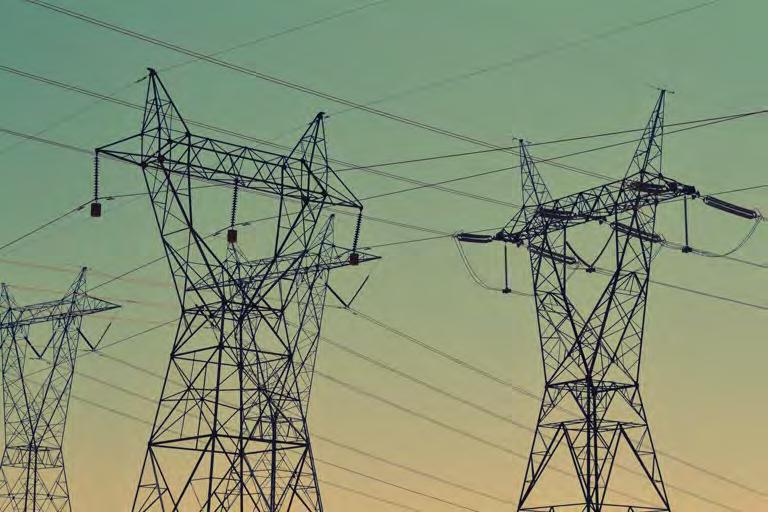
When it comes to access, the same report found that fewer than six in 10 African households (57%) are actually connected to an electric grid.
When it comes to connectivity, the same report found that fewer than six in 10 African households (57%) are actually connected to an electric grid.
These figures show why electricity remains a challenge to the growth of the XR industry on the continent. Those who can afford it turn to alternative sources of electricity like the 31.7%, 13.4% and 7.3% of our respondents who use generators, inverters and solar power respectively to supplement their electricity.
These figures prove why electricity remains a challenge to the growth of the XR industry in Africa. As such, Africans who can afford it, turn to alternative sources of electricity. Although these options are not cheaper, the issues of connectivity and reliability are greatly eliminated.
Funding was the number one
our study
for organisations
respondents’ top
for advancing XR on the continent.
It is a challenge when you consider the billions invested in XR globally over the last decade compared to negligible amounts on the African continent. For
context, one XR startup - Magic Leap, has received investments totalling $3.5 billion. In 2019 Africa’s entire startup ecosystem received $2.02 billion, the highest amount ever invested at the time.
Funding remains a critical factor gap in developing the African XR industry; 71.8%
of survey respondents listed it as a significant challenge. The majority of those who had access to funds (61%) indicated they were provided via grants. Equity, friends and family were also cited as sources of funding by a quarter of the respondents.
In some parts of the world, governments and big corporations have driven access to funding, though the same cannot be said for Africa. For example, in Europe, EU research funds have supported over 450 projects connected to AR and VR, with around $1 billion since the 1990s. Another example is the Hori zon EU program, which has delivered over 80 billion euros in funding over seven years.
However, we struggled to find commensurate engagement from African governments, although some initiatives are leveraging the XR technologies to promote various strategic agendas in science and technology, such as the ten-year BTVET Skilling Uganda program.
were announced in March 2022, who will each receive funding of up to $30,000 and participate in XR-industry events to showcase their creativity and drive interest in their projects. In addition, they will access mentorship from Electric South and Imisi 3D. This year, mobile device chip firm Qualcomm Technologies launched its $100m Snapdragon Metaverse Fund in March. The fund is a launchpad for extended reality (XR) developers and companies building the foundational technologies and content ecosystem to enable the metaverse.
Over the last decade, enormous sums have been in vested in the XR industry. Unfortunately, the amount of that money that has made its way to the continent is negligible. Although, we hope that is starting to change. Microsoft has invested in Africa Develop ment Centres in Lagos and Nairobi with Mixed Reality engineering teams. In 2021, Meta launched a $50 million XR Programs and Research Fund to invest in programs and external research over two years. In Africa, Meta partnered with Africa No Filter, Electric South and Imisi 3D to establish the Future Africa Grant for Extended Reality Creators, under which the Future Africa: Telling Stories, Building Worlds program was created. Six finalists of the program
However, apart from grants and funds set up by big tech companies and funding from private organi sations, creators are also looking to access funding from the public. After all, “In an artistic sense, it makes sense to send more funding input from the public sphere to XR, but it also makes logical sense from an economic perspective because businesses are being made, new products are being sold. So there’s a lot of financial activity going on here too,” said one of the XR creators interviewed for this report.
Yes No48.3% 51.7%
As we look toward a vibrant funding landscape for the XR Industry in Africa, creators will continue to self-fund, engage in XR competitions, apply for grants, and embark on commercial work like virtual productions and adverts.
61%
Yes No48.3% 51.7% 61%
Accessed funding via grants
Accessed funding via grants
25.4%
25.4%
Received funding from family and friends
Received funding from family and friends
25.4% Accessed funding via equity
25.4% Accessed funding via equity
The opportunities in XR are numerous. While the challenges for those who engage with XR are evident, less so might be the sectors where XR creators believe the technology will have the most impact. In this section we consider the sectors our respondents identified as opportunities, and sectors with significant proliferation of the XR technology. The largest percentage of respondents (73.7%) identified Education as an area of opportunity, while Banking and Finance had the least percentage of respon dents (16.2%).
Recent research has projected that the metaverse could contribute $40 billion to the African economy. The opportunities in XR are numerous. While the challenges for those who engage with XR are evident, less so might be the sectors where XR creators believe the technology will have the most
impact in Africa. In this section, we consider the sectors our respondents identified as opportunities and those that have seen rapid technology uptake. The largest percentage of respondents (73.7%) identified Education as an opportunity, with Banking and Finance selected by the lowest percentage of respondents (16.2%).
The top 5 sectors where organizations see opportunities
Of creators view Education as the area with the most opportunity
Of creators view Banking & Finance as the area with the least opportunity
Potential global economic impact of the metaverse
https://qz.com/ africa/2167424/metapredicts-the-metaversecould-add-40-billion-toafricas-economy/
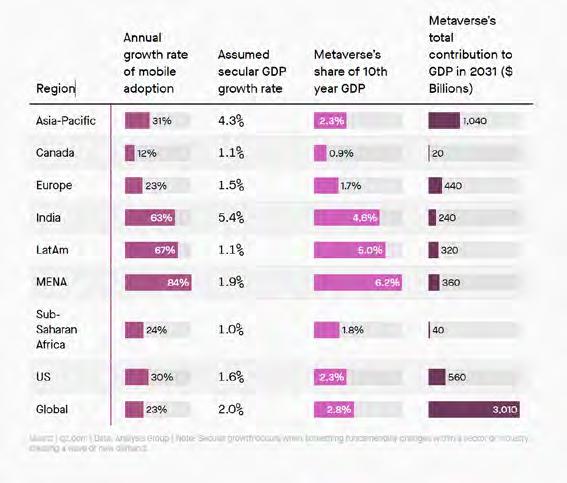
Recent research has projected that the metaverse could c ontribute $40 billion to the African economy.
Survey respondents from organisations noted an increase in dema nd for XR during the pandemic. The most growth was seen with corporate clients. While demand was seen across all aspects of XR, the greatest was for virtual reality products and services, followed by augmented reality and 360 video production.
The top 5 sectors where they see opportunities are the Arts (50 .8%); Entertainment (44.4%); Gaming (41.3%); Education (39.7%); and Brands & Advertising (33.3%). Incidentally, these sectors have attracted the most XR funding and support on the continent to date. The creative sect or has seen funding for XR initiatives in the arts from organisations like Meta, GIZ, Goethe Institut, the Ford Foundation and the Bertha Foundation. Their support typically funds workshops or other one-off developmental initia tives and occasionally production.
The type of opportunity respondents see, overwhelmingly - training! That said, other sectors are not neglected. Here are some examples of emerging African initiatives:
Soda Studios (Johannesburg, South Africa) made its foray into the Metaverse entertainment scene with its hybrid events featuring inhouse DJs and performances and now virtual chat platform world replicas that offer visitors a rich audiovisual experience. There’s the same traditional allure of live performance and social for the live audience, but it’s in the virtual world that handpicked elements are created and streamed to audiences further afield. The stage just got a whole lot bigger. Eg Moonchild Sanelly live in VRSoda Studios
XR solutions for healthcare are emerging on the continent.
For example, in South Africa, Eden has developed the Eden Wellness Station, a virtual reality solution for engaging children in hospitals (see Significant Projects). In Nigeria, Imisi 3D worked with AskToks to co-create Autism VR, a voice-driven virtual reality game to raise awareness of autism and provide information that can support engagement with children on the autistic spectrum.
The game is currently in development and was part of a UNICEF pilot program to test their policy guidance on the use of AI for children.
Several countries are working on tourism projects, many linked to heritage and culture. The Shyllon Museum in Nigeria and Experis Immersive are collaborating on a digital museum; in Ethiopia Guzo Technology is working with the government to launch a digital museum; and there are similar projects in Tunisia
Culture and Heritage use cases provide an opportunity for new ways of memorialising African history and culture. In a continent where much is made of oral histories, this medium offers a tool to preserve that for the future, for all. Google Arts and Culture has been a significant funder of initiatives in this sector globally, and one of the very few in Africa. Examples include the work supported at the Osun Osogbo Grove, one of two UNESCO world heritage sights in Nigeria.
“We’ve also begun a licensing business. Since our teams have been out in the wild filming lots of different species of wildlife in the cinematic VR offering, a lot of that content belongs to us and increasingly, when we go out there, we charge the client less in exchange for being able to retain some rights to our own content. What that means is, we’re now sitting on the world’s biggest library of wildlife VR content, and in a world where production crews from the US and from all around the world can’t travel to shoot, they are licensing the stuff from us, which is really cool.”
“So I feel like, given the opportunity, the barriers of entry for the metaverse for Africans is still very high. I don’t think Africans can talk about the metaverse. It doesn’t exist in Africa because of the limitations of access. But once Africans look at accessibility as an issue and overcome that hurdle to a reasonable extent then you can have Africans coming with powerful use cases of the metaverse.”


This section of the report tells the stories of the African XR ecosystem. It provides snapshots of our activities, resources and communities. It also celebrates many who have done pioneering work in the field on the continent. The section was completed with support from Meta, in partnership with Africa No Filter, Electric South, and Imìsí 3D.



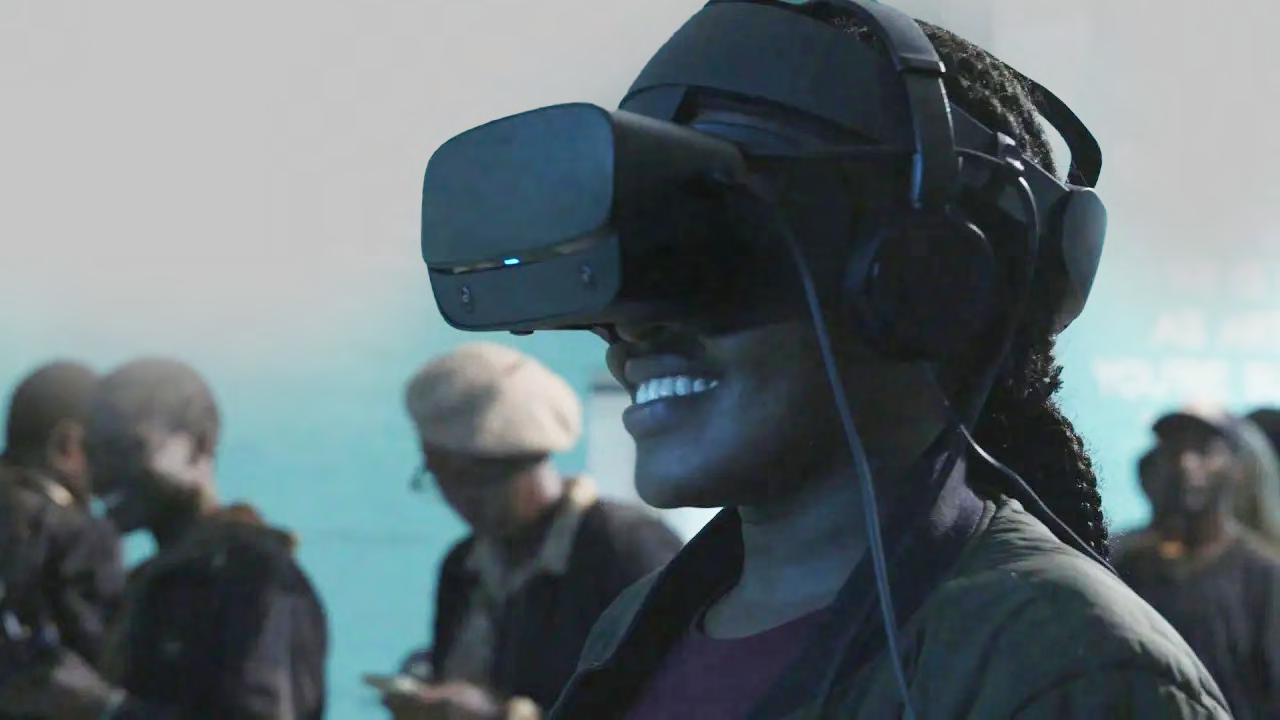
The African XR community comes together locally, regionally, as a continent, and even in the Metaverse, in support of learning, sharing knowledge and resources, and networking. From Cairo to Cape Town, initiatives are run targeting creatives, aspiring XR professionals, and XR solution providers. We highlight a number of the leading events.
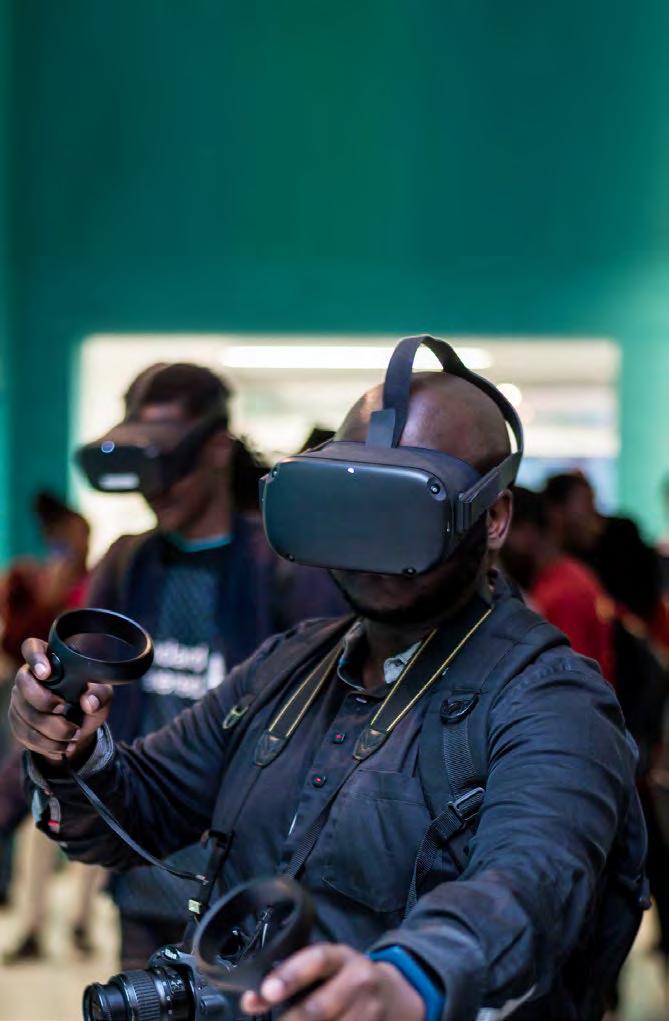


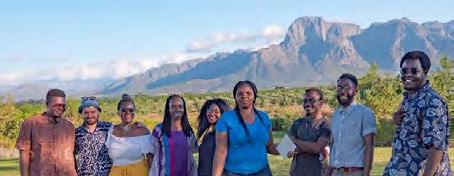
This annual workshop by South African non-profit Electric South is the leading opportunity for African creatives to explore immersive technologies alongside leading industry advisors from across the globe. The lab participants develop stories told through creative technology alongside these advisors. Labs consist of discussions, masterclasses, and participants’ opportunities to workshop their creative projects.
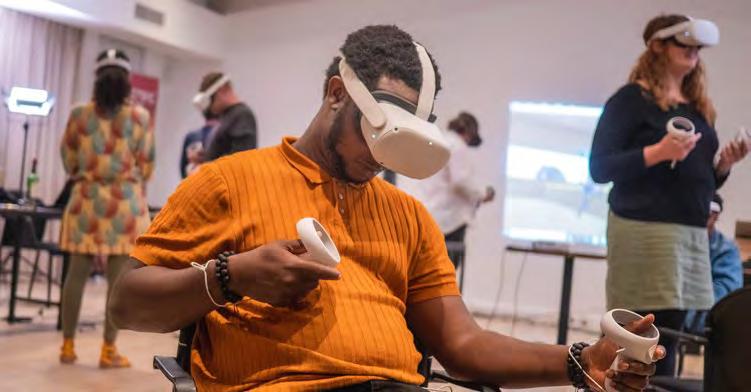
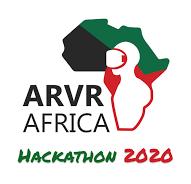
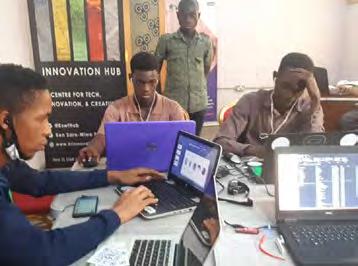
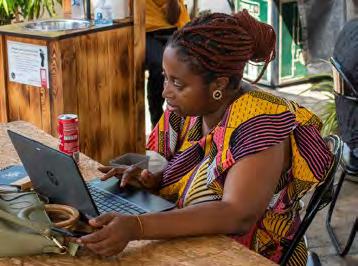
The AR/VR Africa Hackathon is Africa’s largest XR hackathon, providing opportunities for peo ple to create with and learn about Virtual and Augmented Reality. It increases XR awareness and skill level and inspires the use of these tech nologies to tackle the continent’s grand challeng es. In addition, it provides an opportunity to get hands-on experience in AR and VR design and development and meet others who want to learn and create with AR and VR. The first hybrid (online/offline) edition was held in 2020, with participants from 28 African countries.

The Moran Story Lab is a female-fo cused XR program in Kenya. It calls for young female creatives with a background in film looking to diversify into immersive technol ogy; find new ways of telling their stories, and create the impact they desire. The lab is a 12-week train ing program on foundational skills in 360 video production, virtual reality and immersive journalism.
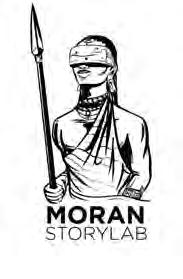
The Moran Story Lab is a female-focused XR program in Kenya. It calls for young female creatives with a background in film looking to diversify into immersive technology
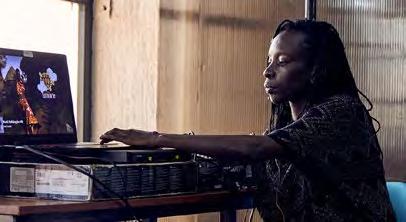
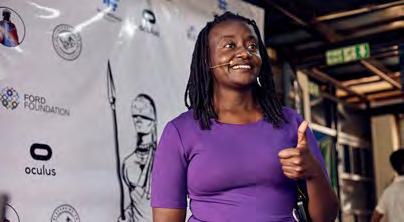

Have you applied for Moran Story Lab yet? Are you a young female creative with a background in film and is looking to diversify into immersive technology?

Finding new ways of telling your story and creating the impact you desire. Take a few minutes and apply for the opportunity to take a 12-week training program on foundational skills in 360 video produc tion, virtual reality and immersive journalism.
advisors. Taking place early next year, artists will get to engage in discussions and masterclasses, and workshop their creative projects.
www. electricsouth.org
Black Rhino VR (Kenya)
The State of the ARt is an immersive technology workshop for creatives. Selected artists are trained to use the technology and relevant software and then transition into creating their art projects. The resulting visualisations will be AR/VR integrated, ready to share with the world.


 Imisi 3D (All Africa)
Imisi 3D (All Africa)
The AR/VR Africa Bootcamp is a 2.5-month intensive learning experience for successful AR/VR Africa Hackathon teams. The teams are drawn from the top performers in the different country groups, representing a range of XR solutions for challenges in education, healthcare, gaming, tourism, and the environment/climate. The curriculum of the Bootcamp is modelled on the startup equation providing teams with the fundamental knowledge required to go from hacking a solution to creating a sustainable product or service.
This virtual program, delivered by a global faculty of experts, is designed to support the teams in refining their solutions and creating MVPs. It concludes with a Demo Day for the teams to pitch their solutions to potential investors.
After the Bootcamp, the teams are expected to apply for incubator and accelerator programs successfully.
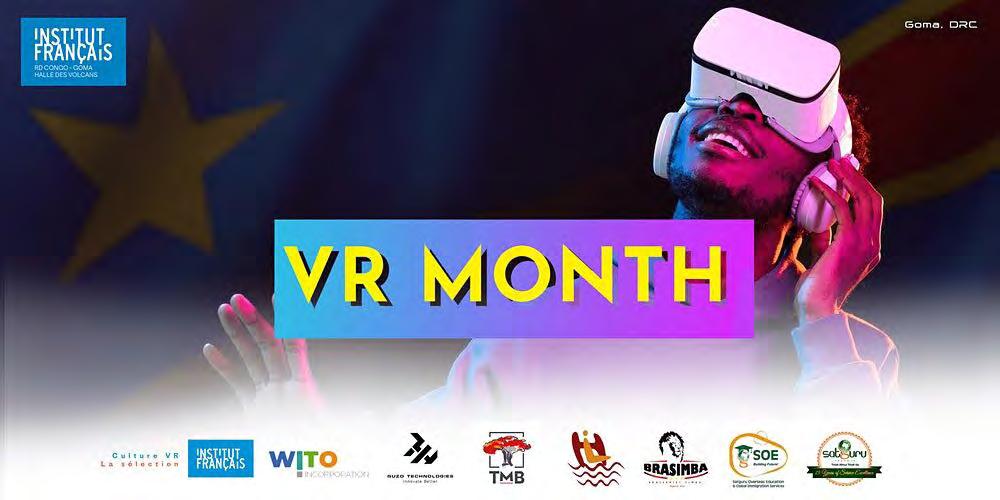
WITO Technology, Guzo Technology, Institut Francais (DRC)
The first-ever virtual reality month was held in Goma City, DRC. Sponsored by Institut Francais, it was preceded by WITO Technology setting up an XR lab. This resource for the community then served as the focal point for the ac tivities in May 2022, which consisted of talks from XR practitioners across Africa, workshops, and the opportunity to get hands-on with the technology. Guzo Technologies from neighbouring Ethiopia provided technical expertise for the initiative.

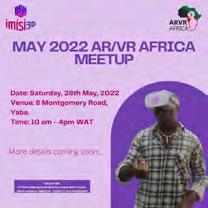
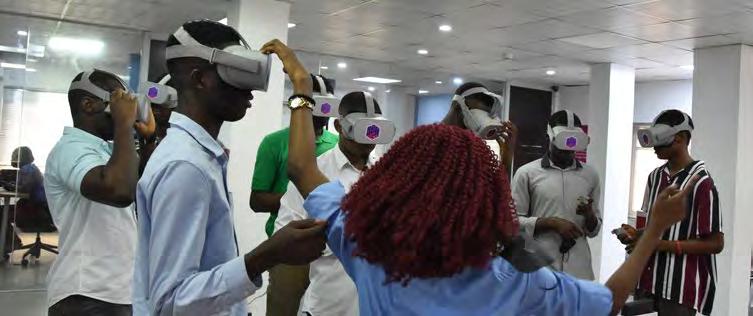
Imisi 3D (Nigeria)
The meetups are regular in-person events bringing the local XR community together. They provide an opportunity for trying out XR demos, speaker sessions, product talks, tutorials and networking. While the events are in-person, providing critical access to XR equipment and resources, they include hybrid elements allowing for a global roster of speakers.

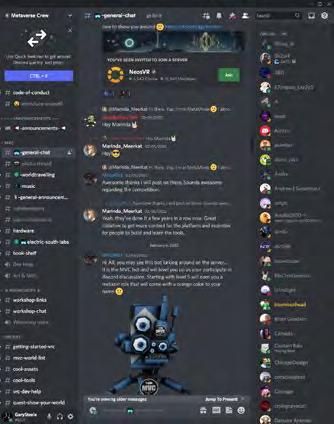
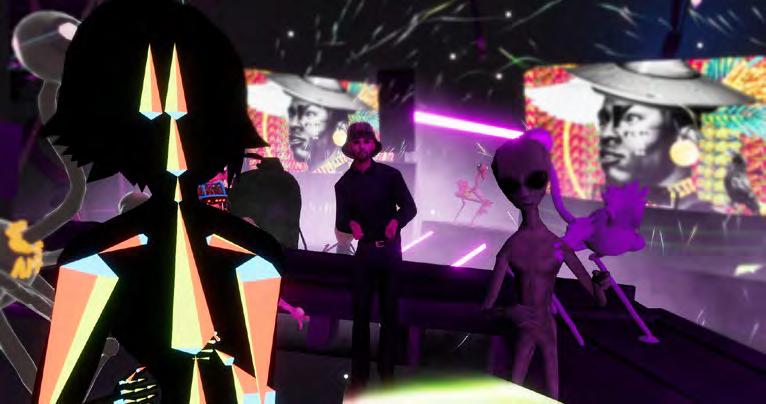
A weekly VR meetup organised and founded by South African designers and developers during the COVID19 lockdowns. The Metaverse Crew has hosted scores of virtual workshops on topics from worldbuilding, to 3D modelling, to spatial audio design. Worldhopping - virtually travelling from one digital venue to another - has also played a role in introducing several new creators to the community. You can find out more by joining them on Discord.
Due to the Covid 19 pandemic, the restrictions on in-person gatherings pushed many communities on line. It has become a catalyst for virtual reality technology interactions in various forms and pushed the potential of XR into the spotlight. Communities that once enjoyed regular physical meetups moved their gatherings to messenger platforms and niche community locales like Discord, widening reach and participation.

Further, social VR platforms have increased, provid ing some virtual meeting space options. An example of this transition is best illustrated by The Metaverse Crew - a community created by Rick Treweek, which began out of South Africa and spread to include par ticipants across Africa, and now the world. Tutorials, knowledge sharing and lengthy conversations in platforms like VR Chat, Somnium Space, Museum of Other Realities, AltspaceVR and RecRoom, serve as experimental excursions in which members of The Crew test their creations, share tips or just enjoy in teracting. In addition, there are many conversations about these virtual new worlds during ‘world hops’ - portals are opened to new and exciting spaces conceived by a new generation of online travellers and world and experience builders.
Avatars are a hot topic, too; what would you like to wear that best represents your personality or tastes? Do you want to look like yourself or something completely different? Creators use virtual sculpting tools like Adobe Medium and Quill, and traditional 3D tools like Maya, Z brush and Mixamo to render and rig the most fantastic versions of themselves to represent them in virtual spaces. There are worlds dedicated to avatars, where you can try them on like garments in a traditional store, often at no cost. Finders keepers. Representation has reached a new level, with the only limit to possibilities being the creator’s imagination and perhaps poly-count.
How will these virtual spaces frame the African online experience?
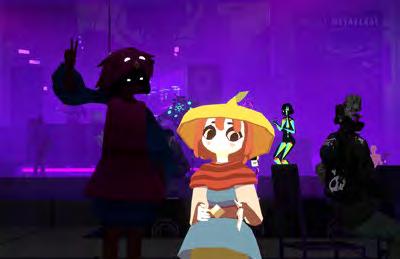
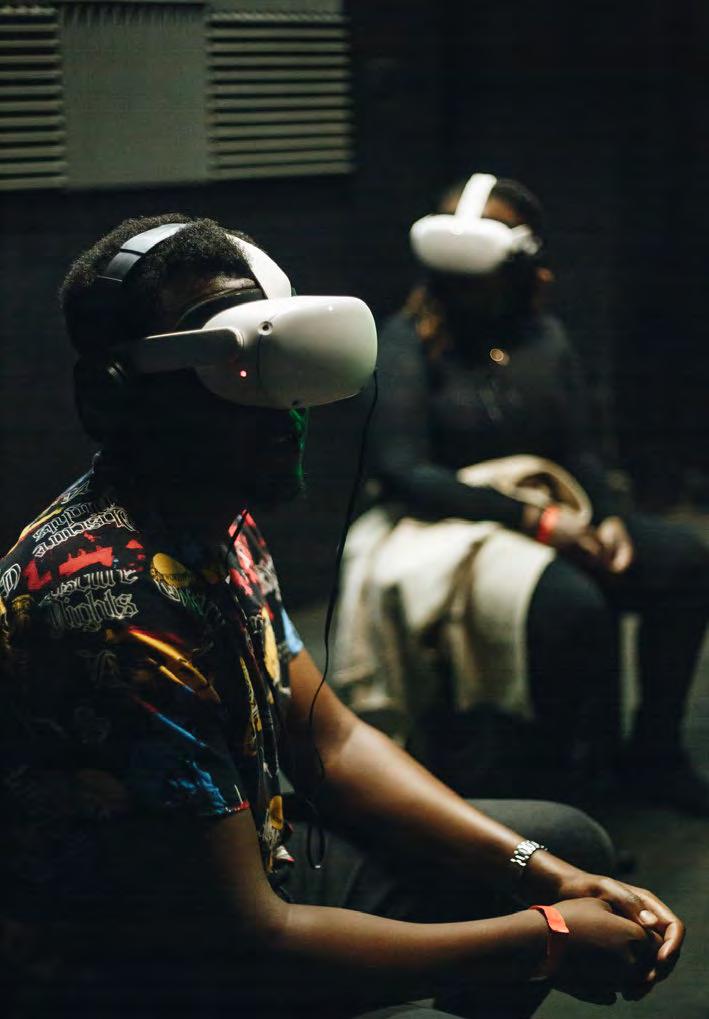
The African Metaverse Summit is a 3-day gather ing organised by 3D Net Info with partners and sponsors. It is being held to drive conversation about the Metaverse, web 3.0, and other allied technologies; while considering the continent’s position. Alongside the summit, an African Metaverse Academy is being set up to train 300 people in related professions of the future.
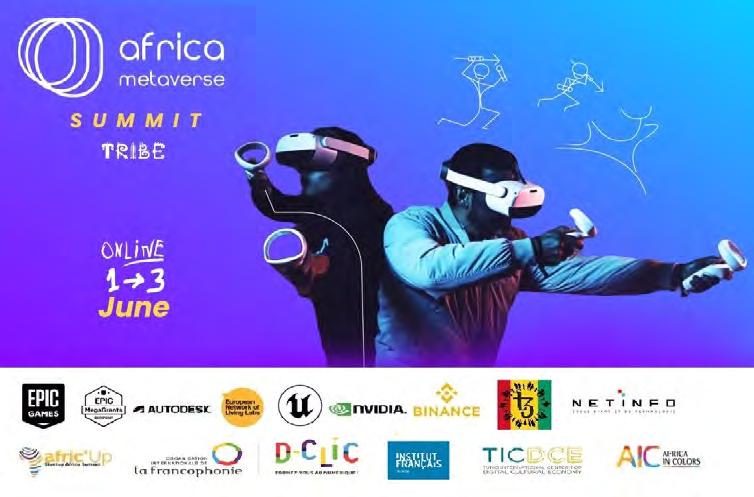

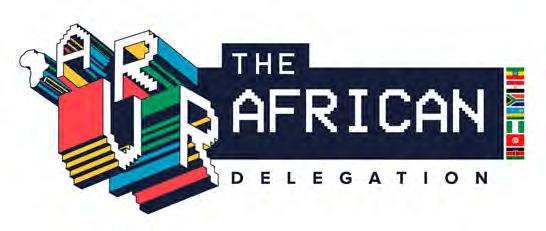
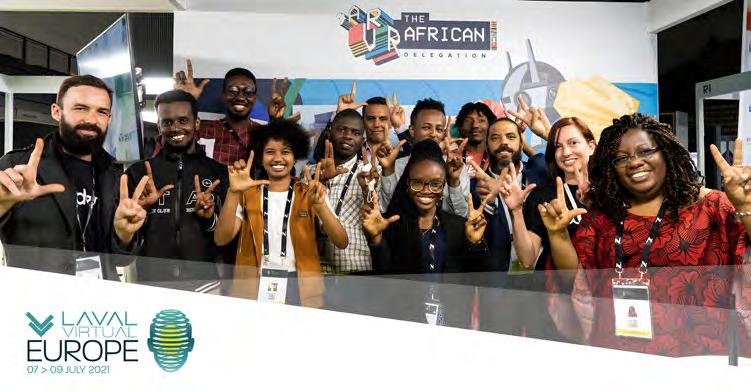


The first African delegation to a global XR event. An opportunity for African XR innovation and talent to be showcased globally with the express intent of knowledge sharing and doing business. The delegates represented seven countries for this first edition and included startups in edu cation, heritage and entertainment, with AR, VR and 360 products and solutions.
The continent’s first VR festival, Electric Africa, is a free, online virtual reality festival in Africa, born out of a commitment to building audiences in Africa for virtual reality content. The programme showcases the work of African artists working in virtual reality both on the continent and in the diaspora, alongside international works of narrative fiction and non-fiction.
Held over seven days, it includes an industry programme of live talks tailormade to the creatives, technologists, thinkers, designers, producers and makers of XR in Africa. In addition, Webinars take place each day of the festival (except Sunday). We host one-onone talks with directors and producers, leaders in creative technologies, acclaimed artistic teams and thinkers, helping to ensure the inclusion of voices and stories from the global South.


Immersive Tech Africa, Nigeria (All Africa)
The XR Innovation Week by Immersive Tech Africa and its partners is an opportunity to bring together a community of African & global XR thought leaders, sharing their insights and experiences with virtual reality and augmented reality and showcasing the best XR solutions.
Building upon the success of past editions of the XR Insight Sessions, value for every participant by providing highly curated content and enabling digital interaction that enriches their professional and personal growth in the XR space.
(All Africa)
Fak’ugesi African Digital Innovation
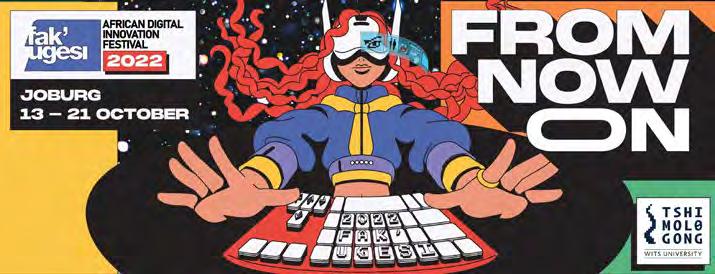
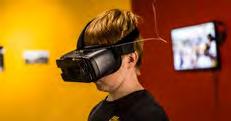
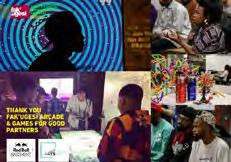
Festival is rooted in showcasing and developing technology, art, and culture skills in Africa. It was founded in 2014 as a collaboration between the Tshimologong Digital Innovation Precinct and the Wits School of Arts, Digital Arts Department. The festival takes as its starting point the idea that for innovation with technology to succeed, a strong connection needs to be made to African cultural practices and creative encounters.

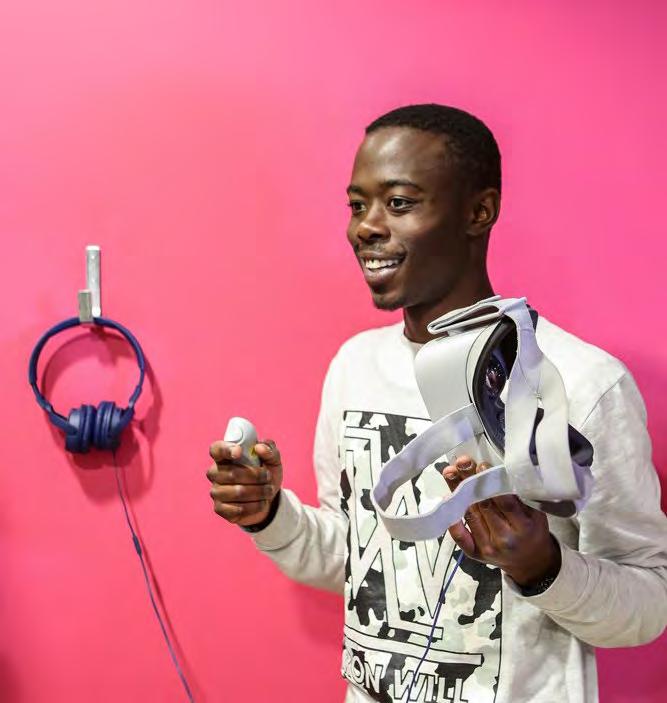
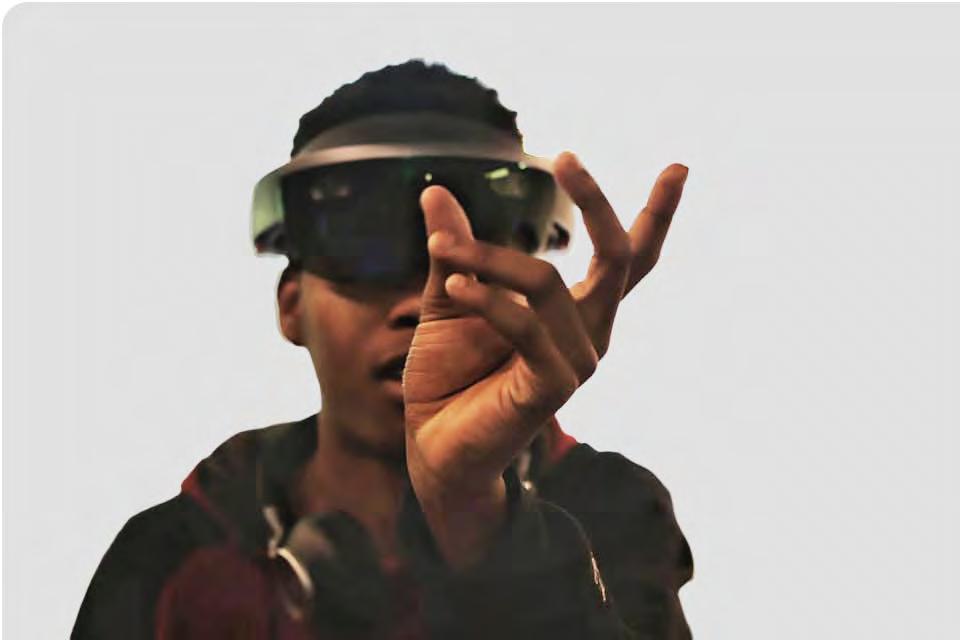
Several African XR projects have made their mark locally and globally. They have heralded the promise and potential of African XR for all. In the following pages, we share a few of these.

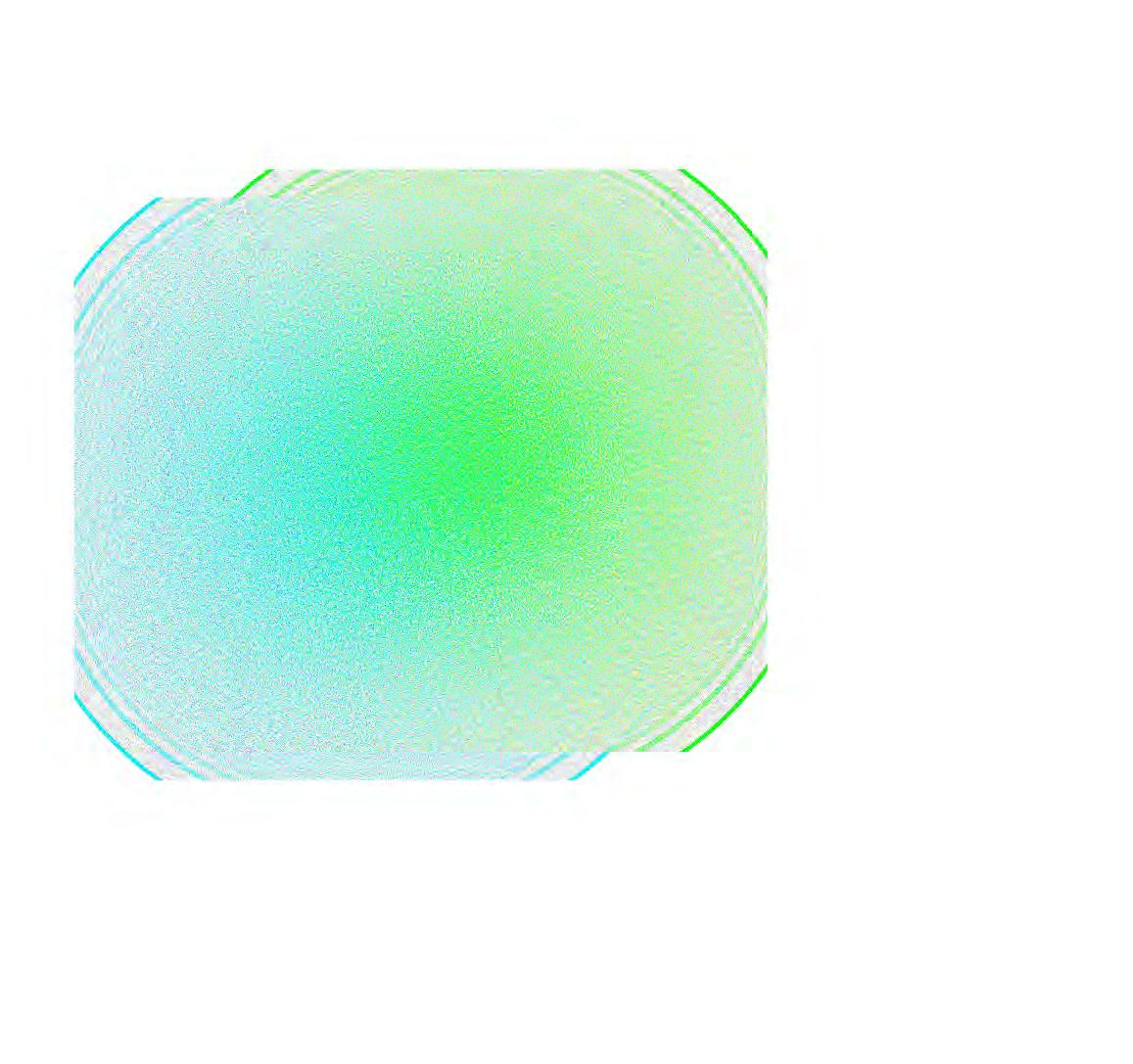
hub where they are teaching urban storytelling. Your mission as a student is to discover five creative spaces through five artists/social entrepreneurs/skaters. You will choose your gender and proceed to the next step. You will select the order in which you will be able to visit these spaces, and in each one of them, you will make very important choices. You will end up in the biggest dumping site of Africain, searching for objects and wild animals’ bones, painting trains and running from data police with graffiti artists, or challenging the religious fanatics, skating in liminal spaces and drinking khat juice with trendy musicians before flying over CBD.
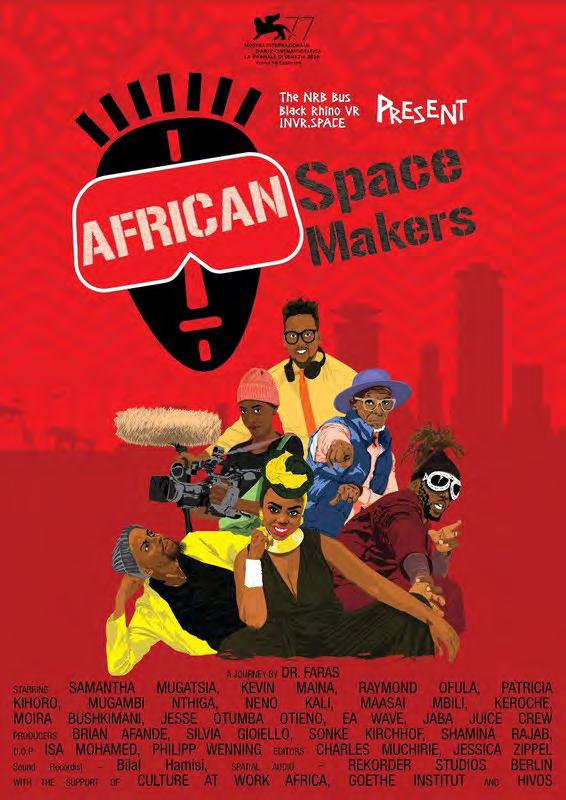
In 2019, Nigerian filmmaker Joel Kachi Benson decided to embark on a project to commemorate the 5th anniversary of the Chibok schoolgirls’ kidnapping. The year before, he had made his first virtual reality film, a short documentary of life in an IDP (internally displaced people) camp in Maiduguri, northeastern Nigeria. The power of immersive storytelling and its ability to transport viewers to places they might not otherwise experience convinced him that
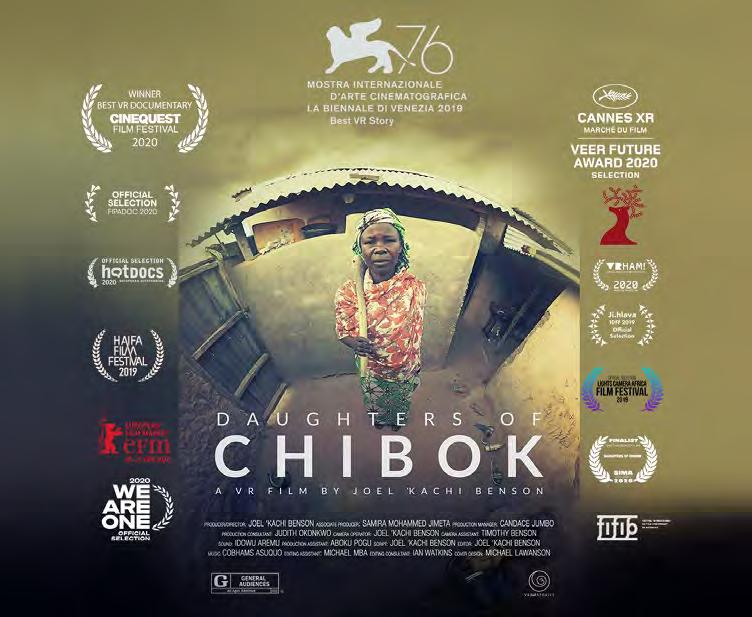
this was the medium for the Chibok story. He wanted to go beyond the media stories of the tragedy, the focus on the girls only, and tell a story of community, family, and life after the news cycle. The result, Daughters of Chibok, introduces you to Yana, a mother, a community leader, and one who still waits for her daughter. Through her eyes and in her words, life in Chibok becomes much more than a hashtag. Daughters of Chibok premiered to the public in Lagos in
outdoor spaces across the city on April 15th, 2019, on the 5th anniversary of the kidnapping. It would then win the Golden Lion for the Best VR Story at the Venice International Film Festival.
A historic first for Africa and the first of many international awards. Daughters of Chibok is now available on Oculus TV.

A web-based augmented and virtual reality development tool for every one. We are building a fast, nocode, cross-platform development solution for creating lightweight interactive 3D, WebAR, and WebVR experiences. Creators, from game developers to artists, architects,
automotive designers, filmmakers, etc., can use SwiftXR to make their imagina tion come to life. The platform pro vides a comprehensive set of draggable components and building blocks to cre ate interactive 3D content for mobile phones, tablets, PCs, and augmented and virtual reality devices.

SwiftXR was designed primarily to make simple, lightweight WebXR appli cations as quickly as possible. They’ve implemented a one-click cross-platform deployment for all devices with a drag gable set of components and an easily customisable design canvas.

If you are a member of the African XR community, a recurring thorny issue is access to hardware. Enter Eden and their signature product, the Eden Snacker. Their virtual reality deployment solution ticks several boxes: built for easy hardware and content deployment, wireless charging, mobile device management, and reporting features supported by Eden Cloud software -; it is globally relevant, particularly in its design which makes it one of the more inclusive virtual reality head-mounted displays on the market.

Eden’s current focus is the deployment of the Eden Wellness Station in children’s wards across the globe. A VR solution bundled with informative, immersive content helps children understand what they can expect during their stay in the hospital. Developed in close collaboration with medical professionals, it consists of an animated virtual reality series called the Get Well Pals. Endearing characters tackle tough topics such as ‘What is an MRI’, ‘What is Cancer’, and ‘How to Cope With Needle Pokes’, preparing kids for their medical procedures and treatments while providing coping strategies and support - all in a kid-friendly way.
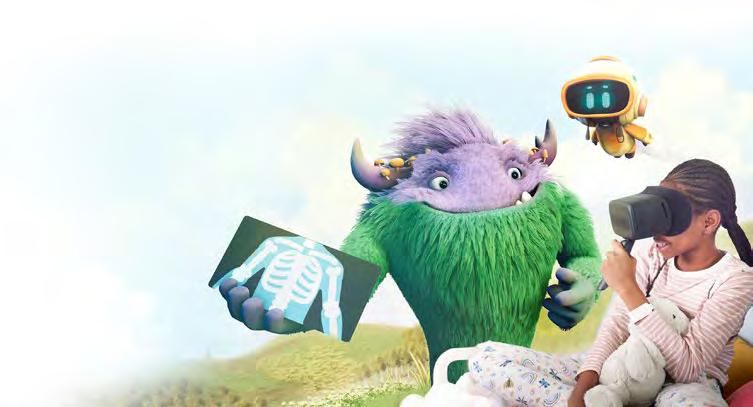
Immersive Theater for the Dian Fossey Gorilla Fund
Habitat XR, South Africa
Habitat XR has played a vital role in conservation efforts around the world. Their immersive gorilla VR experiences have supported fundraising at the behest of The Ellen Fund, and they have gone on to execute numerous related XR projects in Rwanda. Particularly noteworthy is the groundbreaking immersive theatre for Dian Fossey Gorilla Fund International, funded
by Leonardo DiCaprio and named in honour of his mom, Irmelin. Other immersive experiences at the campus include ‘GorillAR’, an augmented reality experience which will allow visitors to spend time trekking with a photorealistic virtual silverback mountain gorilla.
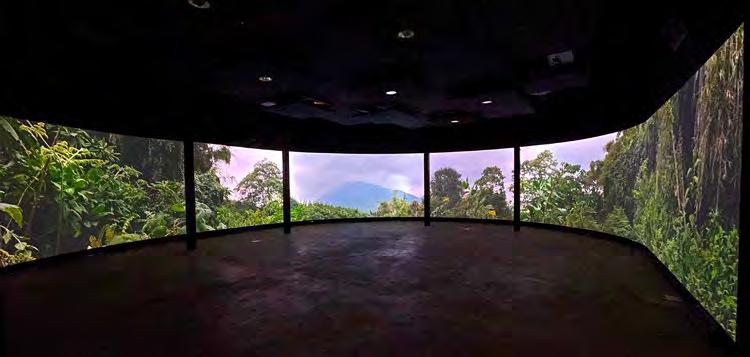
Known as a “location-based” AR experience, ‘GorillAR’ uses the in

credible power of the Apple M1 chip in new iPad Pro devices to render a realistic looking gorilla in real-time. In addition, they crafted their own custom-de signed and 3D printed themed ergonomic cases, inspired by the volcanic rock found in the area.

The VR for Schools program is an ini tiative by Imisi 3D to bring the power of immersive technologies to learning.
As is the situation in numerous Afri can cities, population growth has out paced the educational infrastructure in Lagos. This means the public school system is incredibly overburdened and can provide only basic facilities - chairs, tables, and a black or white board. With virtual reality, we pro

vide alternatives to the inadequate infrastructure. No labs for sciences? Then experiments in virtual labs. No funding for field trips? Span the globe from your seat, getting up close and personal with the world’s wonders. In 2019 with support from UNICEF, we partnered with teach ers to co-create curriculum-specific content for Nigerian secondary schools and set up the first virtual reality lab in a public school.
In keeping with our commit ment to integrating virtual reali ty as a learning aid in schools, we plan to evaluate the impact of the modules on learning outcomes in a subsequent study and are currently pursuing follow-on funding to expand the project’s scope.

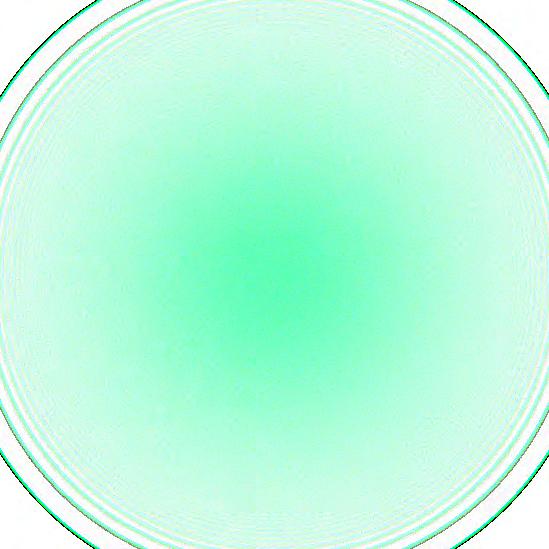
Africa Rare
South Africa
Africa Rare is a 3D virtual reality experience set in Ubuntuland. Bill ing itself as Africa’s first Metaverse, it is a virtual world that allows for trading and purchasing artefacts.
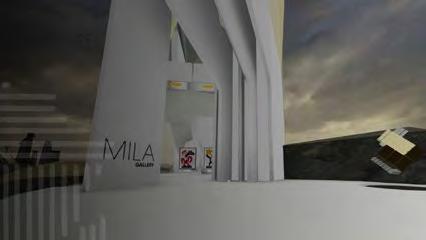
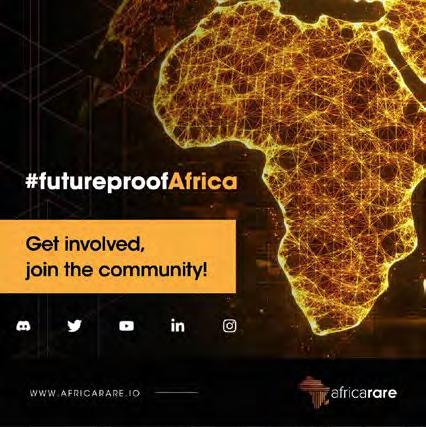
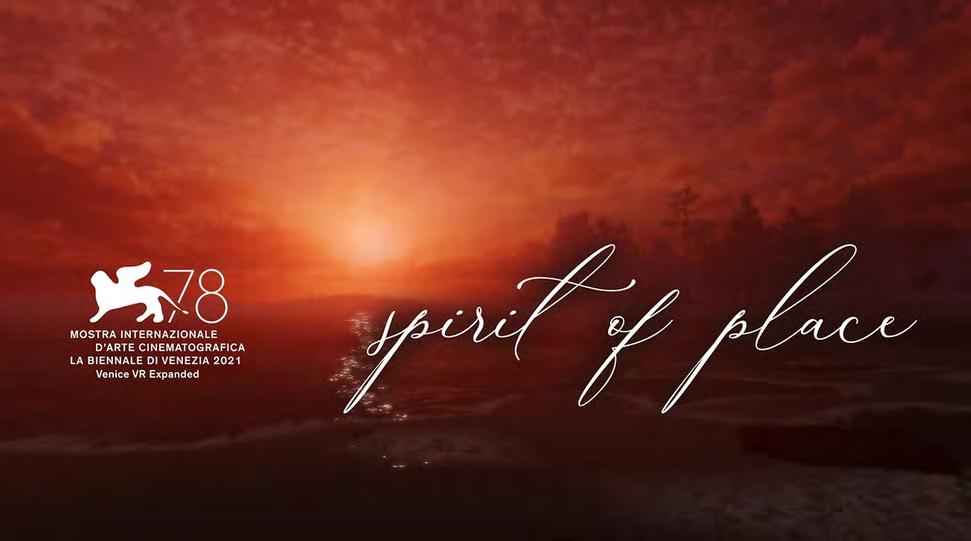
(South Africa)
Worldbuilder and creative technol ogist Dale Deacon created Spirit of Place, a VR experience shown at Venice VR Expanded, the immersive section of the Venice International Film Festival. With music from Dan heim, Spirit of Place is an open-world nonlinear immersive storytelling experience that seeks to imbue the audience with a sense of oneness with our environment. While more tradi tional media formats feed simple, lin
ear narratives to the audience, virtual reality demands new thinking. Roam and discover fragments of history and verse scattered throughout this broken world. In this experience, we explore a complicated world. Some clearings are serene, whilst others have seen difficult times. Guided through the experience, we find the narrator, a mysterious figure who poetically laments days gone by.
Habitat XR UNDP, India project for COP.
As a part of a project for the UNDP in the Himalayas, HabitatXR was charged with capturing the elusive Snow Leopard. Perhaps a once-in-a-lifetime capture in 360 of Snow Leopards in the Himalayas.

“ - Ulrico Grech-Cumbo, Habitat XR

if you’re filming lions and you are standing next to your camera, you’re going to get eaten. So you have to be able to predict where the lion is going to be within five metres. Same thing with elephants, rhinos, gorillas, etc. That’s why it’s challenging to film wildlife in 360.”

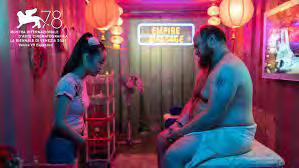
Container is a hyperreal 180-degree spatial art installation that explores modern-day slavery. Visual artist/visual anthro pologist Meghna Singh and documentary filmmaker Simon Wood utilise the shipping container as a consistent piece of architecture across space and time to create a spatial meta phor, which viscerally connects the products shipped in these containers with the oppression and exploited human labour that’s invisible to consumers.


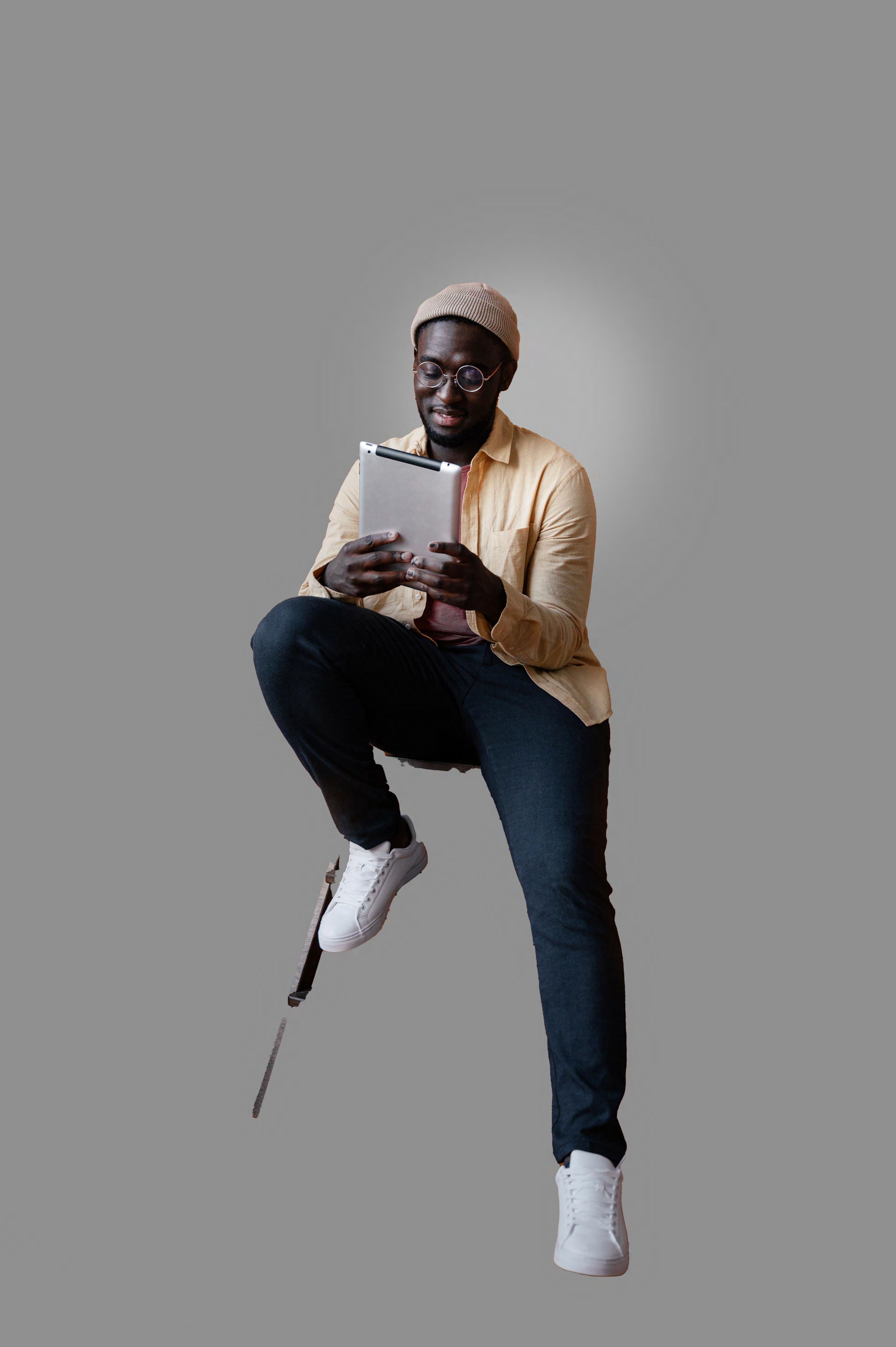
Our search for XR learning and resources came up short. We discovered a handful of related programs in educational institutions, but these were few and far between. It indicates the current gap in educating XR talent on the continent and explains our survey respondents’ reliance on online learning and on-thejob training.
While the gap is acknowledged, several institutions are thinking creatively about how they might best introduce their students to the technologies. For example, Melisa Allela of the Technical University in Kenya teaches a program on Interactive Media Design; while the course is not focused on XR, she does introduce it to her students. Herman Myburgh at the University of Johannesburg in South Africa is head of the newly minted Metaverse Research Unit, which has been set up to pool XR resources and opportunities for the university. Outside of HEIs, private and nongovernmental sectors predominantly provided XR learning opportunities.
Our sample of survey respondents in academia indicated they predominantly use the technologies for teaching (67%), with research and running an XR lab coming in joint second. A case in point is Henley Business School, South Africa’s use of social VR to run substitute city immersion sessions for their students during the lockdown.
The Metaverse spotlight has also caught the eyes of training providers; numerous organisations are positioning themselves to begin short courses on various aspects of XR development. As always, the communities (e.g. weAReVR.jozi (WhatsApp)) remain a focal area for learning and are supported by individuals who freely share content and tutorials, such as Derrick Ikenga - AR newsletter; Babatunde Fatai - Blogs on Medium and hosts the XR Atlas Podcast; and Oluwatosin Ogunyebicompiles online XR resources.
Our search for XR learning and resources came up short. We discovered a handful of related programs in educational institutions, but these were few and far between. It indicates the current gap in educating XR talent on the continent and explains our survey respondents’ reliance on online learning and on-the-job training.
Tunisia
3D Net Info was created in Tunisia by Mrs Samia Chelbi. It is the first school of art and technology in Frenchspeaking Africa, specialising in training in creative coding and the production of 3D computer-oriented images, animation, video games, VR, AR, special effects, Design and Architecture. More than 15,000 students and professionals have been trained from more than 15 countries, with a rate of employability exceeding 95% on leaving the school. Students benefit from modern infrastructure equipped with the latest technologies (the DIGIART LIVING LAB, the Virtual Reality Lab, and the virtual incubator)
www.3dnetinfo.com
Founded: 1999
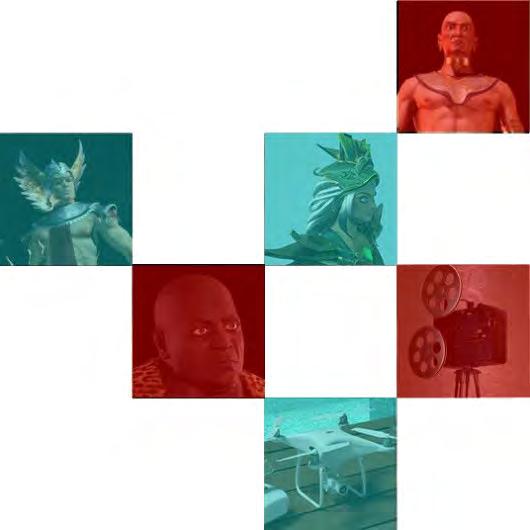
Headquarters: Tunis
African locations: Tunisia
Countries programs are run in: Tunisia.
Provides: XR equipment, training, certification courses, learning resources, lab access
Makarere University, Uganda
The African Centre of Excellence in Bioinformatics & Data Sciences (ACE) was established by The Infectious Diseases Institute(IDI), Makerere University’s College of Computing & Health Sciences in partnership with the US Government National Institute of Allergy and Infectious Diseases, and the Office of Cyber Infrastructure and Computational Biology(NIH/NIAID/ OCICB). The Virtual Reality (VR) lab at the African Centre of Excellence (ACE) in bioinformatics and Data Science was set up to meet that need and is the country’s only one of its kind. With its GPU-backed workstations and its access to a connected High-Performance computing environment, it provides unprecedented dynamic visualisation and simulation capacity in the country.


www.ace.ac.ug
Founded: 2009
Headquarters: Makerere
African locations: Uganda
Countries programs are run in: Uganda
Provides: XR equipment, workshops, lab access

vision is to educate and empower the next generation of African leaders and innovators by
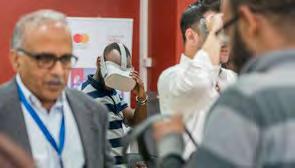

a world-class educational experience. The University’s mission is to produce creative and technically strong engineers, who have been trained in the African context and prepared to make a transformative impact in their communities and the world. In 2011, upon the invitation of the Government of Rwanda (GoR), Carnegie Mellon and the GoR signed an agreement to establish a new CMU location in Kigali, Rwanda.
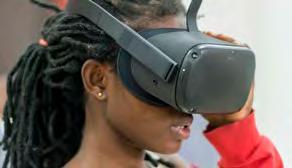
CXI-Africa is a South African domiciled entity with an offering that focuses on training and development in digital transformation focusing on Augmented Reality, Virtual Reality and Mixed Reality. They provide comprehensive training in Extended Reality (Augmented, Virtual, and Mixed Reality) development, and have up to 15 XR Training and Development Programmes which can be individually enrolled for.


https://cxi-africa.com/
Founded: 2017 Headquarters: Johannesburg, South Africa
African locations: South Africa
Countries programs are run in: South Africa
Provides: Certificate course, mentorship, learning resources
South Africa
Electric South is a non-profit company based in Cape Town, South Africa. We provide mentorship, production services, funding and exhibition for a network of artists across Africa to explore their worlds through immersive, interactive stories, including virtual and augmented reality and other digital media We believe that new technologies must open up spaces for original voices and underrepresented narratives. Electric South collaborates with artists across Africa in emerging storytelling through labs, production and distribution.
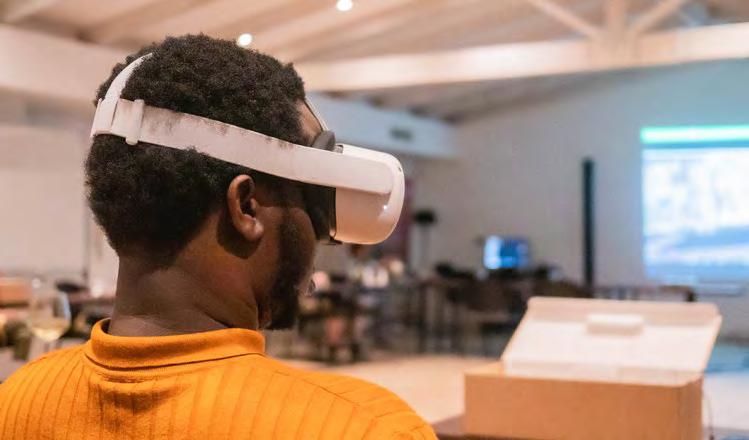
www.electricsouth.org

Founded: 2016 Headquarters: Cape Town
African locations: Cape Town
Countries programs are run in: South Africa
Provides: Workshops, learning resources

EON Reality is designed to bring Extended Reality solutions to as many people around the world as possible; EON-XR removes the obstacles that often come with incorporating XR into an academic or industrial environment. Through EON-XR, educators, employers, and other users are able to create interactive and immersive XR lessons without needing any coding or advanced technolog ical knowledge. The lessons can then be distributed to their audience of stu dents, employees, or the general public for consumption on standard devices ranging from smartphones to laptops to publicly available headsets. EON-XR is preparing millions of students, employees, and citizens for the present and future while replacing and aiding traditional training and teaching methods in countries worldwide.
www.eonreality.com

Hoft Developers is an emerging developer community where undergraduates and tech enthusiasts learn new skills, solve local and global problems and innovate new solutions. We are passionate about you and how you impact your local community! It is a free developer community! We have removed the money barrier, and we are removing the technical difficulty barrier. We focus on cross-platform projects, where we combine a series of technologies to make a significant product. We want to equip undergraduates, graduates, and technology enthusiasts with emerging technology skills and strategies required to make a digital transformation.
www.hoftdevelopers.com
Founded: 1999
Headquarters: California, USA
African locations: Morocco, South Africa
Countries programs are run in: International
Provides: XR equipment, workshops, learning resources, lab access
Founded: 2019
Headquarters: Lagos
African locations: Lagos
Countries programs are run in: Nigeria
Provides: Workshops, learning resources
Nigeria
Imìsí 3D is an Extended Reality (XR) creation lab focused on building the African XR ecosystem. They are dedicated to growing a community of African AR/VR creators, creating solutions using AR/VR, and providing educational and engagement experiences with AR/VR. The lab sees huge potential for AR/VR as a tool for creating everyday solutions and intend to change the technology narrative so that here we become creators and not just consumers of technology. Imisi 3D are future thinking and committed to being responsible ancestors, creating a better world for today and tomorrow.
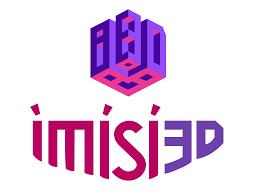
Founded: 2016 Headquarters: Lagos

African locations: Nigeria
Countries programs are run in: Africa wide
Provides: XR equipment, workshops, learning resources, lab access
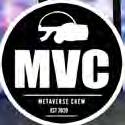
MVC Workshops - The Metaverse Crew (MVC) is a diverse and supportive community of artists, engineers, game makers, programmers, creatives, performers, and musicians living in the metaverse. Metaverse Crew meets every Thursday in the Metaverse usually starting in VR Chat at the MVC CLUBHOUSE at 21:00 SAST or 19:00 UTC. They also have events on their
channel at various times.
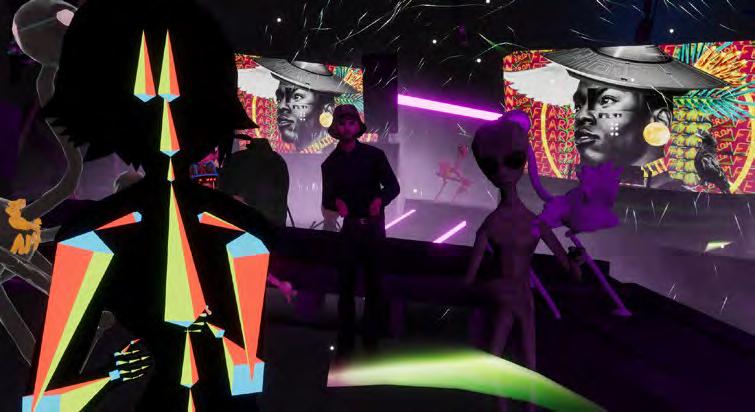
SAE Institute South Africa is owned and operated by Invictus Education Group under licence from Navitas which owns SAE Institute globally. SAE Institute is registered as a Private Higher Education Institution with the Department of Higher Education and Training for the qualifications as per registration no. 2013/ HE07/001. The institute offered a 1-year Higher certificate programme in Virtual Reality to develop students’ skills and knowledge in applying consumer-level VR and AR hardware and software to produce immersive interactive experiences. Instead of focusing on a specific industry, this programme focuses on the core technical and design consideration of working with these technologies. By doing so, the outcomes of the programme are applicable to a wide range of paraprofessional industry roles and applications in areas such as health, tourism, medical, military and entertainment.
Founded: 2013 Headquarters: South Africa
African locations: Cape Town, Johannesburg
Countries programs are run in: South Africa
Provides: Certificate courses, learning resources, world-class facilities, internationally recognised qualifications.
www.eonreality.com/locations/ben-guerir-ma

Tshimologong Precinct is a digital innovation ecosystem in Braamfontein, Johannesburg, that propels entrepreneurship and grows the skills pipeline for the digital economy through collaboration with academia, corporates, government and entrepreneurs.

The precinct provides skills and on-the-job training for unemployed youth while accelerating the growth of digital enterprises at every stage of their business and create a pathway for students and entrepreneurs to showcase their work publicly and access commercial opportunities. Tshimologong’s vision is to become a catalyst for the development of world-leading African digital entrepreneurs.
www. tshimologong.joburg
Founded: 2016 Headquarters: Johannesburg, South Africa
African locations: South Africa
Countries programs are run in: South Africa
Provides: AR/VR/XR, and Gaming, IoT, Digital Fabrication, Robotics, Electronics, Mobile App Development, Web Development, Testing.

Nigeria
Researching in Human-Computer Interaction (HCI) using immersive technologies. The HCI focus at the VHCI lab is to research how people are affected by the technologies they use at work and leisure, and also how to put these technologies to best use. Immersive technologies, such as virtual reality (VR) exemplifies all that make us passionate about computers: interactivity and impressiveness. We explore the use of VR for learning and perspective-taking towards eliciting greater empathy and compassion in people. In another expression, we consider VR use in cognitive, affective and behavioural modification towards positive mental health.
vhci.lbs.edu.ng
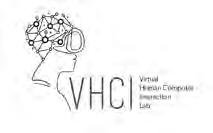
Founded: 2020 Headquarters: Lagos Business School
African locations: Lagos
Countries programs are run in: Nigeria
Provides: XR research.
VR Innovation Academy
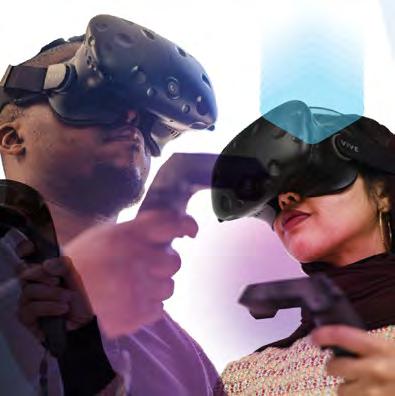

The VR Innovation Academy, a 10-months long further education programme, will train new Virtual Reality and Augmented Reality professionals to grow the local VR/AR economy and empower graduates to start their own VR and AR companies. The VR Innovation Academy at the University of Western Cape (UWC), teaches the skills needed to create Virtual Reality and Augmented Reality applications for enterprise and education. The curriculum covers many diverse fields, including architecture, product visualisation, game creation, multimedia design, and broadcast media.
Students receive 16 weeks of theory which includes AR and VR content creation, professional workflows, and project management across the entire AR and VR ecosystem. Thereafter 16 weeks of project training will follow when students will develop their entrepreneurial skills through supervised project-based learning on real customer projects. At the end of the course, students will have a robust portfolio of work showing off their projects. The Academy was founded by the University of West Cape, South Africa and EON Reality’s Interactive Digital Centre (IDC).
Founded: 2018 Headquarters: University of Western Cape, South Africa
African locations: South Africa
Countries programs are run in: South Africa
Provides: XR equipment, learning resources, postgraduate diploma, lab accesswww.eonreality.com/locations/ cape-town-za
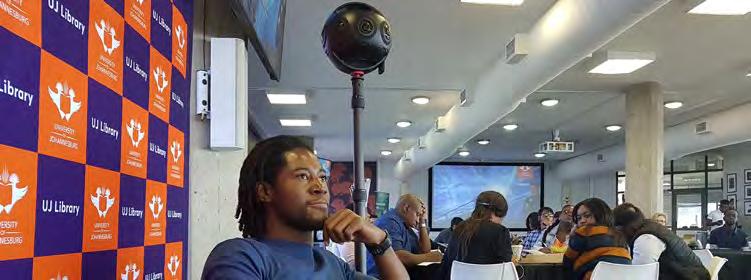

University of Johannesburg, South Africa
Set up in April 2022, the research unit is focused on pooling XR resources for the students and faculty of the University of Johannesburg. Headed by Herman Myburgh, it is the first such centre of its kind in an African higher education institution. It forms part of the university’s drive to leverage the fourth industrial revolution.
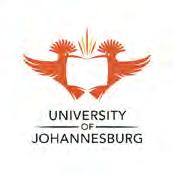
The VHCI lab is at the forefront of social science research with virtual reality in West Africa. In 2020 they became the recipients of a $234,000 grant from the Templeton World Charity Foundation. Alongside coinvestigators from Marist College, NY and Imisi 3D, Lagos, the VHCI team led by Eugene Ohu have been investigating the use of virtual reality game design, and virtual reality gaming to develop empathy and compassion in teenagers. This multi-part two year study is engaging 540 teenagers aged 13 - 18 in several secondary schools across Lagos, Nigeria. It is one of several studies being conducted at the lab, where research interests include mental health care and consumer behaviour.
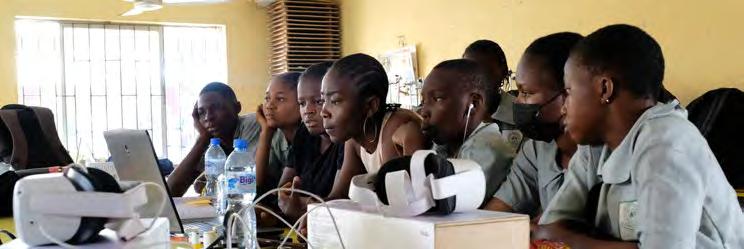
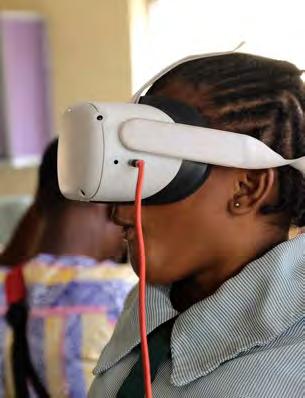
The University The ACE, Uganda, was involved in a VR conference from April 26th to April 29th, 2022. The event was organised by VRiMS(Virtual Reality in Medicine and Surgery), UK, and a huge team of collaborators! Their main focus was East Africa this year. We had a 4-day program covering surgical procedures related to trauma, abdominal, neuro, ortho, and obstetrics/gynaecology.
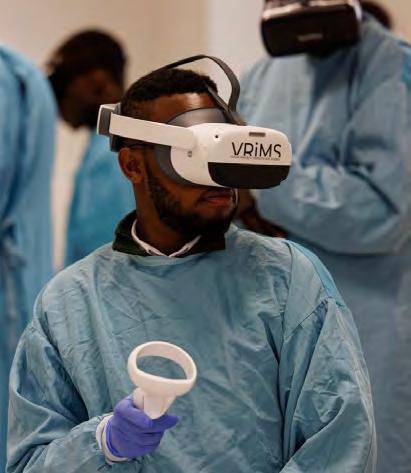
The learning material is intended for healthcare workers who deal with the majority of the surgical burden in remote regions (this may be medical officers, surgical trainees, or surgeons). The procedures were carried out on cadaveric specimens in Brighton, UK, using expert faculty from the UK and Uganda to teach each procedure’s anatomy and steps. This was filmed using 360 cameras. The conference was run in parallel in Brighton and Kampala on the same dates (in collaboration with UCU School of Medicine and ACE ) - by providing cardboard VR headsets to delegates, mainly doctors, to access the content in 360 live-stream viewings. In addition, the content was made accessible remotely to healthcare providers internationally (to access on a smartphone/laptop). Delegates attended either physically at the ACE in VR handsets or UCU’s School of Medicine or remotely, and the conference was entirely free of charge.
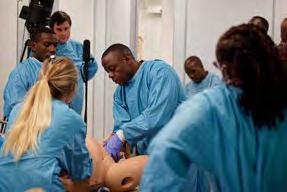
I think for me, what stands out other than the collaborations and learning that we’re already getting from this amazing team of VR enthusiasts is that all this content is readily available in a library somewhere hosted by VRiMS. So I believe that our labs and other AR/ VR labs on the continent can use this material our scholars in Africa.”
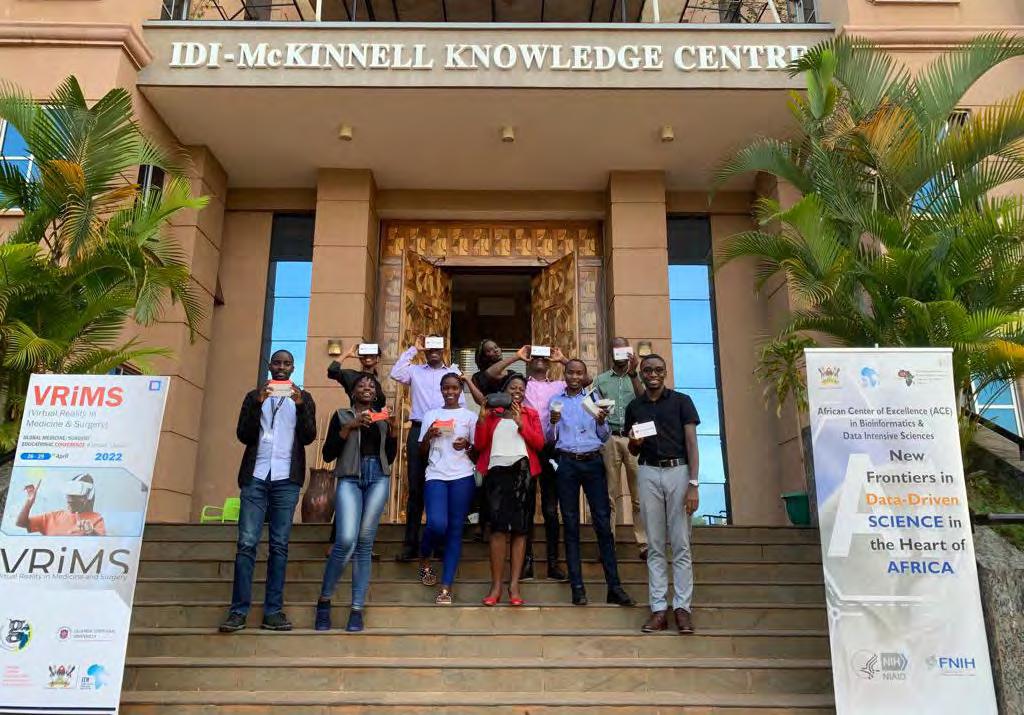 - Mike Nsubuga, ACE, Uganda
- Mike Nsubuga, ACE, Uganda
Created in 1999 in Tunisia by Mrs Samia Chelbi, 3D NET-INFO is a school of art and technology. It is the 1st school in French-speaking Africa specialising in training in creative coding and the production of 3D synthesis image-oriented worms, animation, video games, virtual reality, augmented reality, special effects, Design, Architecture and Engineering.

More than 15,000 students and professionals have been trained from more than 15 countries (Tunisia, Morocco, Algeria, Sudan, Cameroon, Ivory Coast, Gabon, Senegal, Benin, Togo, Belgium and France) with a rate of employability exceeding 95% on leaving the school. NET-INFO has acquired credibility and fame in digital arts during its 20 years of experience and has continued to evolve by adapting to technologies and the needs of the professional market.
Entrepreneurship and innovation are at the heart of our pedagogy. Students benefit from modern infrastructure equipped with the latest technologies (the DIGIART LIVING LAB, the Oculus Virtual Reality Lab, the virtual incubator, etc.). They participate in competitions that reward their ideas, their projects, and their achievements. Those who want to be entrepreneurs have a career and support throughout their digital business creation project. The integration and success of our
students are our priority. Recognised by the Tunisian Ministry of Vocational Training and Employment and a rare African school certification ISO 9000, NetInfo is the African reference school that stands out in the landscape of the continent’s creative industries by its original positioning: A school that offers an African model with international requirements.
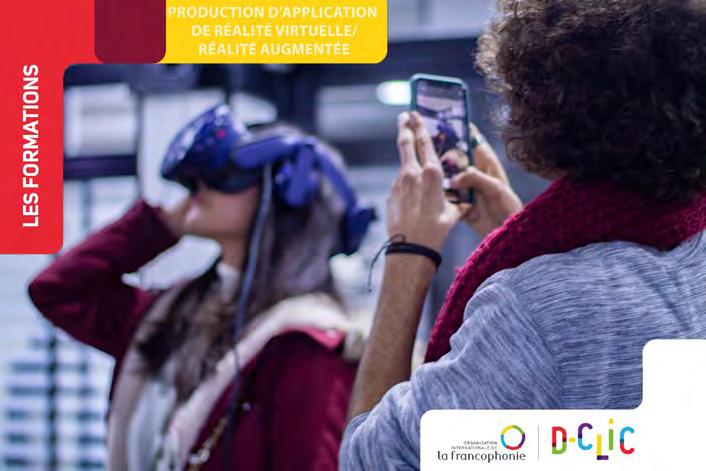
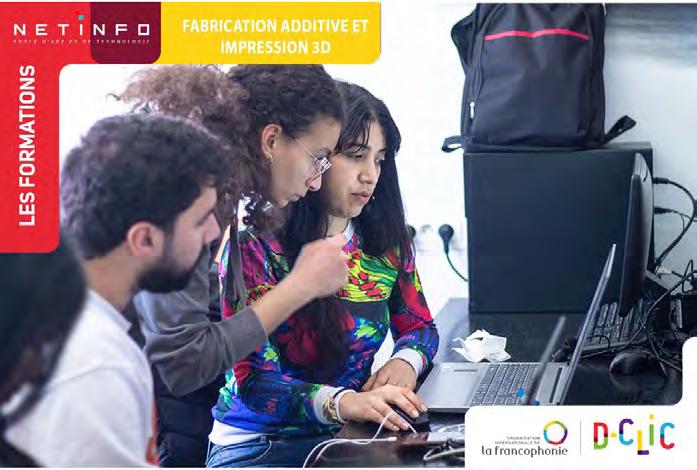
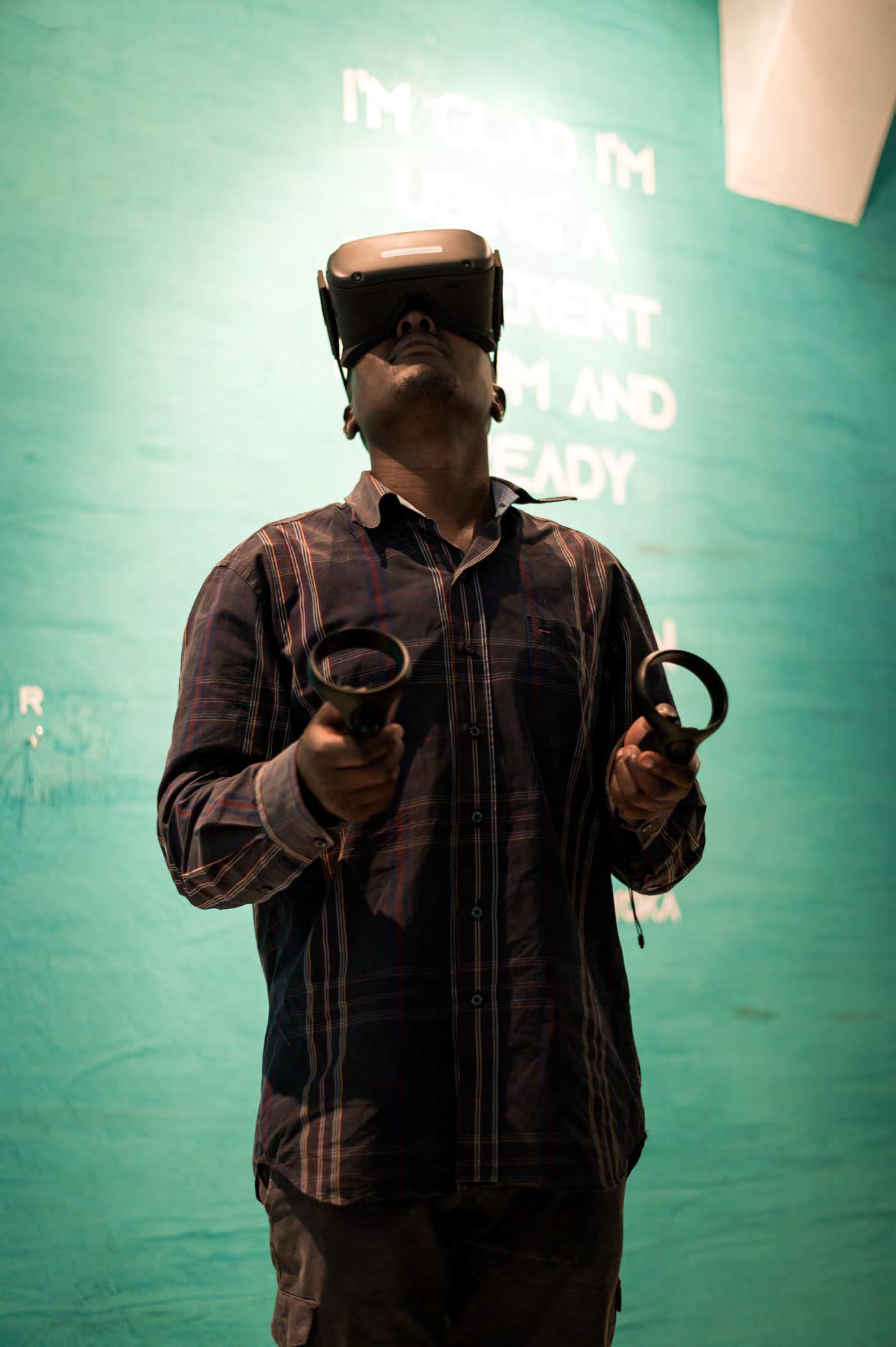

We have by no means captured everyone, but we have engaged across all the geo-political zones and bring you stories of many who have left an outsized footprint on the African XR and global landscape. Enjoy!


This report, or any notion of an African XR ecosystem, would not exist without the creators who have gone ahead to forge a path with these technologies on the continent. In their own words, their stories are shared here for wisdom, learning, and information.
Abdou Khadre Diop is an XR creator and founder of OwnLabs, a VR app provider for the simulation of science labs for college students. In this spotlight, he shares his journey into XR, the impact his solutions are making and his hopes for the future of XR in Senegal and the world.

*This
been
It happened with Ownlabs, precisely with the virtual scientific laboratory. I thought using Virtual Reality could be a good way to solve our problems, without the student noticing a big difference between what he is doing and reality, while keeping the operating costs acceptable for the school and for the student.

At the time I got myself a Google cardboard,I had a telephone andI felt that the problem of the scientific experiment can be solved like that. I made a fairly basic prototype with my phone and the tool. I learned all the steps: The game design that must be done before, how to cut and make objects, 3D, scripts, involving sound, backups, texture, all that stuff. It was really just for fun. I thought I could solve the problem like this.
When I started with the prototype, I was also going to see how the market side would respond. We researched the students in Senegal -how many per region - the number of boys and girls; and which schools had access to a computer room, and studied all the statistical data.
With Coursera and EDX, we trained ourselves. On YouTube there are great game designers, developers…you have to follow all these people and soak up technologies. Subsequently, during my Master’s program there were teams who came from abroad and shared their experience especially in the field of video games. So it helped me learn fast.
Our base is immersive realities, including virtual, mixed, and augmented; but we can adapt them to several media. We can go on the web, on stand alone headphones, fixed headphones, we have these different choices. Though the smartphone is much more suitable when it comes to augmented reality.
We started with Unity because it was the most affordable platform technically. We also use Unreal now.
What motivated you to continue in the field of VR given the many difficulties it entails and the low level of knowledge of the population?
We know what it has brought to the people. Today, we have made a change, we have gone from only the scientific laboratory for high school students to solutions for plumbing, and with partners that we have, in electricity, automobiles, etc. It is quite diverse. And this diversification generates a much more important aspect which is the reduction of training costs.
Faced with the absence of practical work in the Senegalese school curriculum, students have created OwnLabs, an application that simulates chemical and physical experiments. Image courtesy of OwnLabs.
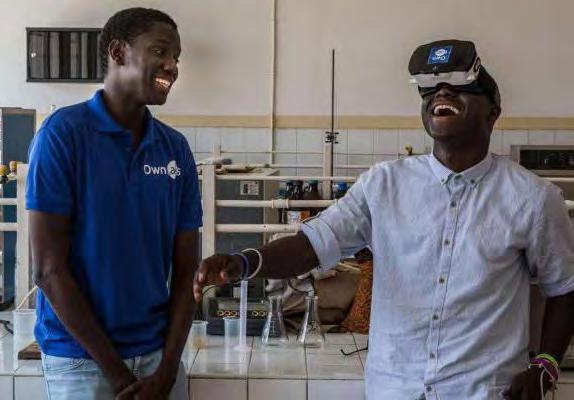
How did you acquire the necessary skills to venture into XR?
Do you work 100% with immersive realities or do you integrate mobile, web and others?
What applications did you use to develop your solutions?
What are the challenges you have encountered as an XR creator in Senegal?

We have challenges in finding the skills that are necessary for setting up a platform or creating a VR tool on the African continent. I’ve discussed it with people in Nigeria and Kenya who do pretty much the same thing and we all have the same problem finding competent people. There’s also the challenge of funding, as these technologies are not well-known. In fact, few organisations are willing to risk it.
Because this technology is not wellknown and the market is not yet mature enough to adopt it en masse, we have to sensitise the community.
The last issue is with market adoption of these technologies. But thanks to the test phase that we carried out in January, we are quite confident on this subject, we’ve had very positive feedback from the school principals and the teaching staff for the technology of Ownlabs.
We have challenges in finding the skills that are necessary for setting up a platform or creating a VR tool on the African continent. I’ve discussed it with people in Nigeria and Kenya who do pretty much the same thing and we all have the same problem finding competent people.
In relation to the purchase of equipment, we based ourselves on two different sources of financing. Selffinancing, where we put money in and bought the equipment ourselves, then we added funding from our partners like Sonatel, Ericsson and the DER.
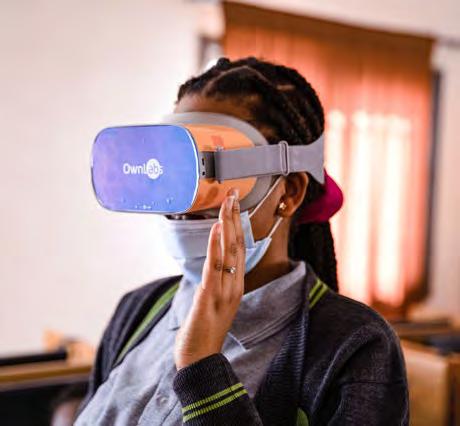
As the technology was not that popular, we had to really try to make it known. We did this through the various competitions we won. We got an Ericsson Innovation Award to the tune of $25,000; won The Orange Prize for Social Entrepreneurship, and we were also able to win the challenge organised by the French Embassy and the French Institute, so it’s through these three points that we were able to have our partners, who continue to trust us to this day. Sonatel gives us support in training and funding. On the side of the DER, they help mainly in the financial structuring of our solutions.
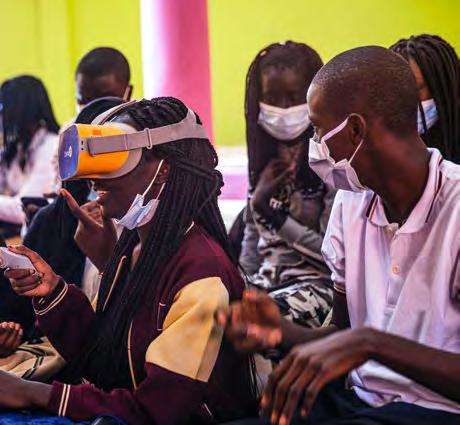
Do you have any partners or people you collaborate with?Learners visit the Laboratory of the future thanks to OwnLabs VR educational solutions. Image courtesy of OwnLabs.
XR technologies are actually quite complicated for market adoption. I met people who invested 300,000 dollars just for a research and development product with no real link to the customer, and which still needs to be fine-tuned. On the other hand, the source of financing that could be adapted would be equity from these large groups that support start-ups. They tell us to master a technology they have uses for, we find solutions to tangible problems and we do big business. I think that’s the best source.
I think that when politicians decide that one technology or another should be favoured, that gives a certain confidence to investors who say to themselves “Ah! Politicians want to support this, so we will follow.” It’s like what happened in France when the French State decided that the whole State must be on the Cloud, and the Cloud has done incredible good in France. In Africa, in relation to the regulations, it is quite vague.
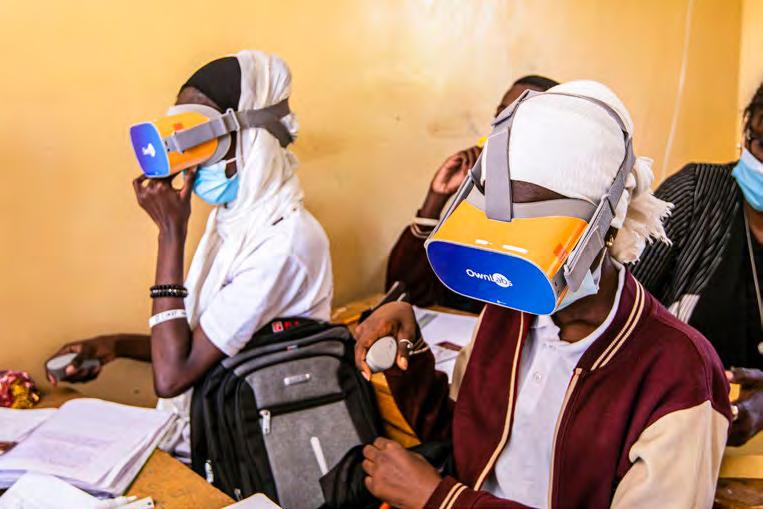
What are your thoughts on the regulations required at policy maker level that can support the XR industry?
In your opinion, what kind of funding do you think is best suited for the XR environment?Learners visit the Laboratory of the future
If the creators of hardware like Oculus, HTC, actually manage to make them easily accessible, I think it will allow content creators to have a much larger market.
We are not going to limit ourselves to Virtual Reality headsets for science. e are going to move towards medicine and other fields because I think that our technologies can be used in a much broader way. It is up to us to be players in this immersive technology and offer solutions to people who work in these fields.
When I look at the feedback we have from people in the field, from students - because we have done four schools in Senegal in three different regions, where we have tested around 300 students and fifty teachers in high schools, the information we got proves that these technologies can be used on a large scale to solve problems such as science learning in high schools.
I think that if we take these technologies in hand and use them to confront the problems that exist on the African continent we can really have a huge impact.
Abdou Khadre Diop (Senegal) shares his thoughts on the future of XR in Africa Image courtesy of OwnLabs.
What role do you think big tech companies should play to support the African XR space?
What is your vision for Ownlabs in the coming years?
What makes you certain that XR technology is important for Africa?
The feedback we got proves that these technologies can be used on a large scale and can solve tangible problems such as science learning in high schools. I think that if we take these technologies in hand, and confront them with problems that exist on the African continent, we can really have a huge impact on Africans.
Co-founder & Managing Director
Black Rhino VR
Brian Afande is the co-founder and managing director of Black Rhino VR, an award-winning extended reality agency based in Nairobi, Kenya. Since the company’s inception in 2015, he and his team have been breaking ground in Africa, and have achieved global recognition in the XR space. Brian believes that storytelling is a powerful tool to connect people and seeks to revolutionise XR in Africa through training and empowerment of the younger generation. In this spotlight, we share the story of Brian’s experiences coming into the XR space and what he thinks Africa needs to do to grow the XR industry.

Black Rhino has made a name for itself in the XR space, can you tell us how it all started?
This is a story based on faith. I have a background in computer engineering and I also graduated with a certificate in Philosophy and Epistemology from the University of Nairobi. I had a stint as a club DJ, and on radio and tv, but my strongest background is in marketing.
I was the Retail Portfolio Manager for an international company called Converse, which was operated by Kenya International Sports Limited. One Saturday when I was making my weekend rounds of the department stores, there was a terrorist attack, which the world came to know as the Westgate terrorist attack. I was one of the survivors, and that six-hour experience changed my life. After I was rescued, I promised God that I would try to do something different with my life.
I was young and had so many opportunities. I prayed about it and went into a Bible Study to understand my destiny. Two things were clear to me: I had to leave a legacy for my children, and I had to get married and start a family. Immediately after Westgate, I got married, resigned from Converse, and set up Black Rhino VR with my business partner, Michael Ilako. I tell a lot of people that Black Rhino is a business based on the Kingdom principles that underpin our faith, mission, and vision.
Back then, we realised there were financial opportunities in the VR space, so our first legal employee was an accountant. I always knew that one of the things that a company needs to have is a very sound financial policy and framework to support its growth.

At that time, Facebook had just acquired Oculus for around $2billion and I wanted to understand why Facebook had made such a decision. When Michael and I delved into the technology itself, we discovered that 360 video was one of the sub-sectors of VR. We did a lot of research to understand more about 360 videos. Without any interaction with 360 and VR, we were able to do a feasibility study and create our unique value proposition.
We realised that we needed to have a 360 camera to understand how to shoot 360 videos. The only rig that was affordable was the GoPro 360 rise (It had six GoPro cameras embedded in it). We needed a good machine to render the files we were going to create. There were none present in the market, so we decided to build our own. The cameras and the Oculus DK2 (VR headset) were shipped in from the States, along with other computer components from different parts of the world, and we built our machine called The Beast. That’s how we were able to set up our 360 studio and start making 360 videos.
Michael and I got loans from our wives. We sat down with ourwives to inform them that we wanted to start a VR company, but in retrospect, it was so hard for me to explain VR without having any experience. My wife didn’t know what VR was, but I explained it as best as I could, and she saw the passion I had for it and supported me. When we started, most of the work was done by Michael and I. Michael is a renowned filmmaker in Kenya and It was easier for him to understand the 360 pipeline so the transition from linear to equirectangular wasn’t a challenge. Our first employee was an intern. He was learning the ropes when we were on set and assisted with stuff
like bringing cables or walkie-talkies. For the business itself, the first core team was three people. Michael was shooting and editing while I doubled as a producer and did the shooting as well. Back then, we realised there were financial opportunities in the VR space, so our first legal employee was an accountant. I always knew that one of the things that a company needs to have is a very sound financial policy and framework to support its growth.
When you decided to use XR to create your legacy, were you already exposed to 360 videos or XR in general?
It must have been tough starting up at that time, how did you put everything together?
We started with an organised R&D approach. For us, research and development were at the core of our plan. We couldn’t ask companies for money because we were still trying to understand the technicalities of 360 videos. There was one time when we did something for a hotel. We told them to give us accommodation for three or four days and we’d create a 360 video for them. They agreed. That was how we were able to stay at different hotels just creating outdoor wildlife experiences.
After our travels, we would edit all the footage that we got. We didn’t have an office at the time, so we converted one of the bedrooms in Michael’s home into a studio. After editing, we showcased our work, and that was how we got the big break with Safaricom. Safaricom had just launched a huge campaign in Kenya called Blase. They needed 360 behind-the-scenes footage of the TV commercial they were shooting. After we shot the footage for Safaricom, we got a huge contract to create an experience for them. And that’s how we settled into the commercial part of the VR business.
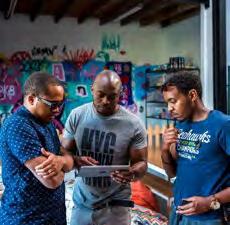
I feel like there were a lot of challenges back then simply because people’s mindsets were not ready for the technology itself. In Africa, technology anxiety was and still is real. Convincing people to take up XR technology was one of our biggest challenges. I don’t subscribe to coincidence. I think God orders our footsteps, and this takes me back to the Kingdom principles we follow at Black Rhino VR.
The thing is, my skill set and Michael’s skill set are unique and complementary. We were joined at the hip in those early days. We used to have brainstorming sessions until like three in the morning. We didn’t have the kind of robust software that has come up now, so we had to understand how to make things work. Even now that we are doing a lot of work within the XR spectrum, you still see people thinking that the technology is foreign and intimidating. That’s why a lot of the work we do at Black Rhino is demystifying the technology itself so that we can change people’s mindsets and help them understand the value of the technology.
How did you progress from there to landing your first 360 video gig?
Looking back, what were the challenges you faced?
We started with a very organised R&D approach. For us, research and development were at the core of our plan. We couldn’t ask companies for money at that time because we were still trying to understand the technicalities of 360 videos.On set with the Black Rhino VR team for Skate for Great Image courtesy of Black Rhino VR
I think 360 is still the lowest-hanging fruit and probably 40% of our turnover. What we also do is create experiences around computergenerated VR, Augmented Reality experiences, enterprise solutions, and content. We don’t do anything in Mixed Reality because the hardware is expensive. We also do a lot of training and capacity building, especially for young people that are interested in XR technology. I don’t want to be the only person creating VR and AR solutions. So, next year, Black Rhino will launch some XR platforms geared towards empowering content creators to disseminate and create their AR and VR experiences.
Extended Reality technology is still considered highly nascent in Africa. I believe in co-creation and collaboration because it helps to bridge the knowledge gap. One of my favourite projects was with Deep VR in South Africa. We had applied to the Oculus ‘VR For Good’ initiative, where content creators were partnered with non-governmental organisations, or people doing social causes to create a 360 video for the social cause.
We partnered with Skate for Great, an NGO in South Africa, and we worked with Deep VR to create the content in Cape Town. It was
amazing for us because we used to read about them everywhere. And you know the guys were like, ‘H ey! Black Rhino, we’ve heard about you guys. ’ And we were like, ‘ Deep VR, we’ve heard about you guys too .’ You can’t make this stuff up. It was an honour to work with them, and the energy on the set was just magnificent.

You just launched a space, OUT Reality, what was the thought behind creating it?
OUT Reality is our new baby. It was conceived with a vision to democratise access to extended reality infrastructure. It has two sides. The first is The Space, which is a platform for artists and contemporary art audiences to access technology and exhibit new media. The Space itself has a commercial arm as the first digital exhibition space in Kenya. So you can rent a
space if you want to create amazing experiences or do interactive art pieces. Whatever it is that you want to do, it doesn’t have to be XR.
And then, The Lab, which has the infrastructure, a VR headset, rendering machines, and everything that you need. It is a space for artistic exploration and sits at the intersection of art and technology.
For instance, an artist can come and work with a guy in blockchain, or work with a guy in AI. The lab itself aims at providing an experimental space that promotes interdisciplinary collaboration. We want to demonstrate the value of extended reality in Africa, not just in Kenya. And one of the things that we feel is important is access to technology and infrastructure.
Why do you think the community is important in growing the XR space in Africa?
My five siblings and I were orphaned when I was 16 years old. We would have lived on the streets if not for an uncle who took us in. Sometimes we went to bed hungry, and for many years I walked without shoes. So, one of the Kingdom principles that Black Rhino has is, the hand that gives is the hand that receives. Extended Reality empowered me and I’ve seen it do the same for others. Giving back to the community is Black Rhino’s meta culture. I think it was Nelson Mandela that said, ‘If you want to go far, you walk with others.’ So this is the point that we need to start experimenting and working with others, developing the value of the technology from the ground up, and demystifying what the technology is.
This is what makes up our mission and vision, and what informed the four Ds.
The first D is to design experiences based on the human-centred design approach. Humans are at the epicentre of XR technology. XR technology does
not exist without human intervention.
The second D is to demystify the technology. People fear technology, that’s why we want to demystify it by organising hackathons, workshops, discussions, and partnerships.
The third D is to deploy the technology by creating the building blocks of the future, which will be the fundamental structures that will help us reach mass adoption of the technology. We put resources into building these structures and infrastructures to support the growth
The third D is to demystify the technology. People fear technology, that’s why we want to demystify it by organising hackathons, workshops, discussions, and partnerships.
The fourth D is to deploy the technology by creating the building blocks of the future, which will be the fundamental structures that will help us reach mass adoption of the technology. We put resources
into building these structures and infrastructures to support the growth.
Sometimes it doesn’t make financial sense to run an XR agency, but look at what we’ve achieved - from two co-founders to a team of 15 people. God uses what’s in your hands to bless you just as he did with Moses when he turned the stick into a snake and parted the Red Sea. That’s why I know my destiny is deploying XR in the African context. I call myself an XR evangelist because I have witnessed it change the mindset and lives of people. Black Rhino has something called ESOP, which is the Employees Share Opportunity. Some individuals in the company have been with us for seven years. They are not employees but partners. We sit at the table as equal partners and talk about what we are trying to do with the technology. This is why we are passionate about empowering the next generation of innovators and inventors. It’s not a job, it’s our purpose; it’s not a business, it’s our legacy.
Demsytifying VR, one person at a time at one of Black Rhino VR’s many activations. Image courtesy of Black Rhino VR

We have workshops, demystification sessions, and discussions in every area across different demographics, and psychographics, to ensure that the potential and the power of the technology are understood. We also empower them to start creating solutions, or content, based on the challenges they’re experiencing in their society.
Of course, part of the demystification work that we do is to engage the community at every level. One of our schools is located in a slum in Kibera. We could have taken the school to an upper-middle-class neighbourhood, but we decided to take it to the slum because we believe that technology is the greatest equaliser. The school takes in six women from the film centre ecosystem. While three of the women are from Kibera, the other three women are from different professional settings. People come from urban areas to Kibera to understand not just the technology
itself, but for cultural integration.
We have workshops, demystification sessions, and discussions in every area across different demographics, and psychographics, to ensure that the potential and the power of the technology are understood. We also empower them to start creating solutions, or content, based on the challenges they’re experiencing in their society. So technology is an extension of their personalities which can be used to create immersive stories and AR experiences about the slums and urban cities.
You are passionate about building spaces and you need funding for that, how have you been able to finance your projects?
Our projects have attracted funding from different institutions. Just to name a few, we’ve gotten funding from the Ford Foundation, GIZ, Goethe-Institut, Meta, and the French Embassy here in Kenya. So there’s a lot of funding that is in capacity building. One of the challenges that people face with funding is that they don’t see XR as a business.
What is your business model? Even if you’re an artist, you need to understand that your art is also a business. The majority of XR is also within the Cultural and Creative Industry, and within the CCI, you have a lack of soft skills. People don’t understand how to write a business plan. People don’t understand how to do market segmentation. People don’t understand how to build a brand.
Speaking of funds, have you considered the role of policy in the growth of XR space on the African continent?
I’ve had numerous conversations around policy, but I must confess that it’s not my strong suit. Within the whole XR ecosystem, as Black Rhino, I don’t think there’s any policy work that will be done under our belt, because we are still trying to survive the tide, and look at how we can create financial viability, and also social impact at the same time. But if you ask me, I think the policy that we should all be looking at is how to support the XR industry. I think supporting SMEs from the ground is so important and the support is not just monetary. I say as Black Rhino, my problem is not money. My problem is shifting mindsets. I think support from big tech companies is a question of whether they have it as part of their company’s financial policy or not. Regardless, I see the value in creating policies that would support the growth of SMEs.
I think the policy that we should all be looking at is how to support the XR industry. I think supporting SMEs from the ground is so important and the support is not just monetary.
I say as Black Rhino, my problem is not money. My problem is shifting mindsets. I think support from big tech companies is a question of whether they have it as part of their company’s financial policy or not. Regardless, I see the value in creating policies that would support the growth of SMEs.”
You’ve told us about the content you create and your projects, walk us through the structure of the business?
Great question. So Black Rhino’s business model is about 60% commercial and 40% community development. I want to talk about human resources before I go into the hardware. The company has different departments cutting across 15 individuals. The marketing intelligence team is in charge of sifting through the XR ecosystem, and getting market insights. The finance team handles the financial structure and policies. The business development team is in charge of creating leads, positioning the company in the market, and developing proposals and pitches.
PR and communications and community management handle all our communications. It’s the onus of our communications department that Black Rhino’s voice (brand voice) stays consistent across all our communication platforms. The business assurance team creates structures that support the business. They ensure that there are structures that support turnkey business and an exit strategy in case investors come around. The marketing department has me as the Managing Director, and we oversee the running of the business and make certain of annual revenue growth.
The hardware includes all types of VR headsets, rendering machines, Windows-based machines, diverse camera solutions (live camera solutions to professional filming 360 cameras), sound solutions (spatialized audio sound solutions and lapel sort of subject capture sound solutions), and 360 photography equipment that target e-Commerce platforms. I believe in the future of e-Commerce and we’ve invested heavily in it, leveraging on AR. I’m happy because it has come at a time when I believe in creating that value structure within the company, after years of investing hundreds of thousands of dollars into it.
In terms of logistics, we use different forwarders from all over the world. We believe in partnership. Our logistic partners help us bring in a lot of equipment. Access to some equipment from both a cost and logistical perspective is crazy. It’s the reason why we may be audacious enough to create the first VR headset out of Africa. We’ll leverage the computing power of mobile phones to achieve mass adoption of the technology. Even John Carmack from Oculus said that when Oculus discontinued the Gear VR, they missed an opportunity. Africans need to see how to invest in VR for mobile.
Demsytifying VR, one person at a time at one of Black Rhino VR’s many activations. Image courtesy of Black Rhino VR
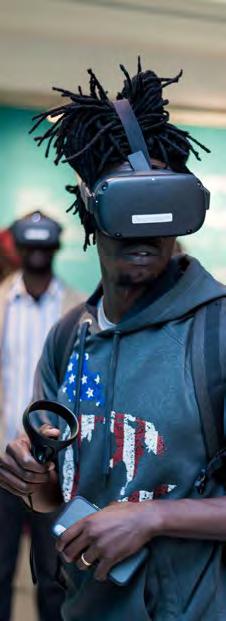
What are some of the biggest challenges XR creators are currently facing in Africa?
There are a lot of challenges. Number one, knowledge needs to be spread. We have a deficiency of skill sets, and our educational system is subpar. People in Africa believe that the West is more knowledgeable in XR. This is a form of neo-colonisation, because people look to the West for some of the answers of XR, although I’ve met very brilliant stellar Africans who understand different sub-sectors of XR.
From an engineering and storytelling perspective, Africa stands a chance in XR. I love to collaborate with the West because they have better social systems that allow them to afford a VR headset for $400. They have better companies that started way before we started in 2015. So I still believe
in some form of bilateral engagement between, let’s say, some countries in the global north and global south. Another challenge is access to software and hardware. We need to start looking for ways to get past this, even if it means negotiating with companies like Oculus to get headsets at subsidised rates. Another challenge that we have is spaces. There are online and virtual communities but no physical communities. That is the reason we set up OUT Reality. These spaces are needed so that like-minded people can converge, experiment, and push the frontiers of XR.
What comes after is policy and how it can serve the community. From an educational standpoint, we need to spread the knowledge of XR to
different demographics. There need to be discussions on how to incorporate it into schools curricula so that kids can start understanding the power of this technology and create their solutions as they advance. But I must say that we’ve proven to be resilient in Africa. We’ve found ways to ship in equipment, we’ve found ways to create communities and have meaningful conversations about what comes next. Already, we’ve created opportunities for us to start speaking and working towards a globalised XR presence. I see a future where Africans export XR content and solutions to the West and I’m proud because it’s by Africans but for a global market.
XR
about what
of NOMA! XR Experience - an exhibition in collaboration with Gothe Kenya. Image courtesy of Black Rhino
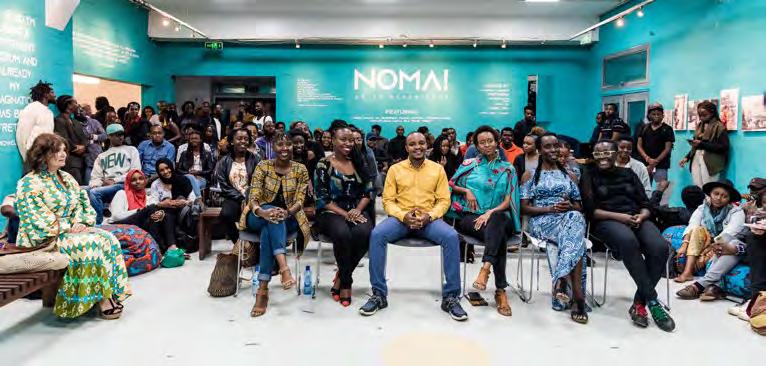
There’s a very bad joke that goes around where they say, the only thing Africans understand is consumption. We consume, we don’t produce. XR will start producing, whether it’s in Nigeria with Imisi 3D doing projects with students in schools, or in Ghana with NubianVR , or getting funding from UNICEF. I see the knowledge gap closing slowly at the grassroots level. In Africa we’ve been able to innovate around the mobile phone, more than on any other continent. So I would put my money and my resources into AR because I feel that Africans might lead the space when it comes to Augmented Reality.
Africans are not telling valuable stories to other Africans. We need to change this. Mark Zukerberg is in the clouds. He’s unreachable. So if you talk about him, I can’t relate. But if
you talk about Nigerians or Kenyans creating experiences, I can tell these stories to Africans. I have this story about a guy who walked into my studio four years ago. He was a linear video director and photographer. I put a VR headset on him for the first time, and this guy has never looked back. The other day he created a VR experience where you can shop for African clothes and it’s not your traditional H&M sort of thing. He created a whole Metaverse. We can’t keep comparing ourselves with the West. Immersive storytelling didn’t start with VR in Africa. It started with our grandparents and their grandparents when they came to visit. Our food, music, and culture are enriched with immersive stories. Africans need to start telling success stories about other Africans and make those Africans ambassadors.
The Metaverse is the next generation of the Internet but on steroids. It’s a foreign sort of technology for now, because of the barriers to entry in Africa. We are still battling Internet issues in Africa. How will we be able to provide the sort of Internet speed that is required for the Metaverse? Although technology is crawling in Africa, one day like Usain Bolt, we are going to run very fast. Before that time comes, we have to look at the challenges of today and come up with Afro-centric solutions. Only then can we start talking about the Metaverse, because if you ask me, the Metaverse in Africa does not exist.
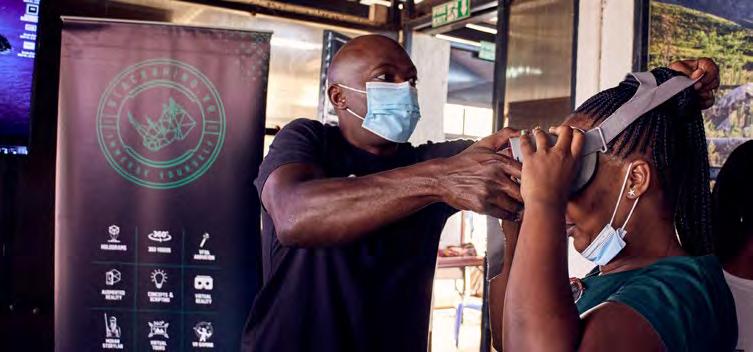
Christian Yves Fongang is an XR creator working in Cameroon. He employs XR technology to create gamification marketing campaigns for brands and creates customised VR training solutions for companies. He is also passionate about using his skills to create solutions that impact lives on the continent and globally. In this spotlight, Christian talks about how he got into the XR industry, and how emerging technologies will impact the future of Africa.

I did most of my studies in Cameroon where I obtained a degree in Telecommunications and Networking. I had some basic programming knowledge from school, but most of the things I’m doing in programming on XR were self-taught. I got a job as a network administrator in a cyber cafe which gave me free access to the Internet and I decided to learn how to develop web applications on my own. After that job, I moved into software development and that’s where my professional career started.
My first experience with XR was with a South African company called Free Minded Media . We were working on a DSTV project for the reality TV show, Big Brother Africa. This was around 2010-2011. One of the bosses gave us a task. We had to build this augmented reality kind of gamification, where the housemates searched for things using clues that were displayed with image recognition around the house. It was live on TV and we implemented it successfully. After that, together with the boss, we set up a company that focused on gamification using AR.
It has not been easy. When I decided to leave South Africa and come back to Cameroon, I spent almost six months looking for people. I had to train people and keep the best that I could at that time. I’m always repeating the same process, which is to train and keep some of them based on the project that I have. When we need to do some 3D stuff and I can’t find the right skill in Cameroon, I’ll have some of my partners and colleagues who are still in South Africa do it for me.
Could you tell us about the kind of content you create?
That would be both Virtual and Augmented Reality, depending on our projects or the needs of our clients. I am the CTO (Chief Technical Officer) coordinating two companies.
One company is focused entirely on gamification, AR and VR. I always insist on having gamification, AR, and VR depending on the clients’ needs. We also create some training tutorials for the industry on how to use Virtual Reality. I’m also involved in software development and mobile app development with the other company.

How easy has it been to find people with the skill set that you need to carry out projects?
It has not been easy. When I decided to leave South Africa and come back to Cameroon, I spent almost six months looking for people. I had to train people and keep the best that I could at that time. I’m always repeating the same process, which is to train and keep some of them based on the project that I have. When we need to do some 3D stuff and I can’t find the right skill in Cameroon, I’ll have some of my partners and colleagues who are still in South Africa do it for me.
What inspired you to move back to Cameroon and how is the XR industry there?
Moving back to Cameroon in 2016 was a choice I made because of the new technology. The cost of living in South Africa was very high, and training people cost a lot more.
To build a project like the one I have been working on, I needed to be in a place that required less funding. I believe we can build in Cameroon even if the market in South Africa is more ready.
Initially in South Africa, I was taking people from the university and training them in image recognition.
Back there, we were pioneering the field of AR. When I first moved back to Cameroon, XR was still new, and we were the pioneers. When people were looking for AR and VR solutions, most times they were referred to us. It was like nothing was done in Cameroon when I arrived here.
Now we are among the leaders in XR technology, though compared to people in Cameroon, South Africans are a bit advanced. I still have to get complex 3D work done in South Africa because they have the skills.
In these early stages of XR technology, how have you been able to get projects for your business?
So the first project I worked on was in AR back in South Africa, which was for DSTV. Here in Cameroon, the first project I worked on was for school people, it wasn’t public. After that, we worked with a big brand in Cameroon. People were surprised to see the campaign. The experience was wonderful, and I don’t think they will ever forget it. That was how we became a reference for what we’re doing, and we were approached by several companies that wanted to do something new.
What are the benefits of using XR technology?
’ll talk about gamification first. For me, gamification is a great tool to use to educate people. I was so shocked that we didn’t have people who were working on it in Africa. Our history is going away. Our children spend most of their time experiencing things from abroad instead of experiencing things from Africa. I decided to start working on gamification, although augmented and virtual experiences are more profound, because they engage the senses which, I believe, helps with memory retention. I would like people to use this technology to train themselves to be better people tomorrow.
Let me make it clear that the kind of content that I’d like to work on is educational. I’m constantly working on educational content when I have free time and resources. Nelson Mandela said that education is the most important thing that can change the world. Education is very important for our children. When I don’t have the time and resources, I work on gamification campaigns for companies. At the moment we are working on a VR training program for a big brewery in Cameroon. The way it works is that people interact virtually with the machinery, doing everything that they would do physically. These are things that could cost lives and materials, but we are using Virtual Reality to solve that problem.
I decided to start working on gamification, although augmented and virtual experiences are more profound, because they engage the senses, which I believe, help with memory retention.
I would like people to use this technology to train themselves to be better people tomorrow.
When I was working on gamification, I came across people who were working for big brands. They recommended my work to their management boards, and that’s how I started doing gamification for them and helping with their marketing campaigns. When one of the technical directors of the brewery in Cameroon wanted to do a project that would help develop the industry, he considered doing it overseas because there was to be significant VR input in the project. It was called Industry 2.0. However, the people on his management team mentioned that there was somebody in Cameroon who could get the job done. So we were contacted and given the job last year after passing the testing stage. We are now working on a VR training program for them.
I’m proud of my current project with the brewery because it has made a huge impact on their training process and cost. The idea is to build it in Cameroon and share it with other parts of the world where they have a presence.
I believe it has reached about five to ten countries at the moment. The educational program I’m working on is still under development so I can’t say that I’m proud of it yet. I should add that doing marketing campaigns is not so interesting for me because it impacts just brands. I want to impact lives.
SDK games champions engaging, gamified experiences to aid learning and hel with memory retention. Image courtesy of SDK Games
The goal is very big. I started working on it when I switched to AR in 2014 and was planning to move back to Cameroon. I started in AR by doing some chemistry and science experiences. Sometimes I did a demo using a phone and a camera. We had to work with some teachers and the Department of Education in Cameroon to provide content. Unfortunately, people in Cameroon demand money whenever you want to work with
them. So we decided to first break it down into multiple steps. The first step was to digitalize the content, which we did. The second step was to start introducing Augmented Reality slowly into the process. We were supposed to go live on TV to do campaigns for it, but COVID-19 hit and that stalled things for us. As things are slowly recovering after the pandemic, we are looking at how to get back on track.
We also have big concepts like creating content for VR and also building a content creator for educational purposes. The plan is for teachers to get into Virtual Reality and create experiences for their students. Even if somebody else makes a similar product, we are okay with it as long as we can help children learn faster and memorise better so they can become proficient in the future.

That’s interesting, how were you able to get the project with the brewery?
What software and hardware do you use for your projects?
The software that we use is mainly Unity . For hardware, we use the Oculus Quest , Oculus Rift , and the HTC Vive.
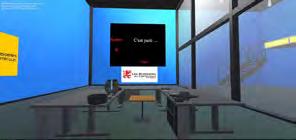
Many people complain about access to equipment, how easy has it been for you?

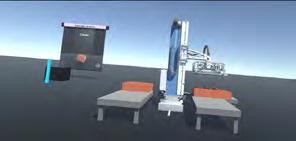
Access to them is not easy here in Cameroon. I pay for equipment online and have it delivered to a friend in Europe or the US who passes it along to someone travelling back to Cameroon, and the person will bring it to me. Even when I want to get a computer with graphics cards, there’s no easy access to that. The last computer I bought was from South Africa, and it was my sister who was returning to Cameroon that brought it along in her luggage.
How does the lack of access to equipment affect your work?
If I want to work on a gamification campaign that requires body trackers, if we don’t have somebody who’s travelling, we have to cancel the client’s project, because they can’t wait for one or two months. There have been several instances of project cancellations due to a lack of accessories. Renting out equipment is also strained, because there are times when we have less than what a client wants. Even if they have the money for it, they’ll have to order it and wait till it gets here. So that’s a negative impact on our work.
There have been several instances of project cancellations due to a lack of accessories.
Renting out equipment is also strained, because there are times when we have less than what a client wants. Even if they have the money for it, they’ll have to order it and wait till it gets here. So that’s a negative impact on our work.

There are three challenges that I face. The first is the lack of human resources, and the second is funds. Training people requires funding. You cannot just hire people and start training without giving them something. The third challenge is that the equipment is very expensive in our market.
What I try to do is to get university students as interns and train them, because it costs a small amount. At the end of the day, some of them will stay and work with me, and the others will go. That’s life. When it comes to funding, I get funds from the projects I do for paying clients and inject them into my project.
Mostly when I show people a demo of what we propose to do for them, they are amazed. Even if they believe it’s just a game, they are still amazed by it. So, it’s not really a bad misconception.
What are your thoughts on Africa’s representation in the XR space?
There’s a gap in our representation on the global scale. We don’t have a lot of African content representing Africa, and we don’t have the people that can create the content. I believe there is still so much that Africa can do in the VR and AR space, and we need more people that are skilled in XR technology.
How important do you think community is in growing the XR space in Africa?
There’s the African AR/VR hackathon in Cameroon. We have been working with the community that came out of there. That’s mainly the event I’m engaged in. I was also invited to South Africa in November, last year, to speak at the African Trade Fair. There was a discussion forum about the XR community.
Ultimately we must consolidate what we have at the moment. First, we need funding to support the community. If we can get pioneers to move from country to country to
rally people to support the industry, that will be great. Secondly, we can organise showcases that will last for a week. By this, we’ll be able to create awareness and pique people’s interests. We are not just going to showcase what we have done, but also train people. For instance, we can do a showcase in Nigeria this year, next year we do it in Cameroon, and we move like that. We need people who have experience in the industry to move around these countries and get people’s attention.
There’s a gap in our representation on the global scale. We don’t have a lot of African content representing Africa, and we don’t have the people that can create the content. I believe there is still so much that Africa can do in the VR and AR space, and we need more people that are skilled in XR technology.
Third, we have to consider where we can invest the funds so that we can get people’s interest. If we look at when the Internet came to Africa, it was popularised by opening cyber cafés where people could access it. So, if we open public centres with good equipment where people can go and experience Virtual Reality, it will encourage more people to use the technology. We can come up with a name for it.
Could you tell us about the challenges that you face as an XR creator?
What misconceptions have you encountered regarding the work you do?
If you had access to more funding, what would you do with it?
If I receive more funding I’ll focus on my educational program. I want to launch a TV show where we can demonstrate what we are doing for people to see and to gain their interest. As I mentioned, I’m mostly funding the program on my own.
I received a little support from some companies when I first did a TV show where I had two schools compete against each other using AR and VR. I did only one edition of the challenge before COVID-19 hit. So, with more funding, I’ll be able to relaunch the competition and get schools to participate.
What can you say about policy and how it can impact the development of the African XR space?
Let’s look at the Metaverse. We need to be able to protect not only the privacy of people, but also protect the content creator. Our work as XR creators is like that of an artist. Creating a Metaverse world is unlike the content creator system that we are currently working on, where people will have access to it. If I create a Metaverse, I expect that there should be a policy in place that ensures I receive some royalties. The privacy policy should also be clearly defined because people, especially children, are getting into the virtual world and they need protection so that they can access only appropriate content. There should be policies in place to regulate content in VR.
What are your thoughts on Africa’s representation in the XR space?
There’s a gap in our representation on the global scale. We don’t have a lot of African content representing Africa, and we don’t have the people that can create the content. I believe there is still so much that Africa can do in the VR and AR space, and we need more people that are skilled in XR technology.
Do you think Africa is well prepared to experience the Metaverse?
When I want to talk about the Metaverse and how we can live in it, I usually use Mark Zuckerberg’s video to explain it to people. I use the video to show them that we’ll be able to live and interact within the Metaverse . Most people are still very confused because it removes the need to connect and interact physically. They are scared of being isolated from people. The fact is, you cannot stay indoors wearing the headset all the time. Yes, you need the headset to live in the virtual world and enjoy all its benefits. But, you need to take the headset off to live your life in the physical world.
I grew up with a lot of electronics around me, from Playstations to computers. I’ve always managed to split my time between them and pursue my social life. So, I’m not
worried that I would be sucked into the virtual world.
The Metaverse is growing, and it’s something that I dreamed of when I was younger. Before I started the educational project, I was thinking that Africans travelled to the US or Europe to study. With what we have now and the accessibility to headsets, a person should be able to stay in Africa and study in the US.
You can attend a virtual class with your classmates and once the class is done, you take off the headsets and resume your normal life. So the Metaverse promises the ability for Africans to study anywhere in the world without leaving the shores of Africa. That’s why I only see the positives that the Metaverse offers if we can manage it.
I haven’t thought about how Meta can engage Africans. I assume that they are already working on some content. To answer your question, one way they can engage us is to build a platform for us to interact. Another way is to allow us to create our content and plug it there. For me, that’s the easiest way to engage us, and it’s what we propose to do for teachers with our educational content creator.
What is your vision for XR in Africa both short-term and long-term?
I’ll say I don’t have expectations one year from now. I said before that the equipment is still costly for us here in Africa. We are still trying to provide food to eat every day, and we don’t have the luxury of purchasing that type of equipment.
But in ten years, I’m looking at XR equipment being in every household just like we have the television. People should be able to experience everything, travel across the world without moving from their homes, learn new skills and embrace advanced technology. That’s how I envision the future of the Metaverse and XR in the long term.
My short-term goal is to stabilise my finances. Without financial stability, it will be difficult to create great stuff. I also want to finish the project that I’m working on with the brewery in Cameroon.
I’ll say I’m a little bit lucky to have good Internet speed. It’s not as good as the one in South Africa or the States but it’s better than what most Africans have access to. We have problems with the Internet, equipment, and electricity. A content creator has to deal with electricity cuts for two to four hours daily. It would be cool if Oculus Quest or other headsets come with a battery pack so that we can charge and use it instead. If you have to deliver the work that day, you may be unable to meet the deadline.
Most of my clients are based in Africa. We are working on an approach to get referrals from one of the guys I trained. He continued his studies in Europe and was able to start working thanks to the skills he developed while he was with us. He mentioned that he’s getting a lot of orders for XR and wants to refer those companies to us. So we are looking forward to having clients from Europe and the US as well.
Beginnings are very difficult but I’m sure we’ll get there. I see young people in Cameroon building their skills even though they don’t have access to equipment. This is why I believe they will do amazing things when given the chance to.
Beginnings are very difficult but
I’m sure we’ll
get there. I see young people in Cameroon building their skills even though they don’t have access to equipment. This is why I believe they will do amazing things when given the chance to.
What more can you say about working in Cameroon?
A founding member of weAReVRjozi and the MetaVerseCrew (MVC), worldbuilder and environmental artist Dale P. Deacon runs the TeamEpic.org research and development lab. Dale facilitates the design and development of digital media projects with a focus on immersive media. In this spotlight, he talks to us about his journey into XR, his work as a worldbuilder, and what it takes to be a community builder.
I studied Informatics in university and got my career started as a business analyst. As the years went by, I wanted to take my work in a more creative direction, which is when I made the move into the marketing world. I was in marketing for a couple of years when I started to learn more and more about Virtual Reality and Augmented Reality. I remember when the Oculus Rift kickstarter was announced and I really wanted to get on board but I just didn’t have the funds at the time. That really piqued my interest in the technology, and I kept tabs on how things progressed. A while later, the google cardboard came out. I had one of the first VR experiences that really blew my mind. It was a bird simulator game where you would fly from island to island. It was a very simple VR experience because it was on a smartphone, but as a gamer, it was already clear to me how quickly games and computer graphics improve.
I saved up some money and took a big leap. I started my own company focusing on virtual and augmented reality software development. I continue to supplement this work with tech writing, community organizing and educating.
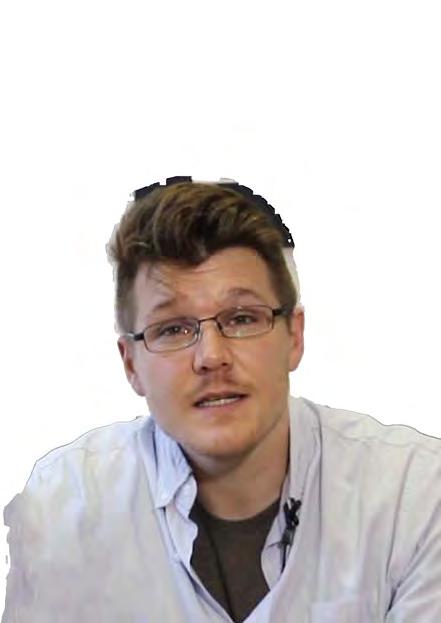
Before building virtual worlds, you were in a different industry, can you tell us how your XR story got started?
So you had made this decision to move into building for XR, what was the first thing that crossed your mind?
I guess the first question was, “ Do I go with Unity or Unreal ?”. Obviously, there are other options out there, but those were the two that I was weighing up in my mind. I found that the advantages of using Unity slightly outweighed the advantages of using Unreal. So the first step was to download and play around with Unity.
Then I got back into coding, because when I was working in marketing, I was doing a lot of solution architecture and project management, and not as much coding, as I was in varsity. So I had to get back into scripting. What I’ve realized though, is that Unity and Unreal aren’t all that different. It’s far better to take the time to be proficient with both toolsets than just specialize in one.
Can you tell us about some of the resources that helped you as you got started?
I think most of it was trial and error, trying a particular solution then realizing that it was the wrong route, and then quickly correcting it. When I studied in university I did a lot of coding, which helped, but the vast majority of what I knew about building XR solutions was self-taught. A lot of it was late nights Googling and trying to figure out how to get around a bug.
If I heard about an interesting piece of software or an interesting piece of hardware, I did a bit of research to try and figure out how it could be useful, and if it was worth spending time and money on. If it was, then it became a process of finding out what right resources were to learn more about it.
A lot of it was out of necessity too. Just recently, we worked on a project where the fur on one of our characters just wasn’t holding up on the mobile devices. Our team did a lot of research very quickly to try and figure out what a better route was, and I think that same principle applies to a lot of things we do. You try your best upfront to make a good decision, but sometimes you end up resolving it on the fly.
You work on both AR and VR projects, how do you divide your focus between them and what tools do you use?
I think I probably spend about 55% of my time on VR projects and then about 45% on AR projects.
In VR, I tend to build sort of high spec worlds. They are not exactly intended for the average user. I’m always trying to build the best looking worlds that I possibly can. When it comes to AR, however, you’re very much bound by the hardware constraints of a smartphone, which is nothing compared to a high spec PC. So there’s a small difference in my workflow there.
Starting with software. I use Unity every day, I use Photoshop and Visual Studio Code. I’ve been using iClone, Character Creator and Blender a bit recently, and then more and more this year I’ve been working in Unreal.
With respect to hardware, I have a Samsung Galaxy S 7, an old android phone that I use to test AR projects, and a client is loaning me an iPad Pro for a project. I also have an Oculus Quest 2 and MSI laptop with an RTX 3070.

When I started Team Epic, one of the first things I did was reach out to different people that were already in the industry making cool things. That helped me understand the industry a bit better and make some good professional connections.
My first few years were spent trying to get jobs and trying to meet some cool clients. It was a tricky process at the beginning, because when you’re starting something new like that, you don’t really have that much of a reputation, so you really have to hustle super hard, and it can be really challenging. I was supplementing whatever downtime
I had, doing tech writing jobs, any sort of freelance jobs that would help to keep the bills paid.
Luckily, I met a lot of great people in academia, who were very interested in teaching their students about VR and AR. So I did quite a few guestlecturing gigs at the University of Johannesburg. They’ve got a really great forward-looking Information Technology Department.
I think there’s a misconception that XR is a field of technology. It’s not. It’s a field of media. So I did a talk in the architecture school, I did a talk at the public relations department. I
think it’s a common misconception to think that just because there are wires and screens means that it has something to do with technology. It’s not the technology that matters, what matters is what we do with it.
To go back to your question, I did lots of tech writing, lots of small gigs, lots of indie work, and a little bit of consulting those first couple of years. About halfway through last year, things picked up for me a huge amount. I’m very grateful and very lucky about that. Now I’m still working a lot with academics, building apps, but also getting quite into the Virtual Reality events scene.
One thing that inspires me about VR is that you can be teleported from one place to somewhere completely different. I think teleporting someone into a more peaceful, serene environment is something that has huge potential

I’ve been working on a Virtual Reality meditation and mindfulness app. I started off building it for Steam and the Vive, but then the Oculus Quest came out, and I realized that the Vive’s days were numbered. So more recently I’ve been working on a
Quest 2 standalone version of the same app. The tricky part about development is that it takes a lot of time, testing takes a lot of time. You can’t rush them. So I think, although it’s taken a lot longer than I’ve wanted it to, I’m really looking forward to releasing it.
Tell us how you got started with Team Epic and how the first couple of years were?Serene VR worlds built for VR Chat Image courtesy of Dale Deacon
Tell us about some of the projects you have worked on, and the ones you are most proud of.
I’d start with an Augmented Reality app we built for the Origins Centre at Wits University, which is a museum oriented around discoveries of early humans in Africa. We worked with them to build an Augmented Reality mobile app that works on iOS and Android. It’s called Origins Centre AR, you can check that out in the stores. Probably about 50% of the functionality has to be done at the museum, but the other 50% can be done from home. We worked with the Evolutionary Studies Institute to bring some local South African dinosaurs to life using Augmented Reality.
I have also been involved in quite a few VR festivals. I helped with some of the portal worlds and some of the preview worlds for some of the participants in the Venice Biennale 2021. For example, Felix and Paul Studio did a really innovative
International Space Station video 360 film. We helped bring a preview of their film to VR chat for the festival. Similarly, I helped build the Red Sea immersive showcase world, also in VR chat. Recently, I teamed up with the DIFF and the GoEast festival to share work done by Eastern European artists in VR.
You will see a lot of my work is in VRChat. And that’s for a couple of reasons, but mainly because it’s relatively quick to build on, as a lot of the functionality and the features are baked into some of the Prefabs and the SDK. Also, because VRChat handles all of the networking, all of the instance management, all of the servers, as a creator, I don’t have to worry about infrastructure issues that might come up.
At the Venice Biennale, I had two pieces that were shown there. One
was a Virtual Reality forest where you were guided through the experience and you traversed the storyline in a non-linear way. Openworld VR, in a sense. You pick up different chunks of the story and you piece them together yourself.
The other piece was an AI-produced music stream that was displayed in Virtual Reality. So there was a team that built an AI trained on death metal and heavy thrash metal that generates its own songs, thus making this never-ending stream of music. We gave it a home in Virtual Reality, where procedurally generated visuals would sort of rumble and morph along with the music.
The pieces are called the Spirit of Place, and bliss in the ear of the storm respectively. You can find both of those on VRChat.
Spirit of Place is an open-world nonlinear immersive storytelling experience that seeks to imbue the audience with a sense of oneness with our environment.
courtesy of Dale Deacon
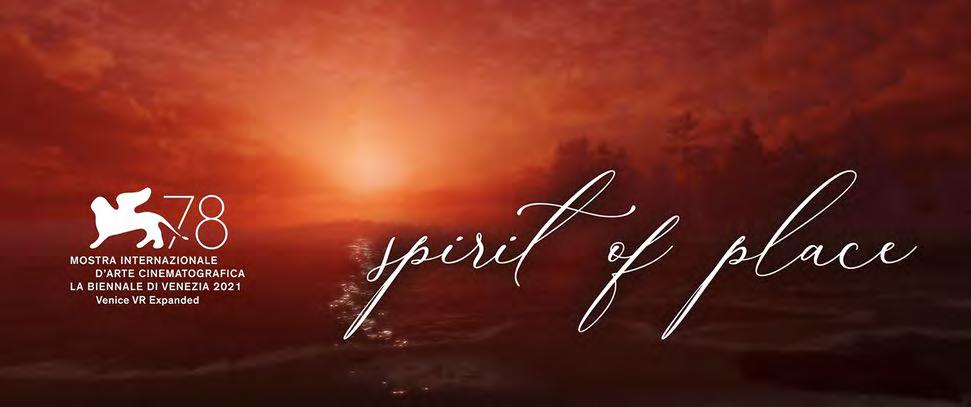
I think in the early days, one of the biggest challenges was trying to build a reputation. Reputation is a challenge for anybody that’s starting out as an independent developer. The only way to solve that is to put out good work.
Another challenge, especially a couple of years ago, would have been just how many people were aware of Virtual Reality and Augmented Reality, what the differences between them were, what they could be used for, and what the advantages and disadvantages were. I think every year, this particular problem shrinks a little. When Pokemon GO came along people started to understand what Augmented Reality could do. Instagram filters came out and now everybody understands what facial filters and that aspect of Augmented Reality could do. I think the understanding of the benefits and pitfalls of these technologies definitely changes and adapts over time. So that’s becoming less and less of an issue.
One last thing, which I think is probably one of the biggest challenges at the moment, is the lack of funding for creators. It’s incredibly difficult to go from like, zero to just starting out. I think wellfunded competitions, well-funded hackathons, and well-funded exhibitions of people’s work, go a long way in creating a better artist community, and a better developer community.
The arts aside, there’s also an economic reason to fund this industry. There’s huge potential for new jobs, new careers and new businesses in VR and AR. But we’re not going to see that opportunity taken advantage of until there’s more investment from the public and private sectors.
One last thing, which I think is probably one of the biggest challenges at the moment, is the lack of funding for creators. It’s incredibly difficult to go from like, zero to just starting out. I think well-funded competitions, wellfunded hackathons, and well-funded exhibitions of people’s work, go a long way in creating a better artist community, and a better developer community.
The arts aside, there’s also an economic reason to fund this industry. There’s huge potential for new jobs, new careers and new businesses in VR and AR. But we’re not going to see that opportunity taken advantage of until there’s more investment from the public and private sectors.
What are some of the biggest challenges you have faced as an XR creator?
Being a community builder, do you think there is an accurate representation of the African XR community?
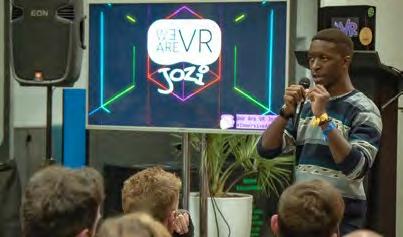
I think that’s a difficult question to answer. Represented where? In the general media? I think in the end, do we want a representative image or do we want to have a proportionate image? The truth is there are probably a lot fewer VR and AR creators in Africa than there are European or Asian or American VR and AR creators. I think what’s important is that we do our best to promote the creators that we do have locally, and help inspire new creators to join the industry. I think the onus is on us to grow the industry, rather than wonder what the level of representation is like.
Following that, can you tell us about some of your personal efforts and activities in the community?
Sure. The Metaverse Crew is a group of people from around the world that get together on Discord once a week to try out different VR technologies and different worlds. We come together to share ideas, tools and techniques. It’s very much an open community to folks who are just generally interested in Virtual Reality. We then go and world-hop through VRChat, Helios, Altspace or wherever together to explore what members have created.
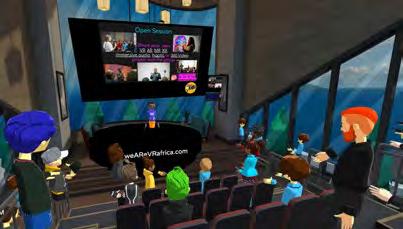
Then more locally, Daliso, I and a bunch of other people from the community have hosted over 20
WeAReVR.jozi events in person showcasing people’s work, projects and their teams. When the pandemic came along, we had to move everything online.
We hosted a bunch of Virtual Reality events along similar lines. Today, we are more focused on our WhatsApp community of sharing opportunities, projects, work, and news.
As event restrictions are starting to wind down a little bit, I think we’ll probably go back to doing inperson events at some point.
Those are my two main community endeavors.
I think it is a strong community we have here on the continent. At the moment, it’s a relatively small group of creators, studios and artists, but I think it’ll grow over time.
It’s very important to have this com munity. It’s one of the best ways to learn from and meet people who are already doing the thing that you want to learn. For more experienced people, it’s an opportunity to share your work and get feedback from other experts, so it’s a win-win for everyone.
At the beginning of the interview, you mentioned that you self-funded most of your projects, can you tell us a little bit more about that?
Yeah, all of my projects have been funded through working with clients to date, and I’m pretty happy with how that’s gone so far. That said, I wish there were more competitions. I think one of the best ways to fund a lot of new projects is by hosting competitions. This is why the X Prize has been such a big hit for over a decade. With a well-funded prize, you can get a lot of different participants and a lot of different creative ideas trying to solve the same problem.
I think that’s a really effective way to use funding, just in general. I’m very much in favor of hosting and participating in competitions such as the ARVR Africa Hackathon we’ve hosted with community builders from around the continent.
There’s been a large uptick in the use of the word ‘Metaverse’ over the last year. As someone who has been using this word for a while, how have you come to understand it and what concerns do you have about its new popularity?
I think that’s an easy one. A lot of people overcomplicate this idea of the Metaverse, but it’s very simple. The Metaverse is the Internet but in 3D.

You can walk around it, you can walk inside it, you can walk through it, you can have these objects around you. That’s as far as we need to go with a definition of the Metaverse.
I think when people go too far down, like roads, like digital twins and metahumans and all that stuff, they are just introducing more jargon that just puts people off.
You could simulate a training exercise, whether it’s in medicine, or you could simulate training for pilots.
These things have been done for a long time already. There are huge benefits to be wrought.
There are obviously risks involved but I think it’s important that we stay optimistic about the potential for this industry, and not shoot it down before we’ve even had a chance to explore the benefits.
I think in the short term, it’s going to be really interesting to see which companies can produce some sort of an iPhone-like moment for VR and AR. We might already be there now with AR, because we had apps like Instagram, Snapchat, and Pokemon Go. I’m sure in the near future, there are going to be a whole lot more interesting Augmented Reality apps.
It’s very interesting to see how Virtual Reality has progressed quite differently. It may be lagging behind because it requires specialized hardware, and as much as the Oculus Quest has brought Virtual Reality into the lives of a lot of people, I still don’t think we’re really close to mass adoption.
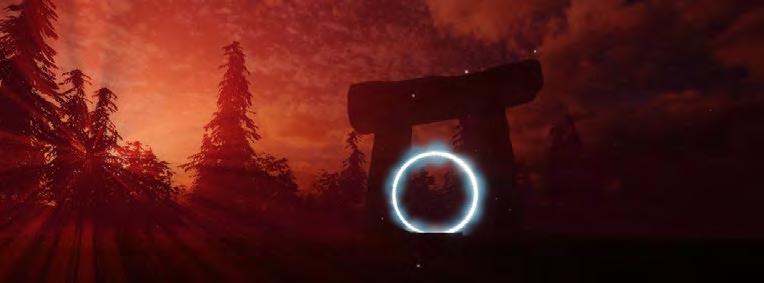
In the long term, I think these two things are going to combine. And that’s why companies like Microsoft don’t talk about VR, and they don’t talk about AR, they talk about Mixed
Reality, which is the combination of both of these mediums. I think if you go far enough into the future, you’ll see Augmented Reality and Virtual Reality having much more overlap, and having these kinds of virtual experiences integrated into our real lives, and our real lives integrated more into the virtual world.
Personally, I am very much looking forward to creating more Virtual Reality, mindfulness experiences, breathing techniques and exercises. I’m going to continue to focus on that, and I’m looking forward to seeing how that progresses over the next few years. More broadly, I’m looking forward to seeing how VR and AR are adopted in my own city, to seeing more and more people using it, to seeing more and more creators creating interesting art pieces, statements, apps and applications. That’s very exciting to me.
In the long term, I think these two things are going to combine. And that’s why companies like Microsoft don’t talk about VR, and they don’t talk about AR, they talk about Mixed Reality, which is the combination of both of these mediums. I think if you go far enough into the future, you’ll see Augmented Reality and Virtual Reality having much more overlap, and having these kinds of virtual experiences integrated into our real lives, and our real lives integrated more into the virtual world.
What future do you see for XR and what part do you think you, and Africa, will play in it?Spirit
Daniel Getachew is the founder of Guzo Technologies, an Ethiopian company that specialises in creating and building VR experiences in CGI. His interest in technology started from childhood, leading him to obtain a Bachelor’s degree in Computer Science and a Master’s degree in Software Engineering. His career spans diverse fields in tech including UI/UX design, motion graphics and XR. He has trained students with different programming frameworks and once worked as a security pen tester. In this spotlight, Daniel shares his journey in the XR space, the challenges tech faces in Ethiopia and his hopes for the future of XR in Africa.
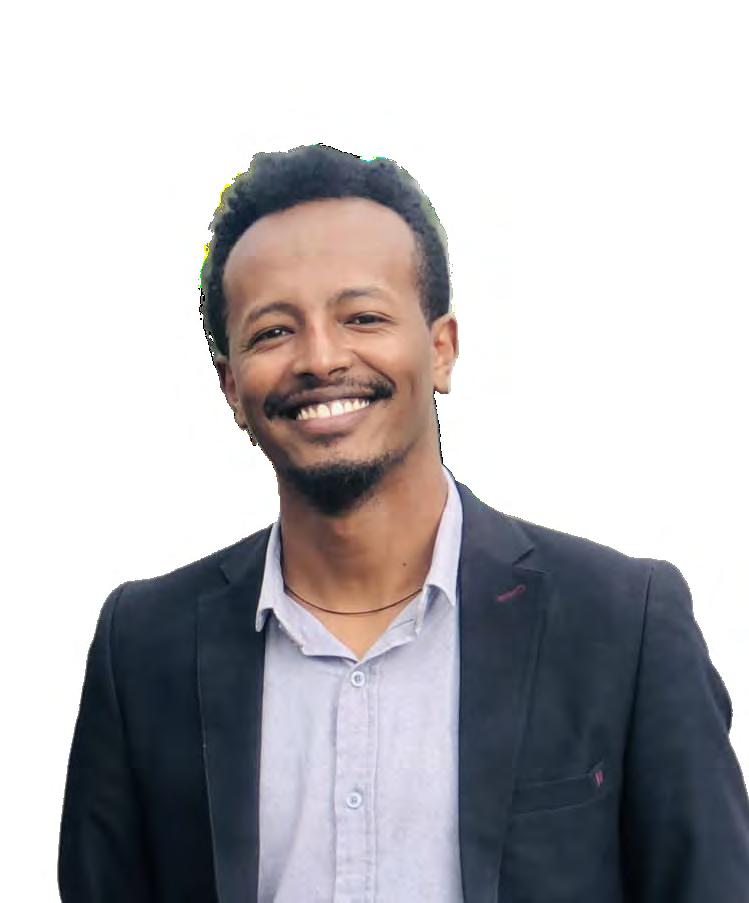
Being a graduate of Computer Science has allowed me to master Virtual Reality/ Augmented Reality. And then I studied software engineering for my Master’s degree, where my thesis was to create a QR code-based Augmented Reality framework. So, my academic life helped me learn about technology, tools and trends. I also worked on different projects relating to VR, and all these helped me get into XR as time went by.
Could you tell us about some of the roles you’ve experienced in your career?
For one who has different talents, I have been involved in different things. Mostly, I trained students using different programming frameworks which were available on the market. I taught around five or six different subjects. Most of the training was in web technology.
I used to work as an independent contractor for Gebeya and as a freelance worker for different applications, especially local applications. At Gebeya, they basically trained us to become professional developers and put
Innovate Better - a foundational ethos for Ethiopia’s dynamic content and technology studio Guzo Technologies. Image courtesy of Guzo Technologies

us in a digital marketplace where clients could hire us. I got hired by a Swedish company as a full stack developer. I also used to work as a pen tester (a security pen tester).
I also used to work for the national television company. They hired me as an intern because I was not qualified to be a formal employee. I would create different visuals, especially when news starts, for the intro and outro. I also made a few animation videos, especially for kids.
After I graduated from Gebeya, I participated in local projects, which were big. In the music industry, I contributed to applications in the payment aspect. I participated as a full stack engineer, which is the web part, the DevOps part, the backend, mobile, and the API’s, hooking different payment systems to different products.
I’ve been doing this all over Africa through Gebeya. So I have clients from Senegal, Nigeria, Kenya, Egypt and especially Ethiopia.
The first experience, I can say, was my capstone project back on campus during my Bachelors degree. It was called Advanced security & multimedia management System and was one of the top-rated projects by the time I graduated. A total of 10 projects were selected at that time. One of its components was the Virtual Tour experience, which let you see the campus area so you knew exactly where to go. So, new students joining the university would be able to find their way around. It would help them identify the pharmacy, dormitory areas, cafeterias, and all other different
things. It was a web-based experience, so you didn’t need a VR headset, but you could see it online in VR, which is cardboard. I never tested Virtual Reality headsets because at that time, we didn’t have one.
Before doing my Masters, I took three months to master Android in developing Android applications using a very unique product called B4X. It’s an Israeli-made product, which I discovered. The guy who created this platform is one of my role models. He came up with an entire framework that does iOS, Android, Java-based applications and open-
source hardware products, like Arduino , Raspberry Pi
I was so amazed that I checked his website and tried contacting him. He gave me one task, which was to translate or add a new language to the platform. I contributed our own language to that product (Amharic language) and I also contributed in building different libraries. For those three months, I was learning about Android applications, and that was the reason to build a mobilebased VR experience.
During my free time, I would always check the Internet to see what others were doing. I wanted to be able to measure up to what other countries like the US and Europe were doing, so I taught myself. No institution would teach you about VR/AR or any software. I was able to learn from Youtube. I had a hard disk I used in collecting a lot of tutorials. I would watch those whenever I had the time.“
So what did you use for your 360 images?
I asked my dad if I could use the only precious digital camera we had at that time. I told him I would need it for the next 6 months and he was fine with it. I remember it was a 12 megapixel Samsung digital camera. Imagine having to take more than 70 images in one hotspot. And I didn’t have a 360 camera, so I needed to take individual shots and place them in Photoshop and other applications. I used that to generate the 360 images.
How were you able to learn all of these?
During my free time I would always check the Internet to see what others were doing. I wanted to be able to measure up to what other countries like the US and Europe were doing, so I taught myself. No institution would teach you about VR/AR or any software. I was able to learn from Youtube. I had a hard disk I used in collecting a lot of tutorials. I would watch those whenever I had the time.
I did a lot of reading just to see what I could do to either rebuild or recreate what’s known in Europe or in the US. I came up with the media streaming software. By the time I graduated, I gave it as a gift to the president of the university because they’d been using my product for five to six years, and they were specifically using it for graduation streaming.
Could you tell us about some of the experiences you’ve created?
Where do you see yourself working in the near future?
I see myself working on my own ideas or being involved in unique technologies, especially technologies which help Africa in general.
I had been looking for investors, unfortunately, none of them were qualified to understand the technology. I know investors have the cash and they don’t necessarily need to know about the technology, but at least they have to be supportive, or they need to back off from the decision, right?
But these people, they just wanted to see things their own way and would make you an employee in your company, so you don’t make any decisions. You would come up with the idea and hand it over to them.
Most of the investors that I met during that time were not qualified to work long term.
So, I started looking for a way to start my own company and luckily, I established those technologies and I became the CEO, even getting the team before I started the company. Having the right team members to boost your ideas is important.
I made the mistake of looking for the right investor, because investors will come once they see your company works or you have a good product.
When we started the company, we were focused on Virtual Reality and related services. But in about six months, the pandemic entered Ethiopia and made us panic as a startup.
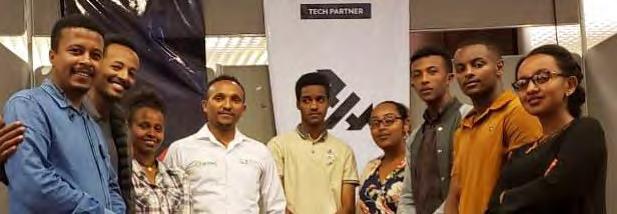
Closing your office for eight months is really bad and you need to pay rent, you have a lot of bills, so we added a different department that only focuses on the hardware aspects i.e. robotics and IoT.
There are clients who need really small design work and a prototype, or a proof of concept. And I said, if we got these two different departments, one working on VR, the other working on the hardware, why not build or come up with the XR?
Establishing a startup is not easy in Africa. You know that the financial source is one issue. The other is having the right idea on time. Because, timing can be a problem. We thought we were ready to start VR but the situation in Ethiopia, especially, was not encouraging. It’s so frustrating, the politics, the chaos. There are unexpected factors which let you hold on to your idea. And finally, the pandemic.
At that moment, I was looking for grants. That’s where I met some of the Epic Games employees and directors, and they told me about the opportunity, and recommended me to the MegaGrants programme. That was one of the best things that happened to our company last year. It took us six months to showcase different experimental projects. We created, we prototyped and we presented it to the team.The grant opportunity gave us the chance last year and we announced four projects.
My team is mostly into the tourism sector because we see a big gap knowing that technology by itself is not enough. I think we found it easy to target the tourism sector because Ethiopia is known for different historical heritages, different cultures, and different ways of life. You can name maybe seven of the cultural celebrations, and also historical heritages, that are registered or inscribed in UNESCO. Using tourism was a good way to introduce the technology. Tourism is one of the major pillars put in place towards the country’s development. I
feel like we create content for culture. We are the only company in Ethiopia that does photogrammetry. We scan statues, artefacts, and we come up with this futuristic museum that lets you experience all the things that you see in the physical museum. People who see the experience, or who play with the experience would be interested to visit and see the rest of the museum. Other sectors are becoming encouraged and motivated. At this moment, we are also building content for aviation, which is a training or EduTech-related VR content. But most of our projects lie in tourism, culture and the arts.
360 captures of heritage sites in Ethiopia by GuzoTech Image courtesy of Guzo Technologies

My favourite so far is a haptic feedback suit with the experience. There is a bike that you can ride physically in a stationary place and that experience will automatically let you drive some scenes in a VR experience at the same time. We added the haptic suit that we created locally, and used massage motors from a massage suit. We took those components and we modified our own components into those motors and programmed each motor based on different consequences.
At times, it could be audio signals, or something that you can send directly from the VR scene and the haptics will

be triggered, that way, you can fully immerse the user in the experience.
We’ve been testing this product ShirShirXR. ShirShir means taking an experience outside with your bike, so you just go from one place to another place to enjoy the place or city. We named it ShirShir XR, because it has both the suit and the experience at the same time. My products are like my children. I don’t give priorities. The story behind that product gave us a chance to present our startup and also our country on a big stage at the Laval Virtual Awards.

Most African companies that specialise in XR either have good investments or a side project they focus on. We do virtual production, and right now, 80% of our revenue is from virtual production in advertisement. It’s not our official business model, but it’s a way of getting revenue. The business model is not something that directly relates with your annual revenue or a way of getting income to the company. But for us, we want to build VR content. Our VR business model is to produce, to design and to gamify VR content and maybe sell it to
business owners. As you know B2C is really hard for VR business, because it requires a lot of gadgets and it might also require third-party application services like Oculus, or Steam and it also needs Internet access. So, on top of smartphones, this will be another additional item or gadget that you have to buy. Based on that number, we will have a target in sales. Our move is not for business for consumers, but rather, for business owners. Maybe it’s a model that lies in these two, which is business to government, or business to business.
What has been your favourite experience in XR so far?
How would you describe your business model?
For me, it’s not about the number of people, but about getting the standard and likeminded people who want to learn new stuff and align with my vision. That’s how I found out most of the team members.
We have gaming machines, like Predator gaming machines, for VR content creation. I think we have four gaming machines, four Oculus headsets, one Oculus Quest , one Oc ulus Rift One , Oculus Rift S and two Oculus Quest Two headsets . We did most of the projects on Oculus. We have a green studio with lights and two Sony Alpha DSLR cameras that we use to do any production-based recordings and Mixed Reality proj ects, including Adey360.
We took one month to design that hardware without announcing the item. We just promoted it at differ ent events and people loved it. They pay almost $2 for a one minute vid eo. That’s how we make money for the company.
For software, we use Unreal En gine. I don’t know about other Af rican countries but we rely heavily on this technology not only for VR, but for virtual productions, virtual events, and virtual-based scenes. We keep adding new features on a dai ly basis and we are still learning the technology. I started working on Un real Engine after we established the company. Credit goes to my creative director who suggested the platform. We have a few projects that we are about to work on using Unity. It’s easy to use and has lots of added features. Here in Ethiopia, people know more about Unity than Unre al Engine. So, for us to be able to get these projects, we have to add Unity.
For me, it’s not about the number of people, but about getting the stan dard and like-minded people who want to learn new stuff and align with my vision. That’s how I found most of the team members. I have my creative director and my broth er working with me. The others are people who are interested in work ing with VR and they are given guide lines. My creative director and I are highly involved in decision making and coming up with concepts. You need to have a team that knows the strategies and also the standards. Then, working on those different
VR sections, you might need to hire freelancers to do a modelling part for that content. They will take care of those people and also tweak, mod ify and arrange the VR scene and the game mechanics. We have one who specialises in gamification. It makes things interesting and he knows the theory of games quite well. He’s not a technical person, but he leads us in the storyboarding, the concept, the flow, and the gamified ideas to be in cluded into the scene.
Although I feel we are behind, with time we need to progress and keep building things in our country and the continent at large. Africa is still way behind. I already have a Youtube channel where I post things to motivate the young members of my community.
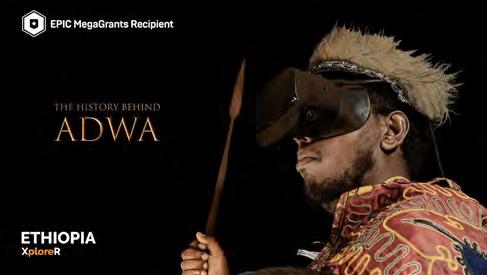
I want to be able to inspire the youths in joining this journey. Eventually, I plan to start a training centre. That way, we will have a good number of talents who are capable of producing more content for Africa, especially if they start from Ethiopia and then gradually expand to Africa.
Tech is now a never-ending idea. I’m sure they believe tech is one mandatory thing that they have to adopt in order to advance their country. The policy is there. But you still need your ministers to individually work on their sector and support the entrepreneur.
We have something we can work on and deliver to the public. We shouldn’t expect so much from the government as they have issues they are dealing with. Without security, peace or food, it’s hard to imagine VR.
Without the community, having these kinds of ideas are useless. You’ve heard of the Meta stock now failing, right? That’s because he lost his community, his users. If you are well advanced in technology, but if you don’t have the proper community that understands your stake, it’s useless.
You have to invest as much as possible in the community and they have to be convinced of the impact. That’s the outcome of all startups focusing on AR and VR.
Where do you see XR in Ethiopia and Africa at large over the next year and in ten years?
I believe XR is in a good phase in Africa. I’m lucky to be part of this team collaborating with different startups all over Africa. Our future lies in us and we have a responsibility to pass it to the next generation. The more content we have, the more talents we have, and we will get enough publicity, so that investors will come and the ecosystem will grow.
Should the government implement policies to encourage XR growth in the industry?
Eugene Ohu is a senior lecturer of Organisational Behaviour at the LBS (Lagos Business School). He established the Virtual Human Computer Interaction Lab at LBS, where he does research in immersive technologies (such as virtual reality) and psychology. In this interview, Eugene talks about how he ventured into XR, his projects, the opportunities and challenges he has encountered, the role of government and big tech in growing XR and what the future portends for XR creators.


My background may appear confusing to anybody who hears my story because I started off studying Pharmacy, then became interested in computers. I almost quit pharmacy for computers, but I was encouraged to finish and try to combine both. I taught myself programming and began writing computer programs, developing applications, building computers and websites for people etc. I have also worked as a journalist, worked in corporate communication, publishing, SMS aggregation business, and so on.
I later did a postgraduate diploma in education, to prepare me to teach. I have taught as an adjunct faculty in communication at the School of Media and Communication, Pan Atlantic University. I later obtained Masters and Ph.D. degrees in communication, with a focus on the psychology of people and of human relations. In January 2014 I began work as fulltime faculty at the Lagos Business School. Within the broad field of Organisational Behaviour I eventually drilled my focus to the research area called human computer interactions which deals with the intersection between technology and the people who use it. I love technology, but I wasn’t only interested in its effect
Let’s start from the basics, what’s your educational background and how did you get started in XR?
Director - Virtual Human Computer Interaction Lab, Lagos Business School, LBS
on people, but also how you deploy technology to achieve your goals. And that explains my natural transition into Virtual Reality because in immersive technologies, I found everything I loved about computers. Then in 2018, I decided to take a plunge. I bought the HTC Vive and an Oculus Rift and then realised that no computer at LBS could run it! With help from my employer (LBS), I bought an Alienware laptop, and so began the Virtual Human Computer Interaction Lab!
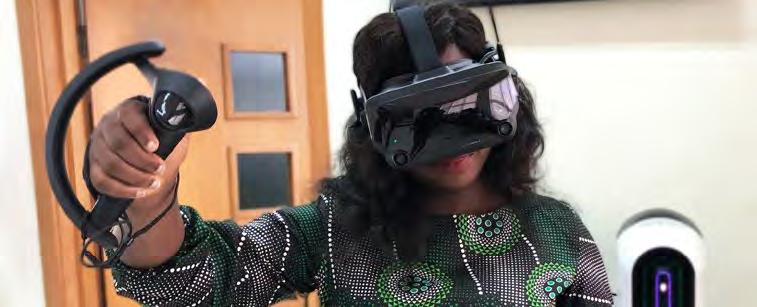
The first time I used Virtual Reality was in 2017 thanks to my younger brother, who is a professor at Gannon University in Erie, Pennsylvania and runs a VR Lab there. It was an HTC Vive headset and while I don’t remember what application it was, one thing that I came away with was, “This is REAL!.” When I was “inside”, I forgot about my physical surroundings. I don’t remember if he set up a guardian boundary but I remember him telling me, “No, no, no, you’re getting too close to the wall.” It was a truly immersive experience.
After you got access to the XR equipment, what was the first project you worked on?
The first project we did was a clone of Beat Saber. I’m first of all a researcher and I was curious about how you can successfully deploy advertising in Virtual Reality. I know that when people use a particular application or device, they have a primary interest and do not want distractions. If I want to play a game, I don’t want ads or anything to distract me. So, I would rather pay for the game so that there would be no ads.
But considering that some people may not be able to afford a VR game I wanted to study how you could put ads in Virtual Reality such that the player could play the game and get all the goals of the gameplay, and the advertiser who embedded the ads would also achieve their goal.
For my experiment, I needed to create two game conditions, one with ads and one without (in order to compare the distraction effects). Since we didn’t find any VR games with ads, we decided to build our own, a Beat Saber clone.
I love technology, but I wasn’t only interested in its effect on people, but also how you deploy technology to achieve your goals. And that explains my natural transition into Virtual Reality because in immersive technologies, I found everything I loved about computers.
I think that would be the one we are doing with the Templeton World Charity Foundation (TWCF), a Bahamas-based charity organisation founded by John Templeton. The focus of the TWCF is on fostering character development towards human flourishing.
In 2018/2019 we responded to a call for proposals, proposing to teach empathy and compassion using Virtual Reality. The background to this is the history of Nigeria, a diverse country with multiple ethnic groups. When something negative happens to someone from one ethnic group, those in other ethnic groups might be indifferent at best, or at worst they may feel that the former deserve it. It seemed to us that one thing missing here was lack of empathy. What if you were able to put yourself in the shoes of the other person, you might be able to feel what they feel or share their experience and hopefully you will be more empathetic.
Some have described VR as an empathy machine and we wondered, “Can we use Virtual Reality to put you in the body of someone from another ethnic group such that you will experience discrimination as that person? And when you come out of Virtual Reality into the real world, will you treat the person the same way?” This takes advantage of the perspective-taking properties of Virtual Reality.
So the TWCF project is made up of two studies which involve using Virtual Reality games to teach empathy
and compassion. Study one is to see whether a game jam, which involves conceptualising a game, might lead to greater empathy and compassion. While the second one examines how playing a professionally developed game can increase empathy and compassion.
Our study participants are adolescents aged 13 – 18 in SS One and Two (SS – Senior Secondary) of selected schools. For a year now, we’ve been going to secondary schools and having conversations on identity, including ethnic and religious identity, with the students. In the course of this, we helped the students to recognise the uniqueness of their individual identities, their commonalities and differences. These conversations alone have helped them grow in empathy towards other people, and it’s a complete proof of concept that conversations on identity can lead to empathy on ethnic identity. That is one aspect. The second aspect was to get the students to conceptualise a VR game. They built a story where someone suffered ethnic discrimination, they developed a storyboard and, because the time we
had was too short to teach them how to create VR games, we had professional developers work with them to build the game based on the script the children wrote. We have completed the game jam and our results show that there was an increase in empathy and compassion.
For the second study that involves a professionally designed VR game, the experience with the students in Study one gave us some ideas, but the children are not partaking in the building. Our ultimate goal is to compare the increase in empathy in the game jam: activities and conversations on identity plus experiencing a VR game prototype, with the second one, using a professionally designed VR game. We expect the latter to be more immersive in terms of sound graphics and other things. We want to compare the empathy and compassion level between the two. In that sense, the first study is serving as a control to the second one.
We’re really in love with this project, because we noticed the participating children growing in empathy and compassion towards people from other ethnic groups.
Which of your projects would you say is the most altruistic?
Some have described VR as an empathy machine and we wondered, “Can we use Virtual Reality to put you in the body of someone from another ethnic group such that you will experience discrimination as that person? And if you do come out of Virtual Reality into the real world, will you treat the person the same way?” The concept is called perspective taking, and Virtual Reality could allow perspective taking.
In terms of hardware, we have Oculus Quests, the HTC Vive I mentioned first, Oculus Rift, and then later we got the HTC Vive pro eye with eye tracking, and then the Valve Index. We have 15 Oculus Quest Twos and for computers, we have two Alienware desktops and five Alienware laptops. We also have a Rococo motion capture suit for animation.
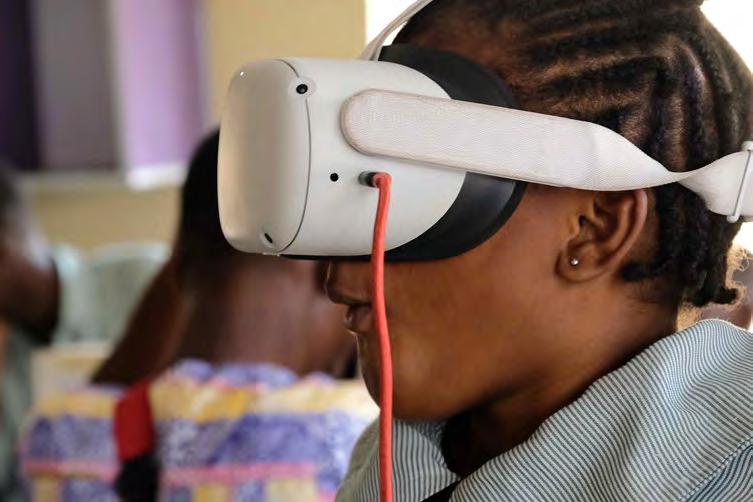
For software, we use Blender for 3D modelling. For every other thing we use Reallusion products like
3DXchange. Another software is the Rokoko Studio for animation, within which you can also fix any animation defects. After which you take the animation to iClone and apply the body animation, textures and other features.
We also use an iPhone plugin and another plugin by Reallusion for facial animation. Finally you export the animated character into Unity 3D.
What kind of team do you have now? And in building these projects, how do you get people with the right skill set? Do you do any sort of training?
First of all, there is interest in XR, but there is very little practical knowledge needed to develop things in XR. In that sense, one of the things we found out is that people need real projects. We found people who had experimented with Unity and they knew that VR or AR was the next thing, but they didn’t have any opportunities to try that. And we needed talents in different areas: 2D artists, 3D modellers, and animators.

After some disappointments from people who said they could do one thing but weren’t able to, we decided to organise a 10-week bootcamp with the primary aim of getting talents. The plan was to train people, build talents and get the people we needed.
The bootcamp was based on Unity and was basically self-taught, and self-paced, though we had some people with more experience who joined some sessions to answer questions. There were projects in between with which we could assess the trainees.
The bootcamp is something that I would like to do again, if we have more time, because I believe it will speed up the availability of XR talents for Africa as a whole.
On my team now, we have a Unity developer, a script writer, commu nication specialists, psychologists, and sociologists. We outsource 3D modelling and we work with a game expert in gamifying our stories.
The biggest challenge apart from equipment, which we solved thanks to a grant, is getting talents. If someone with money asks me what they should invest in to grow the XR Community, I would say training.
If we can train people to acquire the right skills and attitude, then give them a project to see from beginning to end, and they will surprise you. That has been my experience with Nigerians. Nigerians are talented, so give them a challenge.
Brainstorming, Conceptualization and Design during the VR Game Jam at Kuramo Senior Secondary School. Image courtesy of VHCI

With technology, you can leapfrog so that we are all at the same level. The equipment we have here are the same ones the rest of the developed world has. So, even though big tech companies investing in XR have money to employ 1,000 engineers to focus on one thing, and tomorrow they can surprise us with some new products, they don’t have our story! They don’t have African stories. Because I think what is going to drive XR is content, not technology, and since we have the same technologies they have, very soon all of their stories will become the same, while Africa will bring out richer stories and more diverse experiences for the entire world to benefit from.
I think what is going to drive XR is content, not technology, and since we have the same technologies they have, very soon all of their stories will become the same, while Africa will bring out richer stories and more diverse experiences for the entire world to benefit from.
What has been the biggest challenge you have faced in trying to build XR projects within the African space?
Do you believe there is an accurate representation of Africa in the XR space?
My projects have thus far been funded by two sources: my employer the Lagos Business School who bought the first Alienware laptop for me, and the Templeton World Charity Foundation that gave us a grant of $234,000 to equip our lab.
We have applied for more funding which will be used for the other projects we’re working on. One of such is to extend our empathy and compassion research to other parts of Africa and to other age groups. Others are using VR for mental health projects, and deploying dry laboratories in Virtual Reality to secondary and primary schools in Nigeria.
How did you find some of these opportunities you applied for?
Different ways. By presenting our research findings at conferences such as the International Conference for Game Jam and the Games for Change Conference, we get noticed and contacted by grantors.
Not mentioning any names, but there are a number of US grantors looking for people to give research money to and we are in conversation with some of them. The truth is, if you are a grant awarding agency, your reason for existence is zero if you don’t find somebody to give the money to. And if you are looking for such opportunities I will recommend
that you should be happy to do good work and take advantage of opportunities to talk about what you’re doing. Attend conferences, disseminate your work.
I can’t praise the Templeton World Charity Foundation enough, because they have given us many openings too. They have given me a different perception of grant awarding agencies, because not only do they give grants, but they actually want you to succeed. They also put you in touch with many people, they tell you about opportunities for other grants to augment what you’re doing.
What kind of support do we need from regulators? None. They should just let the development happen first, because the impression you get from regulators many times is that they try to regulate what they don’t understand.
What kind of regulations or policies do you think would support XR growth in Nigeria?
What kind of support do we need from regulators? None. They should just let the development happen first, because the impression you get from regulators many times is that they try to regulate what they don’t understand. Rather than embracing innovation, they devise ways to frustrate it.
To use an analogy, I usually tell parents that rather than be afraid of technology, tell your child, “Teach me,” “Show me.” I think that’s the attitude that regulators should adopt. Encourage innovation and ask, “How can I support you?” Ask them, “What do you need to make this grow?”
What role should big tech play in growing XR in Africa?
Big tech needs Africa. Africa is unique and Africa will produce its own content. The complete story of the world cannot be told without Africa. There’s a lot about Africa that is yet unexplored and if we allow these stories to come out, they will enrich theories useful to the rest of the world.
I think that for the good of the whole world, Africa should be supported to contribute its content to the global conversation. So big tech needs to support that. For example, they can train more people in XR, invest in developing talents in Africa, knowing that it’s going to enrich the world as well.
How have your projects been funded in the past? What will you do with more funding?
Finally, what would XR look like for Africa and globally in the next one year, and in the long term say in 10 years?
One thing that may happen is more African talents in XR would start by doing remote jobs. Because one advantage of remote jobs is that you earn in dollars. And then hopefully, there will be some leftover resources to develop XR here for global consumption.
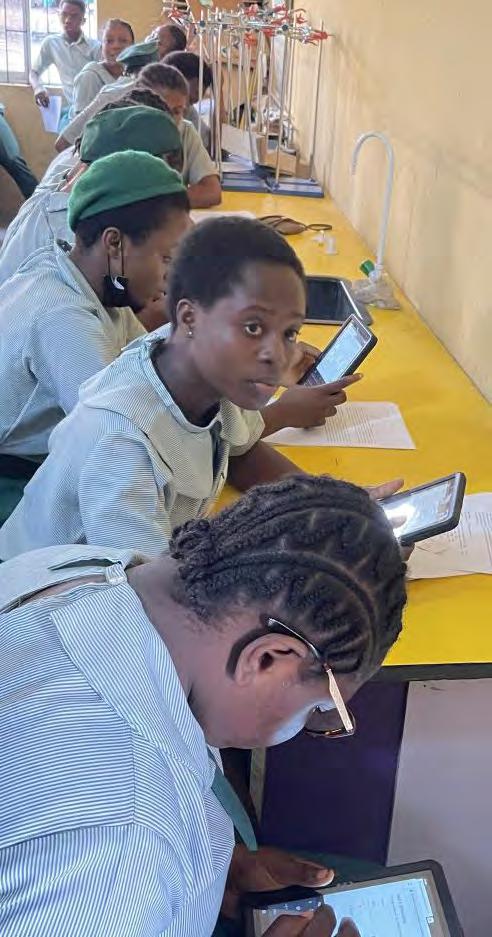
But I think the safest answer is to say, “I don’t know.” Because they will surprise us. You have Google racing against Microsoft, Apple and Facebook are deploying lots of resources.
I think that the future of VR is going to be in training and collaboration. By training, I bundle all learning and behaviour modifications, simulations and all that, and collaboration with people in different spaces. But I also see the possible amalgamation of VR and AR. I would give an example. We are in this physical space. Let’s say this is the office where we all meet to work every day. There’s a chair and this is your desk where you must sit every day you come to work. And then one day we decide that we should all have a meeting in VR. Staff A is at home, staff B is also at home and I’m the only one here in the lab. So we’re in VR, and we see one another.
But in addition, I would like to see you at your desk. Now we can use AR for that right? To project virtual staff A on this space. It seems crazy but this is one possibility I see. So, VR is very good for learning behaviour modification and collaboration. But I can see a combination of these two.
Nigeria
Hammed Arowosegbe is a Senior Software Engineer who currently works at Vault Hill, a UK-based company, where the Metaverse is being built into a social VR space. He obtained a Bachelor’s degree in Mechanical Engineering, and has since undergone training in Software Engineering for Wireless Mobile Robotics. He is currently working on his Master’s degree in Artificial Intelligence. In this feature, Hammed has a lot to say about his XR experience, projects he has worked on and challenges and opportunities in the XR space.
When I studied Mechanical Engineering, I majored in design. I was designing from 3D, and that gave me more knowledge of what 3D is generally. And of course, 3D is one major part of VR and AR, so that was helpful for me. Software engineering pushed me into getting the base knowledge for coding which further prepared me for a future which had AI, VR, AR, 3D and the Metaverse.
I started in the robotics industry, where I was trying to build automated systems with Arduino. We had this project where we were working with the Nigerian College of Fisheries and we needed to build a ship simulator. The goal was to be able to train some of the staff and students on how to drive a ship. While working on that project I came across the Unity game engine and used it to build parts of the experience, I also saw Unity could be used for AR and VR, and decided to learn more.
Considering AI, I believe the technology behind Augmented Reality is computer vision, which is also a sub field of AI, while VR is more of computer graphics. And all these are more in line with AI. I feel the future of the Metaverse is going to be an interactive world, where things are smarter, and AI will play a really important role in this. For me, it’s more about keeping myself in line, and then understanding some of those frameworks and starting to build for it.

Can you give us a quick walk through your career in XR so far? And have you had to work outside XR?
I do more of VR, although my prefer ence is towards AR, which I feel has more relevance and resources than VR right now. AR might take over in the next five years and VR after wards, but VR sells better and fast er these days. At Vault Hill where I currently work, we try to build for both AR and VR. We are trying to bring a synergy that will make the two both accessible and executable at the same time, thereby building a balance.
What’s your big dream for XR and what are your contributions to this dream?
When I explore VR experiences I rarely encounter and get excited by African creations except for Daughters of Chibok, I think Imisi 3D was part of that, which was really good. So I would love to see more mind-blowing stuff come out of Africa. I think Africa’s problem is accessibility. That is why I have built Swift XR that helps anyone interested in VR and AR, even if they’re not tech savvy, to just drag and drop their 3D model on the platform and we take care of all the XR integration and compression, etcetera.
I think Africa’s problem is accessibility. That is why I have built Swift XR that helps anyone interested in VR and AR, even if they’re not tech savvy, to just drag and drop their 3D model on the platform and we take care of all the XR integration and compression, etcetera.

Can you remember your first XR experience and what was your first XR job?
I really cannot remember but I know the first thing I tried was YouTube VR. We had this Google Cardboard on VirtualBox, a cardboard that you can slot your phone into. It was like a YouTube 360 video, and we watched it. From there, I moved towards building AR apps.
The first one I built was a skeleton AR app and the goal was to show people the harmful effects of smoking. We were able to show people the lungs animated in real time, displaying the effects of smoking.
My first XR job was at a Tech company called DeepTech Africa, an AR/VR Startup and a part of Hello Tomorrow. There, I got training and started building experiences which included doing CPR in VR, etcetera.
Did it take you a long time to build Swift XR?
Yes, it took me four to five months out of which I worked for four months on my own to develop the initial building frameworks. And then my colleagues and I have been working to make it better. As a matter of fact, we just added a new feature for e-commerce.
Do you intend to make Swift XR a company on its own and is Swift XR the only personal project you’ve worked on so far?

Yes, SwiftXR is a company on its own, I am also working on a game I intend to release, hopefully, this year. I did Teni’s Album, VR 360. I also did a project with Alpha and Nimbus when Marriot Hotels Ikeja was launched. That is the goal – to continue to build more stuff.
How did you get involved with the VR/AR Association?
When I started in XR, I connected with Rene, a Microsoft MVP and Director of Global Innovation at Valorem Reply who guided me early in my XR career. When I joined PwC, I generally decided to build more for Africa, but I needed more data insights. So, I joined the association through which I have had access to so many valuable resources and from there started the Nigeria Chapter of the VR AR Association. It’s not the best kind of growth that I want, because getting more members from Nigeria has been dicey due to funds. Still, we’re working on advocacy and making accessibility possible.

How would you describe your skill set and what software and hardware do you use for your work? How easy was it accessing these tools?
You know, I started out as a developer then slowly worked towards building an app and then pushing it out.
I use Unity and Unreal Engine although I’m better at Unity. I mostly work with Maya to develop my 3D model. I use Substance Painter to texture and then move into Unity, Unreal Engine, write some scripts and then build those out.
For VR hardware, I mainly use the Oculus Quest, Oculus Rift, and Vive Pro, which are like mobile and PC VR. For AR I use ARkit, ARCore Android, and iPhone and Android. I’ve tried my hands on Hololens, but not seriously because accessibility is an issue.
Getting my Quest 1 was not too difficult because I bought it off the company when they no longer had use for it. Quest 2 took about a month to arrive. We’re also working on how to create an e-commerce XR hardware store.
How did you learn to use the software you mentioned above? Did you ever take an online course or training programmes?
I had my background in Robotics where I got some experience in coding. I started with C, C++ and I moved to Unity. They are all similar, that is why the transition was easy from C# to Javascript, to Python, and I was able to catch up.
Online courses are your friends. I did a lot of YouTube initially, to understand what Unity was. I keep going back from time to time to do more research because there are more resources online. I learnt Maya from Pluralsight while Unity was more self-taught on YouTube.
Do you know any XRrelated courses that can be studied in African Universities?
To be honest, I don’t think so. This is sad and I think we need to buckle up.
What’s the best project you’ve worked on so far and which do you consider the most significant?
I think the most significant project for me is the Swift XR, due to its complicated nature. It took a lot from me, it being new and all. Today, I can function as server architect, front-end person and also as an XR developer, thanks to the project.
Would you like to share some of the challenges you faced trying to be an XR developer?
A major challenge is that of access to gadgets (and money). XR requires a lot of processing power, and you can keep watching YouTube videos, but if you can’t practice, you’re wasting your time. I started with Quest 1 and today I have Quest 1, Quest 2, and the Samsung Gear VR. I also have a MagiMask and I am trying to get AR glasses.
Online courses are your friends. I did a lot of YouTube initially, to understand what Unity was. I keep going back from time to time to do more research because there are more resources online. I learnt Maya from Pluralsight while Unity was more self-taught on YouTube.
You are a co-founder at HOFT developers, can you describe what it is about?
Yes, I founded HOFT with some of my colleagues. Our objective for establishing HOFT is to see how we can train people for free, as a way of giving back to the community. We get the brightest guys, train them and give them certificates. We have done two training cycles already and we plan another for Q3 2022.
It has not been easy, asking people not to pay money, because we end up getting a lot of applicants. We then have to separate the serious from the unserious. If you pay for a training, it is easy to be serious with it because you know that you paid money and you must finish the training.
The training runs for about six months. The first three months we teach them the whole skill set they need for XR now. We run them through Maya, Blender, Substance Painter and Unity.
Then they have three months where they get to work on a certain project based on what they’ve learnt. Most of the time, people drop out, they just do one month and they say, “I’m not doing it again.” So we are caught between making the training free, but ensuring that we make people more responsive and committed to the training.
When developing the XR curriculum, what I considered was my experience learning the skills, what worked and what didn’t. And we have gotten results by following this, because after four months of training on Maya, for example, some of the students can already do really cool stuff with it.
Some of the courses we cover include AI and data science; how to use TensorFlow, Excel, Power BI Python, UI UX. There’s also mobile app development, which is more like React Native Kotlin, Java, or Android Studio.
In terms of geographical spread, our training is more distributed towards Africa, though the goal is to make it global, but we need funding. We are working to see how we can get funds for the training so that when people join the programme, we can give them Oculus headsets for free.
An example the Swift XR interface that makes AR development easier for content creators and businesses alike. Image courtesy of Hammed Arowosegbe

How have you been funding your projects? And if you get more funding now, what will you use it for?
Most of my personal XR projects have been self-funded. I believe you don’t need much money to get your first MVP, but as you start to scale up - maybe you want to build a multiplayer game - then you can start worrying about money. I would say money may not be a problem if you have the required skill set. But, if you are a corporate body, you need to find someone that is skilled, and of course start to spend money. It goes both ways.
If I get more funding now it will be channelled towards scaling up HOFT and SwiftXR. Though we are applying for grants, if they don’t work out, we have plans to bootstrap.
I feel we are slowly getting there. The devices are slowly permeating the society and in no time, going about with the devices will no longer be strange. I also think that soon, a VR headset will have AR on it. That way, one device will be able to perform the functions of the two – VR and AR.
How do you describe your work to people who are unaware or do not understand what you do? Also, what are the misconceptions about your work?
It was quite difficult explaining what I do. I used to bring out my VR headset to demonstrate, until the advent of Meta’s transition from Facebook. Now, I just tell them that my work is in line with what Facebook is doing.
About misconceptions, people have a wrong mindset as to how much XR hardware costs. What I say instead is that they are available, but just not mainstream yet.
Ready for anything. Hammed is skilled in both VR and AR development, currently working on his Master’s degree in AI. Image courtesy of Hammed Arowosegbe
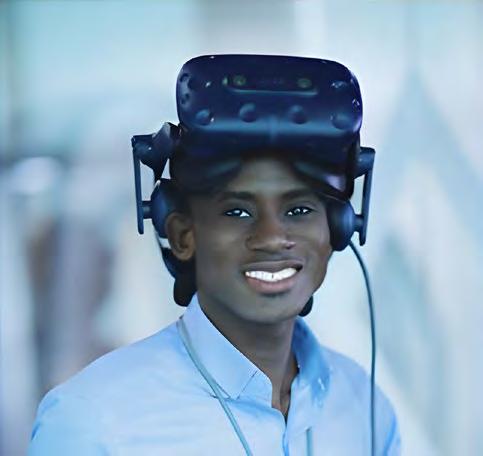
Do you think that people may get discouraged because XR devices are not as portable as phones?
How would you define the Metaverse in plain language?
I’d say that the Metaverse is a way of taking so much from the real world and making it virtual. This enables humans to do so much more and, in a way, satisfy their thirst of wanting more.
Do you think there is adequate representation of African XR creators in the global space?
I think there is a huge gap. I know Imìsí 3D has been here for a long time and is doing a lot of work. I also think that Imisi 3D is moving away from being a product company to being a community company, which is a lot better. Because to be relevant in this field, we need a community that understands what we are doing.
In the whole of West Africa, it is only Nigeria that has a chapter. Also, we do not have a company that is doing really fantastic on the global level yet.
Also, do you think we have a strong African XR community, and what do African creators stand to gain from it?
I don’t think we have a strong African XR community. I feel we are doing things in isolation, and I feel this isn’t right as there’s a need for us to push our awareness level up and this can only be achieved through unity.
If you do not have a community of people who understand what we are trying to do, one may not make it in that space. But if otherwise, everyone can leverage on being positioned in the space and when products are launched, it’s easy to get supporters and buyers.
Could you share some of the XR events that you’ve been a part of?
Most of the events have been virtual, but we are looking at more physical events. Some of the events are part of the African Game Week that’s happening in Cape Town, South Africa. I’m also part of events by Immersive Tech Africa, hosted by Arome Ibrahim. These will just shine a light on what people are doing in Africa.
I don’t think we have a strong African XR community. I feel we are doing things in isolation, and I feel this isn’t right as there’s a need for us to push our awareness level up and this can only be achieved through unity.
How do you think big companies like Meta and Apple can engage you as an XR creator specifically? What role or what responsibility do you think they should play in this space?
Most of these big companies have lots of issues in system design and process flow, and an easy way to solve some of these problems is to throw them out to the XR community. For example, say Meta is having an issue with a certain kind of interaction for its avatar, they can take that problem and throw it
open to Africans globally, turn it to a Hackathon, and that way, they can start to engage African developers to start building stuff that will be used globally. That will also boost morale, skill sets, and give validation for doing something that goes global.
From an ethics, policy and regulation point of view, what kind of policies and regulations do you think the government can put in place to benefit you as a developer and the XR Community in Nigeria?
I feel our government should not be too quick to make certain policies. To put it in context, we had a policy to ban cryptocurrency in Nigeria. Government felt it was a valid move and they gave reasons for it, but I feel like it should not have been a quick move. What if the US had, because of the movement of arms via crypto, banned crypto? It means companies like Binance and OpenSea, which are doing really well now, and have been able to scale up, won’t have existed. The government should not just make policies that cripple businesses,
because at the end of the day, if these businesses become big they will pay tax to you, and you become richer.
I saw a video of Vice President Yemi Osinbajo putting on VR headsets, which is good. When we start to see more of these use cases in government as part of the government process, it will go a long way in growing the XR space. For example, the Nigerian Airspace Management Authority can start to use Hololens during their inspection and engineering process.
Short term and long term, what kind of predictions do you have for XR globally and in Africa, one year from now and 10 years from now?
One or two years from now, Africa will have more developers. Two years ago, I could handpick developers in Nigeria, but now you can’t handpick them again. Although I feel we are still small, at the same time we have more people, which is the same thing happening across Africa. More courses are coming out from Pluralsight and Udemy. Also, due to the move from Microsoft, Apple, and Meta into the VR
space, you have more people jumping on the bandwagon. That means we’ll definitely have more developers. Globally, ten years from now, AR is going to be mainstream. By mainstream, I mean becoming a device for everyday use. So, I see AR as mainstream short term, then when a hardware convergence comes, VR will overtake AR.

Electric South

Ingrid Kopp has worked in documentaries and interactive media since 2000. In addition to her work with Electric South, Ingrid co-founded Immerse, a publication on non-fiction emerging storytelling. Before moving back to South Africa, Ingrid was head of the Interactive Department at the Tribeca Film Institute in NYC. She also programmed immersive work for the Tribeca Film Festival. She is co-chair of the World Economic Forum Global Council on Virtual and Augmented Reality. In this spotlight, she shares her XR journey and her concerns about the future of the African XR ecosystem.
I began working in television in 2000 on Channel Four. This was an exciting time for storytelling and technology. I was also interested in documentaries because I didn’t know what I wanted to do and wanted to try a little bit of everything. And I realised that documentaries were a place where I could explore various interests.
Working in the documentaries department at Channel Four was an incredible first job. It also allowed me to see how technology and storytelling intersected. As a result, I became very interested in the democratic potential of new technologies, and that stayed with me throughout my career. Then, I moved to New York in 2004, where I worked in television and did some work with online communities.
I became very interested in the web and social media, which eventually led me to work in immersive media at the Tribeca Film Institute. I oversaw the interactive department and began programming many interactive works for the Tribeca Film Festival. Then, around 2014, I began doing more and more VR work, and in 2015, I returned to South Africa. And now we’re here.
I’ve always been interested in new technologies, especially when it comes to the arts and storytelling, so I’d been reading about early VR experiments in the 1980s and 1990s. But the first time I wore a headset was at the Sundance Film Festival in 2012 for Nonny de la Peña’s Hunger in LA project . It was a massive, extremely
complicated rig. I mean, it was utterly unlike any headsets we are using now, but it was the first time
I experienced a VR project. And it’s interesting, because the first time I saw one was at that Sundance, but it just went exponentially faster after that. I was constantly in VR from 2013 onwards.
I was working for a British organisation called Shooting People, a network of filmmakers. I was in charge of the US office. We were doing a lot of work online to create communities for filmmakers to collaborate and work together. As a result, I became very interested in community management and web project management. And I’d started teaching a lot of boot camps for filmmakers, all geared toward getting them to use the web to promote themselves, promote their films, and think differently about how to reach audiences.
So, it wasn’t precisely immersive media, but I was working a lot on online platforms. I was pretty at ease in web-based online environments. And I began writing about the kind of confluence of technology
and storytelling that I saw from about 2007 onwards, primarily web experiments and app experiments. The Tribeca Film Institute then asked me to assist in the application for a grant to support immersive nonfiction projects. After we received that grant, I began working for them as the department head.
I supported an extensive range of projects at Tribeca, like The Enemy , by Karim Ben Khelifa , and Travelling While Black by Roger Ross Williams . We did some fascinating web documentaries, like one called Hollow . There was a project in India, Priya’s Shakti. It was a fantastic piece that looked at gender-based violence in India, using comics, murals and Augmented Reality to tell different stories to young people and teenagers, which
I always thought was clever. One of the things I liked best about working there was how I was able to do work that was utterly multidisciplinary in its approach.
It wasn’t all one type of thing, and that was always the most exciting thing for me. I did notice, however, that from around 2014 onwards, there was definitely more of a focus on VR.
Many of the other projects faded away because there was so much interest in VR, and we began to work on a slew of new VR projects. By the way, the same thing happened at the festival. In 2013, I began programming for the Tribeca Film Festival, and there were no VR projects that year. Then there were a few the following year, I believe. Then it was almost entirely VR after that.
Do you recall your first encounter with XR? What piqued your interest?
Tell us more about your work at the Tribeca Film Institute and when you started working in the immersive section?
I’ve always been interested in new technologies, especially when it comes to the arts and storytelling, so I’d been reading about early VR experiments in the 1980s and 1990s.
Did you have any early indicators about the potential of immersive media for storytelling?
I think it’s because of my background in interactive and immersive media. I’ve always been open to new experiences. I know that many of these things are experimental and that not every path leads somewhere. Still, I’ve always been open to it and comfortable with it.
You know, when I first saw VR, I was excited. I could see the incredible potential for an entirely new kind of storytelling about embodiment and presence. I saw the massive potential for creating these fantastic storytelling experiences in 3 DoF and 6 DoF.
Honestly, this is where my entire career has led. It’s just a case of following one’s natural curiosity.
I am not a forecaster or a future predictor. I believe there’s potential here, let’s explore it. My biggest motivation for co-founding Electric South with Steven Markovitz was that so much of the work I saw was rehashing old narratives about Africa. We were sick and tired of hearing these on the continent. And I just thought, ‘ There’s so much potential for African storytellers to tell a different kind of story about Africa. Or, more accurately, a variety of stories about a variety of African countries, and we need to back it up.’ I know there are incredibly talented people on the continent who could do incredible things with this technology. Let’s see how it develops.
How did your relationship with Steven begin, and how did you two decide to start Electric South?
We knew each other from the documentary and film worlds before I moved back to South Africa. We had met at a few film festivals and worked together on a project in different capacities, so I was aware of his track record as a producer. I had mentioned to him that I was moving to South Africa, and I had no idea what I was going to do at the time. And he said, ‘Oh, well, you know, that’s fantastic. I’ll let you know if I hear of anything.’
Steven had done a lot of work with the Goethe Institut , centred on short films, and he was ready to try something new. He knew I
had done a lot of work in Virtual Reality. So he said, ‘Why don’t we do something around VR? We could run a workshop, and you could curate some VR projects,’ because he knew I was also a curator. Then the problems began, because I was looking for African-made work, I mean, made in Africa by African artists, and I couldn’t seem to find anything.
But, there were a plethora of African-themed projects in the works. To be honest, I thought this was a problem, and I just thought it needed early intervention and early funding and support. Fortunately
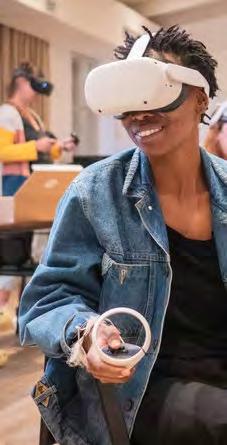
for us, the Goethe Institut was highly supportive. As a result, they funded the first workshop. We had Jim Chuchu and The Nest Collective, Selly Raby Kane, Ng’endo Mukii, Jonathan Dotse, and some other notable artists.
People from all over the continent came together to create our first four new dimensions 360 films. That was all supported by Goethe; I suppose we were fortunate in some ways in terms of timing. That initiative led to the formation of Electric South, as we wanted to carry on the work.
We’ve worked with Selly Raby Kane, who’s a fashion designer, she just brought this amazing visual aesthetic and style to the piece. The Nest Collective has such an incredible collaborative, interdisciplinary approach, which I loved. Let This Be A Warning was just really fascinating. Johnathan Dotse with Spirit Robots, and also Ng’endo Mukii with Nairobi Berries. All of them had this sort of really interesting, Afro futuristic theme. Those were the first projects we produced in Africa.

We’ve had people like Nyasha Kadandara who’s just an incredible journalist, and visual storyteller. She really impressed us, because it was such a hard film for her to make in terms of access to Lake Chad. Dylan Valley making Azibuye , was really interesting, in terms of thinking about space, and how you can tell a story in a space, because so much of that is about the occupation of a home. We’ve had people in our labs, like Francois Knoetze , and Amy Louise Wilson, who made the beautiful Subterranean Imprint
Archive , which is all layered and has amazing different stories within stories in it.
I’ve learned so much from the artists. Every time we solve one problem as we make one piece, another problem comes up in the next piece. And I mean that in a good way. It’s like we learn so much from making this work in different ways in different countries with different artists who have different approaches.
Could you tell us about some of the creators you’ve worked with?Selly Raby Kane’s “The Other Dakar” (2017) Image courtesy of Electric South
So we ran this workshop with very little equipment. And now, when you think about the kinds of workshops we run and the kinds of equipment we have access to, it shows how much things have changed between 2015 and 2022. And it’s not to say that things aren’t still challenging.
We were extremely fortunate to have Goethe on board so early and open to this new experiment. As a result, they were nothing but helpful. And I can’t say enough positive things about how they helped us figure out all of this stuff from scratch, like where to find headsets. Interestingly, we ran the entire workshop without a single 360 camera. No Samsung, we didn’t even have a bunch of GoPros with a rig. We had nothing.
Katy Morrison and Oscar Raby flew in from Australia.They showed us how to scan with an iPad, like a small scanner attached. So we would do some basic scanning and then import it into Unity. As a result, we conducted some Unity scanning experiments. Extremely
rough! Jessica Brillhart arrived; she was working for Google as their VR principal filmmaker at the time, but she was unable to bring the jump rig because it was brand new at the time, there weren’t many of them.
So we ran this workshop with very little equipment. And now, when you think about the kinds of workshops we run and the kinds of equipment we have access to, it shows how much things have changed between 2015 and 2022. And it’s not to say that things aren’t still challenging. I’m sure we’ll get into this and other things regarding purchasing equipment and gaining access to everything you need. But it’s a lot easier now than it was in 2015. I mean, dramatically different.
That’s an excellent question. Every time I think something is impossible or too complicated, and there’s never enough money, something amazing happens. I think that’s also a testament to the fantastic community. I’m sure you’ve spoken to people like Judith of Imìsí 3D, and Brian, who founded Black Rhino VR. Then I met the Eden guys Rick and Gareth, and through them, I’ve met the entire Metaverse Crew. There are people in that kind of ecosystem who have been so supportive while also going through many ups and downs.
Knowing that they’re doing cool stuff has always been very inspiring. Every time I’m feeling down, I’ll
run to a lab or go to an event. I’ll see this fantastic work that we’re doing in Africa. I think it’s also important to acknowledge that I’m incredibly fortunate to be able to do what I do. Another way to describe it is to use my privilege from living and finding a community overseas and having a little bit of cultural and financial capital. I think that’s why I see myself as a cultural facilitator or cultural producer.
In a way, I feel like I need to give something back for having the opportunity to do all of these different things and get paid for many of them. That’s why I’m so enthusiastic about establishing this ecosystem in Africa.
There are definitely people like Judith, who are much more wellversed on the policy front than me.
One would hope for more funding for creative technology and to infuse it into higher education across African universities. It always amazes me that it is often more expensive to fly from one African country to another than to fly to Europe and back. It’s not fair and it can make collaboration really hard. I always use ITP as an example of what kind of creative tech education I would like to see more of. It’s a school at NYU, but a kind of institution where you can play and learn how to do coding and things like that, and the creative side of things.
I’d like to see more of this in higher education across various African countries. We need more opportunities to experiment and play.
Every healthy ecosystem requires a little bit of everything. A bit of government funding, some venture capital funding, philanthropy, and wealthy individual angel investors. You don’t want to rely on just one thing because I don’t trust the market to make good decisions. You cannot only be accountable to the government either.
We would not have been able to do this without the Ford Foundation. Since the Goethe Institut got us started, the Ford Foundation has been our primary funder and has enabled us to accomplish so much. Almost all of our workshops here, and many of the productions, are thanks to them and their grants. So that’s been incredible. The Bertha Foundation has also been extremely helpful, giving us a home for our workshops and funding a lot of our distribution.
We recently received funding from the National Film and Video Foundation here in South Africa. This is very exciting because now
we are seeing public money in South Africa supporting South African artists to create XR projects. That is the first time that has happened to us, and it is exhilarating. I’m trying to figure it out because I’m missing some people.
We were initially funded by Blue Ice. We’ve collaborated with the British Council on some projects, including a really exciting new initiative on sustainable fashion and XR. So, it’s all these different governmental and philanthropic organisations coming together to make this possible.

What kinds of policies do you believe can go a long way to support the industry?
Where do you believe the funding should come from?
Who has contributed to the work you’ve been doing with Electric South?Participants of the New Dimensions 2022 Lab Image courtesy of Electric South / Chris Grava
Is there a robust African community present in immersive media and XR?
There is a vast and fantastic community in the storytelling space. I wish more people were doing the work in a lot more countries. As I previously stated, I believe I am much more focused on the storytelling XR space. Much of our focus has been on Lagos, Nairobi, Johannesburg, and Cape Town, which is missing out on many African-focused stories.
I’m also aware that it may not always appear to others to be as expansive or inclusive as it should be. I believe there is still much work to be done in the community. And it would be fantastic if we could broaden our communities a little and have a lot of overlapping communities. You know it’s tough to build a community, especially in over 54 countries with different languages.
What myths do people have about immersive media and the XR market?
There are many. People see only one type of VR or AR project, and they form an opinion. That’s crazy to me because these mediums are elastic. They are flexible, and they can do so many different things. If you saw a VR project and didn’t like it, that’s just one project. There are so many different approaches to VR.
I’m also aware that it may not always appear to others to be as expansive or inclusive as it should be. I believe there is still much work to be done in the community. And it would be fantastic if we could broaden our communities a little and have a lot of overlapping communities. You know it’s tough to build a community, especially in over 54 countries with different languages.
What goes into setting up the New Dimensions workshop, and why did you start it?
The work at the New Dimensions workshop came out of our first workshop with Goethe, which we did with no cameras and no equipment and not knowing what we were doing. But we had fantastic mentors in Oscar, Katy, and Jessica. And I believe that has continued. So we rely on bringing these talented artists who have no experience with XR to a location and then inviting these incredible advisors from Africa and beyond. They spend a week together, share learnings, develop their projects, and then get more support for their projects. And in some cases, we’ll produce some of them; I wish I could say that we produce all o
What role should Big Tech play in supporting African XR artists?
We’re a fantastic market with many young people, I think with the youngest population globally coming up. So there’s enormous potential here for big tech. A lot of that could also become very exploitative.
So, I hope there will be a greater emphasis on things like privacy and data protection and making sure that the big tech of the future isn’t just trying to get eyeballs and attention. Given where we are now, I think that’s a very optimistic view. But I wish it would expand to a more global population rather than just trying to get people on board and then doing unethical things.
I hope things will become more about delivering quality experiences and tools while protecting people’s time and attention. I don’t know if I have a lot of faith in that happening. But that’s my hope.
With all this talk of the Metaverse, I hope it doesn’t just become a space where that can happen in 3D. I want to see spaces for experiments and creativity. It’s nice to see organisations like Meta supporting the creative space. That kind of help is desperately needed. So I think it would be great if there were more initiatives like that while making sure that all of the other ethical things happen.

My concern is that we will not play a significant enough role and will be ignored. I worry that it will not reflect our requirements and meet our needs in the future. More training is required so that people can be involved in the design and participation of these spaces. We need people here to build the software and hardware that will be a part of this future. Because I believe that if we don’t, the future will be very dystopian. It needs to be much more reflective of the needs of multiple societies and communities. So, the right not to be online is also a part of it. But, I believe the only way to get there is to be more global and inclusive in our focus, like what do indigenous communities need? What are the requirements of remote villages? What do the people of Lagos require?
People in the global south need to be a part of this conversation. And it shouldn’t matter if you live in an area with poor Internet, as I do right now. You should still be a part of this discussion because this world is coming, and it must work for you. So that’s how I see it, and that’s the bigger picture in all of this, as we should be involved in the design and creation of this future, whatever it may be. It cannot be left to individuals in London and Silicon Valley.
I’m not a forecaster or a futurist, but I know VR will play a role in the future. It may not appear as it does now. There’s going to be some new Internet that will be 3D, and we’ll be able to access it from various devices, including VR and AR devices. And there will be plenty of opportunities there. I’m particularly concerned about who gets to design those tools and devices. It scares me to think that this new world will be designed
in Silicon Valley by people who have a very Silicon Valley perspective on the world. I know this may sound quite rich coming from a white woman who lived in Cape Town until recently, which is a privileged place to speak from. Still, I genuinely believe that, unless there is a more global approach to design, storytelling, community building, and building new institutions, we will end up in a jaded dystopia.
People in the global south need to be a part of this conversation. And it shouldn’t matter if you live in an area with poor Internet, as I do right now. You should still be a part of this discussion because this world is coming, and it must work for you. So that’s how I see it, and that’s the bigger picture in all of this, as we should be involved in the design and creation of this future, whatever it may be. It cannot be left to individuals in London and Silicon Valley.
Along with that, we need to make the future internet accessible, so many of these new technologies don’t consider people who are blind or deaf or have other disabilities. All of these things must be considered as we design and build what this Metaverse will become.
Joel Kachi Benson is a documentary filmmaker and VR content creator, with over 10 years experience as a visual storyteller. In 2018, he began exploring 360 filmmaking at a client’s request and since then, he’s made a 360 film every year. In 2019, Daughters of Chibok, his 360 narrative documentary, won the Golden Lion for the Best VR Story at the Venice International Film Festival, making him the first African to win this award. In this spotlight, we share the story of how Joel got started and what he thinks Africa needs to create more award-winning VR filmmakers.
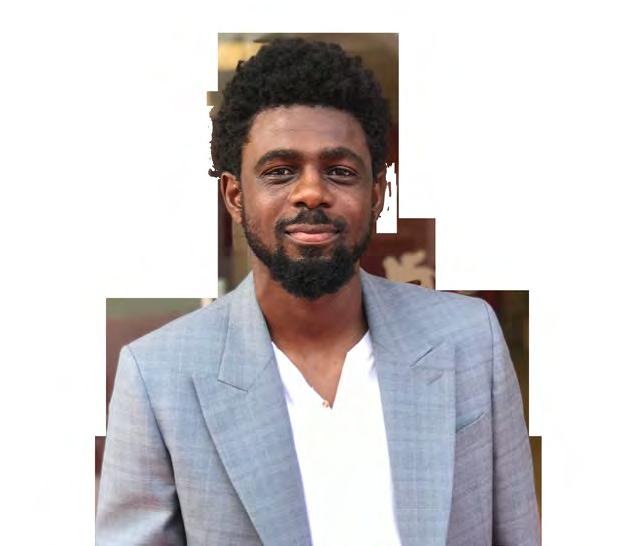
I have always been intrigued by the visual medium. I always wanted to be involved with it. My first real attempt was making music and wedding videos, things I was never excited about. In the end it was just too hectic, for example, with the wedding videos, the bride would tell me things like, ‘remove the pimples from my face,’ or ‘make me look glossier.’ I found that too stressful. Then at some point, someone gave me the opportunity to make a documentary. The idea was for me to speak to interesting people and record them telling their stories. I was excited to hear about their lives and what they were doing. These people did not care how they looked or if their pimples were showing; it was better content and less stress. That’s how I got started. From there it morphed into storytelling and I have been doing that for almost a decade now.
It sounds like you broke into the video space, did you ever get any formal education in the medium?
I didn’t get any formal education, at least not in the traditional sense. I didn’t go to a regular university. I finished high school and at the time, I couldn’t further my education because of financial challenges. I started making videos and since then I have saved up for filmmaking courses. I have been to the Central Film School London ; Legacy Media Institute in Virginia, USA; Nation Film and Television School Beaconsfield, UL; and StillMotion in Portland, USA. I got my break in VR in a similar way, by saving for informal training in the USA.
I remember saying to myself, “ This could be a powerful tool for storytelling. Imagine the documentaries
I could make, the places I could go to. I could use this as a tool to push my storytelling forward. ”
I had been making documentary films for some time at this point. Someone I had been working with, Damilola Ogunbiyi, called me up and told me she needed me to make a 360 video for her. I had no idea what that was and I told her this. At this point, I had never even used a headset in my life. She in turn pushed me to do some research, which is what I did.
In my research, I ended up watching all these 360 videos on YouTube, moving my cursor around to rotate. I thought they were cool, but I didn’t
know how to make them. At this point, I did some research into where I could learn and I found this guy in the US. GoPro had people all over the world that were certified VR trainers and he was on the list in Chicago.
I had a valid US visa, so I cleared out my account and told my wife. I remember Dami saying, “Just do this, it’s going to change your game.” And
I am glad I took her advice. I flew out to the US, bought a 360 camera - the GoPro Omni -and the rest as they say, is history.
I remember when I wore the headset for the first time. It was a Coldplay concert. I wore it and it felt like I was there. I remember saying to myself, “This could be a powerful tool for storytelling. Imagine the documentaries I could make, the places I could go to. I could use this as a tool to push my storytelling forward.” I completely forgot about Dami’s project. I thought I could take this to Maiduguri, to an IDP (internally displaced people) camp,
shoot something there, tell these powerful stories, take people to these places that they ordinarily would not be able to go to, and that’s what I did.
When I came back, the first VR project I did was called In Bakassi. It was the story of the life of a child in an IDP camp. Since then, it has been one project after the other. The next year, I made Daughters of Chibok , then Noah’s Raft.
In your experience, what would you say is the main difference between the VR films you make and your 2D films?
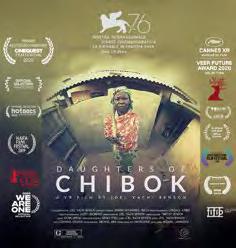
Stories told in 360 have a way of transporting people to places they have never been to before. It is something I am pretty intentional about. The stories I tell in VR need to be amplifying something. People often ask me about the power of VR. Where does the technology truly shine? I am of the opinion that VR has the ability to take you to places you otherwise couldn’t go to. In Daughters of Chibok, we took people to Chibok, this town they had heard so much about but knew little of. When deciding whether to make a story in VR, I ask myself how accessible and unique a place is. If it’s somewhere that is easily accessible, then it might just be another VR tourist piece. But if it’s somewhere hard to get to, with voices that need amplification, then it becomes a no-brainer.
Stories told in 360 have a way of transporting people to places they have never been to before. It is something I am pretty intentional about. The stories I tell in VR need to be amplifying something. People often ask me about the power of VR.
Where does the technology truly shine? I am of the opinion that VR has the ability to take you to places you otherwise couldn’t go to.
Diving into the more technical bits, can you tell us about the equipment you use in your productions?
I started with the GoPro Omni but I don’t use it anymore. It has gone into my private museum. The GoPro, while a beautiful camera, was a bit of a hassle. For instance, if one of the cameras (the Omni has 6 cameras) decided it was not going to work, none of the cameras would. An even bigger challenge we had with that camera was that we couldn’t monitor. It was the craziest thing to make Daughters of Chibok with. I would choose a camera to be the main character, set the scene, run away to hide in a corner, and hope for the best.
I use the Insta 360 Pro now. It’s a pretty cool camera. With this camera, I can monitor and the post-
production flow is better. After I record it provides me with a prestitched piece, then I can move to Adobe Premiere Pro which is where the stories are created. I guess that’s the thing with technology, as it changes and evolves, you evolve with it.
My big dream is to get the Insta360 Titan. It’s this massive camera that costs about fifteen thousand dollars.
It’s a camera I have worked with before, and it has great resolution, especially for night shots. For the next project I am working on, it’s a bit ambitious and there will be some night shots, and that’s where the Titan shines.
I won’t say so. For the equipment, it’s really all about having the money to buy them. Perhaps, it’s because I am more focused on the story, I don’t see hardware as much of a challenge. I use whatever I have access to. And the thing is that whatever your price target is, there’s a kit in your range. So, I don’t let that worry me. What drives me is the story. If I want to tell a story and the only thing I have is a small GoPro with 2 lenses, then I’ll go ahead and make the story with that camera.
What would you then say are some of the biggest challenges you face?
Finding the right people. Getting people with the skills you need is like finding a needle in a haystack. What you need is to find people with the passion, and that can be quite tough. The work we do can be quite gruelling and monotonous. What you need are people with the right mix of passion and patience.
Another problem is that a lot of people don’t think there is money in VR. They don’t see the financial opportunities. They ask questions like how many watch VR? And where is the money in it? You can’t blame them; look at the reality around us. There is not much institutional support for XR, except for people like me who use our money to fund these crazy dreams.
Speaking of getting the right people, how do you put a team together for your projects?
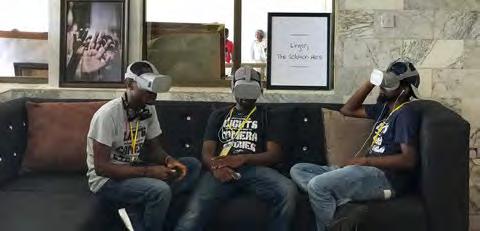
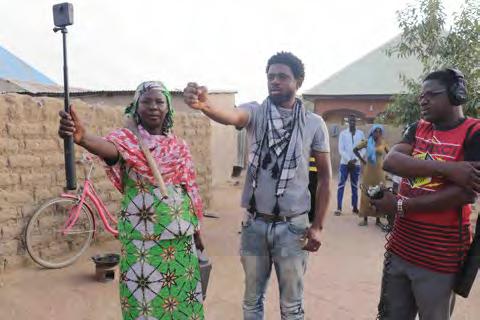
For a project like the one I am currently developing, I’d say that the core team would consist of about 4 to 5 people. There’d be me, the director, providing creative guidance. We would have someone in charge of running communications and
writing for the project. There would also be 1 or 2 people shooting the project itself, and then one more person for post-production. I am not a big fan of large teams, so for a project like this, there would be 5 people.
Have you found it challenging to get your hands on this equipment?On set for the production of “Daughters of Chibok” (2019) Image courtesy of Joel Kachi Benson Previewing the film. Image courtesy of Joel Kachi Benson
So far, all of my projects have been self-funded. We keep busy doing commercial work, and profit from our commercial work funds our VR work. All my three movies have been self-funded. Half of the reason for this is that I couldn’t find funding opportunities. The other reason is that there is a very short buffer period between when I get an idea and when I start working on it. Getting money from people
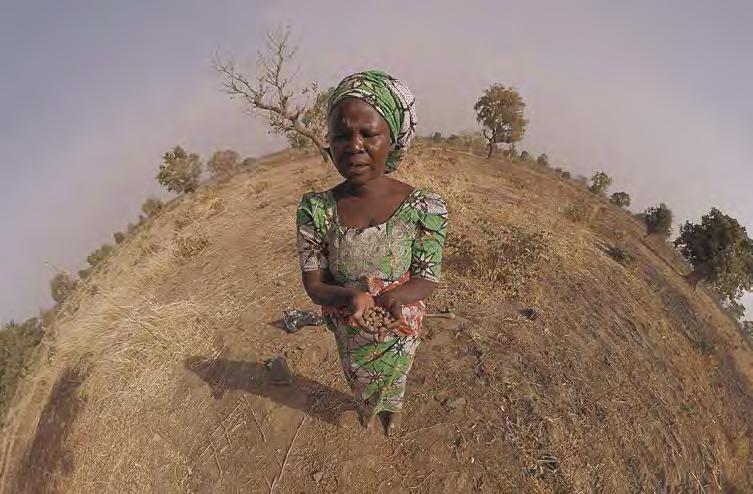
takes time and I don’t have time. I am also sort of exhausted by the process of asking for money. You do all this writing without any guarantee.
For our next project, we are thinking of looking for some funding. It’s an ambitious project and it will cost more, so I am hoping we find partners that believe in us and believe in the project.
You’ve talked about funding your projects and needing money for equipment, tell us how you finance your projects?The virtual reality documentary tells the story of Yana Galang, whose daughter, Rifkatu, was among the 276 girls kidnapped by Boko Haram in April 2014 from their school dormitory in Chibok, northeast Nigeria. Image courtesy of Joel Kachi Benson
What kind of support do you think needs to be in place for these technologies to take hold?
For one, we need funding opportunities similar to what’s available to our counterparts abroad, where you can get money for a project without anyone pointing a gun to your head to produce a return on investment. You are allowed to fail. That doesn’t exist in Nigeria. I think that’s going to be the biggest challenge. There is just zero support for it (XR.) The bulk of our content is consumed outside of Nigeria. The bulk of our support is also from outside Nigeria. That lack of support
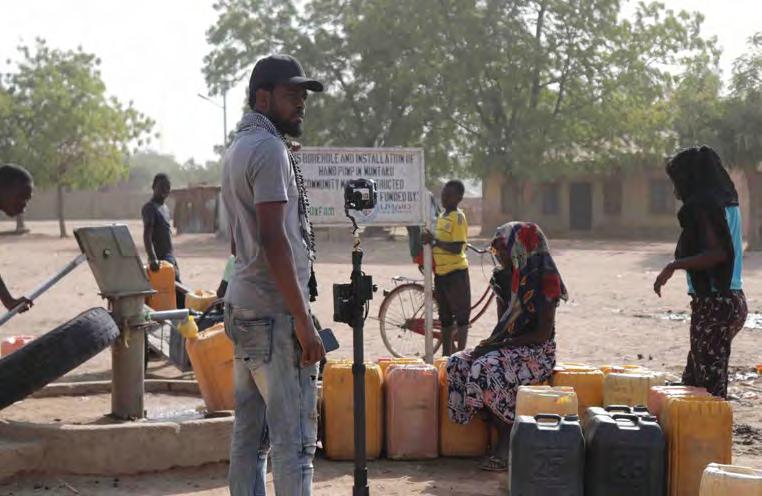
can only send us backwards. There’s not going to be much progress.
From a policy standpoint, the people in government need to understand what XR is in the first place. Just understand it. What do they know about XR? If they know anything, are they speaking to someone higher up about it? We can’t always be playing catch up.
Everyone around the world is trying to get a hang of this technology.
Everyone is trying to figure it out. Everyone is trying to do stuff. This is the time for us. Kids in secondary school should be able to experiment with XR. We cannot keep consuming. We have to start creating. And there has to be a system that encourages people to create. Nothing says a kid in secondary school can’t start messing around with a small 360 camera. I don’t know if there’s anything like that in place. I personally don’t know of any, but this is what we need. More systemic and institutional support.
Founder, Imisi 3D |
Founding Director, AR/VR Africa.
Judith Okonkwo is an Extended Reality Evangelist, Business Psychologist and Organisation Development Consultant with experience working in Africa, Asia and Europe. She is a member of the World Economic Forum’s Global Future Council for Augmented and Virtual Reality, and sits on the Global Council for the Africa Centres of Excellence for Bioinformatics and Computational Biology. In 2016, she set up Imisi 3D, an Extended Reality creation lab in Lagos focused on building the African ecosystem for Extended Reality technologies (AR/VR/MR) and connecting XR communities across the continent. In 2018, she convened the AR/VR Africa consortium, which holds large XR events on the continent. In this interview, she shares her vision for Africa’s XR Community and Imisi 3D’s role in that future.

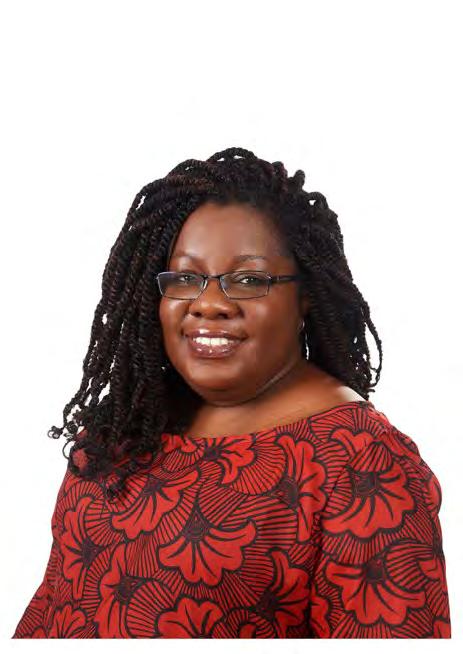
I have degrees in psychology and business psychology. So professionally, I am a business psychologist. I’ve done everything from a stint in the Nigerian military during my youth service, to working in academia, consultancy, aviation and financial services. Lots of varied experience in different fields. I’ve also always had a natural curiosity about the future and a genuine interest in technology and what it can do. I dabbled in a few technology learning opportunities when I was younger, a little bit of learning about databases, and I used to play around with tools like Dreamweaver.
Another interest of mine is leadership on the African continent. Several years ago I developed a leadership development coaching model based on the Oriki of the Yoruba people - an ethnic group found in southwestern Nigeria and portions of West Africa. Later, still living in London and now starting a doctorate, I was doing even more work around leadership in Africa. And I thought, “Well, I should probably spend a bit more time on the continent, if I am really going to do this meaningfully.” So I started checking out different cities. I went to Addis Ababa, Accra, Nairobi, then I came to Lagos. Lagos in 2014, was such an amazing time for innovation and technology, so many incredible people. One of the people I met was the co-founder of Andela, prior to Andela starting. He talked about what he was going to do and it just made absolute sense to me. I was like, “I’m in. I’ll do whatever I can to help”. So I came to Lagos and spent a year helping Andela get started here in Nigeria, and in Kenya.
What’s your educational background, and how has it led you to what you currently do?
That foray into the technology startup world with Andela gave life to so many things I believed and had been trying to get people to see, especially during my time in Europe. The fact that this country, this continent, is full of these really incredible, hardworking, talented people, despite all the stereotypes that exist. Around that time, there was also a great buzz around the Oculus acquisition by Facebook , and quite a bit of excitement starting around Virtual Reality, and yes I was just a tad bit excited about that. I really wanted to get the DK Two, but couldn’t. Instead I ended up getting the Samsung Gear VR once it came out. And once I got it and tried it, I was like, “Yes! I can see the possibilities”.
I was so, so excited. And I kept thinking about the talent I’d encountered. These amazing, incredible, hardworking young people who, in my opinion, could literally make magic. They would
go to such extraordinary lengths to learn, to develop themselves, to excel. That’s something I really appreciate about people, the commitment to excellence, to doing their very best work. They were changing global perceptions of technology talent, and creating unprecedented demand from Africa.

What a world it would be marrying all of that potential with the potential of this technology which is finally in the consumer space. The more I thought about it, the more I thought it should happen. And the more I thought it should happen, the more I told people about it.
Not a lot of people got it. And let’s be honest there was this great debate going on in tech circles about whether VR was just hype or the next evolution of technology, what the killer use case would be etc. Despite this, one thing I think everybody sort of agreed on, even if they weren’t saying it out loud, was that spatial computing was going
to be the computing platform of the future. And for me, that reality meant that this was in some way, shape, or form going to underpin much of our future. And if that was the case, we had to be part of it. So, I started and I thought “Well, if I really believe people here in Nigeria, and other African countries should access these technologies, then I’d better start to make it happen”. So, I began.
It was a simple start, I ordered a VR ready computer from Amazon. I’d already gotten the Gear VR. I got a couple of books and a 360 camera. Bosun Tijani gave our lab its first home, a corner of the legendary 6th floor at CcHub . I’d also bought a carton of KitKat and kept a bowl of chocolate on the desk. I knew that would catch people’s eyes. They would come over and ask, “ Can I have some chocolate?”, I would say yes, and we’d start with chocolate and end with VR. And then the conversations would really start.
I wanted us, African voices, to be part of shaping and defining this technology. And I thought, “ My God, we certainly don’t want the situation we’ve seen with other technologies.”

Like Artificial Intelligence, for example, where there’ll be an incident one day, and people will say, “Oh my goodness. Oh, there’s a bias there. There wasn’t a diverse team working on this, that’s why we have these sorts of problems.” We could eliminate all that going forward if we just set out to make this technology accessible and inclusive.
The vision was that we would adapt and adopt the Extended Reality technologies for our purposes. The other thing I’d seen and I knew was this - the kind of solutions we need locally might not be the first thing on the lists in other parts of the world. So if we wanted them, we had to build them.
So, that was the big picture, that we would be part of that. In practice, it was people having access because it shouldn’t have to be us giving them access. People would have access to the technologies, people would be able to acquire the skills and knowledge to drive work, research, creation with these technologies, and develop expertise. I remember in those early months, someone asking me how I would know if I succeeded. And I said it will be when you’re looking for XR talent in the world and you want the very best, you’re planning where to call and you’re just as likely, or my real vision - even more likely, to call Lagos or Douala or Nairobi as you are to call Singapore or London or Kyiv.
We’ve never been a traditional business, we are wholly impact driven and mission focused. So, I just started on my own.
The vision was that we would adapt and adopt the Extended Reality technologies for our purposes. The other thing I’d seen and I knew was thisthe kind of solutions we need locally might not be the first thing on the lists in other parts of the world. So if we wanted them, we had to build them.
We’ve tried a few things. I always start with our XR labs, which are open access, and free. Anybody can walk in, spend time there, use equipment, and learn. That’s always the first step. And in service of that, particularly before the pandemic, we would focus a lot of our energy and resources on evangelization. Going out into the community in various ways, whether that’s going to large scale events, or to schools, places where we introduce people to the technologies, do demos, and do talks. We did that extensively and had quite a reach. We also have sessions where we’re hosting groups in the lab, particularly students, both secondary and tertiary. They come in to do sessions in the lab, to find out about the technologies and to explore.
We also do some training. We have an introductory course for VR that runs over a couple of weeks which we’ve run in the southern part of Nigeria. We run lots of workshops. We also look for ways to support the community and we have a subbrand called AR/VR Africa, which is really focused on that work for the community across the continent.
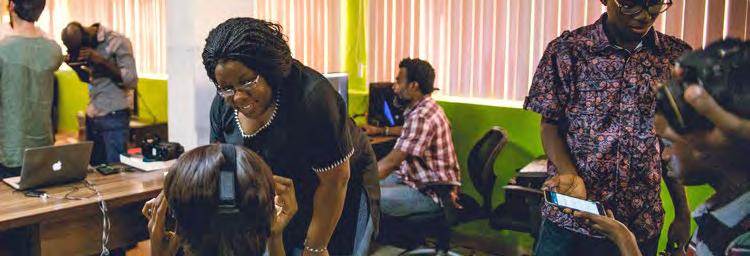
Under that remit, we have an AR/ VR Africa group on Facebook. Prior to the pandemic we ran in-person meetups every other month, bringing people together to try things out and do workshops and tutorials related to XR. We also organise events to inspire people to build. We’ve been doing XR hackathons since 2016. And with these the intent is twofold: can we get people to build for various sectors or the challenges we have; and how can we demonstrate the impact of the potential of XR for society.
For the first hackathon, we asked participants to create solutions for either education, healthcare or tourism. Sectors with scope for significant positive impact locally. Those verticals have been a recurring theme over the years, and we expanded and added others like climate, social justice, gaming, etc. Our last hackathon in 2020 was the largest by far because of the pandemic. We ended up going from an in-person event planned for 10 countries, to having this hybrid event with participants from 28 African countries.
So, it’s activities like that. We’re constantly thinking, what more can we do? How else can we engage people? We opened mini labs in seven states around Nigeria. We had seen a concentration of activity in Lagos because of what people could access. We look for creative ways to make sure more people can have access to the technology and resources, it’s a key element of our strategy.
Alongside this we definitely build or create, but the amount varies. Building and creating is at the heart of what we do. Our purpose is to facilitate people building and creating with XR. So we’re always encouraging that in some way. Whether it’s through our labs, giving people access to equipment and resources, or encouraging people who come through our doors to develop. For example, we’ve just had some interns from a university spend time with us. And as they go through the learning journey for these technologies, there’s this emphasis - “Okay, every week, let’s see what you can create”, what can you build?
I don’t think there’s one thing I would pick. We’re doing a lot and hoping it will have an impact beyond what we imagined. There are things we are doing, or have done, that I think could really make a difference. Our production work with Daughters of Chibok and Lagos at Large, for example. It cast a spotlight on XR creative talent from the continent because, of course, everybody was wondering, “who is this person we had never heard of who won the Golden Lion for Best VR story”, and things like that. Kachi is this incredible talent who had been making amazing documentaries for several years before that. But in the immersive media space, people were just realising that they needed to pay attention to him. It was similar with Jumoke Sanwo’s Lagos at large. Bringing this global spotlight to African XR creators is wonderful, and emphasised in this instance by both productions making the Forbes list of The Top 50 XR Experiences of 2019.
There’s our VR for Schools work. I truly believe XR will transform education, particularly in resourceconstrained environments. As part of the initiative, we worked with UNICEF to create educational virtual reality content for the Nigerian secondary school curriculum. Lagos is a city in Africa where the population is growing to
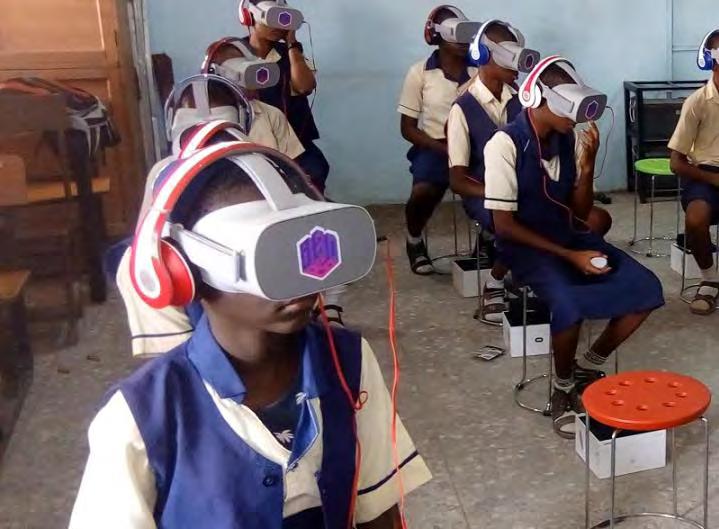
outstrip the physical resources and infrastructure. We already have challenges when it comes to space, qualified teachers, learning resources and funding, so much so that if we’re looking at conventional means as a way of solving them, we’re not going to get anywhere. If VR for Schools is the beginning of solving that, that will be incredible.
Finally, I will mention the African Delegation to Laval Virtual in 2021. It was something we’d been trying to do for a long time (4 years!). Getting an African delegation to a global XR event, not just to observe, but to fully participate. We had an
African Pavilion with 6 startups from different countries showcasing African XR products and services. We were there to do business.
Despite this, I often feel we’re not doing enough. We’re much further behind than I would like and there is so much to be done. We need to get more support, we need to get more people working together, we need to get more countries involved. There is so much to do. So every time our work makes a difference for even one person, perhaps inspires them to start their XR journey, that’s really meaningful.
What is the most significant or impactful work that you’ve done?The VR for Schools program, part of UNICEF’s education initiative Image courtesy of Imisi 3D
Funding has always been a major problem. Africa has been this black hole when it comes to XR. The amounts that trickle in, when you think about it, it’s ridiculous in the larger scheme of things, right? So, there’s that.
For some of the other challenges, we started to talk a bit about talent and opportunities for people to learn. It would be helpful if opportunities to acquire knowledge and skills were more readily available in our formal institutions. That change does need to happen soon.
I think not only do governments need to start understanding what these technologies are, but they need to start thinking about how to create an enabling environment for these technologies in our various countries on the continent.

What do we need to do in terms of our educational systems? What do we need to do in terms of policies? What do we need to do in terms of industry, how do we really incentivize this space, given all these challenges that we know exist?
Because if these technologies are what they are, if they’re part of this computing platform of the future, if they are the key to so many solutions that can really make a difference? Then we should be developing this ecosystem a lot more.
So, what are some of the challenges you’ve encountered?
I think not only do governments need to start understanding what these technologies are, but they need to start thinking about how to create an enabling environment for these technologies in our various countries on the continent.
We have a non-traditional approach because our goal is to get more people involved with XR. So when we can, it’s an open door policy. You want to do XR? Yes. Come and then we will see. Can we support your growth and development, can we help you acquire and apply the knowledge and the skills that will allow you to thrive in this space?
That’s typically how we work, as opposed to looking for specific talent we’re trying to develop the talent. In a lot of situations it might be more expedient, sometimes even cost effective, to get the work done in another part of the world if it was solely about production. Our focus is on being African, so we make sure that we’re building on the continent, with people from the continent, in all the work we do.
I could say a lot of things like, I’m not a quitter and all of that. But I think even more than that, this work, it’s not something you quit. It’s so much more than me. I believe if we do not do this work, we will have a world in which we can not live in 15 or 20 years. I think a world where Africans have been excluded from the XR technologies is one that is headed towards catastrophe. And when I look at it from that perspective, it is work that must be done. It’s been heartening, in the last two to three years, to see a lot more people coming into the XR space.
More young people doing work on the ground, which is fantastic. Hopefully that will continue to grow because we really do need everybody working together.
I think a world where Africans have been excluded from the XR technologies is one that is headed towards catastrophe. And when I look at it from that perspective, it is work that must be done. It’s been heartening, in the last two to three years, to see a lot more people coming into the XR space. More young people doing work on the ground, which is fantastic. Hopefully that will continue to grow because we really do need everybody working together.
What can you say about Africa’s representation in the XR space, and what more can be done to encourage it?
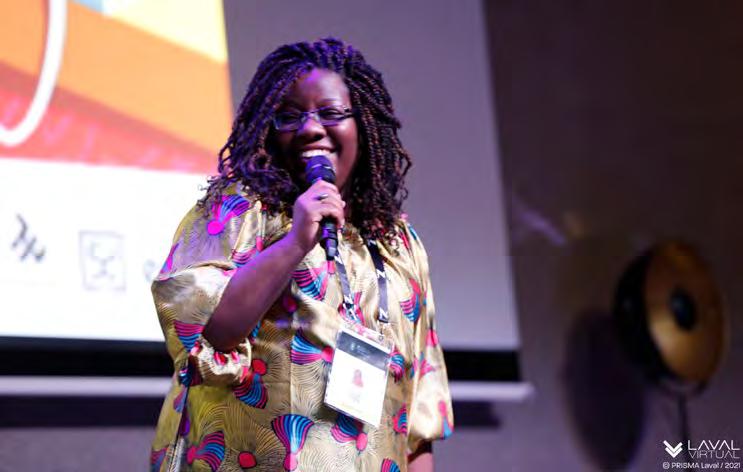
There are people flying the flag for the continent in great ways. Look at the amazing work that Ingrid is doing in South Africa with Electric South , the labs they run, the amazing catalogue of African immersive content they have produced. It has given people in all parts of the world a sense of the talent available locally, which is fantastic.
All the award winning work that we’ve seen emerge is telling its own story about what’s possible. Black Rhino VR in Kenya has been doing fantastic work supporting the community, running initiatives,
upskilling people, and advancing the ecosystem there.
One thing I hear constantly is, “Oh, people do XR in Africa? Oh, we didn’t know that. We don’t have any information, how do we get data?” We are bridging that knowledge gap with the Africa XR Report. Not just for the wider world, but for our ecosystem too. It’ll be fantastic to have this resource, if you want to do an XR project in Benin Republic, you can look it up and find out who’s doing XR there and connect with them.
One thing I hear constantly is, “Oh, people do XR in Africa? Oh, we didn’t know that. We don’t have any information, how do we get data?” We are bridging that knowledge gap with the Africa XR Report.
We’ve tended to focus a lot on Unity in terms of software. One thing we’ve always wanted is to have a range of hardware when it comes to XR. We have a lot of Oculus headsets; HTC ; and Samsung - the old Gear VR s and the Odyssey . We have 360 cameras like the Ricoh and Samsung 360 For productions, we use the Insta 360 Pro II ; and we have other bits and pieces in the lab, like the Leap Motion .

Am I happy with the hardware that we have? No, we want more. Of course, alongside the headsets and devices I was talking about, we’ve got systems, PCs, and laptops that are XR compatible. I’d like to have a super heavy-duty workstation that will allow us to be much more efficient in post-production for our 360 immersive pieces.
We want to have equipment like the HoloLens and the HoloLens 2 . We want to have more highend headsets so people can start to experiment with those and see what’s possible. There’s so much more we should have. And the idea really would be that we have some of everything. The idea is not so much that we’re specialising in one particular aspect of it, it is that this will then be a place where people can come and understand the breadth of what’s possible in the field. You can experience it, you can start to decide in what direction you want to take your own XR journey. Most of the equipment in the lab came in my suitcases, because XR hardware is not available here, it’s not sold locally. I hope that changes soon and the Big Tech companies begin to sell their XR equipment on the continent.
Most of the equipment in the lab came in my suitcases, because
XR hardware is not available here, it’s not sold locally. I hope that changes soon and the Big Tech companies begin to sell their XR equipment on the continent.Experimenting
Imisi 3D has a dedicated community on Facebook. What are the activities community-wise? And who are the community players?
I was in the fortunate position to see the impact of tech communities before I started this work. In Nigeria the technology communities have made a huge difference, driving the growth of the ecosystem.
We want to create something similar for XR, where people come together with shared interests to learn and support each other. We want to see more labs in other African countries. The AR/VR Africa Facebook group gave us reach beyond our physical
location, and is open to the whole continent. And then we would have these physical events locally, where we’re able to bring people together for the networking and learning experiences that are the hallmark of community events.

What those did, and continue to do, is give people the opportunity to connect. And I’ve seen quite a few examples of people connecting in that space and going on to work together.
Who has supported your work so far?
There is UNICEF , as part of the innovation fund to support the work we were doing with VR for education. The majority of the other financial support has been limited to sponsorship for programs and events we’re doing. Meta , for example, has sponsored all our hackathons so far. Saison Africa 2020 funded the African Delegation to Laval Virtual. There’s in-kind support too, so many have been incredibly generous with their time, expertise and resources; and our lab has been hosted by CcHub and Meta’s former community space in Nigeria, NG Hub .
Something not being said enough about XR on the continent is the need for an African XR strategy, a continental agenda must exist. We need governments at the national level thinking about and working actively towards this, as well as at the continental level. Because without that, what direction are we going in? We must say we want to achieve x or we want to achieve y. Then we can work backwards from that by putting all the required blocks in place. We also need African access strategies in big tech companies that are informed by Africans. In service of this we need to have a gathering bringing all stakeholders together - government, industry, academia, big tech, practitioners, international organisations - an African XR Summit.
Without a bold XR vision for the continent, and stakeholders working together, I fear we will fail. We will fail our young people who are the workforce of the future. That’s the

first thing. The second, and this is addressed more broadly to everyone on the continent, would be that these technologies, whether you like them or not, are part of our future as the human race. So get involved. It might not be directly with the technologies, you could support someone that wants to learn. But one way or the other, know this: It is not coming, it is here. And we need to figure out how we’re going to play.
When it comes to education, how are we ensuring that the learning needed for expertise in these technologies is being introduced into the school system as early as possible? What do we need to do? Apart from programmes and formal institutions, should they exist, what else will support people who want to learn? What kind of things can we make possible as a government? And then what do businesses need if they’re going to be involved with XR?
What are your thoughts on policy? And what are you hoping to see from big tech? How can we engage talent and build the ecosystem on the continent?
Without a bold XR vision for the continent, and stakeholders working together, I fear we will fail. We will fail our young people who are the workforce of the future.
In the next one year, I believe we’ll see a proliferation of XR activity. I anticipate a lot of initiatives around XR in the next year that will help people start to understand what direction they may want to explore, what focus areas may or may not be, but I think it’ll be early days yet. There’ll be lots of hits and misses. But, I think it’s all part of growing and that should be good.
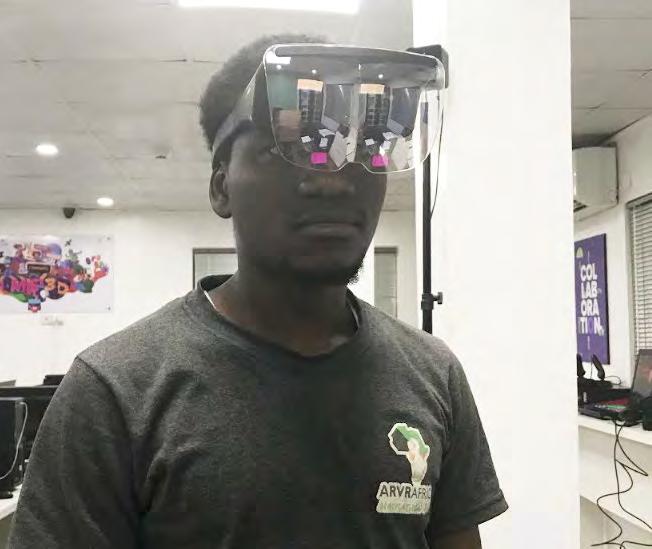
Looking out, ten years down the line will be interesting. We’ll definitely see that XR access has increased exponentially and these use cases we’ve discussed will be a lot more established. I see the technologies and the devices, whatever format they are in, then lending themselves more to the way we engage with the world with mobile phones right now. So for example, we’d start to use AR to do ideation work, tasks like that, just because it’s a really exciting visual way to do so.
My hope is that in 10 years, the work we’re doing, trying to build the ecosystem, will be almost obsolete. And that would be because there is an African XR strategy, and that African governments, and other relevant institutions and stakeholders, have put the structures in place to ensure an enabling, incentivised environment for the XR technologies; that there is support for all who want to participate, and there is access.
What are your predictions for the future of XR in Africa in the next year and ten years from now?
My hope is that in 10 years, the work we’re doing, trying to build the ecosystem, will be almost obsolete. And that would be because there is an African XR strategy, and that African governments, and other relevant institutions and stakeholders, have put the structures in place to ensure an enabling, incentivised environment for the XR technologies; that there is support for all who want to participate, and there is access.Experimenting with VR applications at Imisi 3D Image courtesy of Imisi 3D.
It started back in my former neighbourhood in Kaduna, Nigeria. My mom was one of the first people to set up an Internet café. It gave me an early start in computer education and an upper hand. I used to make prints of the diagram of the circulatory system or whatever topic that the teacher was teaching in school and
Kabiru Seidu Co-Founder & CEO NubianVR
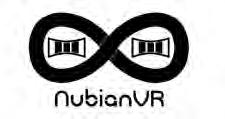
Kabiru Seidu is the Co-founder and Innovation Leader of an interactive products and games company, NubianVR based in Accra, Ghana. He’s passionate about the education sector and all the ways digital learning can be used to develop learning and interactivity. He is also the Co-founder and Programs Director of Nubian Foundation, which works closely with several government agencies and INGOs like UNICEF to carry out research that is focused on understanding how VR can be used to improve the learning experience. In this spotlight, Kabiru shares how he became an advocate for XR and the potential it has for innovation in education and the future.
I studied Computer Science at Ashesi , where I got actively involved with projects related to education. I worked with a team that was running an adult literacy foundation in villages close to the school and was excited about teaching the elderly members of the community. At that time, most of the work we were doing was low-tech and I was a little bit dissatisfied with the methods we were using to engage them.
After graduating from university, I was trying to figure out my career path and decided to stay on to work as a faculty intern. I had a very close friend, Jonathan Dotse who is a filmmaker. He had gotten excited about Google Cardboard, but there was no access to it here. He had to make a Google Cardboard by himself using the open-source design. I was
just coming out of a class when a sleep-deprived Jonathan showed me the completed headset. Before that day, my first knowledge of Virtual Reality (VR) was from a YouTube creator called Jason Silver around 2014, who got me super excited about it. I had done a bit of research into it, and considered how it could be used in the education sector. But before Jonathan gave me the headset, I had never experienced VR before.
I went to one of the bathrooms at the university, and had a full cinematic experience. I had never encountered anything like it, and it got me committed to exploring the technology.
Our early works in NubianVR were largely around designing content to use on our prototype Google Cardboard. That was in 2015 and there weren’t full 360 cameras. So we rigged a setup with two Kodak SP360s and stuck them together to record simultaneously.
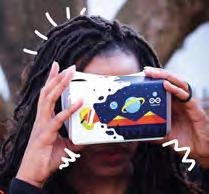
Later we stitched the videos together to form a complete 360 video. That was how we were able to produce a short story called Pandora, which was a tour of Accra in 360 from a very interesting character. The first demo was at the Chale Wote Street Festival here in Accra. I believe it was the first 360 film made on the continent and my entry into VR.

VR is still in its nascent stage, and the equipment is expensive. As a result, we’ve had to involve ourselves in other aspects of interactive technology. This is okay because we don’t see VR in isolation. VR is a continuum of other technologies and doesn’t exist alone. So we embrace the possibilities to venture into other spaces like AR and MR. Our work covers developmental Virtual Reality applications and Augmented Reality applications, but our primary work is interactive games on mobile. Plus, from a product point of view, we’ve had to accommodate the reality that VR solutions are hard to market on this side of the world.
We’ve also worked with other forms of technology in creating web games. Presently, we’re working with UNICEF and the Ministry of Education here in Ghana to digitise new lesson material they created to teach schools about online safety and digital literacy. The content will be utilised as mobile interactive games, instead of VR, because of accessibility. We will eventually build content on the VR platform when the equipment becomes cheaper.
we recently put out a call for developers, and wow, we got an overwhelming amount of responses unlike before. I found it very encouraging, and it showed that there are people committed to gaining knowledge of the technology.
NubianVR educational applications. Images courtesy of Nubian VR.
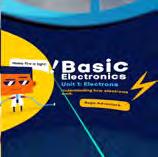
In the early days of NubianVR, finding the right people was our biggest challenge. Whenever we had a project, we went through a line of developers who we thought had the skills, but we were eventually disappointed by their work. Or if we put out a call for Unity developers, we’d probably get one or two people.

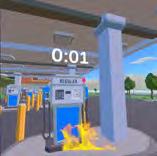
But we recently put out a call for developers, and wow, we got an overwhelming amount of responses. I found it very encouraging, and it showed that there are people committed to gaining knowledge of the technology. In NubianVR, we have a very fascinating, technical lead. His name is Andy Cushing. When we found him, he had little or no experience in VR. Andy’s
background is in traditional web development. He’s a gamer at heart and has a portfolio of his games. It was a dream come true for him to find a company that was ready to pay him to make games and VR applications. My particular skills are largely around product development and product management, so I work closely with Andy. Together we resolve any technical issues of the products or ideas that I conceive in my head.
Most developers were either not motivated enough to learn about the technology, or did not have the relevant skill set that made it easy for them to transition into VR development. So finding talents was a challenge for us.
Have you branched out to other XR spaces apart from the VR space?
In the early days, most of our content was 360 videos. Pandora was the first. We also did a fun exhibition in Senegal and the theme was an alternate reality. We created a VR 360 experience essentially made with Unity. Then we went ahead to create some more 360 films.
Between 2015 and 2017 there was a lot of experimentation. We were doing a bit of 360 film and creating a few interactive VR applications. Now, our primary focus is to hold the hands of organisations and ask them, ‘How can we help you take your courses online?’ With COVID, lots of them have been able to implement some kind of online training programs. So our value proposition to organisations beyond the school community is to help them digitise their employee handbooks and training materials into minigames. Based on that, we would be able to move them gradually towards appreciating the value of interactive technology and guide them towards understanding the XR experience.
How has the experience with organisations that are adopting the XR technology been?
In reaching out to organisations it has been a mixed experience. Let’s say in the mining space, they see the value VR can offer if we use it to update their training.
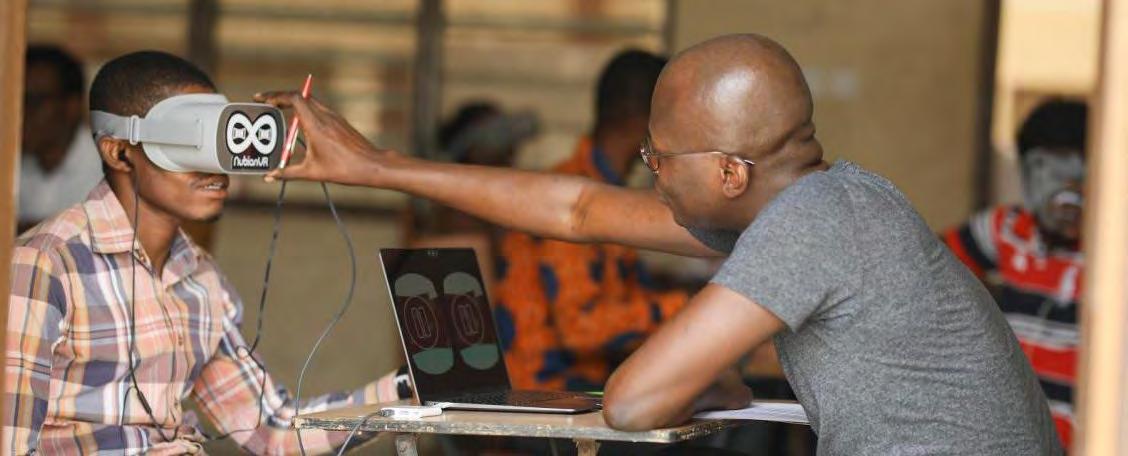
Unfortunately, VR solutions are capital intensive and require a huge financial commitment. Most organisations are not willing to pay the extra money, but
they want to take their training to the next level, so we make the video for them. That has been the reception so far, particularly for VR.
However, there has been a higher interest in interactive technologies like mobile apps and web apps. Although it’s not what we initially set out to do, it is the level that we are at now.
Unfortunately, VR solutions are capital intensive and require a huge financial commitment. Most organisations are not willing to pay the extra money, but they want to take their training to the next level, so we make the video for them. That has been the reception so far, particularly for VR.
Just for context, I had little to no experience with VR. I was working with a team that was managing a project funded by the F ord Foundation . The objective was to get students in Ashesi to start projects that would have an impact on the university’s community. Most of the projects in my portfolio were in the educational space, and that was where I was most interested.
In 2019, when we secured the UNICEF Innovation Fund grant, we set out to build an open-source educational platform that would be
able to make it easier for anybody who was going into content creation in VR to find the relevant tools that they needed.
The project is recognized as a digital public good and I feel proud of it. The work we’ve done is publicly available and people have the opportunity to access it. Unlike when we started building VR content, and it was daunting to access that kind of knowledge. We have put out work that essentially helps alleviate the challenge, so it’s something that we are proud of.

Then there are a couple of other in-house projects that we haven’t made public. They are arcade and adventure games that require a lot of resources. Our approach to building games is to brainstorm on how we can build prototypes to demonstrate the full game. or a vertical slice, as they call it in the industry. Despite these games still being in development, I’m proud of them, largely because they keep our lights on. We have decided to diversify to other fields that are much more on the path to VR, although they are not necessarily VR technology.
I think the experience made us to realise that we were doing serious work, and people around the world recognized it. All along, we’ve been taking it seriously, but it felt like we were just dreaming. We didn’t think we would be able to get to the final destination we had in our heads.
Can you tell us how you were able to get the UNICEF Grant and what the experience was like?
I think the experience made us realise that we were doing serious work, and people around the world recognized it. We had been taking it seriously, but it felt like we were just dreaming. We didn’t think we would be able to get to the final destination we had in our heads. So when UNICEF reached out to us in 2017 and encouraged us to apply for the Innovation Fund it was very serious. They said they had seen our work and were interested in us. We were also told that the funding was up to $100,000, enough to cover the cost of building our VR solution. The catch was that they wanted it to be open-sourced. For us, it was
not a big deal because our work relied on open-source technology too. Since we were able to benefit from it, we wanted to contribute to giving back to the community. When the program started, we agreed that we would build a lesson creator that is easy for anybody that wants to create VR lessons to access. If they had a video that they wanted to insert into their lesson, we made it easy for them to do that. If they wanted to create a 360 video or any interactive component as a part of their lesson, the lesson creator was able to help them with it.
I have to admit that the early days of the project were emotionally gruelling and a bit daunting development-wise. I mentioned how difficult it was to find development talents. We had hired a few developers for a while but most of them transitioned into other roles. Before we completed the project, we changed about three developers because we realised that the skill set was unnecessary. The most painful experience was when we had to change our code-base, but ultimately it resulted in us finding the talents we were looking for, so not entirely a bad thing.
We used a range of them. So, for the software, we use Unreal Engine for some of the experiences. However, we use Unity Game Engine the most. Also, when we started, we flirted with Web VR, but the scope of what we needed to do was technical and we weren’t getting the results we needed on the web. It was a hard decision for us to transition to Unity, but it was necessary if we wanted to go down the open-source web routes.
Our hardware has evolved. Initially, when we started, it was with Google Cardboards. We didn’t have the budget to get the Oculus DK2 , so we used the next best thing which was, the Samsung Gear VR . Eventually, we transitioned to Oculus Go. The lesson creator for UNICEF was primarily designed with the Oculus Go . But the Go is no longer supported by Oculus, that’s why we are working towards transitioning most of our codebase from Go to Quest . We are relying on Quest for our VR solution and also AR, because we build mobile and web games. Lastly, we use smartphones.
The Quest is a game-changer for VR. The promise of VR in a device that costs around $300 is awesome. Looking back at when we started, I think that accessibility has greatly improved.
In 2015, we had to hack together some kind of VR headset which was suboptimal until we got the Gear VR. By the way, you had to use a Samsung phone with the Gear VR and that was around $1,000. The Gear VR holder was an additional $200 or so. If you didn’t want to go that route, you would be spending $1000 on getting an Oculus-ready PC, and another $600 to $700 on getting an Oculus DK2. From about $1200 or $1800 when we first started to $300 or $400, the trajectory speaks for itself. We want to see VR equipment become more accessible and mainstream. Just like how in 2010 there were under 200 million people in the world using smartphones, but ten years later that number has grown to about 2.5 to 4 billion people.
We want to see VR equipment become more accessible and mainstream. Just like how in 2010 there were under 200 million people in the world using smartphones, but ten years later that number has grown to about 2.5 to 4 billion people.
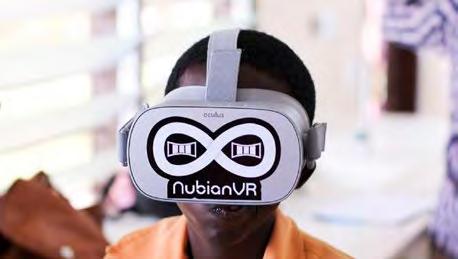
What equipment and software did you and our team use to build the experience that you work on?
The technology is growing as the years roll by, how has it been in terms of accessibility to equipment?UNICEF Innovation Fund Graduate: NubianVR Images courtesy of Nubian VR.
There are a lot of challenges and I’d like to address them from various angles. From a human capital point of view, web development talents have flooded the markets.
If you go looking for XR creators, what you’ll get is an overwhelming number of web developers, fullstack developers, front and back-end developers. And many of them have not honed their skills so that they can be relevant in the XR space. There’s still a limited amount of talent in the market, but it is better than before.
From a product point of view, VR is very much in its early stages. It is a fact that building VR technology is very expensive and most VR companies are after a productmarket fit. However, it is important to acknowledge that there are a lot of high-risk investments in this space, because everybody is still learning and carrying out experiments.
Even keeping a team of creators is expensive, and you require both technical and creative skills. It will be best if people have the right mindset and are more accommodative of the technology.
Concerning the work that you do, have there been misconceptions from people that are not familiar with the industry?
One of the misconceptions I encounter is this statement, ‘Is the continent ready for this?’ People are not taking VR seriously. I mean, It’s good to lay the groundwork for any emerging technology before it reaches maturity. So if schools say they are not ready for VR today, in five or ten years when the device is more accessible, it would still be a challenge to get into the market because there has been no inculcation at the ground level. I understand the concerns of people who see VR as fancy technology, or as a showpiece that does not offer real solutions.
Truly, these are legitimate concerns, but the XR technology is inevitable. It is the next level of computing. The evolution of technology is such that if
you go to the office of a creative, you will find one or more screens around the person because they need enough real estate to display content.
However, this kind of experience is not optimal. What VR brings to the computing platform will be a condensation of all the information into one medium. The benefits it has for computing are unprecedented.
Once people start to understand and appreciate that, then they’ll look at VR differently. So for me, that’s the biggest misconception that people have about VR. Anybody who gets into it in these early days and can sustain themselves until it reaches its peak would benefit the most from it.
One of the misconceptions I encounter is this statement, ‘Is the continent ready for this?’ People are not taking VR seriously. I mean, It’s good to lay the groundwork for any emerging technology before it reaches maturity. So if schools say they are not ready for VR today, in five or ten years when the device is more accessible, it would still be a challenge to get into the market because there has been no inculcation at the ground level. I understand the concerns of people who see VR as fancy technology, or as a showpiece that does not offer real solutions.
Right now, what we have is the representation of the normal African developers, I mean the traditional web development guys. VR is new, but I think it has the potential to have representation as more people take it seriously. Again, look at where we started from and now, you’ll see that there are more talents in development on the continent. We even export these talents to other parts of the world, and they are working in big tech companies. So representation in VR will also increase. As it is, there are a lot of people announcing themselves on LinkedIn and Facebook, and their focus is on VR development. Representation is bound to happen, and it would quicken when we start to appreciate the role that VR plays in our digital experience.
Are you in any group / XR community, and what is the relevance of building XR communities?
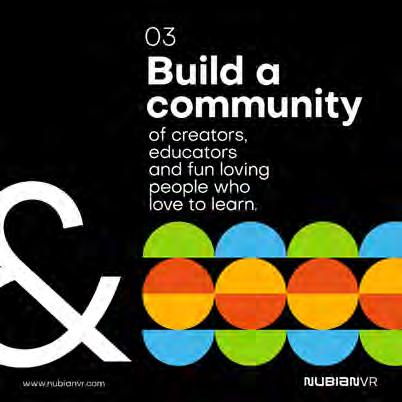
I’m in a couple of groups. In 2020, we ran a hackathon that was supported by Imisi 3D and Facebook , and it helped us connect with other XR creators here in Ghana. This is one of the XR communities we have an association with. There are other VR companies here in Ghana; ReluVR , and my co-founder of NubianVR, Jonathan Dotse, has gone ahead to create Afro Cyberpunk . So that’s a network of XR creators that we are associated with on the continent. Developers and gamers have a lot of groups, and some people have an interest in VR. I think there’s a VR Whatsapp group in Ghana. Nothing formalised, but it’s the best place to start if you want to talk about or understand VR.
Having a community is very important. It makes it easier for people who have similar interests to have a base where they can go crazy and wild. It’s not good to be isolated. What the community does is that it causes a ripple effect so that even the newbies can feel seen and heard.
Because of access to the community, there are a lot of people that reach out to us whenever they need help with a project or just building an XR solution. It would have been much harder for the students if they were unable to reach out to us. Being in a formal community also makes it easier for people to update their skills and share ideas. This was why the 2020 hackathon provided good visibility for XR creators. And it’s
also good to see organisations like Imisi 3D, whose main work is largely around building this community.
When we were creating our first 360 video, Big World Cinema backed us. During the African Futures Festival in 2015, they created a workshop for creators across the continent to come over to learn how to create VR solutions. That was the first time I got to use the Gear VR. That was also the point where we generated ideas for the workflow for creating content outside of 360 videos. The community is relevant to the growth of the XR industry.
Do you think there’s an accurate representation of the African XR creator in the global space?Community first. Image courtesy of Nubian VR.
It’s been a multifold experience. Although we were supported by the UNICEF Innovation Fund , most of our projects have been self-funded. Last year, we decided that we were going to change the structure of the company to move it forward. Previously, we were married to the VR space and VR for education, it was a narrow market. For now, VR for education is research-based, and it will take a while before we make profit from it. Research needs to be done to know the health risks. For instance, what are the health risks associated with the prolonged use of VR for young children? You know, some questions need to be answered before we can move forward.
We came up with a different approach to it and set up the Nubian Foundation as an offshoot of NubianVR. So the foundation
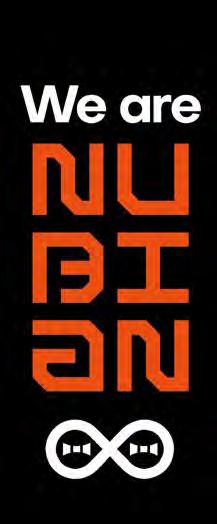
is committed to education, while NubianVR is an interactive products and games company. Funding the foundation has been a lot easier because we get a lot of support from organisations. As I mentioned, we have the Ministry of Education and UNICEF in Ghana funding interactive technology that could be used for education. They have also expressed interest in supporting VR solutions, but we had to put it to them that it should be research-focused as opposed to having a product at the end of the day. At NubianVR we are on a different path and, this year, we will be launching a digital storybook for kids. This does not mean that our products are education-focused, what we’re pursuing is revenue. So until we get more traction which would open doors for the investments that we need, our projects have just been self-funded.
If you get access to funding, do you have a plan for what you’d like to do with it?
That would be dependent on several things. If the reception we get from the audience meets our expectations when we launch the interactive storybook, the next stage will be to invest in content creation. Our goal is to create and sell catalogues of storybooks and use the revenue to invest in VR solutions. The longterm goal is unlocking the market potential for what we call, Digital Twin . Essentially, Digital Twin is the concept of virtualizing physical spaces. For instance, virtualizing a refinery in an oil plant, or a solar
power plant somewhere in the Sahara Desert. This is a tough region to access and sending an engineer over there to do a diagnostic check of the equipment will cost thousands of dollars. If it is possible to have a virtual representation of the plant, can remote diagnostics be done if anything goes wrong? Yeah, this is the space we see ourselves going into, and it will be capital intensive. Our pockets are not deep enough to support the research to start building prototypes.
I’ve talked about the high cost of equipment, like shipping headsets from the US. There should be policies that support tax exemptions on XR products. I believe it will provide the most encouraging atmosphere for people in this space. There needs to be an understanding of the value of XR products. Sure, it sounds like rocket science, or very futuristic. However, we have relied on information from the Internet for so long, and I believe we need to create a thriving community of creators that can come up with original ideas. We must not miss the opportunity to innovate in this space.
Like it or not, this is computing for the next century. It is what science fiction predicted for as far back as I can remember. So policies that encourage the community would be highly welcomed.
Africans have withstood a lot of turbulence in this space, from acquiring headsets to finding opportunities for their work. Now we should be thinking of creating indigenous solutions. I believe the big tech companies in the industry can come into the market to help teams that are already working on this kind of growth.


From your perspective, what can policymakers do to support the XR industry in Africa?
In the short term, Facebook’s announcement has brought the whole idea of the Metaverse to the fore. It is a huge encouragement to have lots of talents developing In Africa. Everyone from UI/UX to web and geo developers, I mean they are all extending their skills towards the emergence of ‘The Metaverse’. So the future will see more human capital developing in this space. You can see from the Oculus Quest Christmas sales that more people are investing in the hardware. Next year we can expect that those people investing in the hardware will start to create and experiment.
In the next ten years, from my perspective, a lot more will be happening. VR and XR devices will be cheaper for one. Also, people will start to appreciate it because the experience is more elevated and not like what you have with the computer and smartphone. Information condensation allows us to do much more with VR. So, in ten years, it will be clear that VR is not a fad. Already, a lot of people are complaining about disengagement in online learning and stuff. All that will change when
you add the element of presence that VR promises.
Let’s say the richest kid in the fanciest private school in Ghana has the same access to technology as some other kid in a poor region. Content by that time will be well understood, and people will find educational material in VR more enjoyable.
Imagine that, instead of having the teacher standing in front of the classroom with poorly drawn diagrams of the solar system on the board, students will get the chance to take a tour of the solar system. The potential for creating different materials to transform learning speed into an emotional connection is great. But we have to consider a lot of things before we get there, especially for the children. Will they suffer from information overload? What does a safe VR space look like for a ten-year-old child? What kind of content should they be consuming?
We also have to consider the psychological effect on those that will be using the space in the next ten years.
The potential for creating different materials to transform learning speed into an emotional connection is great.
I think I have hinted at how it would be for us. We want to build a thriving business in interactive technology, within the next one to three years, then pump the revenue from it to explore more expensive reaches of VR. I mentioned the Digital Twins also. We are highly invested in that space. We also have our concerns about the educational space and how VR content can impact it. We are looking at merging brick and mortar institutions with the virtual space. So on one end, NubianVR is committed to exploring revenue opportunities. While Nubian Foundation, on the other end, prioritises strong educational products or models in the XR space.
Is there anything more you’d like to say about being an XR creator and the XR industry?
For us, we’ve been in this space for a while and it was lonely. We had just a few friends like Imisi 3D and other organisations in this space. To see more people taking it seriously is so encouraging. We are eagerly looking forward to seeing how the technology evolves in the next ten years; in the next 100 years.
As an XR creator in Ghana, it feels a little empowering to be in this space. You know this technology is ammunition anywhere in the world. African creators should try to contribute as much as they know because everybody’s growing and learning. The experts are growing as the industry is growing. An expert
may be anybody who has a unique insight into how things can be done even if they have one or two years of experience. The most important thing is that there is a tangible growth of talents from the continent. I look forward to this ecosystem and believe that it will grow.
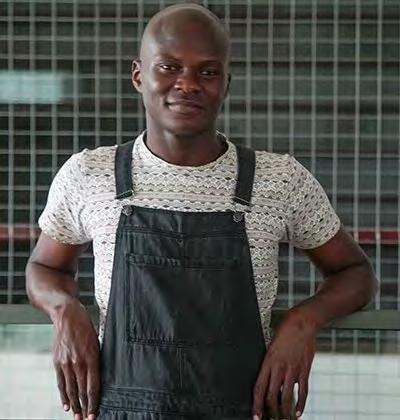
What are the goals and targets of NubianVR in the future you talked about?Kabiru Seidu Image courtesy of Nubian VR.
Laurel Gbenafa is a software developer who has been working in video games/VR development for over seven years. Apart from managing his own agency, Laurel also works occasionally as a project consultant or researcher on other freelance projects. Over the course of his career, he has been a part of several impactful solutions including a house virtual tour app for people house hunting remotely, and a VR patient platform for medical students to practise specific skills before working with live patients. In this feature, Laurel shares his experience working in VR, the challenges and successes he has faced, and what he looks forward to in terms of support and regulations that will grow the VR space.
It started with a passion for video games. I’ve always been immersed in video games and my father quickly noticed this obsession and used it to spur me to aim for good grades in school. So, the more I did well in school, the more video games I got.
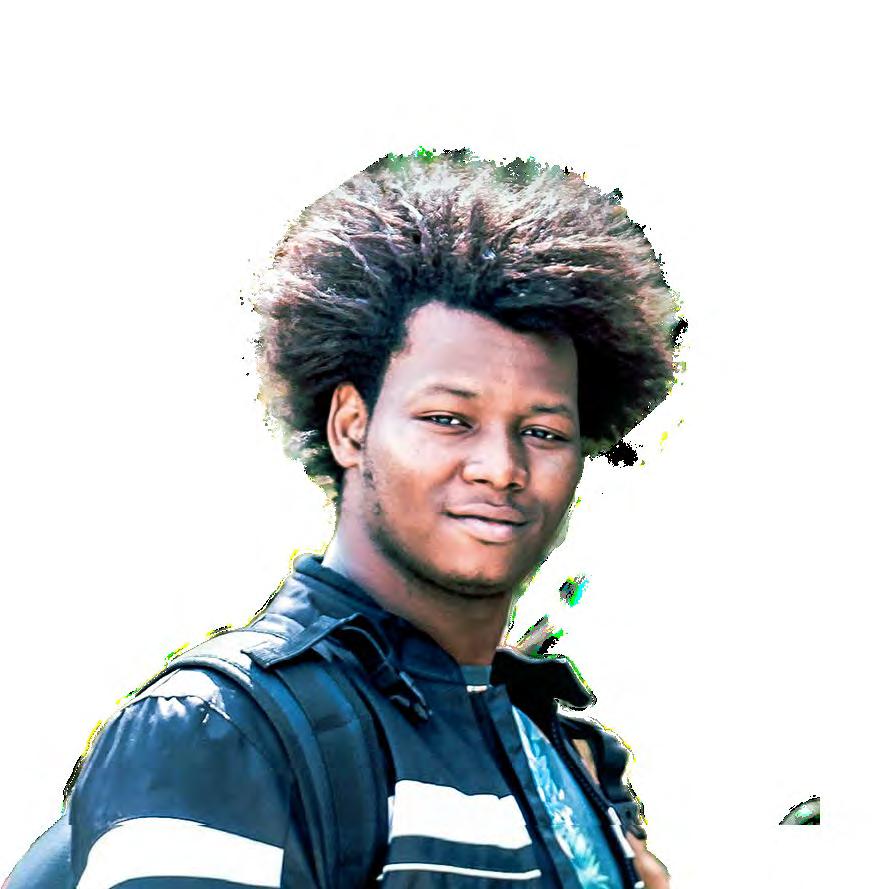
This continued till I was about 15 or 16 when I finally thought to myself: “How is a video game built?” To answer this question, I did a bit of research on how to make games, how game engines work, and before I knew it, I got into programming. Since there was no game development school in Senegal, I studied software engineering at university. Not only that, I have also been doing a lot of self-learning: watching tutorials, looking at other people’s work, hanging around experts from the industry, travelling around the world and working on a few projects here and there.
I remember the first set of projects I worked on was before university, and they involved me tinkering with things, trying to figure out what worked and what didn’t. These experiences turned out to be something I could leverage several years later.
From being a game developer, you transitioned to XR, how did that happen, and can you share some XR projects you’ve been involved in?
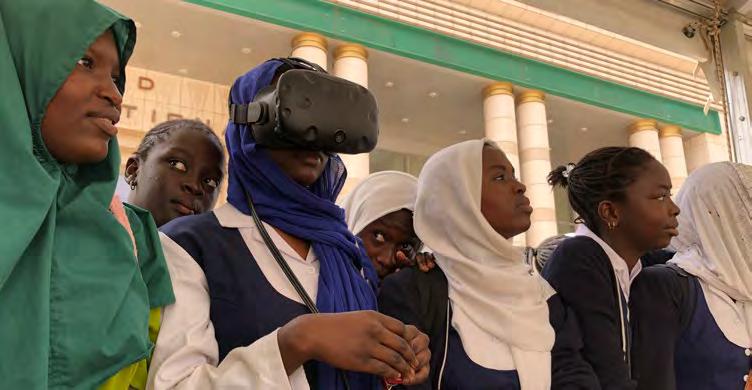
I mentioned hanging around experts earlier as part of how I learnt game development, and venturing into VR was similar. I was in my first year in university and there were these talk sessions I used to attend.
One day, someone brought a Google Cardboard to the session and the experience was amazing! Imagine going from only seeing in front of you to having an immersion experience unlike any you’ve ever felt before. The seeds were sown! I later travelled with a friend to Belgium for a hackathon, and while touring a tech shop, we stumbled on a type of VR headset which we bought. Back in our hotel room, we tried many things, and it was different from the cardboard, everything was smoother. It was at that point that I decided to go into VR.
Being an Otaku, the first VR project I worked on was an app that allowed me to read my manga scans in a Japanese home setting, with a tatami, halfclosed windows, etc. Subsequently, I have worked on other projects, one of which was a remote visit VR app that was part of a hackathon. The idea for the hackathon came from the challenge I experienced moving houses.
Usually, when searching for an apartment, you contact an agent who arranges a tour of houses, and charges you each time you go on a tour irrespective of whether you find a house you like or not and so on. Then there’s the number of hours you spend visiting these locations. So, when my friend and I were looking for a house, we realised that we could
make the process much better with a VR app where clients could tour multiple locations from their phone or from a housing agent’s office.
That was our brief, and we executed it by mapping about five houses in 360 and building a VR app for each. The app included sounds, for example, one of the apartments was in front of the sea, and while it’s good enough to say that it’s in front of the sea, if somebody is to visit from the opposite side of a city, it would be good to hear beforehand, how close the house is to the sea. Is it noisy? Peaceful? Or is it something that is just not liveable? We also included pictures of the houses, including a tour of the neighbourhood, and we added as much information that could help people decide whether they were interested in leasing or not.
People were like “Oh, this is really ambitious but you guys have to ensure you have something to show at the end of the day, because it’s just three days.” Fortunately, we were able to finish. We built both an app that could be viewed from the phone, and a web version that could be viewed from a real estate agency. We came second place in the hackathon!
Which of your projects would you regard as most significant or impactful?
That would be the virtual education systems - VR Patient, the medical simulation I worked on. Beyond being technical, it’s a significant solution that allows medical personnel to practise life saving skills on a regular basis without limitations, making them ready for real-life situations, reducing errors and improving responses.

Essentially, I like it because it makes learning interactive as opposed to trying to cram a book day and night. This will make medical students more ready and interested in saving lives.
Every field has its tools, that said, what are the XR tools that make your work possible?
Generally, when it comes to VR, you need to have a nice environment, especially in 3D. Otherwise, when the environment is not good enough it clashes with the experience. You’re not really immersed and your brain spends more time trying to look for what is wrong.
Bringing it down to myself now, I have a nice blend of software and hardware I use for my work. In terms of software, I’m a Unitycertified trainer, Unity-certified 3D artist and certified game associate. I use Unity 3D for building content, I also use Unreal Engine , sometimes
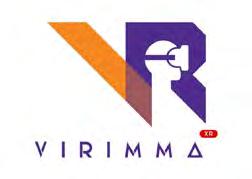
I use Blender for authoring and 3D creation and a bunch of other things like sculpting. I also use ZBrush and Substance Painter
For hardware, I have a motion sensor capture and six Kinects which I can mount together and extract motion from. I also have a Vive with trackers, an Oculus Quest , a PICO 3 , a Galaxy Gear – which is a little bit old, a Google Pixel headset, a regular Oculus, a cardboard and the hobo VR. I plan on getting the Oculus Quest 2 soon. For AR, I use an iPad and I have a few headsets and a good computer.
VR Patient, the medical simulation I worked on. Beyond being technical, it’s a significant solution that allows medical personnel to practise life saving skills on a regular basis without limitations, making them ready for reallife situations, reducing errors and improving responses.
You have quite the equipment cache. How easy was it to acquire it and what other challenges have you faced since breaking into Senegal’s XR space?
It has definitely not been easy acquiring this equipment, but I have been ingenious in sourcing them. Though not optimal, it works for me. That being said, it is not cashwise to purchase every single piece of equipment just to test something or know if something is relevant for your project. You will end up spending a lot of money if you do that. What would have been great is to have a means to access some tools to try them out and see if they will solve your problem.
A second challenge is getting people with the understanding and skill set I need for projects. This ends up increasing the time needed to complete a project. What I have done to solve that challenge is to educate them to the level needed to work on major projects. Because if you say, “Okay, I need to build this project, and I need a 3D artist,” you’re probably not going to find one. Instead you will find somebody that is passionate about 3D art, and then you have to train them.
Have you struggled with people accepting or understanding the work you do as a game/XR developer? How do you handle such situations if or when they occur?
I think most people now know what VR is about, but the bulk of the misunderstandings I get is from clients coming and wanting things, but not measuring how much work and how much preparation it takes to go from an idea to something that actually works, and not the prototype they can just brag about. I’ve had many clients come to me
like, “Hey, we need this. It needs to be done in two weeks,” when they don’t even have a brief. Yet they expect a finished product that should take a year or two, to be ready in two weeks! Initially, we tried to meet these deadlines, but we later realised that we were shooting ourselves in the foot and we may not always have the bandwidth to take them on.
Have you struggled with people accepting or understanding the work you do as a game/XR developer? How do you handle such situations if or when they occur?

I think most people now know what VR is about, but the bulk of the misunderstandings I get is from clients coming and wanting things, but not measuring how much work and how much preparation it takes to go from an idea to something that actually works, and not the prototype they can just brag about.
I’ve had many clients come to me like, “Hey, we need this. It needs to be done in two weeks,” when they don’t even have a brief. Yet they expect a finished product that should take a year or two, to be ready in two weeks! Initially, we tried to meet these deadlines, but we later realised that we were shooting ourselves in the foot and we may not always have the bandwidth to take them on.a
How do you fund your work? And if you were to get access to more funding, what would you do with it?
Besides hackathons and winning some competitions, most of everything I have in terms of equipment was personally funded. Since there’s nobody you can turn to for help.
If I get more funding now it will be channelled to key fields that VR can have a profound impact on. In my head, I think it’s not just about creating VR content for just about anything. We have to be able to focus on the things we want to highlight the most. As an African, I think something that will spotlight African culture and history through storytelling.

People are already curious to learn about our culture, so much so they travel to the continent. Now with AR, we can make the experience of visiting our past or telling our stories more engaging, reach more people and dispel the misconceptions they may have about Africa.
How do you find clients and what does your client list look like in terms of geographical spread?
I have more international clients, some I got online, and most were referred to me from previous clients. Also, I prefer to work with long-term clients.
A major change the government can champion is to convince more people to bet on tech and give immersive tech a chance.Developing for mixed applications. Images courtesy of Laurel Gbenafa.
Businesses do not exist in a vacuum and this applies to XR too. In your opinion, what kind of regulations/ policies will make XR thrive in Senegal?
A major change the government can champion is to convince more people to bet on tech and give immersive tech a chance. Due to some past tech projects that were mismanaged, most Senegalese would rather stick to what they know, since it works. But if the government can support us in the XR space such that we are successful, we will not have to keep convincing anyone that the tech we’re trying to promote is actually important. The best way to get people’s buy-in is to show by example.
One year and ten years from now, where do you see XR globally?
In the next one year, I think the focus will be on making the hardware better. We have made progress in some areas but I think there’s still room for hardware improvement. I see a tech rush with people improving, launching new VR headsets with new features. Creators will also be trying new things, trying to add new immersion or exploring new immersion-like possibilities, and new content creation possibilities.
Ten years from now, I see VR being used in almost everything that needs to be technical, like teaching somebody how to handle a specific thing, or a specific engine, or a tool or learning and mastering a skill set, or learning how to create things. I see it being used a lot in those fields first, and then a lot in entertainment like games, stories, 3D movies, interactive movies, etc. A third field I foresee VR being used in, is collaborative remote work where people can work on projects at the same time and for meetings.
What do you think tech giants like Meta and Apple should do to support XR growth in Africa?
For the tech giants, it would be great if they could help us to reach more influential people who are interested in our work and also help us to get more funding.
I think those are major enablers for other VR developers like me to build a success story that can then fuel and trigger other successes later on. I think at the core, we have to succeed in disrupting at least something, and getting the backing of these tech companies will go a long way.
Ten years from now, I see VR being used in almost everything that needs to be technical, like teaching somebody how to handle a specific thing, or a specific engine, or a tool or learning and mastering a skill set, or learning how to create things. I see it being used a lot in those fields first, and then a lot in entertainment like games, stories, 3D movies, interactive movies, etc. A third field I foresee VR being used in, is collaborative remote work where people can work on projects at the same time and for meetings.
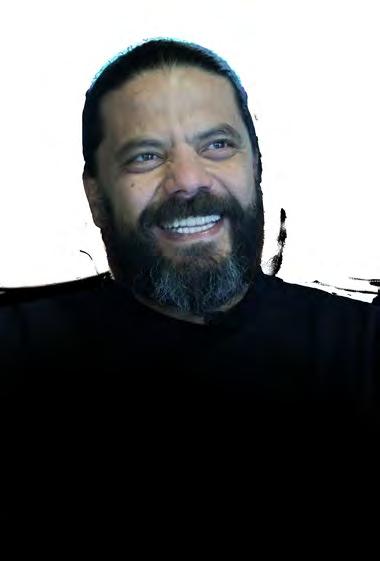
5d VR
Maged Farrag is the creative and Managing Director of 5d VR. He has been working in tech for more than 26 years. Always fascinated by bleeding edge technology, Maged, a graduate of mechanical engineering, started out working with multimedia interactive touchscreen applications, the emerging tech of the time as he likes to describe it. In 2011, he founded a joint venture with a Danish gaming company, which eventually led him into Augmented Reality. In 2013, his company worked on their first Virtual Reality project and have not looked back since.
This spotlight looks at 5d VR’s work, how they started the immersive section of the Cairo film festival and the challenges they faced.
It was with the DK 2. When we first got our hands on it, they had this intro -Three degrees of freedom experience. Though the quality was horrible compared to what we have today, it was quite impressive at the time.
We created our first AR experience in 2011 and it was a multimarker AR dance and football game. Our first VR experience was for a big real estate project in 2013. At the time, I didn’t really know much about VR, more than just watching videos online and just being impressed and waiting for the right moment to actually start developing our own experiences.
So, when I got the call requesting for it, I said yes, and I came back to my team. The good thing is that my team was already into game development and we had done some Augmented Reality. Venturing into Virtual Reality was not that challenging, but we used Crytek at the beginning then when DK 2 came out they didn’t release the drivers for Crytek so we had to redo everything again on Unreal . It was quite painful at the time, but at least we learned a lot.
Well technically speaking we are exploring the horizontal landscape of the technology, we do 3D mapping, holograms and all sorts of interactive media content. It’s more or less some type of extended reality when we do 3D mapping or hologram, it’s like Augmented Reality without a headset. It feels almost the same. We do a lot of Kinect applications as well; whenever we have a chance we try new technologies.
What did you set out to achieve when you first started out in XR?
Apparently, I think it’s maybe something in my DNA that I’m always seeking something new. Even now we’re considering and thinking, we’re done with VR, what’s next? The Metaverse, NFTs or whatever is coming out there. Since I founded my first startup, it’s like I’ve been on a mission more or less to always seek new technologies and new solutions and try to see how they make sense.
Right after graduation, I had a friend who graduated one year earlier, and he got into touchscreens and multimedia at the time. He convinced me that I should join him. That was the start of this whole journey. I relied on whatever materials I could get my hands on, to learn and see about what worked and what didn’t. But I believe the most learning we got actually was on-the-job.
You moved from multimedia to XR. Between 1994 and 2013 when you started to do XR work, what did you do in that space of time?
When we started with multimedia, it was pre-Internet. We didn’t even have CD ROMs. We had to rely on information kiosks to invent a solution. So we’d do a multimedia solution and put that on an information kiosk using the touchscreen, and it was quite innovative at the time. People did not have all the smartphones out there. So just using a touchscreen was quite magical.
I compare that very much to VR/AR and the whole immersive computing space right now. Multimedia back then was like the emerging tech and everybody was excited about using it for retail, education, events, and as you can see now it is all over the place. Everything is based on using multimedia more or less.
We mainly develop enterprise solutions for marketing, events and training. Our customers are businesses, ranging from small, medium enterprises to large fortune 500 companies and sometimes, we also deal with governments. Recently, we’ve done a bit of work on cultural heritage and how to use the technology to document and disseminate information about cultural heritage which is very common for what I used to do with multimedia.
I compare that very much to VR/ AR and the whole immersive computing space right now. Multimedia back then was like the emerging tech and everybody was excited about using it for retail, education, events, and as you can see now it is all over the place. Everything is based on using multimedia more or less.

Are you heavy on XR or a model like the distribution of the work you do?
The distribution of the work when it’s for an event, we supply our own hardware and we can put the experience up quickly and people just use it. Most of the AR solutions we’re doing at the moment are web-based. It’s the simplest. The most reach you can get with the distribution is in WebAR. We have many projects actually running now for different WebAR experiences.
What do you think the increase in local clients indicates for XR locally?
What’s the size of your team at 5D VR?
We have almost 25 full-time employees, but we have an extended network of partners and companies we use whenever we have an overload of work or things that need to be done within a short while.
What’s the geographical distribution of your clients?
When we officially started 5D VR in 2016, 90% of our work was for clients abroad, mainly in the UK and the gulf UAE. Last year, it was almost 60% abroad and 40% for local clients. At the moment we have clients from the UK, Denmark, the Gulf states basically UAE. So yeah, we’re proud to have more or less like we say a global footprint, we have delivered different projects technically speaking all over the world.
Well, there’s a growing interest in the local markets. Maybe the local companies are a bit afraid to try new things. Some of them are always looking for the wow factor and creating this kind of impression so that they have the guts to actually try something new. But most of the time, they want to see if it works, so they want somebody to try it first before they start using it.
Every other day, I would say I receive a phone call from somebody who’s interested in the concept of the Metaverse, some high ranking government agencies want to use technology in training, which is coming a bit late, because we’ve been using VR for training for a long time now, but it’s good that they realised that it works and it’s effective, and it’s actually more cost effective. So there’s definitely a growing interest. That is, I would say, a reflection of the growing awareness of the technology and the effectiveness of the different solutions.
Every other day, I would say I receive a phone call from somebody who’s interested in the concept of the Metaverse, some high ranking government agencies want to use technology in training, which is coming a bit late, because we’ve been using VR for training for a long time now, but it’s good that they realised that it works and it’s effective, and it’s actually more cost effective. So there’s definitely a growing interest.
Well, there’s a growing interest in local markets. Maybe local companies were a bit afraid to try new things. Still some of them are always looking for the wow factor and creating this kind of impression that they have the guts to actually try something new. But most of the time, they want to see if it works, so they want someone to try it first before they start using it. Every other day
I would say I received a phone call from someone who’s interested in the concept of the Metaverse, some high ranking government agencies want to use technology in training, which is coming a bit late, because we’ve been using VR for training for a long time now, but it’s good that they realised that it works and it’s effective, and it’s actually more cost effective. So there’s definitely a growing interest. That is, I would say, a reflection of the growing awareness of the technology and the effectiveness of the different solutions.
What is the most impactful XR project you’ve worked on?
There have been a few of them. I have developed a passion for cultural heritage projects, because I think there’s much more than the commercial value of doing a 3D scan for a timeless piece that will be put on AR or VR or even just online. You cannot put numbers on it. So for me, I think the cultural heritage projects are the ones I am proud of the most. We’re currently working with the museums of the
Milano Expo 2015 event, XR technology gave everyone the opportunity to taste and learn about Egypt’s best dishes, while discovering the best of the agri-food and gastronomic traditions.
Images courtesy of 5d VR.
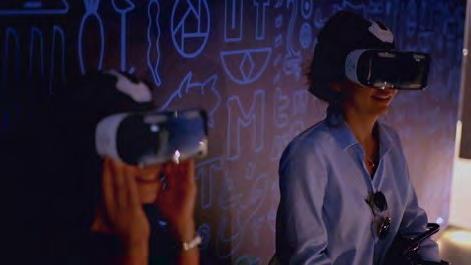

presidency of Egypt. I think it will take some time because in that project, we’re actually 3D scanning a lot of pieces and some shooting on a turntable or gigapixel . We’re also doing a lot of actual capturing of the items, not to mention putting that in an interactive environment.
Our mission is to actually make that available on the web and on a mobile app. So that’s definitely a project I’m totally proud of. Also, we did the Egyptian pavilion during the World Expo in Milan in 2015. It was
an extremely challenging project and we had so little time to execute the whole pavilion from start to finish. We had no option but to seek different partners and try to distribute the work among a lot of people so it could be done on time.
We actually managed to get nine different companies from Hungary, Ukraine, Australia, and three companies from Egypt, and we got all the people working together under our direction to deliver our vision. It was quite impressive.
What do you think the increase in local clients indicates about the XR ecosystem?
All kinds of equipment we can get our hands on. So like we say we’re technology agnostic . We’ve been using headsets all the way from Google cardboards to Microsoft HoloLens Two , so we deliver across any kind of device or hardware, even if we don’t have the device at hand.
I remember the first HoloLens project we did. We did it totally without even seeing the HoloLens . We ran some emulations, had the client on the other end testing things, and we managed to deliver. Even with the lack of hardware availability, there’s still a way to work around that and get things done.
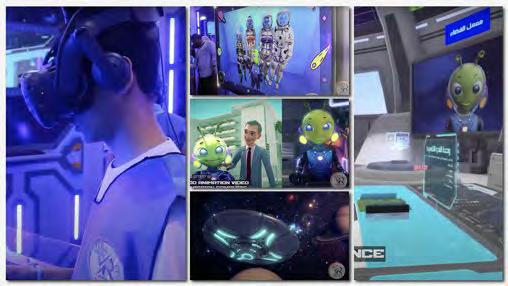
With the hardware, especially at the beginning, we used to pay a lot of customs and a lot of taxes. Sometimes when we’re getting a headset for the wireless transmission, for example, it could take three to four months, just going through different government authorities to get clearance. So, this is the kind of hiccup we can face especially with the hardware. But again I get some hardware with me from travelling, when we have no other option we just order it and pay the taxes and just wait. So it’s always depending on the time we’re making the purchase, the time we need the hardware, and how much time we have, how we can make it accessible.
For software we use Unity and Unreal for development. We also use all kinds of WebAR. Most of the available WebAR solutions, whether it’s 8thWall, ZapWorks or XR Plus , we’ve used all of them. That’s on the development side. On the art side, we use 3Ds max, ZBrush, you know all the tools for creating 3D content. Then for the cinematic or the video production part, we use Adobe Premiere as well as others from the whole Adobe suite like, After Effects whenever you need to do post production for example.
On the technical side, what equipment do you currently use in development?
How easy was it to get hardware and what kind of problems did you encounter?
I remember the first HoloLens project that we did. We did it totally without even seeing the HoloLens.
We ran some tests, had the client on the other end testing things, and we managed to deliver. Even with the lack of hardware availability, there’s still a way to work around that and get things done
It’s a lot easier now than when I started with AR, because it wasn’t that common. However because we use the same game engines and development tools, it is easier as there’s a growing population of developers in the game community in Egypt. Then we have our team, the heads of the different teams are quite capable of getting people on board, orienting them on our pipelines and how to work, and actually giving them the required training for how we do things
I believe that now in Egypt, there’s a good number of companies and startups that deliver across the spectrum of extended reality at large for different solutions. From real estate solutions to virtual tours like Matterport (there’s a lot of these), to even industrial applications and solutions and at least a couple of startups who are doing their applications for medical purposes. So there is now definitely a growing community of artists and developers with passion for the technology.
What are some of the big challenges you faced trying to build XR or being an XR creator in Africa?
Well, at the time we started venturing into it, the hardware was not available, people did not know the tools. So everything was very challenging. But at the moment, I would say the challenge will be access to the market because we have the capacity to deliver a wide range of services. Also to some extent, I would say the awareness and the general knowledge of the clients, as they sometimes get the wrong information. You see something that’s totally VFX and they say okay, we want a hologram like that, but it’s not a hologram. This becomes a challenge, especially if people have some idea in their head and they don’t want to change it.
Do you think they like what having a community brings into this space?
Well, that community is like a building block. If you don’t have the right community, nothing can actually flourish and grow. We’re sharing resources, sometimes we rely on each other like if I’m short on a headset I can get it from a friend’s company or someone who can help me with it and vice versa. The community is more or less about being there for each other and thriving to do better. So, having a community is a very strong component and aspect of growing any industry. Since we started creating the Africa XR hackathon, this has made us feel part of an even bigger community across the continent.
How easy was it for you, getting people with the right skill set to work with?
What’s the XR community like in Egypt? Do you have people within your space doing similar work with you that you can engage with?
In Europe, there might be VR studios that want to expand their team. So, we don’t have to deal with the clients, we deal with XR studios like ourselves. We partner with them and then we become an extension to their teams. This is how we get our projects in Europe mainly. There’s still many instances when we took
the clients firsthand. Usually, there’s an agency who’s providing a service, training or event for its clients and now they want to adopt VR or AR, so they come to us. We partner with them and it makes sense. And if everything goes as planned, it’s a win-win situation.
For the Cairo Film Festival , we did the VR section in 2018, which was the first time to do a VR section and in 2019. In 2020, with COVID, everything had to be put on hold when it came to the VR section. Our mandate for the festival was to screen various experiences, and get speakers to

create a whole VR section; but our internal mandate was to actually make the technology accessible to people. So film makers as well as the general audience could try different AR and VR experiences. That’s why we made it totally for free, and we had a big hall that we constructed
in the Opera House and we were always selecting award winning experiences that we would screen. It was a very good exercise and we got very positive feedback from all the people who would just go and experience VR, with most of them experiencing it for the first time.
Well, that’s a tricky question, because the Metaverse is decentralised. What kind of role will the government play? It’s still under discussion and there’s a lot of debate going on about that. I attended a couple of workshops for a government entity who’s interested to know about how they can venture into the Metaverse and how they can support it. So one thing to start with, is to actually make a report like the one that you’re doing across Africa, but we need a report about the industry in Egypt to actually get an in-depth analysis of the market. I feel policymakers can support the creators by putting in whatever programmes for training, creating incentives, programmes for reducing taxes, and for customs so we can get equipment at least at the same price they’re sold in the US or Europe. Things like that will help to actually boost the whole ecosystem.
How do you communicate with people without prior knowledge of the XR space especially within Africa?
Well, the most convincing way especially in our industry is show and tell. You’ll have to show them, okay, you don’t know about having so many XR startups in Africa. So just show them that they are out there and in our work you have to see it. Awareness is important so I make many talks and presentations to show the audience different use cases in Virtual Reality, Augmented Reality and Mixed Reality.
What role should big tech play in the XR space locally and internationally?
Well, let’s be frank, all the big players’ main concern is to own the whole thing, which will never happen because Meta is working on their own version of the Metaverse , Microsoft is doing Mesh , and Nvidia is doing Omniverse . So I think it’s more of a race right now where they’re concerned more about gaining the most market share or owning the whole thing. I would say that they would be concerned and willing to support creators from European countries or the US because they know the economic scale. Maybe they don’t trust the same could happen in Africa. So we just have to prove them wrong. If I were to ask the government to do something about it, I would say to put some pressure on these tycoons to actually just start a small initiative, even if it’s something about training or technology transfer.
As an XR creator, what additional thing would you like to say?
Well, it’s an interesting space to be in for sure. Whatever we are creating now will have a strong long term impact because while there’s still a big gap between the XR industry in Africa and abroad, we are proving our potential and paving the way. I think nothing can happen without what we’re all doing as XR creators in Africa by making the solutions and the technology accessible and available for people to understand, try, and make use of.
What are some of your projections for XR globally, long term and short term?
In a couple of years I think AR glasses or AR headsets will become more common. I know there’s been a rumour every year that Apple is going to make their headsets. I believe this will have a massive impact on the market like when they did the smartphone.
They will create the whole ecosystem around it and it will be very powerful. However it’s not only about Apple, but having this kind of technology accessible to the consumers will create a great impact to the market and to the industry at large. So just having more headsets out there, and the mixed reality with 5G, with all of these elements just being put together will create even more new use cases than we can’t think of at the moment.
I think in the short term, this will be more or less the reality. I also think that in the short term, we will understand more, the full potential of the Metaverse, what can be done, what cannot be done, and what kind of problems are out there. That will help us to make things in a better way.
What kind of policies do you think should be put in place to support the XR space?
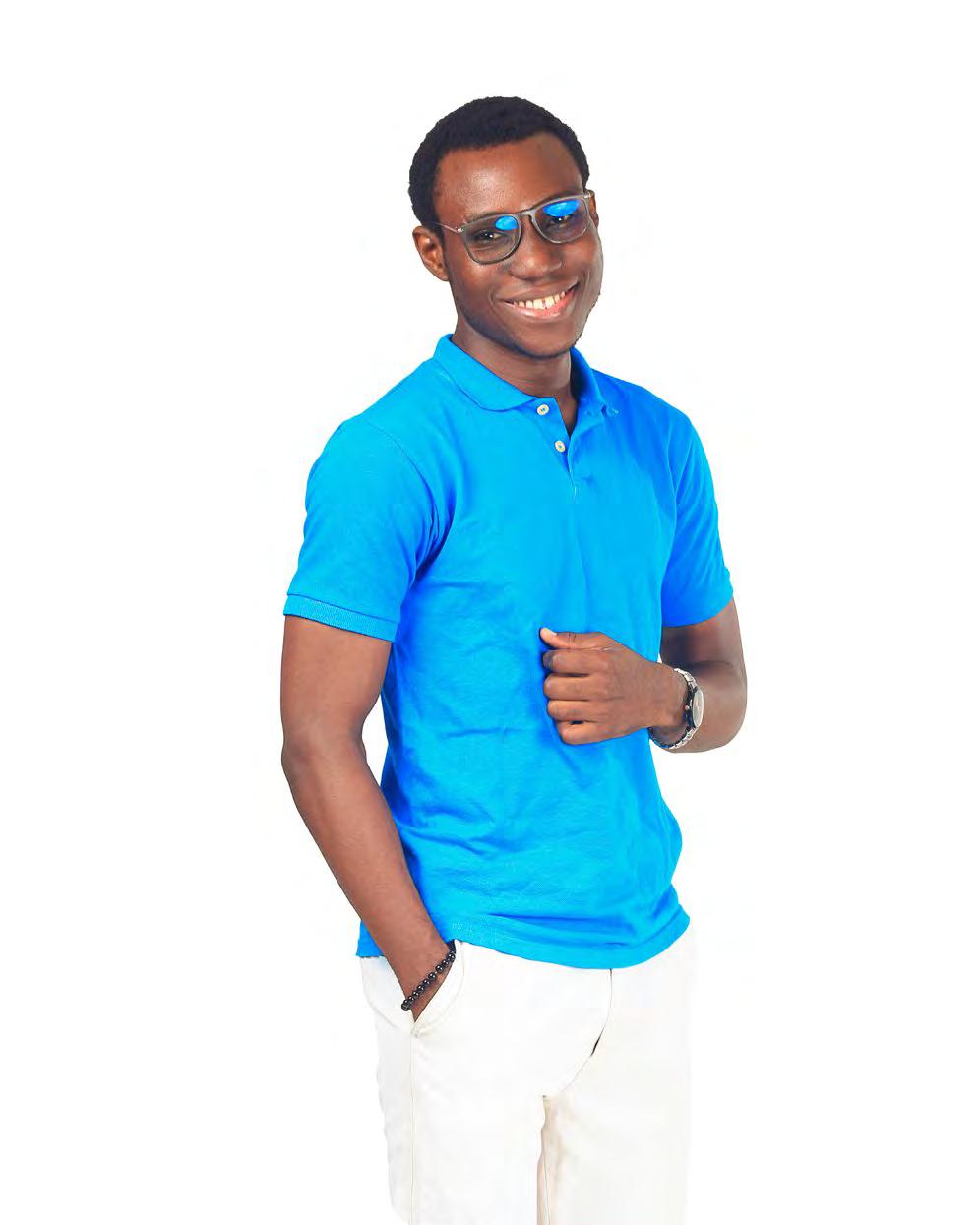
I started hearing about some technology called computer vision and at the time this meant nothing to me. Then I learnt about VR when I was learning computer vision. I love manga and anime. One of my favourites is called Sword Art Online. In it there is a VR experience where people just had to lay on the bed, wear a VR headset, and by saying the word links, they entered into a VR world. No controllers are required there, the brain does all the work. The immersion of Sword Art Online was a total full immersion. I began to ask myself if I could create an online game like that, and so I started learning VR. The technology was very interesting. You just have to wear a Google Cardboard and have a smartphone that has the gyroscopic sensor, then
But very rapidly, VR started annoying me because I had to wear a VR headset and they were very expensive at the time. Unlike today, where we have the Oculus Quest - which is still quite expensive. The VR headsets were not in Benin yet, so I ordered my first VR headsets from France through a
I could create some games and play with friends who would test them using my cardboard and cell phone. But the impact of 3D reality in front
of your eyes did not leave me, so I started looking for other programs to use. In the process, I came across AR. AR is very interesting. I used to say that with VR, you can go anywhere but with AR, you can make anywhere come to you. You don’t have to own a bunch of materials to test an Augmented Reality experience. You don’t have to buy a computer that has loads of high specifications. With the aid of Unity, I started developing AR experiences with Vuforia.
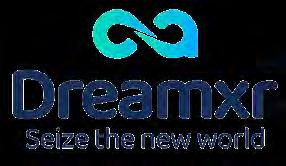
DreamXR was started in 2017 and I was a third year student at the time. The company was initially called IRL Laboratory (In Real Life). Our goal was to bring a lot of what we see in sci-fi movies and games to reality. We started with some applications that allowed you to send greeting cards by adding an AR experience.
DreamXR is a new way of seeing our dream, which is to make XR possible globally. Today, we do a lot of our jobs on webAR and webVR. We had to switch because too many people complained of having difficulties downloading large files, which was an issue we had when using Unity and Vuforia to build apps.
So we looked up some webAR things, webXR, web GL and stuff like ARGS, and started looking for a way to make a better experience. Since most peo ple had browsers, they didn’t need to install an app, but could access a link to an Augmented Reality experience and even Web VR experience.
Now, we are developing a platform called TempusXR . Tempus in Latin means ‘moment’. So you can devel op or create your Augmented Reality experience to last for a moment. It’s like a WordPress of Augmented Re ality.
The Tempus app has two parts. We have a Tempus studio where people
create their Augmented Reality expe rience. We have friends, some partic ular people, some big companies that are using them today. And we have the mobile app,which is in fact a web app. We convert in PWA, (progressive web apps), so people can have the two ap plications on the web and create their experience. Then they can share them in the TempusXR mobile app, and it will be more accessible to customers to get links to see your experience. That’s what we are doing today.
We are also proposing an API to help developers who want to use our solu tion for free without the need of the studio pads. But all the experiences are getting pushed to the mobile app.
What’s the size of your team?
We have eight people fully working at DreamXR. We have a full stack software developer, three web de velopers, two people who do 3D modelling and animation, and two mobile developers. So, to keep the balance, we have a project designer.
How do you recruit talent with the right skill set?
It’s very difficult. Until 2018, I can say I was the only one doing XR de velopments in Benin. When I was at university, I met a young boy who was very interested in XR. I started coaching him and then we became a team of three, my brother included. After that, it was difficult to get peo ple to join us. We did all the work by ourselves.
I decided to teach those who were interested in XR but didnt know how to get started. I later recruited some who were interested in working with us. Training your staff is very important if you want to get the best out of them.
How would you describe people’s reactions to XR and what you do?
In a country like Nigeria, XR might not have as low interest as it does in Benin. So you have to keep explain ing to people what XR is. Because when you say Virtual Reality, people just see games. They don’t see all the other things you can offer and I have to try very hard to make people who surround me everyday understand what Augmented and Virtual Reality are. In Africa for instance, and espe cially in Benin, I see that XR requires a little teaching and discovering.
How do you think people perceive the Metaverse?
For them the concept of the Metaverse is what they see online. They see it as a VR world where you need to put the headset on your head to enter into the Metaverse, en ter the virtual world and have some interaction. They are excited about having meetings in Virtual Reality using avatars and so on.
They see the Metaverse like a mar ket where they have to make the en terprise known to other people by selling virtual goods like NFT’s. They also see it like, just a VR world where people can get connected and play games. Everyone doesn’t understand what the Metaverse really is. Even I prefer to call it the Omniverse be cause it’s not just a VR World. I think the Metaverse will grow, and by growing, we’ll start to interact with 3D objects in our real life using AR glasses or a digital lens which you can put directly on your eyes. The Metaverse will become more than a VR experience.
In a country like Nigeria, XR might not have as low interest as it does in Benin. So you have to keep explaining to people what XR is. Because when you say Virtual Reality, people just see games. They don’t see all the other things you can offer and
I have to try very hard to make people who surround me everyday understand what
Augmented and Virtual Reality are. In Africa for instance, and especially in Benin, I see that XR requires a little teaching and discovering.
We use smartphones, Blender for 3D modelling and Cinema 4D. We most ly use Eframe and 3ds Max to create the 3D environments in the world. But to embed them in AR, we devel oped our own SDK which we call Tempus SDK to get the work done. So since we use WebAR and WebVR, our main technology here is HTML, CSS and JavaScript. We use Node Js and Vue, depending on the project at hand. We also have a VR headset and Google Cardboard.
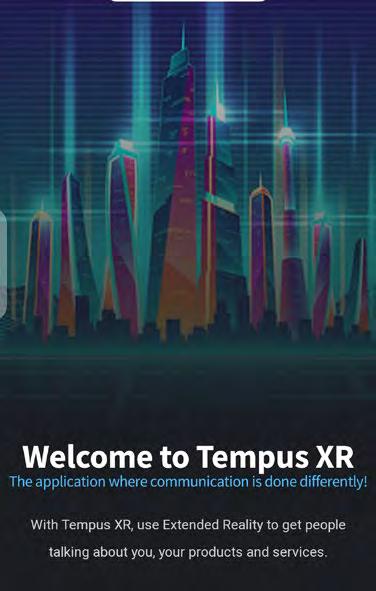
Two years ago, we came up with the idea of making prototype glass es. It was a vision in our head and we drew models. We want to put our Augmented Reality experience in the eyes of people. The prototype will embed a camera. We are looking for the camera which has the high est resolution and is small enough to be put on glasses. The glasses won’t be big, so people can wear them con veniently and it won’t feel heavy on their faces. So we delved into tech nologies like Arduino and Raspberry. We started with Arduino Nano, and we will add the Raspberry VPS, the C version with Bluetooth and Wi-Fi.
We are dreaming about a fully inde pendent Augmented Reality pair of glasses that can fit the size of the nat ural glasses you wear to cover your eyes from the sun or use for medi cal reasons. We want people who already wear glasses to switch from the Non-Augmented Reality glasses to ours without losing the medical prescription they have on their actu al glasses. We want the prototype to be done before the end of this year, but right now we don’t know how it will go.
What equipment does your team use in creating experiences?
Tell us about the project you’re working on?
What would you say are some of the biggest challenges you have faced?
The biggest challenge the company faces right now is getting good material. At the moment, we don’t have the financial resources to buy a good computer with good memory, good graphics card and good RAM.
We have a few customers who already use our services, but they don’t pay so well. We have to make compromises because we want our team to get accepted. We also want some big names to use our team before launching the mobile app for the people in Benin. So, finance is a very big challenge for us.
What are some of your thoughts on regulations and policies that governments and policymakers can make to support the growth of XR in Benin Republic?
That’s a very tricky question. The government here in Benin has been doing a lot in order to let small startups do technological things, Artificial Intelligence and Internet security amongst others.
So, for XR, there might be a need for them to create a great Virtual Reality centre in the big town here in Benin to enable people to experience it.
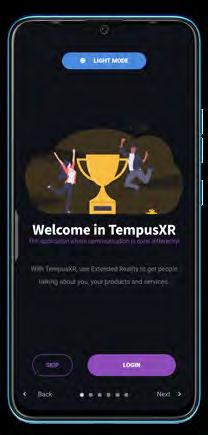
What about big tech companies? Is there any way you think they can also engage you as an African XR creator?
They have a lot of things they can do. They see Africa like the new ElDorado of technology, because we have many things we can do with our technology here in Africa to help solve people’s everyday issues.
Maybe they go into partnerships with some XR companies here in Africa. We can help them make the platform more affordable by creating some developer certificates.
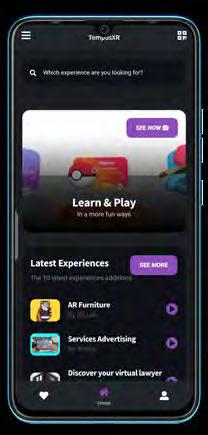
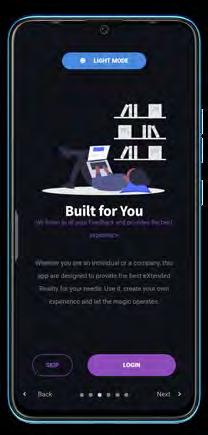
It’s all been self-funded.
First, would be to get a bigger place for our team to do more things. The second would be to get the tools we need to work in order to deliver faster. And we will create a VR centre near our new office to get people to discover what VR and AR are, though it will be a paid experience.
Technology is evolving every day, in web AR and web VR, and even in native AR and native VR. So working in this field and developing experiences for this field is very interesting, because you have to readapt yourself every day. I don’t love when things are status quo. I love things that move every day.

If you were able to get access to funding, what would you do with it?
Mbangiso “Baso” Mabaso is the Founder and Developer at Sisanda Tech. He started in 2017 intending to provide science learners in Africa access to a virtual science lab called Sisanda App Universe that will allow them to experiment anywhere and anytime. Baso graduated as an Electrical Engineer but only worked for a year as an electrical engineer because he fell in love with making video games. In 2019, Sisanda App Universe was named the Most Innovative Solution at the MTN Business App awards.
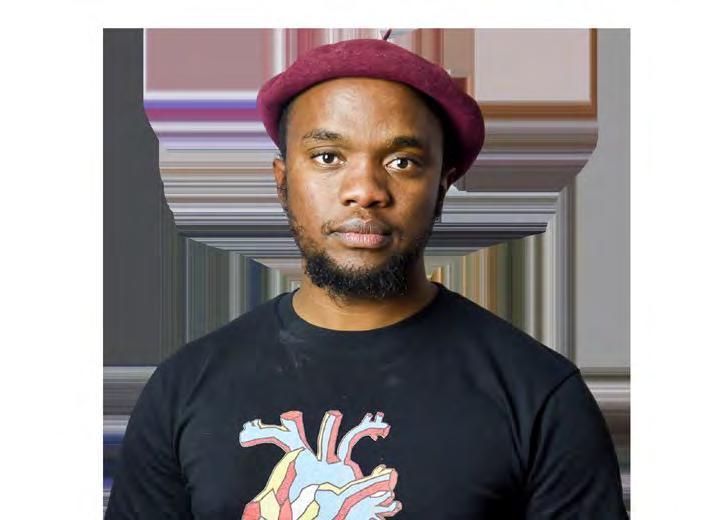
My introduction to XR came after I transitioned from making Games with Construct 2 to Unity. At that time, I was curious about finding a way to build a virtual science lab, so I got exposed to Google Cardboard which I thought was super cool. This led me to investigate augmented and virtual reality technology more, and I started building AR apps for playing cards using Vuforia. That app is now called Sisanda App Universe.
XR is a medium of possibilities. It excites me to think of the stories to be told through this medium. I have always looked at things and asked myself, “how can I enhance this space, how can it be magical, or how can I take this real-life experience and bring it into the virtual realm and amplify it even more?”. XR will make us live the Marvel Movie dreams. You can be anything in this medium.
I want to create more experiences that people can enjoy. Tell the stories through virtual worlds, characters, fashion, arts and music that haven’t been told before. I want to see people benefiting positively through my XR experiences.
How long have you been creating XR projects?
Creating XR Projects is as old as Sisanda Tech; I started in 2016 with a focus on building Sisanda App Universe - a virtual science laboratory for learners in South Africa. The app aimed to provide learners with a platform to explore their curiosity.
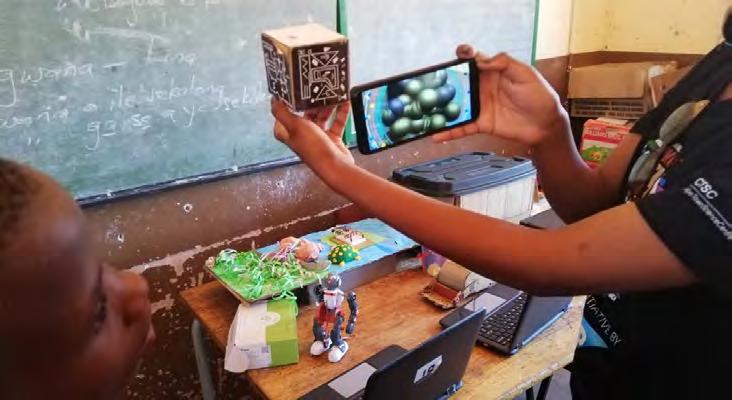
Currently, we have the right balance of AR and VR work. In AR, we mainly develop Sisanda App Universe; we also create Spark AR filters for clients or ourselves. VR developments came later; now we spend time creating virtual worlds and educational virtual reality experiences for clients. As they say, once you go VR, you might not come back, but I’m glad to be able to play with them both. Unfortunately, MR is still too expensive for us to experiment with.
What type of content do you create and why?
We started with a focus on augmented reality content to improve education in public schools. But we eventually expanded by creating virtual worlds, Instagram filters, and avatars. I love Amapiano, and we have created the first chesa nyama called HaMmabongi in the Metaverse, where avatars can gather around to listen to the bumpy Amapiano sounds. We expect to grow HaMmabongi to take Amapiano to the Metaverse. We were recently sponsored by Electric South, Twig and the British Council through a programme called Design Future Labs. The project aims to build solutions that promote sustainable fashion. We are working with the talented Fashion Designer Khumo Morojele to develop our prototype.
I want to create more experiences that people can enjoy. Tell the stories through virtual worlds, characters, fashion, arts and music that haven’t been told before. I want to see people benefiting positively through my XR experiences.Sisanda App Universe offers a variety of curriculum boosting AR solutions for South African learners. Image courtesy of Sisanda Technologies
What is your most significant XR project so far?
Sisanda App Universe won the Most Innovative Solution at the MTN Business App Awards. HaMmabongi - is a combination of passion and love of Amapiano and the background it comes from. Bloc J- is our first virtual world to sell as an NFT.

Unity is the oven where all the cakes are baked when it comes to software. Spark AR and Lensstudio for filters. My team members use Blender for 3D work, while I like Cinema4d. Our preferred SDKs are Vuforia and Niantic Lightship (every AR developer must start moving to this SDK, it’s super good). For hardware, I have a nice RTX Beast. We are still
using the Oculus Quest - 1, holding it tight ‘til the project Cambria release. I have been happy working with this equipment, knowing that I was using my friend’s i3 computer to build the earliest version of Sisanda App Universe when I started my company. It was slow, but it did the work. Now the machines we have allow us to build to reach our goals.
Initially, they were not that accessible, but through grants and clients paying us, we were able to purchase them and keep them in our office. So this makes it easy to work anytime.
Did you need training for this equipment/software - if so, where did you obtain it?
I will forever be a student. I need training to master Unity, become proficient in using mocap suites, and be proficient in all the advanced hardware I would love to gain skills on. I prefer to be a student and I have benefited a lot from the Metaverse Crew Community with their workshops.
What are your biggest challenges as an XR creator on the continent?
The high cost of connectivity on the continent is a serious problem. Downloading assets and uploading the build require significant data and speed. Continuous blackouts in South Africa hamper productivity; we can’t be competitive with such poor infrastructure.
Lack of Access to funding does not allow the creators to buy highperformance equipment, game development is expensive, and we require good computers to render our creativity.
Lack of skills, there are a handful of game development schools in Africa. To produce competitive content, we will need to train a lot of aspiring creators that can acquire these skills and join our companies or start their own. The aim is to see Africa being able to share high-quality XR content.
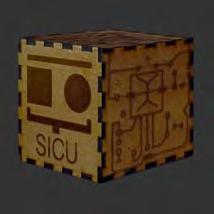

Is there an accurate representation of African XR Creators?
Not at all, I don’t know the number, but I think it’s still a handful of us.
What XR community events or activities have you engaged in?
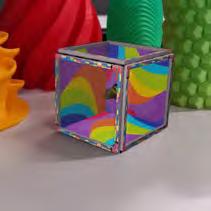
The Metaverse Crew is a great community with a wealth of knowledge. There is a lot to gain from positive criticism of your work and the crew sharing best practices. MVC is key.
How have your previous projects and products been funded?
We are funded mainly by clients and grants. We have received funds from Government Agencies in South Africa, but we have not tried the VCs yet.
What type of funding should be available for XR on the continent?
I think that, at the exploration stage, grant funding with a stipend for founders is essential. Once they have figured out their business model, they can start raising other advanced funding methods.
How can Big Tech engage you?
Big Tech should be able to make the technology accessible and easy to use. In addition, they can provide developmental funding for creators and partner with us in promoting our products.
If we have fewer African creators, our unique African stories will not be told to the world. I see a situation where we are just the consumers of the Metaverse, not actively participating in creating unique experiences. The Metaverse presents opportunities for us to create certain assets like unique motion capture data. I come from the township, and how people walk in my kasi is not like the animation you can get from MixaMO. So this presents us with the opportunity to create unique experiences.
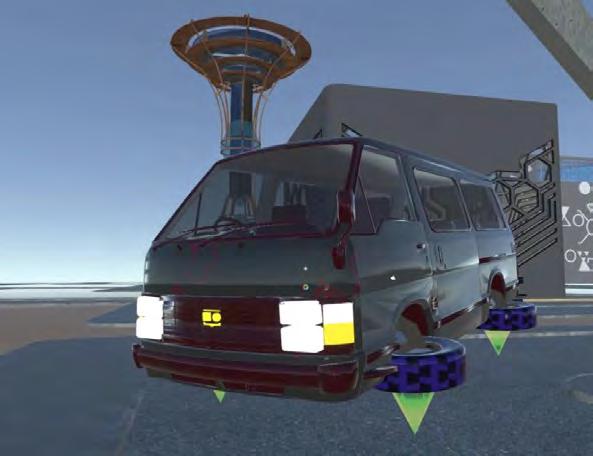
As the Metaverse becomes more of a reality, what are your concerns as an African XR creator/professional?
If we have fewer African creators, our unique African stories will not be told to the world.
I see a situation where we are just the consumers of the Metaverse, not actively participating in creating unique experiences.
Is there anything else you would like to say about XR?
Now is the time to build the future, now is the time to tell magical stories, and now is the time to move from the classroom to powerful virtual science labs. Now is the time to express your creativity.
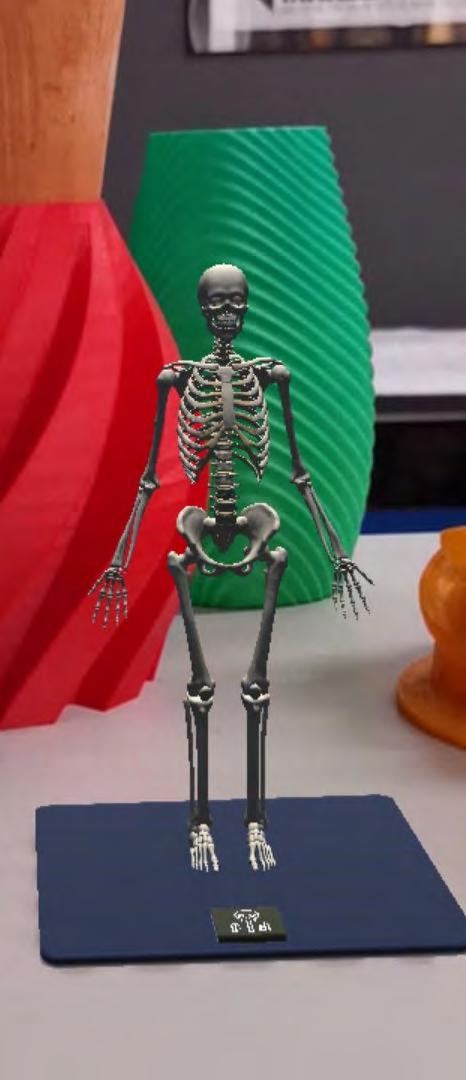
What can we expect in the next year?
More worlds. More Amapiano. More Art. More Fashion. More learners learning science.
And in the next ten years?
To be honest, I just want to see Sisanda Tech grow and outlive me. I want to see it contributing to the entire Metaverse. I want to see more XR Jobs created in Sisanda Tech. And I can’t wait for that collaboration with Kanye West.
Uganda
ACE Lab
Makerere University
Mike Nsubuga is an IT and Software Development Professional at the African Center of Excellence (ACE) in Bioinformatics & Data-Intensive Sciences. ACE was established by the Infectious Diseases Institute at Makerere University in Uganda. His work involves optimising medical applications development through VR and AR. In this spotlight, Mike takes us through his journey as a software developer working with XR.
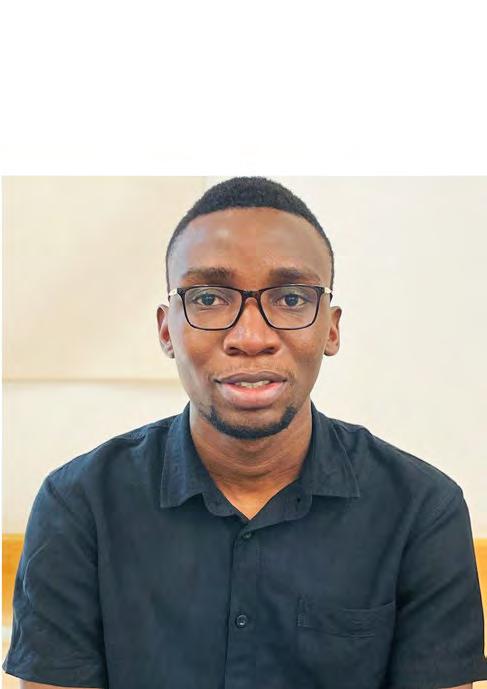
I have always liked computers, I think since childhood, the best things that have always sparked my interest have been computer related. After my first degree in computing at Makerere, I embarked on a journey to explore more in computing and how I could use it to address challenges in different sectors. I got accepted for an internship as a software developer with a UK-based company called Statistics for Sustainable Development (Stats4SD) which expanded my knowledge in the field. While doing that, I also enrolled at The Infectious Diseases Institute, where I realised an opportunity to use my tech skills in the Health space. So I joined, with the motivation to use my computing skills to fill that gap.
In my degree curriculum at the College of Computing, there wasn’t something specific that taught me about XR. But I was able to dig deep into XR online speciality courses at the ACE. The ACE has a VR lab and so it was a good avenue for me to learn new skills. I got some of the resources from Udemy, where I enrolled in a couple of VR development courses. I remember my first one was in Web VR as it sparked my interest due to my previous experiences making Web applications. I enrolled in a React VR course hoping it would help me build interactive VR experiences accessible from a web browser. I already had some experience doing Web applications using the same sister framework, React so I was able to build something. I continued on with more resources that I could get my hands on like Unity VR development, among others.
Speaking for the VR lab where I am based, at the moment, one of our biggest has been expertise. Not so many people are skilled in this area. During some of the projects we’ve undertaken, the people have had to go through special training before doing the projects.

Funding is another challenge that affects our turnaround time in bringing some ideas to fruition. Luckily, I have access to all the latest VR equipment from my lab
so that hasn’t been a challenge, though sometimes it can prove to be one since most of these are quite expensive.
There are very few XR communities in the country and online, making access to XR technical support very hard. This has hindered some of my work, I remember in some of the situations, I have had to reach out to the actual creators of Unity for technical support, and I am happy they have helped whenever they had the chance.
The lab where I work is fully stocked all thanks to the NIH NIAID Office of Cyber Infrastructure and Computational Biology (OCICB), which donated this equipment to us. The equipment ranges from devices that enable VR to happen, to all other VR-related accessories.
It’s a set of components. The most important one, I think, is the headsets themselves. We work with the HTC Vive Pro and the Oculus Quest 2, there’s also the NVIDIA 2080 Ti X cards that support high graphics processing and development. We also have a GoPro Max 360 camera that is handy for creating 360 video content.
We worked on a COVID-19 project that started at the end of 2020 and ran through 2021. From the needs assessment carried out, there is an urgent need to use Virtual Reality in education through training. This is due to the nature of Virtual Reality and what it offers to aid students’ needs. VR makes learning engaging and thus, enhances learning retention.
We thought of using Virtual Reality for training in the thick of the pandemic. Our healthcare workers in Uganda were overwhelmed by COVID-19 cases. We could train them to be competent in doing their job without exposing them to risks associated with COVID-19. I led the development of an XR platform (SOMA), which has now been recently published in the BMC Medical Education Journal.
So we sat down with a teamof creatives, content creators, animators, software developers, medical doctors, and the trainers themselves - and we defined a project where we could create content that medical healthcare workers could use to manage and handle patients in a COVID-19 setting, like a hospital. That was the idea behind the project.
We were able to complete the development of what we had defined,
and we developed our minimum viable product. The platform was divided into 3 main parts, the first of which had content for the theory and basics. Here they learned the basics of COVID-19 and the structure of the virus which was delivered through a virtual experience.
The second part consisted of 360 videos. We made recordings in 360 and then developed a platform that holds recordings in an interactive experience.
The third part consisted of immersive VR, here we went an extra mile to develop something that involved them feeling and touching different things in the environment, practising donnin, and doffing of PPE (Personal Protective Equipment). This was an immersive experience that assessed them as they did the training.
We enrolled some front-line healthcare workers onto the platform, from all around the country to try this out. The results were amazing, they really liked being in the environment compared to the classroom-setting they were used to. According to the assessment, the concepts were grasped much better and this was evidence that Virtual Reality technology can be used effectively for this type of training.
We thought of using Virtual Reality for training in the thick of the pandemic. Our healthcare workers in Uganda were overwhelmed by COVID-19 cases. We could train them to be competent in doing their job without exposing them to risks associated with COVID-19. I led the development of an XR platform (SOMA), which has now been recently published in the BMC Medical Education Journal
Which of your projects would you consider the most impactful or significant?
Any particular partnerships and collaborations you would like to mention?
NIH NIAID Office of Cyber Infrastructure and Computational Biology (OCICB) for the technical support and guidance they’ve given us right from the beginning, and for making XR possible in the country.
RENU for the internet connectivity at the lab, and Enduvo , a VR authoring platform enabling you to create VR content as easy as it is creating a PowerPoint presentation!
I think there is a need for an African XR community. As much as these technologies are coming, you must appreciate that Africa is different.
I feel like if we have more Africanbased communities, they may be able to address some of the Africanbased challenges. For example, it’s common in Africa to have some challenges that may seem small to others, say like power and internet connectivity issues; having thoughts shared within the African XR community, XR spaces may help in how we can all collectively solve these issues.

I’m happy with having policies in place that are good for the XR community. I believe that as more people adopt VR technology, the risks to privacy and security will become increasingly important.
So at the forefront of mitigating these risks are the VR designers and developers who navigate the field using their own moral compasses. So I believe that if policymakers can
define these policies and the ethics we can follow, it would be good. It is important to have legislation that ensures people’s safety with XR and Transparency about the data collected by XR applications.
Having these in place will undoubtedly reduce people’s worries regarding XR and increase uptake of the technology.
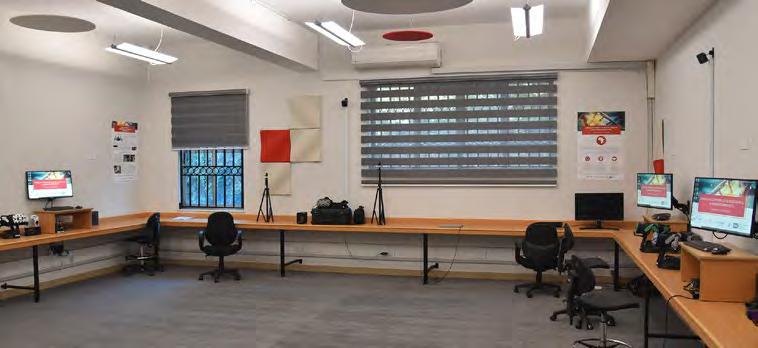
What roles do you think policymakers and regulators have to play in supporting the XR industry in Africa? What kind of policies do you think would be helpful for the community?Dedicated VR space at ACE Lab at Makerere University Image courtesy of Mike Nsubuga / ACE Lab
Most of it has been through grant funding. In the past we’ve received grant funding from Makerere University, we also have collaborations with NIH NIAID Office of Cyber Infrastructure and Computational Biology (OCICB) which provides us equipment and structural support. We also have lots of collaborations within the Ugandan space.
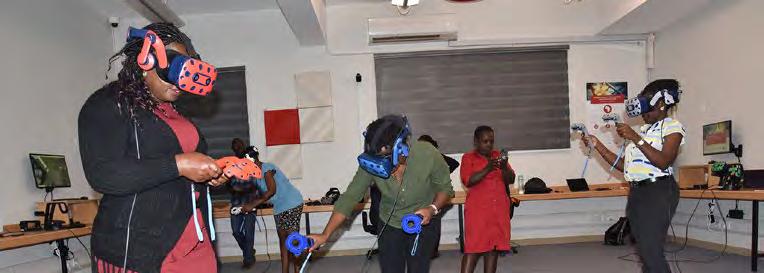
I’m very confident about what the future holds based on what the past has shown and how we’ve improved. If someone is reading this about XR and they are passionate about it, regardless of the challenges they may face, I would tell them not to give up. It’s a promising journey that I would advise people to take on and explore at the moment. I believe there are lots of opportunities in Africa for using XR to solve existing challenges in education, entertainment and much more.
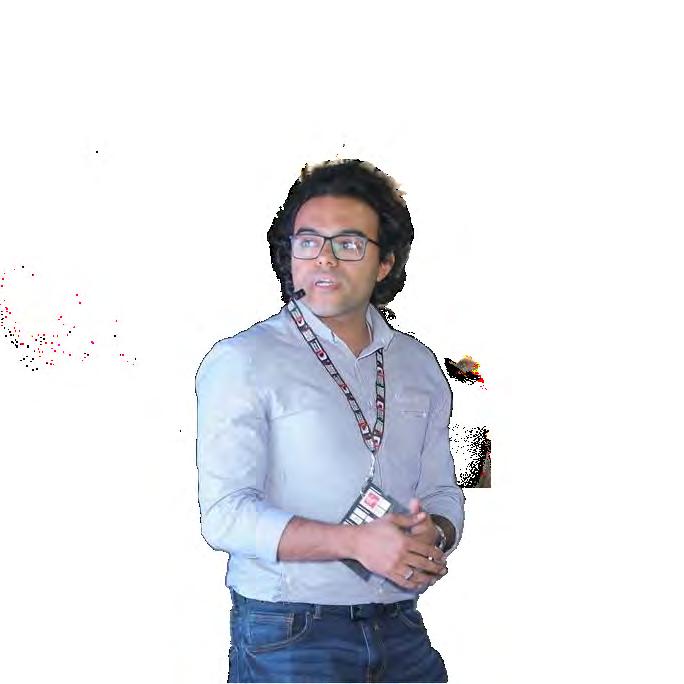
Egypt VR
been featured globally in Space.com, Mashable. com, Round.me & 360cities.net. His 360 photospheres have over 21.8 million total views on Google Street View. In this spotlight, he shares his XR journey, achievements and ambitions for the future of XR in Egypt.

I started making them out of wood and failed. My fingers were hurting, and I cut my hands, so I concluded it had to be something more solid than wood, but dynamic to calibrate each lens and camera body. To cut the story short, two weeks after going back and forth to that workshop, I had a self-made panoramic kit made out of metal. It was excellent and precise down to the millimetre. I spent eight hours every day for two weeks crafting every part of it and doing some inventing.
Then I had to come up with a solution for a rotation mechanism that was smooth and precise. After a couple of revisions and testing, it was really good. Then, I needed a fisheye lens to be able to capture the whole 360 view and only like four or five photos max so I sorted that.
After three or four months, I was doing my first panorama with that kit. It weighed around six kilograms, which was heavy. Its edges weren’t smooth, so I kept it and archived 30% of the VR content I created here in Egypt.
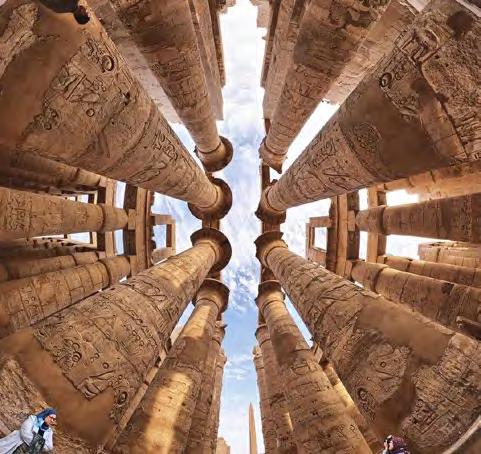
The next kit I had was a Bushman panoramic. It’s a French company called Bushman panoramic and the model of the panoramic camera is the Gobi. The current one I have is the Nodal Ninja Six, which is completely high end compared to the Gobi. The Gobi has very small panoramic kits. I used it because I was using a very small mirrorless camera, which was the Sony Alpha 6300.
At first, I wanted to create that little planet I saw. Then when I got into the VR space, I tried my first VR experience inside a VR headset by Google. It was an immersive feeling, and I understood that I had to create this 360 content so that when you viewed it inside of VR, it would be a tool to teleport the viewer to the space you are in. So basically, it’s like you have a key to a door and it can teleport anyone, anywhere in the world at any time, at any stage, at any age to that exact location you are in.
I think it was Ramses the sixth tomb in Luxor - the Valley of the Kings. This panorama is my ultimate favourite panorama that drove my business to this day. It is the first panorama I uploaded on Facebook. This is another story about how easily VR went viral, and the start of mainstream VR as Facebook started to support 360 panoramas.
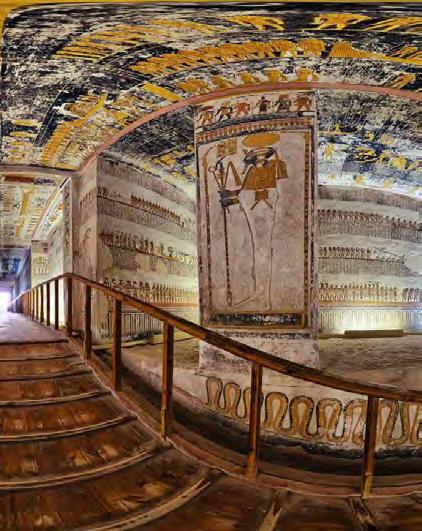
At the F8 conference in 2016, Mark Zuckerberg announced Facebook was supporting 360 panoramas. I uploaded a picture of the Milky Way panorama shot in South Sinai and two shots of one of my favourite camps. People shared my panorama ten thousand times, and I started to refresh the page and roll my eyes. At that time, I was travelling all over Egypt. I had many panoramas on my hard drives everywhere, everything in VR.
After hitting the upload button, I couldn’t sleep for two weeks; you have no idea. People asked me if my pages were promoting Egypt using VR, which was this new technology they had never heard of. That drove me crazy because I wasn’t even in contact with anyone in the government. So that helped me because after the pages went viral, I had clients everywhere who wanted to try this new tech.
So at what point did you decide to start a company?
I started to see the traction of the future of the VR space and 360 panoramas, even before Facebook tried to support it. So I developed my rig out of GoPros. I made my first rig using six GoPros, and I started to shoot 360 videos. I took that GoPro rig almost everywhere. After that, I developed more ways to get a higher quality 360 video.
I did some work with Google inside Egypt for the Pyramids of Giza Street View project, Petra and Jordan, also a Street View project. I didn’t actually shoot 360 panoramas for them, but I was managing the process of capturing 360 panoramas using their own device.

I did a high-value production for Vodafone and Lenovo. It was like a music mashup experience. It was shot using only one camera. I used
the same technique I used to capture 360 panoramas, but in videos, which is why I took so many videos at the same time. Then I started to sync these videos together. Using a scripted scenario, I took advantage of every shot being shot at the same time. Then started to film the same character in different styles, different clothes, and playing different instruments. Sometimes the piano, the electric guitar, and then started live mixing from the cell phones of Lenovo
company. It was very high quality at that time.
We also did AR For for a furniture company and an electric products company, but they were for internal usage for the investors and the board meetings and stuff like that. So, we used AR technology to project the product, and to explain it and take apart the composition of certain parts of the product and its features.
Tell us about some of the projects you have worked on.
There is a long term project I have been working on to this day, which is documenting the cultural heritage of Egypt using VR technology. It has been running for about nine years now. I have some of these pictures or VR content available for the public to access via our VR app. It’s called Around Egypt.It is available on iOS, Android, Huawei Appgallery and Oculus Store via Oculus Go.
Using this app, you can get access to almost 60-70% of the content that I have here in Egypt and that content
covers up almost every historical location related to Ancient Egyptians and even from the Christian and Islamic eras. It has over 56 virtual tours. It’s like the most important project for me because I do feel there is even a lot that I haven’t covered. The last location I added is the tomb of Queen Nefertiti. It is the most beautiful tomb you can ever see in your life. The paintings on the wall look like they were painted yesterday. It’s extraordinary to get inside and shoot it for VR.
I use the Sony Alpha cameras. For panoramic head, I use Nodal Ninja six. I use different software for stitching but PTGui is my go-to software for that. I know it like the back of my hand, and it’s terrific. I use Lightroom and other software for photo mapping and exposure.
I also use Unreal Engine in developing VR environments. Also, we have been able to turn 360 panoramas into 3D models and talk inside them wearing an Oculus Quest VR headset by using a couple of software plug-ins, we also use the KRPANO
The last location that I added is the tomb of Queen Nefertiti. It is the most beautiful tomb that you can ever see in your life. The paintings on the wall look like they were painted yesterday. It’s extraordinary to get inside and shoot it for VR.
How large is your team? How do you develop your skills to use the equipment?
We are not a very large company because as you can see, VR has become basic media now. It clearly doesn’t require a big team because, until this day, I have been working by myself. I still do work by myself. So I like to shoot, edit, develop, be involved in the latest technology, and know what needs to be learned. I’ve also been involved in virtual filmmaking.
I have never taken any online courses. I just watch YouTube and learn by doing. I download software and follow the forums and they say get your hands dirty. You start by trying and failing and trying and failing again. That is the best way to learn.
Which project would you regard as most significant or impactful?
What hardware and software do you currently use for most of your work?
High fidelity 360 capture at the Temple of Luxor Images courtesy of Mohamed Attef / Egypt VR

The biggest challenge is the hardware - VR headsets. Till this day, it’s not coping with the software. You have to have a standalone VR headset capable of running high-quality graphics, a high-quality VR experience without being tied up to a PC. That would be the middle point when comparing VR to traditional media. VR is still in the developing stage as I see it. Even after COVID, more people want VR experiences to be able to teleport themselves without being physically in the same place. So I think we have to be more updated with the latest technology in the education division.
We face many challenges when it comes to VR because of so many factors, whether it’s people misusing VR, or people creating bad content
or content created and edited in the wrong way. When you put it that way, sometimes people want to try everything even if it’s not suitable for VR. For instance, in 360 videos, you can’t have the same shortcuts between each segment. You have to give the viewer at least 10 to 15 seconds to realise, “What’s that thing I’m supposed to be looking at where I am?”
Do you think there are any misconceptions about XR?
Many people get their idea about the XR space out of movies or out of games. They are sometimes very afraid of VR; they think that you’re gonna trick them and take them into something they are afraid of.
What are some of the challenges you have faced?
Do you have a community of people doing similar work around what you’ve been able to access and engage with?
There were a couple of events in Cairo related to the media community in Egypt, showcasing video, photos, shooting films, and ads, and I was invited to give a lecture on producing VR content. There is this group on Facebook - 360 professional photographers and other photographers. It’s still my ultimate goto whenever I have a problem with stitching related to 360 photography. There is a similar one for videos also, I use it to check the latest techniques.
Can you give us a general idea of how most of the VR projects you work on are funded and how you can make money?
Well, I do work for companies inside Egypt and outside Egypt as well. Most of my work outside Egypt is through licensing content. So basically, it’s all online.
If they can support us with the proper hardware, we can focus on the skill part of creating VR content because, in the end, content is king. If you have a VR headset of the highest quality, the highest hardware available, and it’s empty, it’s useless, just a plastic device you can’t do anything with.
So the content on it has its price. We need more hardware to be available in Africa. We also need proper training for us here for Egypt VR, so we can develop more specific detailed experiences for Meta, and we can match the quality of VR experiences produced outside the region.
If they can support us with the proper hardware, we can focus on the skill part of creating VR content because, in the end, content is king. If you have a VR headset of the highest quality, the highest hardware available, and it’s empty, it’s useless, just a plastic device you can’t do anything with.
What do you think big tech companies like Meta, HTC, Vive, and Apple can do to engage an XR creator like you in Africa?
What are your projections for Egypt VR in the future?

We need to engage in the Metaverse. Using what we have so far, I think it’s precious to be featured in the Metaverse. What I mean by that is that people spend so much time and so much effort and money to create a Metaverse of something. So, I could have everything about Egyptian culture, ancient Egyptian mummies inside the Metaverse, can you imagine that? You could make a whole country’s heritage on the Metaverse.
That’s something that even if the government wanted to, it couldn’t make by itself, because it would take so many years of capturing and managing and converting that data into a Metaverse. I think it can be tried and configured if done the right way. The picture is not quite complete in my head yet, but that’s basically what I’m going for. I’m going to create Egypt’s Metaverse - complete with culture and history.
What do you think the world of XR would look like in 10 years globally and in Africa?
Hopefully, the hardware will be stronger than now, and you can have high-quality content for the XR space. What I mean is more people would have access to high-quality VR devices, so it wouldn’t look weird anymore to wear one in public and use it like you would use your phone.

Onome Ofoman is the engineering manager for Microsoft’s Mixed Reality team in Lagos, Nigeria. She graduated from Stanford University, California, USA, where she studied Electrical Engineering. She worked on trading software at Goldman Sachs, before heading to Google where she worked on cloud and search infrastructure. She returned to Nigeria, excited to be a part of the growing tech ecosystem. In this spotlight, Onome shares her experience in building the Mixed Reality team at Microsoft, the challenges with hiring talent and why Africa needs to develop Deep Science teams.
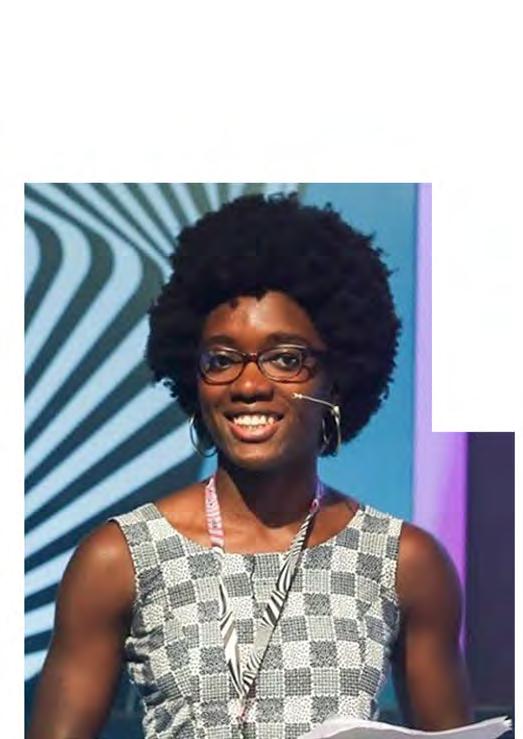
I studied electrical engineering at Stanford University, California and ended up taking some classes in computer science during my first year. I enjoyed those classes because they were really fun and had to do with problem solving, that’s how I ended up working on computer software.
I did a couple of internships with software companies, when I was in school. It was through these internships I learned to programme as an engineer. I worked at Goldman Sachs for about a year and a half and moved to Google from there. I was at Google for four years in the US. It was after that, I decided to move back to Lagos, when the engineering office for Microsoft was opening up.
I have actually wanted to work in Lagos as an adult for a long time. I initially left Lagos to go to Stanford University and since then, all of my professional work has been in the US. I moved back because my parents are here and I’d like to spend as much time with them as possible, and the other reason was because of Google.
Could you tell us about your academic and professional journey?
While I was in the US, I volunteered as a mentor for one of the accelerators Google ran that was focused on Africa and startups. I got to meet a couple of different startups like Paystack, Flutterwave, etc. they were part of that round. I was actually a mentor for Paystack and ended up consulting with them long term after that programme. I came to Lagos to work with them for about six weeks, and got a sense of what was happening in tech here.
I really felt that energy and saw we had lots of talent and that was what drove me to start to look at more permanent opportunities to work in Lagos. So when Microsoft said, ‘Hey, you want to start this thing?’ I was like, ‘Yes, I want to go back to Lagos, I think we have great talent there and I think Microsoft can be really successful there.’
At that time, I wasn’t doing anything related to Mixed Reality. I was completely focused on search and cloud infrastructures. I was just interested in knowing what big companies were moving to Nigeria, and how I could plug in and be a part of that.
For Microsoft, it was specifically the Mixed Reality team that started out here. I just got really excited about the potential of Mixed Reality. It gives people the ability to be able to collaborate even though they’re not in the same physical space. It also has applications in healthcare and in education to really drive deeper understanding and deeper clarity of processes.
I had some experience with VR through Google, especially with search infrastructure. We did a lot of work on AI (I have some background in AI). We did a little bit of computer vision work with image search, so some background in computer vision through image search but not a lot in VR specifically. I knew the science behind it, but not a lot about the practical applications of it. It was a big learning experience and also a big learning opportunity.
This is one of the good things about software, you can never really get bored because there are so many different parts to it. So whether you’re interested in FinTech, InsurTech, Deep Tech, XR, there’s just so many different applications of tech. As long as you’re interested, you can always pick up new things and go from there. So I didn’t have a background in XR. But I was able to learn everything I needed to on the job.
I just got really excited about the potential of Mixed Reality. It gives people the ability to be able to collaborate even though they’re not in the same physical space. It also has applications in healthcare and in education to really drive deeper understanding and deeper clarity of processes.
When did you come across XR for the first time and how did it feel?
I like to think about it in these three axes; you need deep science skills for the models, generic software engineering skills for building services, and then you need artistic creative skills for building and designing.
On the second and third axes, I think we have a lot of talent in that regard. There are lots of designers in Nigeria that I’ve personally met, and that I know of, so I don’t think there’s a big gap there. There might still be a gap with access to training and resources, but in terms of the talent, I think it exists. The same goes for the software engineering side of things; building services. The slight gap I see there, is we don’t have as many Senior Principal level engineers that can take on the role of Team Lead and build and actually lead projects. But over time, that will start to change as more people grow through the ranks, get more experience and get more exposure.
However, on the science side, I think that’s where the biggest gap is. We had fantastic luck, we hired from the very beginning two really brilliant scientists here in Lagos. Both of them have since relocated, but what we’ve tried to do now is focus most of the science work outside Nigeria. Most of our science teams are in the US and in the UK, actually in Europe in general.
The school system here does not have the deep background we need for building up the talent in science for computer vision. It is a challenge that I think we all recognise being in this tech space. But we can also do something to help out schools, to help either revamp curriculum, provide resources to schools, provide resources to PhD students, and fund research to build up that pipeline. I don’t think it’s sustainable to say, ‘oh, okay, it will always be the folks in the US and the UK working on the deep science side.’ We need to start honing those skills at home.
The school system here does not have the deep background we need for building up the talent in science for computer vision. It is a challenge that I think we all recognise being in this tech space. But we can also do something to help out schools, to help either revamp curriculum, provide resources to schools, provide resources to PhD students, and fund research to build up that pipeline. I don’t think it’s sustainable to say, ‘oh, okay, it will always be the folks in the US and the UK working on the deep science side.’ We need to start honing those skills at home.
What are some of the challenges you face when it comes to hiring?
One of the things we’ve learned is very important is just having a good balance between people who have a lot of experience and people who are still growing through their tech career. On our team it’s very important to have a ratio of four engineers to one senior, though we’ve not always been able to strike that balance.
But in general, as we continue to grow, it’s been very hard to find senior engineers, which is related to the
The Africa Development Center (ADC) is Microsoft’s first-ever engineering offices in Africa.
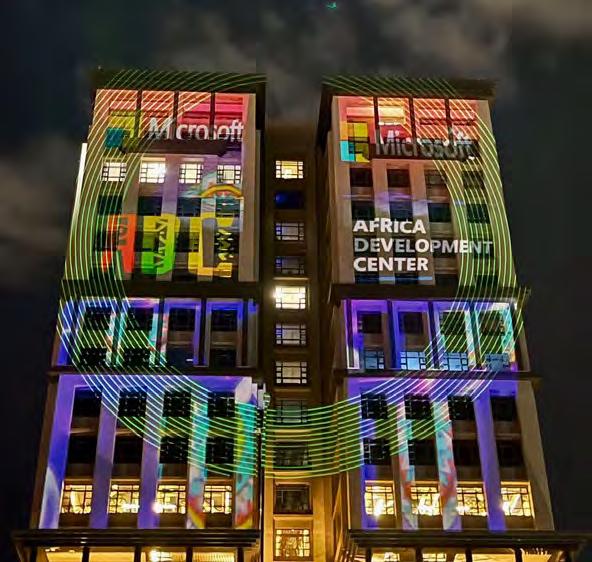
With locations in both Nairobi, Kenya and Lagos, Nigeria.
Image courtesy of Microsoft
fact that senior engineers, principal engineers have so many opportunities within and outside the country. And with the economic situation of Nigeria, nobody really wants to focus on companies in Nigeria paying naira. They would rather work remote jobs where they can make money in a stronger currency. That’s something we have to deal with as a global company working in Nigeria, and compensating in the way we do.
We’re focusing right now on growing the talent in house - growing the people that we have on our team through the senior and principal ranks - and
that’s working out really well so we’ll continue to focus on that. In terms of the people that we’re also hiring, we are looking to work closer with universities to make sure that those graduating with computer science degrees can actually apply to work at Microsoft from the get go.
Right now, there is that disconnect between what people are learning in universities and what they need to work a software engineering job. We have an ecosystems team that is trying to work with universities to make sure there’s that communication. There’s also a resource share between Microsoft and
schools. These have been the two major challenges around recruiting, and then also around the economic situation in Nigeria and how that makes it difficult to attract talent.
The product we’re working on right now actually works across different kinds of devices and is called Microsoft Mesh. It is essentially a platform that allows people to design and create collaborative Mixed Reality experiences or Metaverses. Platforms like Alt Space already allow you to host conferences or meetings in Virtual Reality. So you can create a space, design that space however you want virtually, and have people join as an avatar or as a hologram and then interact with other people within that space.
I think the first big release that most people will be aware of is Mesh for Teams. This has been publicly announced, but is not available yet. Within Microsoft Teams, which is already a collaborative platform, you will be able to have more Metaversetype interactions where you can actually create a space that feels like some other physical space that you’ve been in.
So we can have a space like this room that we’re in within Microsoft Teams,
and we can have an exact replica view, but as an avatar, and we can be having this interaction virtually, you on your phone while I am on my HoloLens. That kind of experience is device agnostic because it will be through a platform that allows you to access it on any kind of device you have.

It elevates the experience.Think about what a Microsoft Teams conversation could be - just two people on their phones with a picture showing, talking to each other. That’s the baseline experience. The second level experience can be turning on your video. What we are basically saying is that these two experiences work, but imagine what else it could be.
We are making Teams a more immersive experience. It’s not fully immersive, because you are not using a head mounted device, but it’s a lot better than what you were doing before with just a picture. If you have a head mounted device, great, then you get that full immersion. But if you don’t, you still have something.
Mesh promotional material showcasing real-time remote colloboration with colleagues using Microsfot Hololense. Image courtesy of Microsoft
There was a time we had two different projects to work on. One was an Object Understanding Service which is essentially a service that allows people to look at some objects in a room, and then the service determines if it’s a chair or a table for example. Then based on the understanding of what the object is, you can do interesting things, maybe superimpose digital information, or allow avatars to interact with that object in different ways.
So we built that service. Usually building the service means two things. It’s building a cloud service around an implementation of some scientific model that exists. So we had to work with a science team that was based either in Redmond (US) or in Europe. And for all of us, a lot of it was really understanding the science behind the service that we were trying to build. We spent a lot of time in meetings with our team in Redmond, really trying out the models, working with the models ourselves, and then on our side, doing the design and architecture for this cloud service that we were building on top of the scientific model. We did that about three times.
Object understanding was the first one, then we built a service for synthetics, which is essentially a service that allows you to generate images that can be used for training computer vision models. We did a couple more services that really honed our skills in building services, because our expertise is in building cloud services. We build cloud services for Mixed Reality, but that doesn’t mean we can’t build cloud services for other

things. The interesting bit comes from the fact that we need to really understand the science behind what we’re building our service on top of, and we need to make sure that those
models and services can work in any kind of environment, especially in the one we’re in, in Nigeria.
Object understanding, which is now called Azure Object Anchors. So it’s widely available on Azure Synthetics and Azure Remote Ranger, we worked on part of that. All of these are currently available, but they’re all enterprise services. They’re used by large organisations that do Mixed Reality. Those are probably the most impactful because they are now generally available and are being used by organisations in their day-today to drive efficiency in their work.
On the other hand, Mesh has the potential to do so much, especially in terms of virtual interactions and not just on the enterprise level. On the consumer level, I think there’s a huge opportunity here for Mesh. We haven’t realised it yet, so I wouldn’t say it’s the most impactful, but it’s the one I’m the most excited about.
So the first easy way would be through Mesh for Teams, that would be the first way a lot of people actually see and get to interact with it. You would be able to have avatars on teams. After that, there are a couple of different things planned that I can’t speak about. We’ll have to start to get app developers to then build their own apps that are similar to Mesh for Teams or that really use those capabilities for collaborative Mixed Reality experiences. I don’t know where this will go, but I think that’s where we need to engage a lot more with the creative content creators to
see what they’re thinking about in terms of how they could use this. Our job is to provide the platform and we have ideas on how it could be used.
But I’d rather hear from people what they would want to use it for.
Microsoft Teams will be the very clear way that consumers or end users like me and you would interact with Mesh.
The API will also be released at the same time, but then at that point, it’s for app developers to use the APIs to build their own experiences (i.e build their own apps they release to other end users).
Mesh for Teams can be defined as a mixed reality overlay that allows Teams users to collaborate in virtual spaces, work with persistent 3D content, and access Teams from their mixed reality glasses and VR headsets. Image courtesy of Microsoft
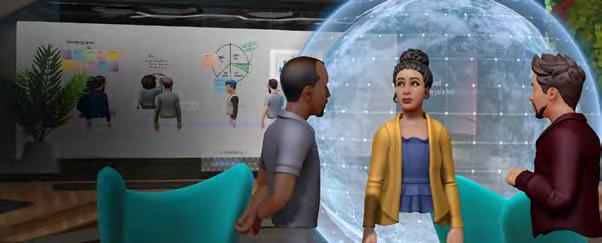
We are still missing that deep science on the XR side. We do actually have a lot of community. At least I see a lot of community engagement and community activities happening. A lot of it is through organisations like Imisi 3D, and that’s encouraging. There are communities nurturing talent through programming, hackathons, podcasts and so on. The big gap I still see is just more deep technical knowledge of the science behind XR.
How would you gauge the maturity of the XR space in Nigeria or Africa?
I think it’s quite nascent. When we say XR space, I like to think about it from those three axes I mentioned before, in terms of the people that we need - deep science, the generic software, and then the design. We have lots of people for software and design. We are still missing that deep science on the XR side. We do actually have a lot of community. At least I see a lot of community engagement and community activities happening. A lot of it is through organisations like Imisi 3D, and that’s encouraging. There are communities nurturing talent through programming, hackathons, podcasts and so on. The big gap I still see is just more deep technical knowledge of the science behind XR.
What are some of the biggest challenges for XR creators in Nigeria?
One broad category of problem is infrastructure. So access to high bandwidth internet, and consistent power. As an example, once we started working remotely, a lot of the work we were able to do from the office (because we have really good internet at work) was just really difficult to do at home. Remoting into virtual machines elsewhere in the world started taking too long. Little problems like that really really hamper the ability for people to move quickly or learn things quickly. Even access to devices that are powerful enough to run models.
So beyond infrastructure, it is just access to the kinds of devices you need to run these models, whether you have enough money or resources to purchase them. And that would go
into key things like the head mounted devices, how expensive and accessible they are.
The third thing might just be XR. It’s not a niche field, but it’s also not like FinTech or some of the other more obvious categories of tech within Nigeria, where there’s an obvious problem that this thing is solving, or there’s a very fundamental problem that it’s solving. Usually things like XR are not really solving fundamental problems, but they’re getting us to a point in time where the world is going. It’s a more future-looking technology. And I think with futurelooking technologies, people almost think about it as sort of ‘a nice to have technology,’ and then it’s the kind of thing you put money towards once you’ve dealt with everything else.
I’d say on the design side, Unreal Engine, Unity 3D and then just the basics, like Figma for design. On the service side, everything is based on Azure, because we are Microsoft. So Azure services are our bread and butter. I would just say, in general knowledge of cloud infrastructure and how to use cloud services, Azure is Microsoft-specific, but really, any cloud infrastructure knowledge is key. We use C sharp for the most part. For building out SDKs and APIs, we use Python and C++, as well.
Personally, I haven’t been involved in many. But the team as a whole has been involved. I know Kendra has been involved in a lot of the events. So there was a hackathon last year, with Imisi 3d. I actually was involved in that as a mentor, and we had other people in the team as mentors as well.
We have three technical designers that work on sort of designing worlds - the Metaverse or any sort of virtual world - and virtual assets that would be used either for people or so avatars replace spaces for things. We have two TPM (technical programme managers), and they are responsible for driving the execution and the workflow for the engineers.
Then the rest of the 35 people work on services. The way we’ve split things up is we have small groups working on different services, because we have multiple services. So the rest of the people are engineers spread across, entry level, mid-level, senior-level. As I mentioned before, we try to have at least one senior person per small subgroup. That’s how we’ve tried to break things up across the 35 people on the team.
Also last year, there were bi-weekly community series-like workshops. Kendra is our ecosystem’s engagement champion, and her role continues to be more work like that. But we have other people on the team who actively speak and represent the XR community, and who engage from time to time. Folks on the design side don’t focus so much on XR, but they’re a huge part of the game dev community. So that’s another community we try to do a lot of work with.
As long as there aren’t policies that would limit people from trying out things in XR. I think that’s generally the trend we tend to see with the policies and regulations that come up. There are policies that are needed around protection of data. We need a bit more of those kinds of policies. If you think about what the Metaverse is, it’s just another space in the world where people could potentially have their data stolen, or be harassed by people. So we need a lot more tightening of those kinds of restrictions in terms of what people can do in a digital space.
If I were to talk about policies, we need more policy for the Institutes of Technology, Universities, and Polytechnics, and maybe more resources into thinking about our future where things have been done more virtually. That for me, is a huge gap, and that gap will only continue to widen if our institutes are neither thinking about this nor putting resources aside for it.
If I were to talk about policies, we need more policy for the Institutes of Technology, Universities, and Polytechnics, and maybe more resources into thinking about our future where things have been done more virtually.
What about the hardware and software used to build the products?
What XR community events, activities have you been involved in?
What’s the spread of responsibility across the team?
For the ecosystem to grow, what policies and regulations do you think can make this happen?
Example of an Azure developers event hosted by the Africa Development Center Image courtesy of Microsoft

From what I know about our other teams that have deep science knowledge, a lot of these people have PhDs in different fields within computer science or computer vision. That is a huge thing that we’re missing here. We need a lot more people doing PhDs in computer science to focus on computer vision. There need to be universities that are set up with the right kinds of resources to hone that talent. There’s definitely work that can be done on the part of the Ministry of Education, on the part of private universities, but also on part of private companies to be able to provide or fill that resource gap that universities seem to be having. But I can’t really speak to the actual issues that are happening in universities because I don’t know firsthand what universities are going through. We have an education outreach team that just started in January and their work is to figure out how we can best help universities bridge the science and skills gap we see in the people we’re trying to hire.
I think for the short term, a lot of the XR advances will still be on the enterprise side. Most of the value is actually in the immersiveness of the technology. Enterprises are the ones that are able to afford the actual headmounted devices, and there’s just so much they gain from being able to combine the digital and physical world. So for them, the win is clear, and they have many companies and organisations that have invested in Mixed Reality devices and Mixed Reality technologies.
In the short term we will see a lot more creatives start to think about how to get their work out there in a way for consumers to access. Long term will be more focused on what we’re calling the Metaverse, which is more things happening immersively virtually. And then we’ll start to see the winds of the creative who have created content already there. As content creators in Africa, we can now start to focus a lot more on making sure we have digital representation so that once we get to that future where things are happening more virtually, we’re prepared.
I personally hope things don’t become more digital than physical. There’s a lot of value in the physical world, but there’s also value in being able to collaborate without all being in the same space, and this is likely going to be how things go on for a while. So thinking about how we can all have representation in those virtual spaces is very important.
What changes need to happen in this part of the world for more science teams to perform?
What do you think is the short term/long term agenda for XR in this part of the world?
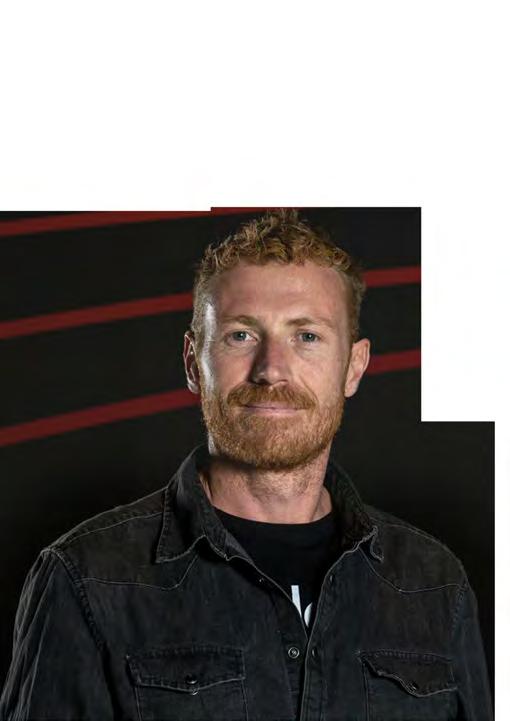
Rick Treweek is a game developer, VR developer and co-founder of Eden, a hardware and software development company. His company is the brain behind “Get Well Pals,” a 360-video edutainment platform that teaches and creates a fun immersive experience for children undergoing medical treatment worldwide. In this spotlight, Rick lets us in behind the scenes of how he got started in gaming and VR, the projects he has worked on, the limitations facing XR in Africa and his take on how the situation can be better.
I studied a digital graphic design course and I’ve been a Unity developer for decades now - since 2006/2007. And back then there was nothing like game development for phones. It was something that we stumbled on through pure curiosity. We were a very small group of like-minded people (myself and two other South African guys), just hanging out and working on a lot of passion projects, doing web design and experimenting on mobile phones. We even developed a mobile game and for the fun of it, we put in some tech that tracked where people were playing from. So, every time someone submitted a score, we could see the country they were playing from.

Within two weeks of releasing the game, it had spread to about 140 countries around the world. That opened our eyes to see what this industry could be. Subsequently, we moved to Singapore since there was much happening on the mobile games development scene there compared to South Africa. We ended up being there for a while working on games and surrounding technologies for games.
On coming back to South Africa, I got a Google Cardboard, which is a very early VR headset, and eventually made the pivot to creating VR content.
The first VR test I did was around 20122013, with my old business partner from Break Design, a company I founded with the two other guys I mentioned earlier. We got together one weekend to create something fun and new. We took some of our old game assets from World of Rabbit (one of our former brands), put it on a Google Cardboard and in a day, we had a little working prototype where you sat inside a mech, and you could shoot evil robots. The feeling and emotion we got from that was just unbelievable and it snowballed into something much bigger.
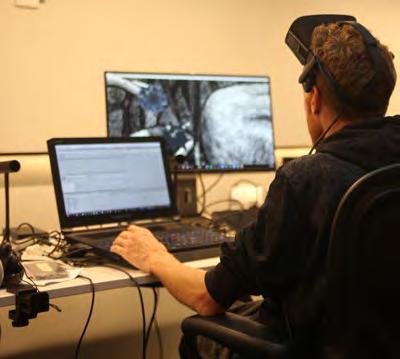
I use different hardware and software packages. On the software side, the biggest programme we use is Unity It’s a game engine and it’s free to download and use when starting. A major reason why we are so obsessed with Virtual Reality is that you don’t need to be a technical person to create content, because Virtual Reality speaks to the human side of you. If you can draw in real life, within two minutes of popping on a VR headset and figuring out how it works, you will be able to draw in Virtual Reality.
Still VR software; I used to use a package called ZBrush. That was my go-to package. I see a lot of people use all these CAD modelling packages, but they are very much on the high end in terms of cost. Whereas a lot of these VR sculpting tools are free or around $10 - $20, which is quite cheap. So I use a lot of sculpting packages to create worlds and characters, and to create assets for these experiences. They are then all tied up within Unity.
A major reason why we are so obsessed with Virtual Reality is that you don’t need to be a technical person to create content, because Virtual Reality speaks to the human side of you. If you can draw in real life, within two minutes of popping on a VR headset and figuring out how it might work, you will be able to draw in Virtual Reality.”
What were the challenges you faced in getting started in XR in South Africa?
A big challenge we faced was having access to the hardware we needed when we needed it. So back in the day, when the Oculus Go came out, it was available for everyone in the States, and everyone could order it in Europe. But no one would send it to South Africa.
We really had to work through strange ways before we could get the hardware here. Not only was it incredibly difficult and way more expensive, it was also a time game.
So the rest of the world could have access to the hardware quite quickly. But being in South Africa, we’d have to wait a lot longer than anyone else to be able to start developing.
Furthermore, Oculus was not supported in South Africa then, so it was incredibly difficult to have any sort of engagement or conversation with relevant people to move our projects forward.
Do you face misconceptions around your work as an XR creator in Africa and how has it been engaging with a crowd that is unaware of the technology you work with?
Absolutely. One of the hardest things was explaining what Virtual Reality is and what could be done with it. So, I ended up spending so much time educating clients on what they wanted, before they realised if they did actually want it or not. But now, part of Eden’s strategy is putting everything together to reduce confusion. For example, when you buy a “Get Well Pals” bundle, it has a
headset with a touchscreen that lets you choose your experiences, watch everything with all the content preinstalled. You unbox it, plug it into the wall, and there it is, your VR system up and ready to use. That makes it a lot easier when we’re dealing with clients, because they can see it, they can feel it and they understand exactly what it is we are offering.
Part of Eden’s strategy is putting everything together to reduce confusion. For example, when you buy a “Get Well Pals” bundle, it has a headset with a touchscreen that lets you choose your experiences, watch everything with all the content preinstalled. You unbox it, plug it into the wall, and there it is, your VR system up and ready to use. That makes it a lot easier when we’re dealing with clients, because they can see it, they can feel it and they understand exactly what it is that we are offering.
Let’s zoom in on your hardware - The Eden Snacker. Where did you get the idea to build your own hardware and what was the process around iterating and landing at the final version of the product you have now?
We organised a number of public art shows regularly and something we noticed was that people would be dressed up, and would not want to strap in to a VR headset, as well as in Africa having many hairstyles that headsets would not physically fit.
So, we decided to include a handle at the front and remove the straps of our VR headsets. Immediately, we noticed more people started engaging, because it also gave control back to the person viewing the show. By being able to hold the headsets up, if they felt slightly uncomfortable or felt like it was too much for them or anything like that, it would be very easy for them to just exit the experience.
Another issue was that some galleries were not used to charging up equipment for shows, because back then, we were using Samsung Gear VR. It was a challenge to make sure devices remained charged and ready for the duration of the shows.
To fix this, we put an induction charger inside the mask, so it wasn’t charging directly from a cable. This eliminated overheating, and as someone finished the experience and stepped away, immediately that headset would start charging. That was another innovation we introduced through our smart cradle. To charge our VR Headset as its cradled back.

Then the third one, which was a really big thing, was distribution of content. Currently, with Oculus Store and Vive, it’s a kind of closed gated community where you have to go through a lot of hoops to get your apps approved and get your content out there. We didn’t like that, and we came up with the idea of developing our Eden cloud platform. This gave us control of our content, and distribution of the content.
Our touchscreen was another innovation we made. Anyone that’s tried putting on a VR show at any event, understands the pain of awkwardly holding someone’s hand to show them how to press a button on a headset, or on a controller, because they can’t see due to the VR headset they have on.

It’s difficult to teach someone that’s never done that before and this is where our touchscreen came in.
As opposed to using an awkward controller for the first time, you can just walk up to a touchscreen, scroll through it like you would on an iPad or such a device until you find a piece of content you want to play. And then you just tap it. And that then instructs the headset to load up that particular piece of content on the touchscreen, or instructs the person that’s viewing the content to go and pick up the relevant headset. Again, it just makes that process so much more human and so much easier to use.
Eden Wellness Station makes selecting content from a library as easy as using a tablet, with no need to learn any complicated controls
it just makes that process so much more human and so much easier to use.
What kind of team does it take to do the work you do, building and creating content for the hardware? And how were you able to identify the kind of skills you needed in your team?
That’s a great question. The first thing is curiosity. A lot of what we do is very new, very intuitive. It’s not something you will find on Google. Two skills we look out for in our team members is (a) programming, we have a lot of programmers and (b) curiosity, people that have a curious mind are the right people to try something new . And I think anyone that’s into any emerging tech has to have that side of their brain.
We have a super talented team at Eden, from our programmers to our unity builders, through to our content creation team and our studio team. Everyone has this inherent curiosity of the future. Most of our team members also have a background in content creation. So, coming from a traditional film and media space and now interfacing with techies, it created this perfect kind of mix, where we have the people that have great experience and content, but then we have the techies that have the experience in tech and how VR works.
It’s like a perfect marriage. Quite often, we also look for game designers, because they come from a unity background and they have an innate curiosity also.
Do you feel there is an accurate representation of the African XR creator space or is there a gap?
I think there’s an absolute gap. In South Africa, we’ve got a very tight VR community, and everyone knows how exciting it is, they know how many projects are going off. But very few of them make it into the international community. Let me cite an example.
One of our first projects, the Lost Botanist, was an official selection for Annecy International Animation Film Festival in 2019. That was the first kind of VR project from Africa, coming to the stage, but I think a lot more needs to be showcased to the international community on a level playing field , because our skill set in Africa is just incredible.
I think this is also where the Metaverse is quite interesting, because when we’re hanging out in VR together every week, you’re engaging with people purely on a brain level, right? Everyone’s dressed as a funny avatar so there’s no initial judgement of anything. It doesn’t matter where you’re from, as long as you are curious and you’re excited about future development. We just need to take that concept and bring it to the realer and bigger open space.
A lot of what we do is very new, very intuitive. It’s not something you will find on Google. Two skills we look out for in our team members
is (a) programming, we have a lot of programmers and (b) curiosity, people that have a curious mind are the right people to try something new
Glad that you mentioned the Metaverse in your response, what does the Metaverse mean to you?
Defining the Metaverse is a tricky topic, depending on who you ask. Speaking as a VR Unity developer, we had always referred to ourselves as the Metaverse crew before Facebook used the term. “Metaverse” is from science fiction books Snow Crash and Ready Player One.
From my own perspective, when I talk about the Metaverse it’s very much about Virtual Reality and being able to create anything you want, being able to be anything you want. Because I believe it’s the human intimacy you get from VR that creates a Metaverse.
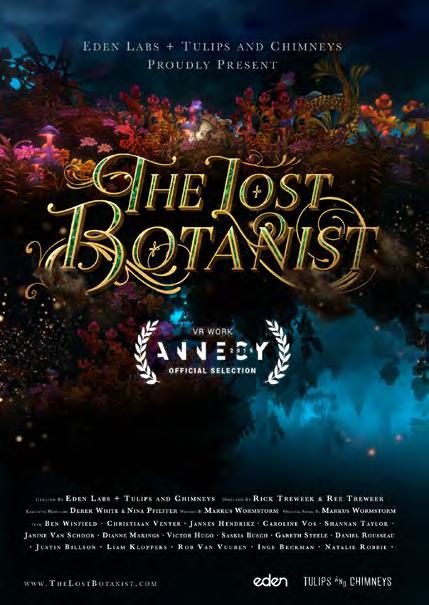
I think everything else, for example a 2D screen, lacks a human touch. It feels like a chat room or a game. Whereas being in an environment in a Virtual Reality headset gives you that human intimacy that makes it real and intimate. That is major for me, so, when I talk about the Metaverse, I really believe that VR Social, and all that’s happening in the crypto space with NFTs and tokenomics , are fundamental, because it gives utility and confers ownership of some things. All the same, I think the term Metaverse is very messy at the moment. For me it comes from Sci-fi books, pizzas and swords.
From my own perspective, when I talk about the Metaverse it’s very much about Virtual Reality and being able to create anything you want, being able to be anything you want.
What would you say is your most impactful or meaningful XR project so far?
Get Well Pals is definitely the most exciting and impactful. It is a children’s 360 video episodic that helps kids going through cancer treatment deal with the condition in two ways. One is through edutainment, addressing issues such as, ‘ Why am I losing my hair?’, ‘ Why am I tired all the time?’
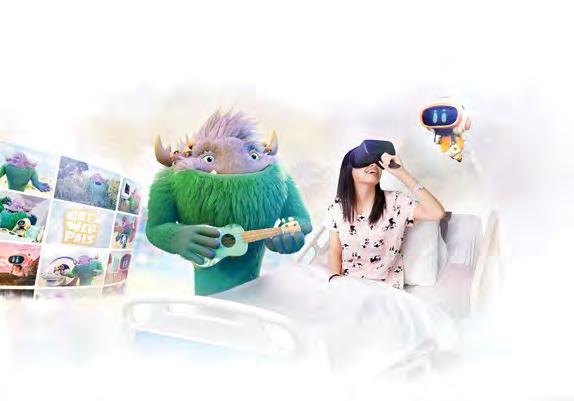
The second thing is to offer distraction content that kids can immerse themselves in by just popping on headsets, and enjoying themselves in a fantasy fun environment.
We have been working with Reach for a Dream , a South African
organisation that usually visits sick kids in hospitals to take them out for fun adventures outdoors. We have also been able to penetrate hospitals in the US and Europe. This has helped us see how these children’s perceptions can be changed through technology.
Everyone on the team has the amazing feeling that Get Well Pals is really making a difference, especially seeing it in action in the hospitals and seeing the reactions of kids.
Aside from Get Well Pals, the experimentation being done in the Metaverse is also incredibly
exciting, because no one knows where it’s going. It’s like going into deep space, like Star Trek. The more you are in it, the more you experiment. Then you’re going to start realising what can actually be done.
Get Well Pals is definitely the most exciting and impactful. It is a children’s 360 video episodic that helps kids going through cancer treatment deal with the condition in two ways. One is through edutainment, addressing issues such as, “Why am I losing my hair?” “Why am I tired all the time?” The second thing is to offer distraction content that kids can immerse themselves in by just popping on headsets, and enjoying themselves in a fantasy fun environment.
Could you talk about individuals, artists or organisations you’ve collaborated or partnered with in the course of your work?
Sure. We’ve worked on different projects where we had to partner with people and organisations. For artists’ collaborations, we have worked with Mary Sibande , William Kentridge , and W ayne Barker in putting on big shows.
We have also worked with smaller artists who were able to see new technologies that they’ve never had access to before. We’ve learned so much as technologists, because they put us on our toes. We also collaborated with Tulips and Chimneys , a Cape Town animation studio, on the Lost Botanist project I mentioned earlier.
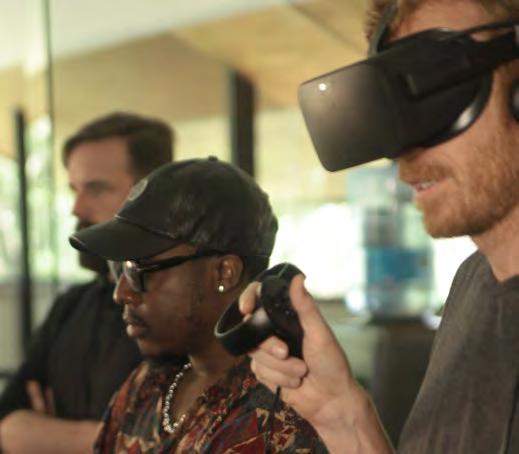
In terms of our hardware, we do the design ourselves but we partner with a studio in China for manufacturing and some other things.
We also work with a lot of freelancers who have skills that our team members do not have. Imisi 3D and Electric South are other organisations we have partnered with in the past.
How did you get funding for the projects you’ve worked on and how are you able to make profit? Also, if you got extra funding now, what would you do with it?
We are self-funded. We’ve got a runway that we’ve been developing our hardware and software on. We also have teams in the USA and Europe that are busy forming relationships with various children’s hospitals across the world.
If we got a bunch of funding now it would be used (a) on the Get Well Pals side, to create extra episodes,
extra content, extra kits to go out into hospitals, and to develop additional support for other Headsets.
(b) for our Metaverse experimen tations , it would be used for work shops, putting together events in the Metaverse, putting together shows that people within the col lective can actually put serious time and energy into.
So Unity, YouTube, and find a local community. They exist. We have the WE are VR community in South Africa, we have The Metaverse Crew (MVC), which is a lot more global, we have a very broad range of various people from across the continent there. And it’s amazing being in that group, because of the networking opportunities that it brings. Sometimes we go to these shows in VR, and it really feels like you are there with people and the other directors and other creators from various countries across the world. It’s really great to have that, not only feedback from South Africa, but from the global community as well.
What other factors and resources do you think are necessary to join the XR community? Are there courses people should take?
I think the University of YouTube is always the first and foremost, like having enough curiosity to want to discover something, and knowing how to Google and knowing how to be patient to watch YouTube tutorials. I also think it’s important to be part of a community, because, as an example, Unity can be an incredibly difficult piece of software to start with, because it is so big in nature. But to make the process so much easier, every single Thursday we hold workshops and Discord sessions around very specific parts of Unity. This helps to make it digestible to people.
Once you’ve done those two or three times, then you get kind of used to it, then you do the next thing and as time goes by you’ll acquire different skill sets and you’ll realise that you’ve begun the great journey into Unity development.
I say Unity, because we have been Unity developers for so long, but Unity or Unreal, those are
necessary skills to learn for sure. If you want to get started, start straightaway by downloading those two programmes, though it depends on what you want to do, as they are quite different in what they can do. And it’s free. You can download Unity and make a game immediately without having to do any sort of payment. So Unity, YouTube, and find a local community. They exist. We have the WE are VR community in South Africa, we have The Metaverse Crew (MVC), which is a lot more global, we have a very broad range of various people from across the continent there. And it’s amazing being in that group, because of the networking opportunities that it brings. Sometimes we go to these shows in VR, and it really feels like you are there with people and the other directors and other creators from various countries across the world. It’s really great to have that, not only feedback from South Africa, but from the global community as well.
What roles do you think regulators and policymakers have to play in supporting the XR industry in South Africa or on the African continent in general? What kind of regulations are you hoping to see and what kind of policies do you think would be useful for the community?
I think it is fundamental to have policymakers involved in these conversations. We need to work on data costs. This is linked to our government and certain things need to be done to give people access to cheap data. Access to the internet should be a human right, it shouldn’t be an incredibly expensive thing
to do. Because having access to that knowledge is what’s going to make the biggest difference. So fundamentally, we need those decision-makers - especially from government - in the room to understand what the problems are, and to provide the infrastructure to make data more accessible.
What role do you think big tech has to play in encouraging the growth of XR and what do you want to see from them in terms of how they can engage you personally as a creator and how they can engage the continent to make sure we’re not being left behind in this new tech wave?
Big tech has a serious responsibility on their shoulders right now to be more open and to be more inclusive. I think everyone knows this. Meta needs to go beyond what it says on paper and make it real.
Big tech has to prove themselves to the communities going forward. They can’t just put out a press release, they need to put their money where their mouth is, and they need to start getting behind communities that already exist, that are already doing a lot of these developments
and experimentations. Not on big tech’s terms though, because a lot of times, big tech comes in and says, “What you are doing is amazing, but you have to do it on a specific platform using these tools.” That’s not really helping anyone, they have to be honest and forthcoming if they want to grow the ecosystem.
Big tech’s got a big responsibility to show their human cards to the rest of the world now.
I think the next 10 years are going to be incredibly exciting. I think there’s a huge responsibility for people that are already in the tech game like our Metaverse crew, to be there to help guide the Metaverse in a way that we think is right. Many decisionmakers have probably never even been in the Metaverse, but because it’s on their mandate, a lot of their ideas might make sense on paper, but fundamentally might not make sense just because they haven’t actually experienced the Metaverse. I think there’s a huge responsibility for people that have been in the game for a while to help guide this.
What are some of your predictions for the future of XR globally and in Africa? Where do you expect XR to be in the next one year, and where do you expect it to be 10 years from now? Also, what does the future look like for Eden?
Within the next year, we’ll definitely start seeing cheaper access to technology. I often refer to the progression of mobile phones in Africa. We went from these old school phones and leapfrogged into smartphones, we missed an entire generation or most of the phones in between that. I think we’re going to start seeing the same with Virtual Reality, in terms of it getting cheap enough that it is easily accessible by the people who need to access it. With the adoption of something like the Quest 2, we’re going to start seeing a lot more cheaper headsets coming out from China and that will bring prices down.
In 10 years, jeez, yeah, that is going to be sci-fi. I mean, what we see already in the Metaverse and our community and what people are developing is incredible. I think the next 10 years are going to be incredibly exciting. I think there’s a huge responsibility for people that are already in the tech game like our Metaverse crew, to be there to help guide the Metaverse in a way that we think is right. Many decision-makers have probably
never even been in the Metaverse, but because it’s on their mandate, a lot of their ideas might make sense on paper, but fundamentally might not make sense just because they haven’t actually experienced the Metaverse. I think there’s a huge responsibility for people that have been in the game for a while to help guide this
. At Eden, we’re incredibly excited about the future. Our mission is to put as many smiles on as many kids’ faces in as many hospitals on the planet as possible. I think this first phase of getting people to adopt the technology, getting people that don’t understand the power of VR to at least try it, is the trickiest one. But as soon as we have our systems in more hospitals, then we really start seeing the benefits of it. We will just see an absolute uptake and that will enable us to expand Get Well Pals into the universe and continue to make amazing, happy, incredible educational content that really helps change lives across the world.
Founder
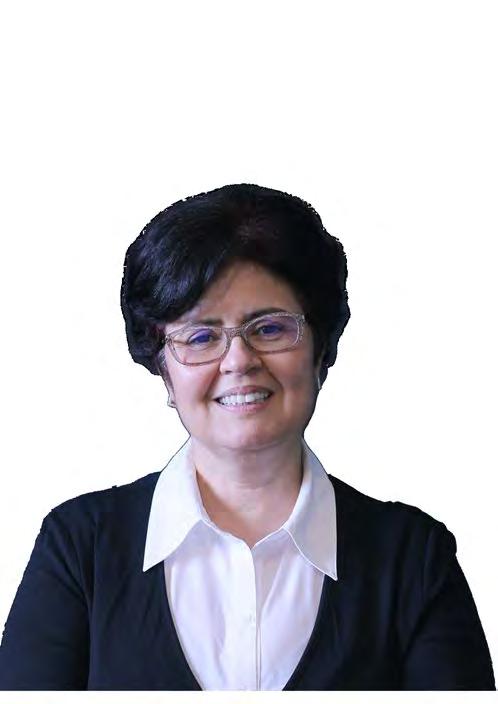

Samia Chelbi is a social innovator in the creative industry, an education expert, and a disruptive entrepreneur, from Tunisia. She is the founder of 3D Net-Info and DigiART Living Lab, and has over 20 years experience specialising in training in software engineering. She is highly invested in creating high-impact social projects and supporting the growth of digital arts on the continent. In this spotlight, she talks about the nature of her work and the impact of emerging technologies in Africa.
We started activities related to virtual, augmented, and mixed reality in 2016. Our selection by Facebook for a VR Development Grant allowed us to set up a laboratory equipped with 10 virtual reality headsets. This laboratory allowed us to launch our next actions - training sessions and coaching programs to produce prototypes. In 2018, the first edition of the African AR/VR hackathon was held. We were the Country Partners in Tunisia, working with the organisers, Imisi
3D , chaired by Judith Okonkwo
We started our first professional production experience in 2019, after training young talent and doing a lot of experimentation to set up a professional production pipeline. Since then, we have continued experimenting with the technologies in terms of software and hardware. Our objective is to be able to offer the best user experience and produce projects with social impact. We want to highlight the importance of these technologies in our ecosystem, especially to decision-makers and investors.
If we consider the production of our turnkey XR projects, it’s 40% of our overall production activity. On the other hand, as it relates to 3D content producers for XR projects, we are at 90% of our production and activity. I am a teacher in software engineering. Since 2010, I have immersed myself in gaming development via the training courses that I lead at Net Info, and also via the production support that I do for my students and team.
In 2016, I started training and producing a massive project which allowed me to learn a lot, and I find this is the best way to learn. We strongly believe in the development of projects that have a high social
impact. For this reason, we had set up the first African Living Lab, certified by the European Network of Living Labs , in 2015. Our main vocation is to develop 4P-type projects. This means developing Public/Private/People/Partnership Projects around 3D, gaming, and immersive technologies.
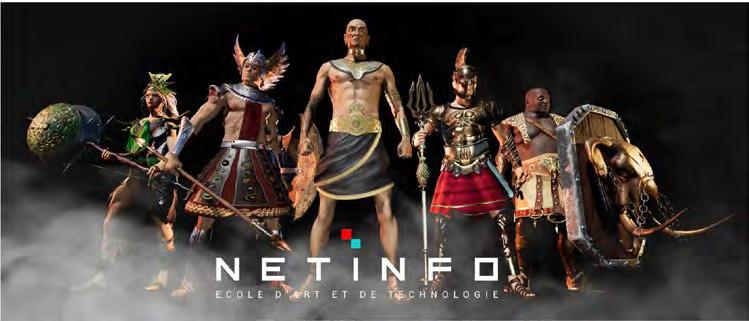
In this context, we have developed XR projects for the enhancement of our cultural heritage, and also VR and AR applications for autistic people. We also developed an educational application for learning mathematics, and the last one is an application to protect teenagers against addiction to screens.
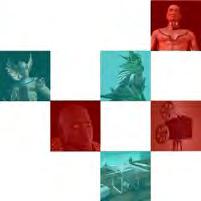
Our laboratory is equipped with HTC Vive, Samsung Gear VR, Oculus Go, and Oculus Quest headsets.
How have you been able to access equipment?
The equipment is too expensive in the local markets compared to the costs in the global market. For this reason, we have budgetary constraints, and a lack of availability, especially for the new equipment we need for experimentation.
What are your thoughts about the XR industry in Africa?
I think XR is an emerging discipline in Africa that will soon explode in the future.
What challenges do you think the XR space in Africa is facing?
Our major challenge in the continent is the lack of well-trained IT personnel. We need them to be able to set up a sustainable XR content production industry.
The only events that we know about on the continent and have participated in so far, are the African AR/VR Hackathons organised by Imisi 3D.
What is your take on building XR communities?
Yes. This kind of attitude is very important, but it needs continuity to help winning teams go further in this industry.
How do you go about funding your projects?
We have some support from the Finance Institute and the US Embassy in Tunisia , who sponsor our activities. But it is not enough. We need to have more programs and funds to support our production community and launch good projects.
The equipment is too expensive in the local markets compared to the costs in the global market. For this reason, we have budgetary constraints, and a lack of availability, especially for the new equipment we need for experimentation.
I think our decision-makers should establish a global strategy for the XR industry. They must be convinced of its impact on innovation and the economic development of our countries, especially in terms of jobs and startup creation.

In this era of the Metaverse , the major challenge is content creation and the development of the community. We should help the community transition with
confidence. We should learn to support them and help them to take a relevant position in the market.
Above all, we should help them find their balance between conception and production. We can take our place in this revolution by being decision-makers in our technological future. All African talent needs to contribute to the enhancement of the continent as innovators and content producers.
In ten years, how far do you think XR technology would have gone?
It is so hard to foresee what will happen in ten years. Already in one year, we could have a lot of surprises. I think there will be a lot of innovative projects, but we will face a lot of problems linked to social, ethical, and economic issues.
Have you considered the role of policy in the growth of XR space on the African continent?

Tulanana Bohela is a Tanzanian journalist, producer and filmmaker. She is the cofounder of Ona stories and the director of their immersive unit called Ona Kesho. Her first 360 film, ‘What Could You Do,’ was featured at the Sheffield International Documentary Festival. Tulanana worked as a journalist for more than 10 years with the BBC World Service. In 2016, she co-founded the media company Ona Stories and finally quit her job in 2019 to focus on telling immersive stories. In this spotlight, Tulanana shares how she made the move from traditional journalism to immersive storytelling.
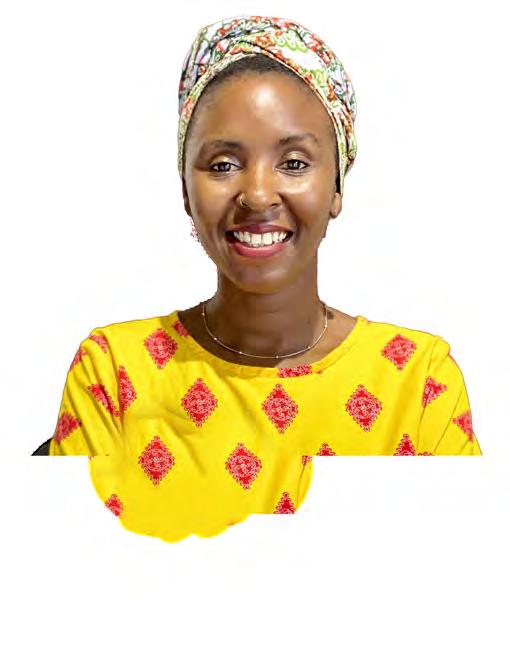
So, I knew of the immersive world around 2015/2016. At the time, I was more interested in the mobile platform, how it was influencing how we created content, and how we created business models around that. Through my interest in that, I got the opportunity to go to Cape Town and that was the very first time I interacted with some VR equipment. It was at this event called the Media Africa Party. From there, I guess you could say, the universe has a funny way of working. I was in Nairobi giving a talk about being a video journalist and documentary filmmaker, when I met this lady called Nyasha Kandadara; she invited me to this VR hackathon in Nairobi with journalists and creatives.
I went for the hackathon and that was the first time I met Ingrid Kopp from Electric South, Trevor Snapp from Gisa Group and some folks from Black Rhino VR. The hackathon lasted for three days and we had to create a 360 piece in that time. That’s where my first 360 piece came from. This was in 2016/2017 I believe. At the hackathon, I got a 360 camera and a headset, and you know I began to create and just share the gospel of VR.
At the hackathon in Nairobi, there were two Tanzanians, I and another lady, Veronica Natalis Mataba. I remember the day after we got back from the hackathon, we both looked at each other and asked, ‘So this camera, how do we explain it to people? What do we tell people it does? Most importantly, how do we communicate that in Kiswahili?’ We were thinking about it and we were struggling. We ended up going with a pretty literal translation. This was our first experience with one of the unique challenges of bringing VR to Tanzania, where there is already this issue of digital illiteracy.
After the hackathon, we organised the first VR showcase at this very big innovation festival called I nnovation Week which lasted five days. Our booth was full of so many people. I remember being told that two people
could not man a booth; that we would need more. They were right. Afterwards, we got more interesting people wanting to explore VR and use it in different sectors, which led to the next project I worked on. It was an AR photo gallery with the Vodacom foundation which was part of a social impact report they were launching. That project helped us with exposure. In October 2018, I went for the New Dimensions Lab organised by Electric South , which really got me thinking about more VR projects I could work on. After that, I got my own equipment - a 360 camera and a laptop that could handle it. And then with Ona Stories, we set up our immersive unit Ona Kesho, where we have been training and working with people interested in learning about the technology and applying different formats.
Tell us how you got started with Ona stories?
Ona Stories started in 2016, but only got registered in 2017. The idea was to create a graphic journalism hub where creatives, technologists and journalists could come together to work on stories, explainer pieces specifically, sort of like the Vox Media Studio model. We would be explaining the unexplained, explaining parts of ourselves.
We started out moonlighting, did some stories here and there. And then we created our own explainer
piece of journalism, which we used to open our page. It was a video called Dodoma Kunani that went viral. It was the first thing we put out and it went to 15,000 views and people were sharing it on WhatsApp. That gave us some form of validation.
But then we ran into a challenge, Tanzania entered a new regime, the media laws changed and we couldn’t create the pieces we wanted without getting unwanted attention. So, we pivoted our model and started telling
But then we ran into a challenge, Tanzania entered a new regime, the media laws changed and we couldn’t create the pieces we wanted without getting unwanted attention. So, we pivoted our model and started telling brand stories. We approached brands with proposals; we told them that instead of advertisements and commercials, we would find stories within their brands and tell them.
brand stories. We approached brands with proposals; we told them that instead of advertisements and commercials, we would find stories within their brands and tell them. We found those stories and then told them through videos or writing or photography, whatever worked best. We’ve settled with this business model for quite some time now. I quit my job to work on Ona Stories full-time in 2019 and my cofounder quit in 2020.
Ona Kesho started off as a playground for experimenting with new formats of storytelling,my cofounder Princely wrote an essay using Artificial Intelligence.
When it came to immersive content, as a journalist, literally every time I went to do a story, I would carry my 360 camera with me and go record. I would just shoot stuff. I always felt like we needed more stock footage of the country in both video and photo. I would record and if I had some extra time, I would experiment on my laptop. This was very helpful, because when I would start teaching this to people who expressed interest, I could show them footage not of America, but of a river that they knew, places they were familiar with . So it started with me just doing that. Gradually we started to build a team. We got a producer, a motion
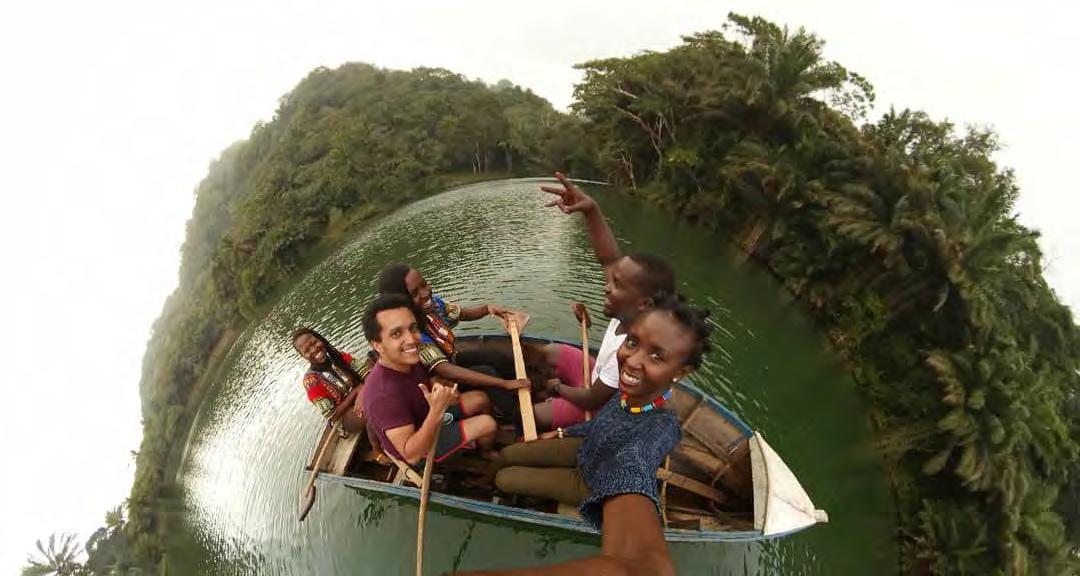
graphics person who also does a bit of video, and with this team, we converted the videos I shot into stories. On our Ona Kesho page and LinkedIn page you can see some of those. We also recently started making little planets animations and stories. These little exercises serve as instant gratification that I realise the team needs. We also introduce them to virtual tours and other things like that so they can experiment around. There’s a lot of this happening in the team, because I don’t believe we should just sit around and wait for I don’t believe we should just sit around and wait for clients. I believe we should go out there and experiment.
clients. I believe we should go out there and experiment. I tell the team this very often.
As the team grew, we just sort of realised that we were mixing a lot of Ona stories work with immersive work so we decided that immersive work should have its own branch and that’s what we call Ona Kesho. Ona means to see and Kesho means tomorrow: Ona Kesho - See tomorrow. We have focused on building that now and exposing young people to it.
Parts of your journey with Ona Stories and your immersive work happened simultaneously. Could you tell us about the moment they came together and formed Ona Kesho?
We did a 360 film called ‘What could you do’. It was a film I did that essentially revisited my first time being sexually harassed in public transport. That went on to be featured in the Sheffield Documentary Festival in the United Kingdom. Then we also did a project with Vodacom Foundation Social Impact Report. My co-founder, Princely, directed the AR photo gallery with them. We’ve done some work with USAID to create Augmented Reality stories for their youth program called advancing youth. They showcased that in
Washington DC. Last year, we did a project called Ghosts of the Present which was a VR collaboration with Kijiweni productions , as well as Black Rhino VR.
Last year also, we collaborated with these guys called D-lab. They essentially work with data, it’s called Data Lab. They had this festival called Data Tamasha where we did some AR work with them, showcasing their work through AR at the festival.
We’ve also worked on exhibitions
with the Human Development Innovation Fund . Recently, we have launched the #DuniaDuara project where we want to make a series of tiny planets with scenes and stories from all over Tanzania. That’s kind of like essentially using all the footage we’ve collected from my travels, and showcasing different stories using tiny planets. That’s like our Instagram series we’re doing currently. Some of them can be found on LinkedIn, but mostly it’s on Ona Kesho and Ona Stories, and we plan to continue with that this year.
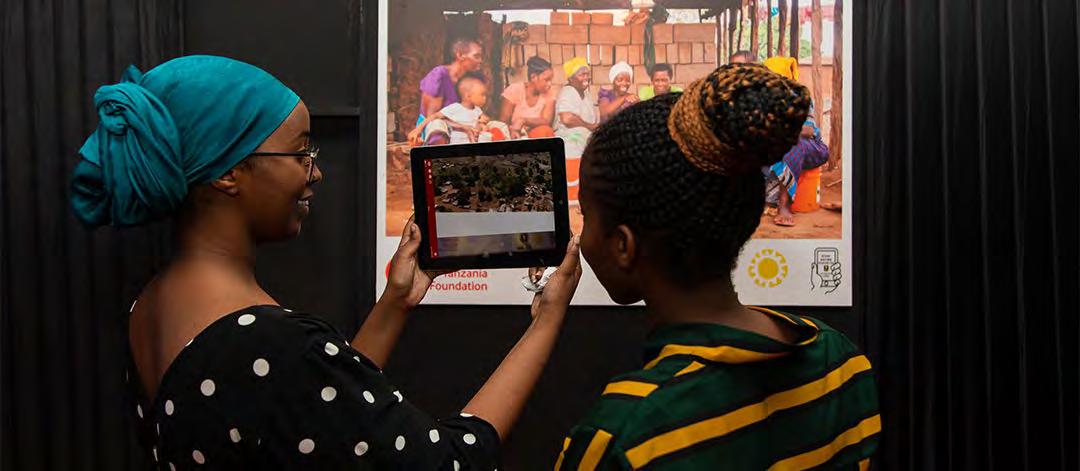
Could you tell us about some of the early work you did and how easy it was getting them?Tanzanias first AR / VR exhibition Image courtesy of Ona Stories / Vodacom
What would you say has been your most impactful project so far?
I think the collaboration we did last year was the biggest, most significant one we’ve done. It really showed me practically what is needed and where the gaps are in terms of capacity building, and also lining that up with incentives for young people to learn this technology. I also saw gaps in the staff and in the production value chain that we needed, and I was just so grateful for that.
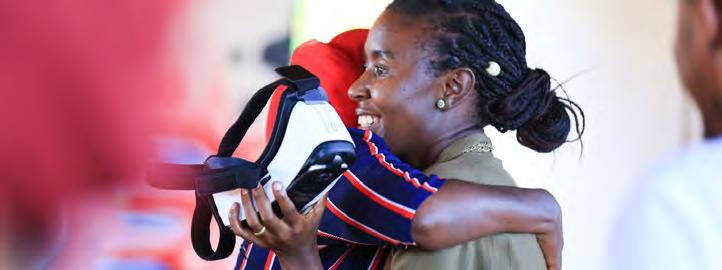
We’re still in the editing phase. We did a soft launch of the film, and are looking for funding to be able to complete the editing. But I can say it just showed me the power of collaboration as well.The fact that Kijiweni Productions came with a story, we came with the crew, and Black Rhino came with the technical know-how and the equipment, especially when it came to postproduction.
I was really grateful for that. That willingness that we all had to just put out content that’s our own, and
the fact that the film also is in Swahili, and it also targets a very sensitive part of our history. It’s called Ghosts To The Present because it talks about the historical gaps or amnesia that we have as a country in regards to parts of our history. This is specifically the Zanzibar Revolution, which we celebrated on January 12. This is something you can’t even find a lot of footage around, because it’s something they tried to wipe out. This is a time in which there was an African uprising, there was a revolt against the Sultan that ruled Zanzibar and the British.
It led to a massacre of around 13,000 people there and a lot more were exiled. There are people who have very sacred memories of that time. For some, it’s a day of celebration, and for others, it’s just a day in which a member of their family was killed or fled the island. They call it the shortest revolution in the world because it happened within a few hours So that project is something I’m very proud of.
That’s the thing with new technology like this, when it comes to innovation, adoption is slow, especially in a place like Tanzania where there is the problem of digital illiteracy.
One of the biggest problems we have faced has been around financing. Getting started was me taking this huge leap financially. For example, I bought the laptop and the GoPro fusion with my own money. Then there are the headsets we bought as Ona. Then came the matter of justifying these costs as a company that needs to make a profit to survive. I think we realised early on that the only way was to go out and create use cases for it (XR), so people could see this technology in action.
I am pushing my team to create short stories from the footage we have. We have one on our YouTube page called I Am Kilwa. The idea is for people to see that this is useful in their day to day life and they can see how to make products from it. For us, the question has primarily been how do we use this technology? How do we solve some issues and problems around this? How do we create content from this? In answering these questions, it has mostly been self-funded. No one has given us money to buy this equipment.
The thought here is that when we find a healthcare expert or an educational expert to collaborate with in solving some of the problems we want to solve, we already have all this equipment, we already know about the value chain of production, so we can go out and make things happen. It’s the strategy I’d rather go with.
So another problem for us has been trying to convince people that this technology is more than a simple gimmick. Because you see, the people in those decision making positions, they don’t understand it. They don’t see the potential for it. So our job is to work on convincing them, and we are.
That’s the thing with new technology like this, when it comes to innovation, adoption is slow, especially in a place like Tanzania where there is the problem of digital illiteracy. Not just among the population but also among policy and decision-makers.
So before the technology can take off, we need to do the hard work of making sure people understand it, especially with policymakers, so we don’t have a repeat of what happened a while ago where for this four-year period, vloggers had to pay $900 to the government to start a vlog on YouTube. This was eventually reversed but we learnt there was a complete lack of understanding of the space, and they were seeing all these famous online influencers on TVs with these ads and I think they were asking themselves where were the taxes for these ads they were seeing.
So with this technology, we also need to make sure people really understand what it is about. There is a long journey there, but it needs to be started from inside the continent, not outside.
What are some of the challenges you’ve faced so far on your journey?
Immediately after the hackathon in Nairobi, I think I sat down with Ingrid Kopp and said ‘This is it for me. I have arrived.’ It just felt like finally, this was something that spoke to what I wanted to do. This technology is new and so we have an opportunity we have never had before. I tried to see it in a way like when TV first came, or when radio first came. The format and how we deal with radio and TV today, were created for us. We are only just now learning them in journalism school. Learning how to interview and how to create b rolls.
With XR, we have the opportunity to create our own formats that work
for our own context. We are on a clean slate like everyone else. I don’t want there to be a situation where someone from Paris is coming down to Tanzania and is teaching me how to shoot in 360, or what the format is. No, I can now dictate this kind of content. I can dictate the format, the style and guide to speak to our own unique perspective. I mean if you search Youtube Africa what do you get? You get animals and that’s so dangerous. I believe with XR we need to create this content to mark the domain with the things we want to be represented with quickly. Part of that involves creating XRvocabulary, in African languages. As OnaKesho we are currently working on Kamusi ya Kesho, ‘tomorrow’s dictionary’ in Kiswahili’
a repository for words, definitions of emerging technology.
We have the opportunity of a clean slate to create the content we want; to tell the stories we want; rather than playing catch up. I guarantee you that once this (XR) becomes mainstream, Africa will use it in a completely different way. It happened with mobile phones, with finance. Someone in the Northern hemisphere would never have thought about using it the way Africa currently uses it. Look at Whatsapp Business, it wasn’t supposed to be Whatsapp Business, they did it because of how Africans were using it. Africans are integral to how technology evolves and we need to take responsibility for that.
Who have you collaborated with and gotten support from?
I’d start by talking about some of the places we have received funding from. We have been able to secure a few grants since we started this work. The Nafasi Art Space ‘Feel Free’ Grant, allowed for Kijiweni Productions, Ona Kesho and BlackRhino to work together. We also secured a grant from Aga Khan University, Innovators Residency program, that will allow us to create some augmented reality work for news. Black Rhino has been a very big force
in Ona Kesho’s growth, especially in terms of information, connection and getting people to pay attention to us here in Tanzania. They’ve been really helpful in that process.
Electric South also, I don’t think I’d be here without their residency programme.
They connected me to people like Trevor Snapp and Ben Kreimer, founders of Gisa Group. We came together to form Collaborative Futures, a co-invention lab where we put activists, and advocates against
gender based violence together in a workshop with creatives, artists and technologists to hack gender based violence issues using virtual reality. It was called Mimi ni Wewe
These people have been really helpful to us through their work, through their community, just being open to sharing what they’re learning or their connections or their networks. It’s really helped get us to where we are. Within the network here, we are the ones that people are looking up to. The way I look up to Black Rhino, other people also look up to us. It’s essentially like a chain.
We have the opportunity of a clean slate to create the content we want; to tell the stories we want; rather than playing catch up. I guarantee you that once this (XR) becomes mainstream, Africa will use it in a completely different way.

I think that in the next year, we’re going to start seeing the rewards from some of the workshops and spaces that have been teaching and trying to build capacity within the continent. We will start seeing people come up with their own ways of doing things and building their own solutions using XR.
I see a lot of things happen on the global stage, but my mind always goes back to Africa and wonders how it is useful to us on the continent. We still have gaps in our basic needs like figuring out transportation and healthcare and all of that. So our issues are different than just playing XR games at home or holding meetings in AR rooms. We are figuring out a way to use XR that will be useful to us and that’s where I see us making progress.

South Africa
Ulrico Grech-Cumbo is the CEO of Habitat XR, a South-African based company with a mission to democratise access to nature through immersive technologies. Since his first VR startup in 2014, he has gone on to lead one of the most impactful VR companies out of Africa. His productions have captured never- before-seen-moments in the wild, which have formed a key part in the success of fundraisers for the preservation of endangered and threatened species. In this spotlight, he shares the genesis and journey of Habitat XR, his adventures in the wild, and his thoughts on the future of XR technology.
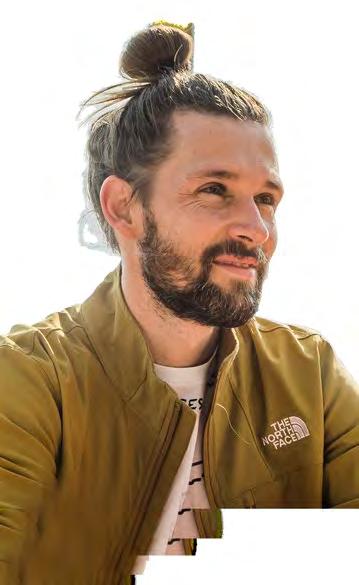
I’ve always been interested in technology and engineering, so I studied mechanical engineering at the University of Witwatersrand in Johannesburg. In my third year, my schedule opened up completely and I started getting involved in planning public events like comedy shows, and music events and that sort of stuff to get a bit of money on the side.
I found that it really indulged my creative sort of itch, and I enjoyed that. By the time I came back to fulltime studying, I was running a small company in the events space.
I realised that there are parts of the events world where you can immerse people in an experience, and it is within your control to create a production that completely spellbinds them and takes them through your portal into almost another world. I was running this company from 20042005 through to 2010. Then we started doing these events for brands. For example a brand like Stimorol, would commission us to create this amazing experience that would bring in lots of different kinds of lights and lasers and technologies and audiovisual presentations, combined with music.
What I didn’t really realise then, was that we were less in the event space, and more in the immersive experiences space, even though there wasn’t much technology like VR headsets and AR.
I started missing the engineering side of things and began to add more technologies into these human experiences, exploring interactivity and digital design more. We used technologies like motion capture, body scanning with Microsoft Kinect, RFID tech nology, photogrammetry, basically various different installations and ex periences.
Around 2014, I started hearing the word Oculus being mentioned on the web and on social media. I came across the Kickstarter page for Oculus, though back then it was the preFacebook Oculus, so it was Palmer Luckey’s Oculus and they were trying to get their first VR headsets crowdfunded. I decided it was a pretty awesome headset to be able to show potential clients what an event or space could look like. I thought of it as a pre-visualisation tool, so I ordered an Oculus DK1.
One fateful day, I found myself in a room with some executives from one of the South African banks. I’d spent years trying to get into this room, so I was a little bit nervous, and maybe a bit overzealous. I was just pitching lots of different ideas, trying to figure

out what it was they were interested in. I had this VR headset, and was pitching this idea of VR. I was like, “It’s amazing, you guys have to try it. You put this VR headset on your head, and it completely teleports you into another realm,” even though I’d never experienced it for myself at that point, and they said, “This sounds really interesting. Is it possible to put a real-world 360 scenario inside of your headset and have other people watch that back?” I asked them what they had in mind. They told me they had endorsed some jazz artists and if it was possible to create a digital experience where people could feel like they were part of the band. Right then, I had absolutely no idea if that was possible at all. So of course, I said yes.
A couple of days later, they issued a purchase order for this experience, and suddenly, we were thrown in the deep end. I called a friend of mine who was doing a lot of our video production work and told him we had to do something we had never done before. So, we set ourselves this skyhigh goal of filming in cinematic 360 with that 3D depth. What that looked like was me getting a block of wood,
and 14 GoPros, and a bunch of elastic bands from underwear, and literally stapling them into this block of wood for proof of concept.
Unfortunately, the proof of concept, while it worked, never evolved into anything more aesthetically pleasing, because the event was just a few days away. So, we rocked up to the set with our 360 camera and this Frankenstein rig on a rusted pole, which we hadn’t really tested. All we knew we could do was press record on all those 14 GoPros arranged in a ball and hope for the best. And that’s how we got into cinematic VR and into the world that we now call
XR.
I had absolutely no idea if that was possible at all. So of course, I said yes.
I thought this was going to be a side hustle, but my video editor friend and I were incredibly proud of what we achieved and both wanted to start a company on the side. He was running his production business, and I was running my experiential events business. We put up a website and said once every couple months when someone calls, and wants some sort of 360 video thing, we knew we could do it. And the phone started ringing within 24 hours of the website going up, and to this day it has not stopped. That was 2014 and we’re in 2022 still full time in the XR world.
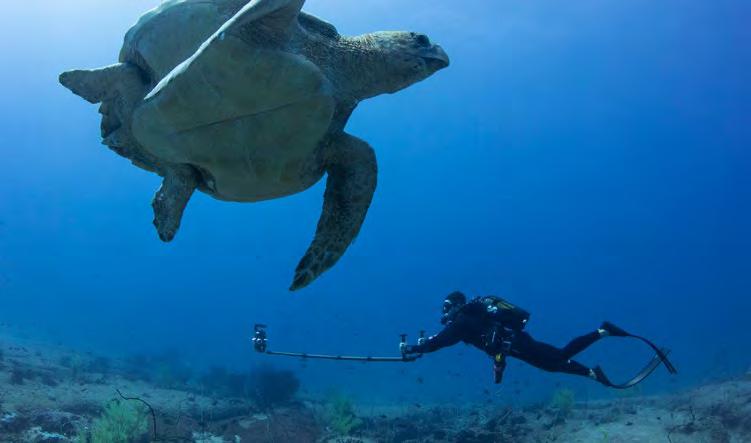
The first time I put a VR headset on, it was a very poorly rendered roller coaster experience. Initially, I wasn’t super impressed. I was in position on this roller coaster. It didn’t look great, the headset was a bit fuzzy, and I could see the pixels. Then the roller coaster started moving, and that completely made my brain do a backflip. As I was going up the steep part, just as you would with a regular roller coaster, I started sensing vertigo, which I don’t really ever feel, that feeling of being really high up and out of control.
But the part that stuck with me from the whole experience was when the roller coaster went downhill and proceeded to go into a left bank.
What you would normally do on a roller coaster is to kind of lean into the corner so you don’t just tumble out the other side, and I did that. But this was VR and there were no G forces, so I fell out of my office chair, which was really weird because my brain didn’t understand whether something was happening in the real world, but I was really scared in the virtual world.
That was the first moment I truly understood that this medium was incredibly powerful. Unfortunately, I felt nauseous for the next 12 hours and at night in my bed, my head was completely spinning. So, I wouldn’t say it was a great experience, but it was a powerful experience. It made me realise with that power, there could be some amazing experiences, if they were carefully curated.
How did you get people with the skills required to build for XR? Have you personally had any training in XR development and do you offer training for those who work with you?
I realised pretty early on that we needed to hire people who had some of the fundamental skills. In our early days, our focus was on cinematic VR, which meant that we were filming live-action with 360 rigs we were developing ourselves, and we needed people who could help us with the postproduction side of things. So, we were looking for people that understood Final Cut Pro and Premiere Pro. And what we needed to train them on, was how to translate 360 videos, and the process of stitching, for example, into traditional editing workflows.
To this day, we put people on a threemonth probation period when they join us, and that period is mostly for learning and understanding. In the early days, we didn’t know how to do it very well. We would bring a couple of guys on, put them on a salary, tell them they’ve got time to figure stuff
a lot of people ask me how they can get into XR. I wouldn’t advise studying anything, because I don’t think that theoretical skills are as valuable as practical skills just yet. And we’re living in an
age where so much information is democratised, so someone who’s figuring stuff out starts a YouTube channel and is doing tutorials. That is far more valuable than traditional places of education.
out, try the tools and we would put some budget towards software and other stuff like that. It worked out and not much has changed.
Have I studied anything in the XR world?
I just haven’t come across anything that actually teaches valuable skills. I did quite a fair amount of talks at conferences before the pandemic, and a lot of people ask me how they can get into XR. I wouldn’t advise studying anything, because I don’t think that theoretical skills
are as valuable as practical skills just yet. And we’re living in an age where so much information is democratised, so someone who’s figuring stuff out starts a YouTube channel and is doing tutorials. That is far more valuable than traditional places of education.
There were many 100-hour work weeks for the team, which were spent on experiences for consumer products and brands, some of which we didn’t necessarily feel anything for. We started questioning our actions.
Habitat XR is more impactdriven, what made you decide to go this route?
There were many 100-hour work weeks for the team, which were spent on experiences for consumer products and brands, some of which we didn’t necessarily feel anything for. We started questioning our actions. “What are we doing for the world here?”; “Are we really adding value by helping sell more baby wipes?” So, around the beginning of 2016, we decided to start a division within the main studio. That division was called Habitat at the time, and was about us taking some of the profits we’d made, and putting them into our own original work - stuff that we felt would be exciting, fun, potentially involve some travel - and then experiment with them from a storytelling and creative point of view.
But if we were going to compete on a global level against lots of VR
studios, our competitive advantage being in South Africa was access to nature. And we all love nature. It’s what we do when we’re not working. So if we’re going to these places on vacation, we could just take a rig with us,try filming some wildlife and see how it goes. That was the start of Habitat.
Habitat XR, was just a division within the company to essentially blow off creative steam, and as we started getting more and more into it, we realised we certainly enjoyed the work we were doing in Habitat more than the commercial work, but there was no way for it to pay for itself. So until I could figure out how it could pay for itself, we had to do commercial work, and kind of sell our souls for money, in order to fund stuff we really wanted to do.
The first one we did was called Exodus, The Great Migration. The whole team flew out to Kenya, during this natural phenomenon, when wildebeest migrate from the Serengeti, in Tanzania to the Masai Mara, in Kenya. So we thought of it as a nature documentary, but one where you’re inside surrounded by the action. When we started screening publicly, we asked ourselves, who would want to come to watch. We thought of the folks at WWF, Conservation International, and these conservation organisations and invited them. When they came to watch, their eyes were the size of saucers. They came to us and said, “Guys, we need you to make this kind of thing for us, we need to use this as a fund raising tool, we need to use this as an outreach tool.”
So we started making a bit of money, creating commissioned experiences for conservation NGOs, which was a super interesting process. And when we talk about being an impact-led studio, this is the kind of genesis of impact, making films for ourselves in immersive space, and then being able to put those films on the heads of high net worth individuals, and asking them to donate to the causes of these conservation NGOs.
“What are we doing for the world here?”Are we really adding value by helping sell more baby wipes?”
We work with conservation non-profits, and help them with fundraising. On average, they are seeing 12 to 1 return on investments. So for every one rand, or one dollar that they put into commissioning us to create content, they are on average, getting 12 times that back through these experiences.
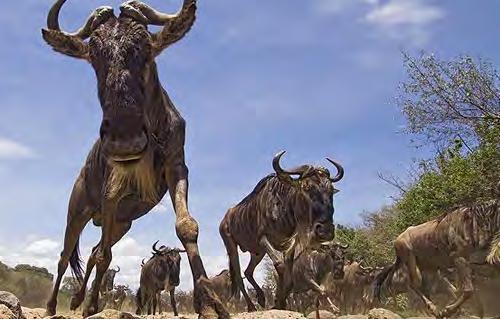
I think the thing I’m just so grateful about is the fact that we were able to achieve building a business model around impact work that also fulfils us. So, we’ve just got this beautiful overlap of having a compelling mission, super exciting technology and a bunch of really amazing people that we get to work with to achieve impact. Habitat XR is now the fulltime thing.
Our mission statement is to democratise access to nature using immersive technology. Democratising access to nature is really about making sure the distance, time and money that it takes to travel to be connected to nature is no longer a reason we don’t care for it.
A lot of what we are currently doing is exploring different technologies that are kind of evolving faster because of the pandemic, like social VR, for
example. We’ve done some really exciting stuff in the social VR realm, which is where multiple people can put on a headset in the comfort of their own home, but meet virtually in the same space, completely free of COVID, in environments that are completely up to us to create. I’d say the ultimate vision really is about trying to make sure human beings have the primal connections they need to nature, using all these incredibly exciting technologies.
We’ve been working with the Dian Fossey Gorilla Fund in Rwanda, who do a tremendous job at conserving the mountain gorillas which are a critically endangered species. We’ve been working with them to tell stories about gorilla behaviour that helps illustrate the parallels between gorillas and human beings in terms of those behaviours like family structures, feuds, best friends and enemies, and the very complex social environments around that.
We’ve done a few experiences for them, as well as their partner, the Ellen Fund, working closely with them and even Ellen DeGeneres herself, to help contextualise the
plight of mountain gorillas. The piece we did for Ellen was a particularly interesting one, because initially it was supposed to be an eight-minute long narrative experience about being around mountain gorillas.
So, we went out to Rwanda on the slopes of this volcano, where we found mountain gorillas doing what they do best and packaged that into a really cool experience. What we realised is once you put on the headset and make eye contact with a mountain gorilla, it kind of speaks for itself, so we ended up not even narrating the experience, it was just you and mountain gorillas for like five minutes.
The profound effect that it had on people was mind-blowing. The content was first used at a fundraiser in Los Angeles that Ellen was running for her foundation, and they raised $5 million in a single night. All
the Hollywood celebrities, like Julia Roberts, Leonardo DiCaprio and the Kardashians were there. Based on their work schedules and their geographic locations, it’s difficult for them to get out to see mountain gorillas for themselves in the world.
So for Ellen, when she goes to all of her Hollywood friends and says, “I want to save mountain gorillas, please make a donation,” the context is missing. They can show them photos or videos, but until you’ve actually been around mountain gorillas, you don’t really understand how profoundly amazing they actually are. And that’s what the VR experience achieved that night and Ellen totally understood that power.

Could you share an example of content that Habitat XR has created that is in line with your vision?The Habitat XR team deep in the forests of Rwanda Image courtesy of Habitat XR
How do you distribute the content you create, so that people can access it beyond screenings?
What distribution used to look like for us was bringing our Oculus Gos along when we needed to screen something. It was great as far as people being able to see things on the hardware that they should use, but we needed it to live beyond me and my team being in some physical location.
We recently finished building a permanent immersive theatre for the Dian Fossey Gorilla fund supported by Leonardo DiCaprio. It’s based on projectors, and we’re getting a lot more into that world, where it’s not just about content anymore. We are putting technical teams together that can create immersive installations where experiences can live on and service many people and touch many more 1000s of hearts and change their minds.
What kind of work goes into setting up an immersive space of nature, and how’s that different from just the work you do for VR headsets?
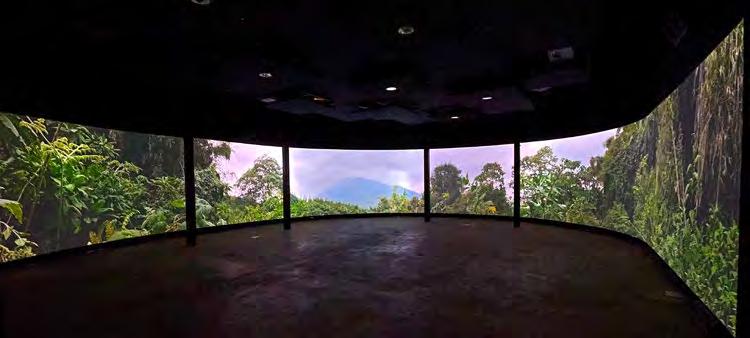
Part of what influenced the idea is that the pandemic has now obviously become a major force in the world, and sanitation is something that has to be thought of a lot more seriously. So as part of our contributions and work at the Dian Fossey gorilla Funds campus, there are actually VR headsets as part of an installation in an area. But we wanted there to be a space that could help recreate virtual worlds, without the need for technology to be worn or operated by the user, and you could bring a group of school kids into a room, and let their minds be blown away and let all positive things about immersive technologies and experiences overwhelm them, but with the ability to still see and interact with one another, their teachers or parents.
We built a 12.5m X 9.5m Oval Room. We got eight laser 4K projectors that project onto a very specialised projection screen. We also created a tensioning mechanism to make sure the screen is always completely taught, so we don’t have any of those shadows or defects in the wall, etc. The whole theatre is a 25k resolution theatre. The walls are 2.5mhigher than the projection face; and there’s a 10.2 surround sound audio system, so you’ve got spatial sound inside this theatre, which basically allocates the sound coming from where you see a lot of the screen.
We built a 12.5m X 9.5m Oval Room. We got eight laser 4K projectors that project onto a very specialised projection screen. We also created a tensioning mechanism to make sure the screen is always completely taught, so we don’t have any of those shadows or defects in the wall, etc. The whole theatre is a 25k resolution theatre. The walls are 2.5mhigher than the projection face; and there’s a 10.2 surround sound audio system, so you’ve got spatial sound inside this theatre, which basically allocates the sound coming from where you see a lot of the screen.
To get a laser 4k projector two years ago would have cost several tens of thousands of dollars per projector. We saw the same thing happen with VR headsets back in the day. Our first VR headset in 2014 required a PC and that whole kit cost maybe $5,000 and now, Oculus Quest 2 cost 200 or 300 dollars. So the same thing has happened with different technologies.
You’ve got obstacles that happen on the actual production side, and you’ve got obstacles on the consumer side of things. Nine years down the line, these things are no easier than they’ve ever been. Technology is evolving all the time, and so fast that nothing ever really gets a chance to perfect itself, which is always on to the next thing. That has been super challenging. But ultimately it’s about creating a human experience, and once someone feels that, they get it.
It’s the ability to embrace uncertainty and swat through problems no matter what they are that form the core tenets of the Habitat XR team. We hire people who have resilience with dealing with lots of things not working very often.
Even though we are in this space all the time, it’s still sometimes a little difficult to understand. There are lots of phrases that people have heard, but for them to be tangible, it requires people who understand it to explain it in really valuable ways. We can’t work with conservation partners if they don’t understand what they’re going to get and how it actually affects people. So that process is really hard, but we’ve been in this long enough to understand how to distil complex ideas down into bare essentials. I also think just being able to anticipate that things will always go wrong, has made us a lot more resilient toward that actually happening.
Social VR enabled Habitat XR’s clients to hold festivals during tavel restrictions in the pandemic Image courtesy of Habitat XR
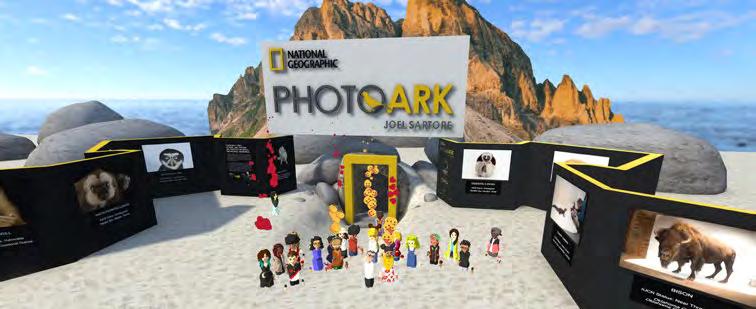
How are you able to get people to buy into new tech, especially when they are not very familiar with it?
GorillAR - an augmented reality extension of the Dian Fossey Gorilla Fund at the Ellen Campus, Rwanda. Image courtesy of Habitat XR
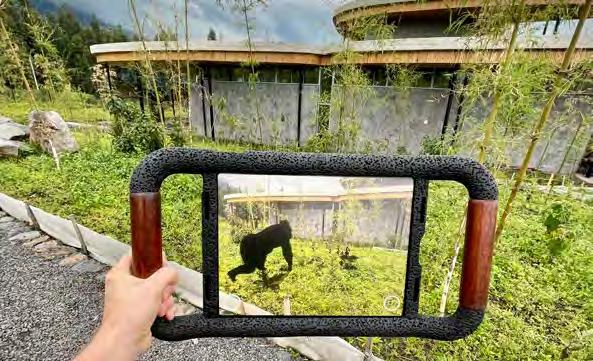
Is it possible for you to pick out a project that you consider most impactful or do you have one you’re extremely proud of?
That’s a tough question. There are so many things I’m proud of. We’ve overcome insane challenges in various ways on various projects, and I would say no project we’ve ever done was easy. I can certainly give you some examples. I’m very proud of what the fundraising results were for the gorillas. I’m very proud of a social VR project that we did in 2020. There was a Wildlife Film Festival that was supposed to happen in Durban, South Africa, and because of the pandemic, people couldn’t travel and congregate. They were going to cancel, but I got in touch with them and told them about Social VR.
It was such an incredibly technically and operationally difficult thing for us to pull off. We needed to acquire a whole bunch more VR headsets, but no one was shipping and all the
flights were grounded. So, what we did was literally ship our headsets to people who had enrolled for the event across like seven or eight time zones in about 16 countries.
We had 300 people engaged for a week in this virtual festival. It was an incredible experience for everybody.
Then the stuff we’re doing for Dian Fossey is really a glimpse into the future of Habitat XR. I think 25K immersive theatre is a phenomenal thing that exists in the world. We’re also doing an Augmented Reality experience for them. We’ve intentionally stayed a bit away from AR over the years, because we didn’t see it as being incredibly valuable and immersive just yet. It seemed like more of a gimmick. We were waiting for the technology to catch up and see what it could do.
The new Dian Fossey campus is an impressive series of buildings, where the immersive theatre exists too. They’ve got a wild garden, which is full of vegetation you would find in the gorillas’ natural habitat and there’s a pathway between the buildings. The AR experience, which is called GorillAR, is basically putting a photorealistic silverback gorilla onto the pathway amongst the real plants. He interacts with these real plants by feeding on bamboo and stinging nettle, and makes a nest to sleep in for the night, etc. Even though we’re not finished, I’m really proud of the fact that we were able to sell the idea to our partner, the Dian Fossey gorilla fund, and proud of the technical achievements we’ve made so far with its development.
But the single thing I’m most proud of would have to be the snow leopards we filmed in India. We were brought out there
by UNDP, India. They wanted to put an experience together for CMS COP, which is a conservation conference that shows the astounding natural beauty of the Ladakh province in northern India. Now, snow leopards are one of the most elusive animals in the world, and we had these very lofty ideas about being able to capture them in 360. The partners we were working with laughed at us, because they’d been camera trapping snow leopards for years and they understood their behaviour, so there was no way our idea was going to be possible.
I said to them, “It seems to me that if nature wants us to tell the story, nature opens a door, all we gotta do is walk through that door, and do everything we can.” We’d been in India for two weeks, saying we were going to get snow leopards and on the very last full day, when we were in the Ulley valley area of Ladakh, one of the village elders told us about some
weird marks in the snow, a couple of kilometres up on the hillside. And this was the Himalayan mountain range. So this old guy had a look through the scope and identified there was a disturbance in the snow. So, we got into the car to have a closer look and drove up as far as we possibly could. We took all our gear out, walked closer, put the scopes up toward the mountain side, only to see there were three snow leopards that had made an Ibex kill (it’s like a large goat). They were chilling on the rocks and the kill was lying in the snow. Occasionally, they would come off the rocks and feed on the kill. In a gap where they moved off for a few hours, we were able to get the camera next to the kill, and the technology worked in a way that it had never worked before. We were able to remotely trigger our camera from a distance further than we’ve ever been able to do, maybe because of the density of the air and cold and stuff. In the end, we got 45 minutes of
footage of snow leopards feeding on this ibex like a metre and a half away from the camera. It had never been done before. I can’t imagine it’ll ever get done again. On paper, it is impossible. It was just such a hugely triumphant moment for us. We even printed out a 2.5m long canvas of the shot of those snow leopards and we put them up in our main editing suite at the office as a reminder that there is no such thing as impossible.
we were able to get the camera next to the kill, and the technology worked in a way that it had never worked before. We were able to remotely trigger our camera from a distance further than we’ve ever been able to do, maybe because of the density of the air and cold and stuff. In the end, we got 45 minutes of footage of snow leopards feeding on this ibex like a metre and a half away from the camera. It had never been done before. I can’t imagine it’ll ever get done again. On paper, it is impossible. It was just such a hugely triumphant moment for us. We even printed out a 2.5m long canvas of the shot of those snow leopards and we put them up in our main editing suite at the office as a reminder that there is no such thing as impossible.

To film wildlife in 360, you need a camera on a tripod, usually within about five metres of whatever it is you’re trying to show, otherwise, it’s not a great experience. The benefit of a traditional camera is that you’ve got a fixed frame, and you’ve got a zoom lens. That means you can sit on the back of the vehicle, for example, and you can film a lion. That lion could be 100 metres away, but it’s
going to completely fill the frame of your TV screen.
But your 360 camera has to be very, very close to the action for it to be a good enough experience for somebody to feel like they’re really gaining access to this incredible moment in time. And from a cinematography point of view, what that means is that we have to be able to be where the action is,
and predict where that action is going to be, and that’s super difficult. For example, if you’re filming lions and you are standing next to your camera, you’re going to get eaten. So you have to be able to predict where the lion is going to be within five metres. Same thing with elephants, rhinos, gorillas, etc. That’s why it’s challenging to film wildlife in 360.
Top
the
Empathy. There’s a fairly huge amount of studies and white papers out there about this kind of stuff. There’s a physiological effect that takes place when a person goes into an immersive state. So when you, as a content creator, are able to create that state, which we call telepresence, there are amazing things that can happen for empathy. And basically, it turns a person from being just a spectator to being an active participant in an environment, an active witness in a scene, and makes you care a lot more internally about these things.
Research from the likes of the Stanford Human Interaction Lab, and some of the stuff that’s come out of Cambridge, and the UK and the health system, show virtual nature is incredibly important and powerful. And we know this through objective forms of measurement, such as heart rate, pupil dilation, galvanic skin response, etc.
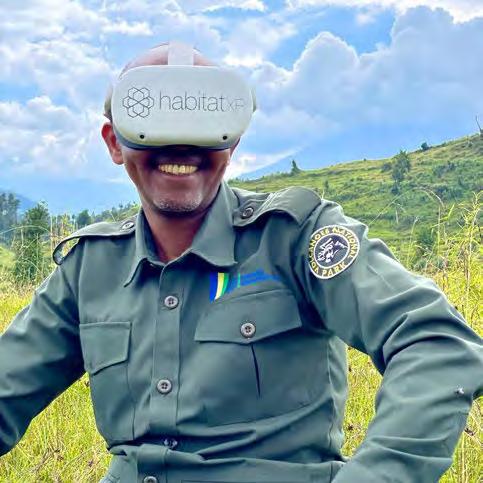
Some people are concerned from a behavioural point of view. They understand that it’s cool if you can stand next to a wild lion in VR, but kids can go to a game reserve and think they can do the same. That’s one form of scepticism.
Another form of scepticism says there’s no replacement for nature, you have to be truly present to know what nature feels like. What we do
is that when we communicate with the public, partners and clients, we try to take the technology layer out of those conversations, so people don’t feel overwhelmed.
Usually about 98% of the scepticism we hear about is completely silenced by people getting their own experience. They get this “aha!” moment.
We have different tools for different outcomes. If we’re talking about cinematic VR, you need really highend editing computers. So we use a combination of Apple and PC-based computers. Our current favourite camera to film with is the Insta360 Titan, it’s a really big camera. A lot of people don’t like it because it’s heavy, and because stitching is hard. We’ve got some cool spatial audio microphones that record sound in 360 we then pair with the 360 footage.
We also do a combination of things like photogrammetry, where we use traditional photographic cameras to 3D Scan assets in the world, like plants and rocks and trees. We’re getting to a point where we’re going to be 3D scanning real-life wild animals and bringing them into these virtual experiences. Currently, the best headset we are working with is the Oculus Quest 2. It does a lot of great things for us, including inside-out tracking. We’ve still got those 150 Oculus Gos, so we’ll use those for big groups of people. I still think it’s a very important device.

We certainly have struggled. You can’t buy iMac Pro machines in South Africa, they have like a twoor three-month waiting list and are far more expensive to buy locally. So what we did for that is we actually sent a guy to Dubai, who went to the iStore, bought two of the iMac pros, and got on a flight back. We saved thousands. So we decided to use this option whenever we needed more hardware.
Another time, we needed to get 50 headsets, and the Oculus Go didn’t exist yet, so we looked at what the phones cost in South Africa, and compared them to Amazon. It was so much cheaper. So we called up a friend, Haley, in the US and gave her an offer to come to South Africa on an all expenses holiday with a friend if she would bring 50 cell phones. We ended up saving several hundreds of thousands of rand which is several tens of thousands of dollars. We also used to go to the States at least once a year to stock up on equipment, because it is so much cheaper at the end of the day.
Could you tell us about the equipment you use?
How easy was it for you to be able to access all this hardware?Friends in high places - the camera and audio rig used as part of Habitat XR’s arsenal. Image courtesy of Habitat XR
What are your thoughts on the representation of Africa in the global XR space? Do you think we are adequately represented?
Not at all, not even close! I think we are fighting against some very old preconceived ideas - outside of the African continent - about what Africa is capable of, and I think we’ve all been born into an era where it’s now our responsibility to challenge those conventions and ideas, by blowing people’s minds. The Dian Fossey project with the Irmelin DiCaprio immersive theatre is a great example of that. It was completely designed by South Africans and built by South Africans with its content fully produced by South Africans. And
now, the most impressive panoramic projection theatre in the entire world is literally in the jungles of Rwanda. In many cases, we are ahead of the rest of the world, and there are some incredible minds, artists, technologists, and technicians working in this space, so I don’t think Africa has a rep for that. But the more examples we can put out into the world saying this was created in Africa by an African, the better.
I think we are fighting against some very old preconceived ideas - outside of the African continentabout what Africa is capable of, and I think we’ve all been born into an era where it’s now our responsibility to challenge those conventions and ideas, by blowing people’s minds.
What are some of the biggest challenges you face as an XR Creator in Africa?
Besides generating revenue which is a constant challenge, you’re having to deal with technologies that people don’t understand, so you have to find a use case, something people are willing to pay money for.
There aren’t massive pools of budget available. We’re for profit so we have to create something in exchange for funds that exist. Those funds that exist on the continent are quite small, so our way around that is by trying to work with partners who operate in the US or who are based in the US but operate in Africa. So we have African stories, projects and installations that are funded by US dollars.
The other challenge is finding people who we can hire today, who can start working today. You know, rather than trying to find people who’ve got fundamentals, like a video editor, but now need to spend three months teaching them high-end stereoscopic stitching, roto paint and stabilisation, we find ourselves in a tough place where we have a very high bar for the quality of work we want to produce, but at the same time, we have a very strong insistence that we should be sourcing from the continent.
Narrowing those two ideas has been very challenging for us for every year we’ve been around.
Could you give us a sense of the size of your team?
We’ve got a core team with everybody based here in Parkhurst, Johannesburg. Then, we’ve got a team of contractors that come out on a several month basis. So the core team at the office, and the guys who are working on stuff all the time are a team of eight. It kind of fluctuates, but it’s about 13 people, as part of the expanded teams of people who are on contract with us. So yeah, it’s still small, but bigger than we have been in the past.
What are some misconceptions you’ve encountered about the work you’re doing as an African XR Creator?
Because you are from Africa, you can produce substandard work. Otherwise, I feel like we deal with misconceptions about technology more than we do about the fact that we’re from Africa.
What kind of community events have you been engaged in and what are your thoughts on the African XR community?
I think the African XR community is getting more interconnected than ever. weareVR is a WhatsApp community of probably about 150 to 160 different people from all over Africa. We’ve got creators from Rwanda, Chad, Nigeria, South Africa, Botswana, and Ghana, which is just super exciting.
Even though Africa does get a bit of a bad rap, one of the things I do think Africans are super good at is doing an amazing job with less, and just being far more resourceful. External funding into a business, like from a venture capital, is an unhealthy thing. I think the challenge with venture capital funding is if you take a million dollars from some venture capital firm who will then take 65% of your business, you’re not incentivized to ever create value, you’re incentivized to market, bring in new rounds of funding, a flashy website to hire a bunch of staff, to have a kick ass office, with pool tables and beanbags. But at the end of the day, the emphasis on creating true value, which is what I think all businesses should be doing, is deescalated and deprioritized.
We’ve had buyout offers, but we’re not really interested in having that conversation, because we want the pressure on us to always create value. Also by creating value, we are earning money. What we found is that creating original content is often a great proof of concept or a calling card that results in a commission. So to put that into perspective, for Exodus: The Great Migration, we put about 30,000 US dollars of our own money into creating that whole project, marketing it, renting venues, showing some people, trying to get it up onto the Oculus platform, etc. We never made money from people coming to watch it at the events. We never made any meaningful money in that way. We made no money trying to sell Exodus on platforms. People just weren’t in a place where they were willing to pay a premium amount of money for it. So from that point of view, there wasn’t
any revenue, that was a big failure. However, we showed the experience to WWF and they turned around and said, “Well, we’ve got $10,000 or $12,000, we want to put into commissioning you guys to create something.” We then took Exodus: The Great Migration to a Nature Film Festival in the UK called Wildscreen.
There were some people from Wildscreen who just so happened to want to do an experience with Lupita Nyong’o. They met us, and they realised we’d already done this. So instead of commissioning these British guys to do it, they were going to commission us and it was like 50,000 to 60,000 thousand US dollars. Suddenly, we’ve made more money on commissions because of the fact that we took the risk on original content.
We’ve also begun a licensing business. Since our teams have been out in the wild filming lots of different species of wildlife in the cinematic VR offering, a lot of that content belongs to us and increasingly, when we go out there, we charge the client less in exchange for being able to retain some rights to our own content. What that means is, we’re now sitting on the world’s biggest library of wildlife VR content, and in a world where production crews from the US and from all around the world can’t travel to shoot, they are licensing the stuff from us, which is really cool. So that’s another way where some of the originals in the work we’ve done at risk are starting to pay off. Some of the licensing deals that exist out there for packaged content are in the 10,000 to 15,000 US dollar range. And you can licence that four or five times to different people.
Could you tell us about some of your other projects and products, and your business model?
If you had access to more funding, what would it do for you?
I will put money into building a bigger, more hyper-specialised team where we aren’t necessarily changing the hats we wear. I’d develop capacity internally and then knowing that we have that capacity, start shopping for more projects and longer term projects.
What role do you think big companies like Meta and HTC can play in engaging creators on the African continent or changing the industry in Africa?
What kind of policies do you think policymakers can create to support the XR industry?
I think it’s less about XR. It’s more about storytelling, filmmaking and game development, all those worlds together need more support from governments. Whether it takes the form of tax incentives, grants or subsidies. These will be amazing things to help encourage more people to get into these realms and to keep businesses alive. I know several businesses in Africa, XR businesses that have had to close because it’s a tough industry with very little support from the people we pay taxes to.
I think that Meta (formerly Facebook) gets a really bad rap from a lot of people. I’m quite in their court for a couple of reasons. A lot of people don’t realise that Meta is subsidising the cost of VR headsets for the big picture. So I like the fact that they’re actually making a loss on their VR headsets so that we can get access to a device that is powerful for that price point. Building an actual product is a very difficult and incredibly expensive commitment and they’re actually doing it and I’m excited about that.
I’ve got to know them a little bit more intimately because of the fact that they’re a client partner. We’ve distributed stuff through them and they’ve really backed and supported it. I have to say that I haven’t experienced much scepticism or hesitancy from them because of the fact that we are an African-based studio. I think they are quite eager to engage with people around the world, and they’ve done great things for the industry.
I think that it’ll just continue to grow and flourish and find its feet. My hope is that the continent of Africa will produce on the same level as anywhere else and kind of remains at the forefront of a lot of the new developments in each of the different XR technologies.
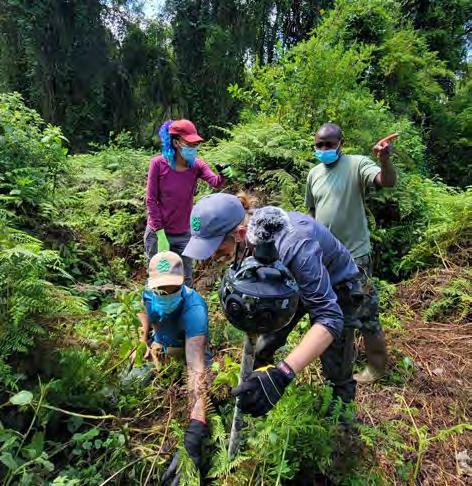
I’m most interested in tertiary education, picking up the mantle and actually starting to teach some of this stuff formally and in a really valuable way. I hope to help to form curricula so that more and more people actually have these skills, realising that there is a job marketplace for it.
We need more companies starting across Africa that can employ these guys coming up with the skills and in creating more projects that are furnishing the needs of whatever industries they’re working in. I just hope that XR becomes more saturated with companies, competitors, work and with the skill base that we need to keep the stuff on the continent.
Where do you see XR globally and in Africa over the next year and let’s say the next ten years?The Habitat XR team deep in the forests of Rwanda Image courtesy of Habitat XR
TMRW (The Mixed Reality Workshop) is a South Africa based digital gallery and collaborative space. Since opening its doors in 2018, TMRW has hosted and run more than 20 exhibitions. Unlike traditional art galleries where visitors are expected to remain passive and simply look, TMRW invites the audience to immerse themselves in the experience. TMRW is focused on collaborating extensively with artists to explore the fascinating intersections between contemporary visual art, technology and mixed realities. Currently, on a sabbatical, this is the story of TMRW, some of the unique challenges it faced and what the future holds.
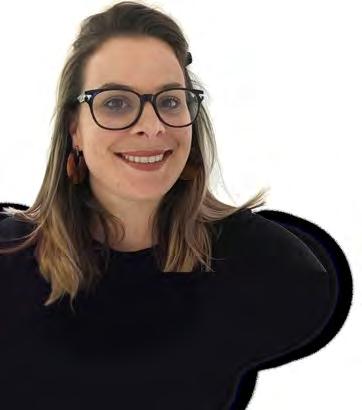
Combining in-depth knowledge of contemporary art, business management and creative production processes with technical and networking skills to produce and project manage an array of creative endeavours. Applying skills and knowledge acquired leading an acclaimed production company for 12 years to the contemporary art industry.

Carly Whitaker is an independent curator, researcher, designer, and artist based in Johannesburg, South Africa who focused on the digital medium. She holds a MA in Digital Interactive Media and is currently a PhD candidate at the University of Reading in the UK researching curatorial networked methodologies in South Africa. Whitaker is interested in the positioning of artistic research and investigating how artists can develop a practice online through and with the medium. Whitaker started Floating Reverie, an online digital residency programme in 2014, and Blue Ocean in 2021 which is an online digital art space. Whitaker was the Artistic Director of The Mixed Realities Workshop, in Johannesburg where she worked closely with artists to support their digital creative practice. She is currently Head of Digital Product Design at Umuzi, a tech and design NGO in Johannesburg.
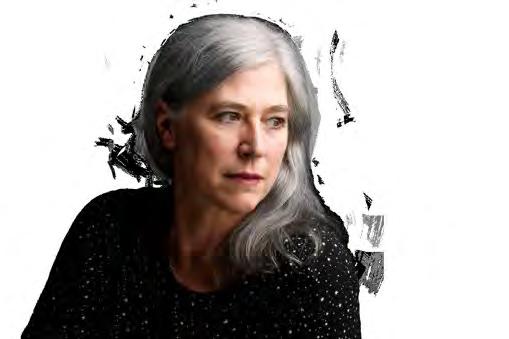
TMRW started after Ann Roberts and creative technologists Rick Treweek and Gareth Steele from Eden exchanged ideas for a dedicated digtial art gallery during Season 2 of William Kentridge’s Centre for the Less Good Idea. Ann Roberts, a filmmaker with a portfolio spanning over 25 years, met During her film career, Ann worked predominantly in advertising with a concentration on television commercials. With a career spanning such a long time, she has had a front row seat experience of the growth of digital technology over the last three decades; she has watched filmmaking go from celluloid to digital.
Ann mentioned in an interview that one of the things that stood out for her during her career was the disconnect between artists and the emerging technologies of the 21st century. In her own words:

“I realised there were artists who didn’t have access to technology and expertise to achieve high production values for their work .”
This problem was further emphasised for Ann when she crossed over from advertising to art through a mentoring project she did with the Centre for the Less Good Idea (www.lessgoodidea. com/). For the centre’s season around tech, Ann, with the help of Gareth Steele and Rick Treweek (now of Eden), gave artists the opportunity to interact, learn and collaborate in augmented and virtual reality. This experiment illustrated for Ann what happens when artists are given access to technology and experts to guide and train them into creating digital art with digital technology. This is where TMRW was born.
- Ann RobertsThe idea behind TMRW Gallery was to give contemporary visual artists access to technologies and creative technologists to guide them and see what they would be able to do”
With the help of partners at Tomorrow Co and Eden, The Mixed Reality Workshop was set up as a not for profit company (NPC) including a physical space in the Trumpet Building, Keyes Art Mile, Johannesburg (the TMRW Gallery.) The workshop’s purpose was to connect artists with the technology and the skills to create digital art. The physical location
served as an opportunity to answer questions about how digital art could be showcased in the physical world. More than 20 exhibitions later, TMRW was able to impact the world of XR and art significantly. For many of the artists they collaborated with, they were able to, for the first time, not only create digital and immersive art but also showcase that art to an audience.
One of the earliest exhibitions hosted by TMRW was Mary Sibande’s ‘A Crescendo of Ecstasy.’
Produced by Eden, the exhibition was a collaborative effort between the gallery, artists and technology. Going into this exhibition, Mary Sibande had an extensive career working with sculptures and still art. This was her first time working with animation. According to Ann, Mary said working on the exhibition was her first time dreaming about her work. The exhibition consisted of both physical and virtual elements. On walking into the space, the audience was greeted by Mary’s sculptures suspended from the ceiling. VR headsets attached to an image of Mary’s face took the audience from the physical gallery featuring the installations into a mirror virtual world where the sculptures came to life. The work has travelled to the Havana Biennale and Moody Art Centre in Texas.
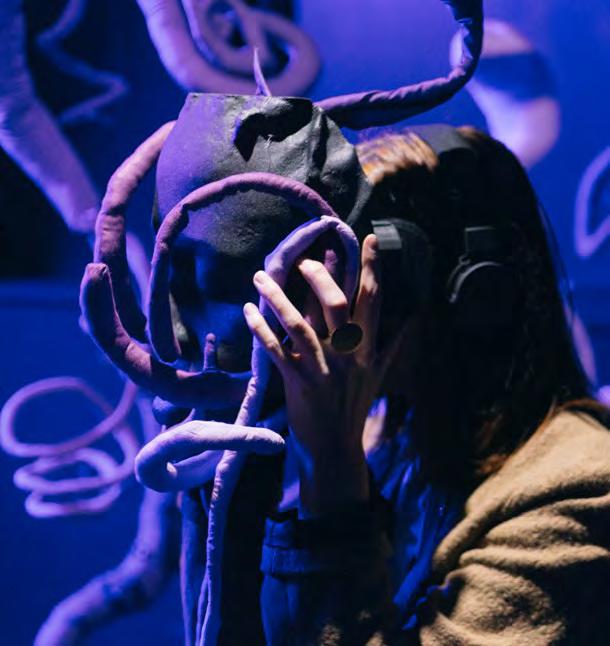
The gallery was constantly morphing for the exhibitions it held. Often guided by the artist’s vision and what techniques and technologies worked best for it, these exhibitions employed everything from VR headsets to projectors and AR apps that used physical artworks as markers. Carly Whitaker, who started working at the gallery in the middle of the pandemic had this to say about the fluid nature of the gallery:
“Every exhibition is different. It really depends on the show, the artists and what sort of different technological me dium they’re working with. Primarily, it’s about making space for the view er and the audience to really immerse themselves in something unique and different. It’s about shifting a mindset around artistic practice.”
Carly is an artist and curator working primarily in the digital space. She has a fine art background with a master’s degree focusing on digital interactive media. She is currently doing a PhD researching curational methods. She also runs a digital
residency called Floating Reverie. She served as the Curatorial director for TMRW Gallery from 2021.
She described the work of the gallery as an opportunity for artists to explore the digital medium without the barrier of learning new technical skills.
“For artists, initially, it felt like you had to learn a lot of the skills yourself. And I think what’s really nice about TMRW - is that artists can come to us, and they don’t have to have all the skills. They don’t have
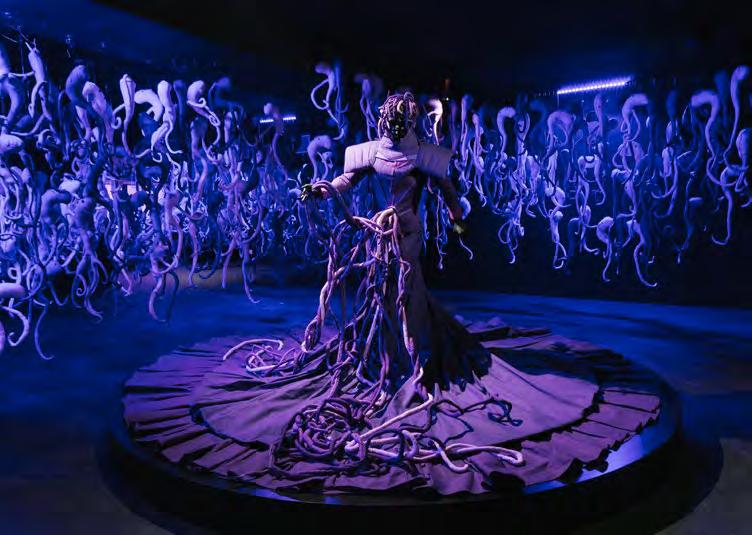
to know how to render or if it will work in VR. We can help them and teach them how to do that. Or they can translate their ideas for us and we can work a little bit more closely with different technologists to make sure that we execute the vision that they have.”
TMRW Gallery hosted both group and solo exhibitions from many artists including Kombo Chapfika, Mary Sibande, Aluta Nuli, Nathan Gates and many more. You can find a full list of their exhibitions on their website.

For artists, initially, it felt like you had to learn a lot of the skills yourself. And I think what’s really nice about TMRW - is that artists can come to us, and they don’t have to have all the skills.
They don’t have to know how to render or if it will work in VR. We can help them and teach them how to do that. Or they can translate their ideas for us and we can work a little bit more closely with different technologists to make sure that we execute the vision that they have.”
- Carly WhitakerTMRW had to close its doors in March 2020 due to the Covid-19 pandemic. A big part of the mandate for The Mixed Reality Workshop team is to have this physical space where people can interact with digital art. Their work, as Ann sees it, is to come up with new ways for people to engage with digital art. With the pandemic, the gallery had to think of ways to keep that mandate going even without being able to welcome people to a physical space. This is just one of the unique challenges running a gallery of this kind has involved. The gallery eventually adapted to the pandemic and hosted some of its exhibitions virtually. In 2021, they opened their doors again for physical events but in the new world, having to think of safer ways to host these events.
“Cable management is a challenge. That’s definitely one of them. There are a lot of technical challenges. it’s a lowkey one but there are lots of technical challenges that can emerge often in installations and exhibitions.”
Carly mentioned that working with technology provides a unique set of challenges that you might not find with traditional art exhibitions: knowing what USB cables work for certain screens, keeping devices charged during an exhibition and the general logistics of having installations done in a space acting to bridge the gap between the physical world and digital art. TMRW’s work in the field has helped write the

playbook for working around these challenges.
Another challenge that came up in our conversation with the team was commerce. There is a unique question of how to create a sustainable model to continue to showcase art like this. During its running time, the TMRW Gallery did not work with a revenue generation model. As an NPC, The Mixed Reality Workshop was able to sponsor its projects and exhibitions through the generous contribution of financial partners. Finding new financial partners and a sustainable business model is one of the challenges the team is hoping to solve in its next iteration.
The rise of NFTs and the metaverse concept have begun to present new possibilities for digital art. There are considerations to be made and a healthy amount of scepticism related to the possible drawbacks of the current rave and buzz around the medium. The encouraging thing is that conversations are happening now and the world is becoming increasingly receptive to immersive technologies.
In 2018, when the gallery first opened its doors, it had to not only convince artists but also the audience. According to Ann, the majority of people that visited the exhibition were experiencing AR and VR for the first time. The feedback from this first-time audience was incredibly enriching for everyone involved. Carly reported
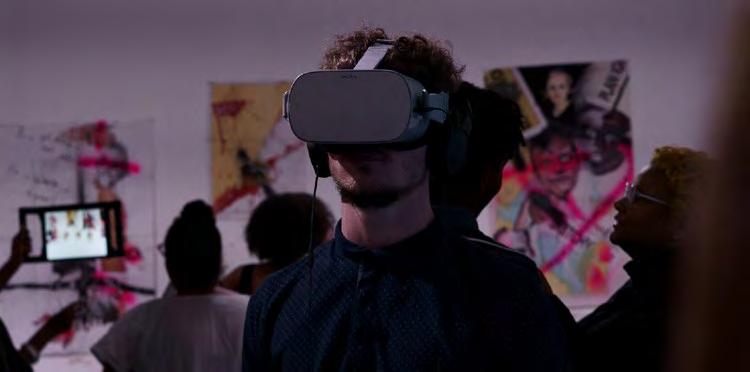
“That’s one of the most amazing things for a curator, to know that your audience has been affected by the work you’ve presented, and for all these different artists coming together on that specific group show (re: Digital Gardens), I think none of them maybe saw that. But it was really beautiful.”
TMRW embarked on the ambitious journey to redefine how the physical world engaged with digital art and was able to find a level of success for over 4 years. Now, in its sabbatical, the team is musing over ways to solve some of the challenges they weren’t prepared for in their original model. It is uncertain when the Gallery will open its doors once again but it will return with a physical space to continue doing the work it set out to do.
The TMRW has not died, TMRW is on pause/ hiatus at the moment. It astonishingly survived the lockdown despite there not being a physical space, Carly Whittaker did an amazing job of that. We haven’t disappeared and I do think it’s going to come back. We aren’t sure what form it will take but it will always have a physical space.
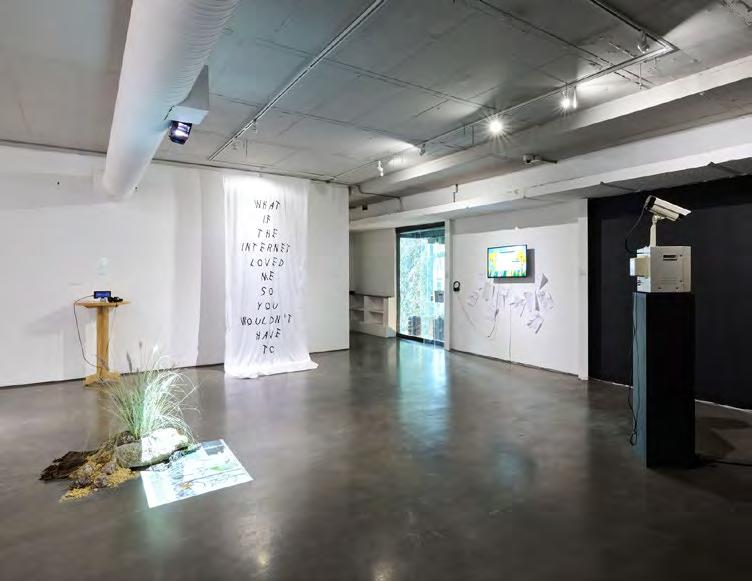 Ann Roberts
Ann Roberts
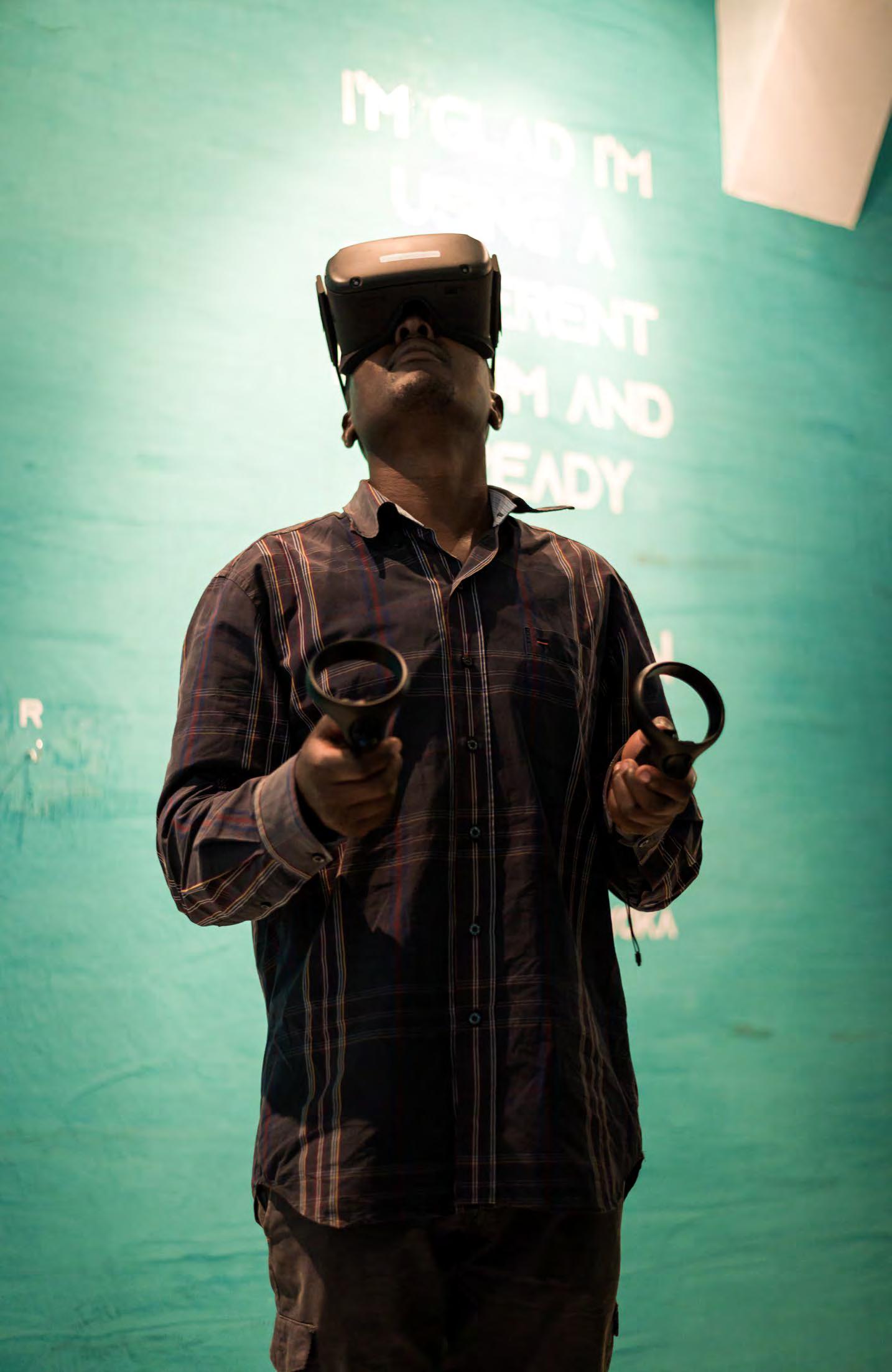
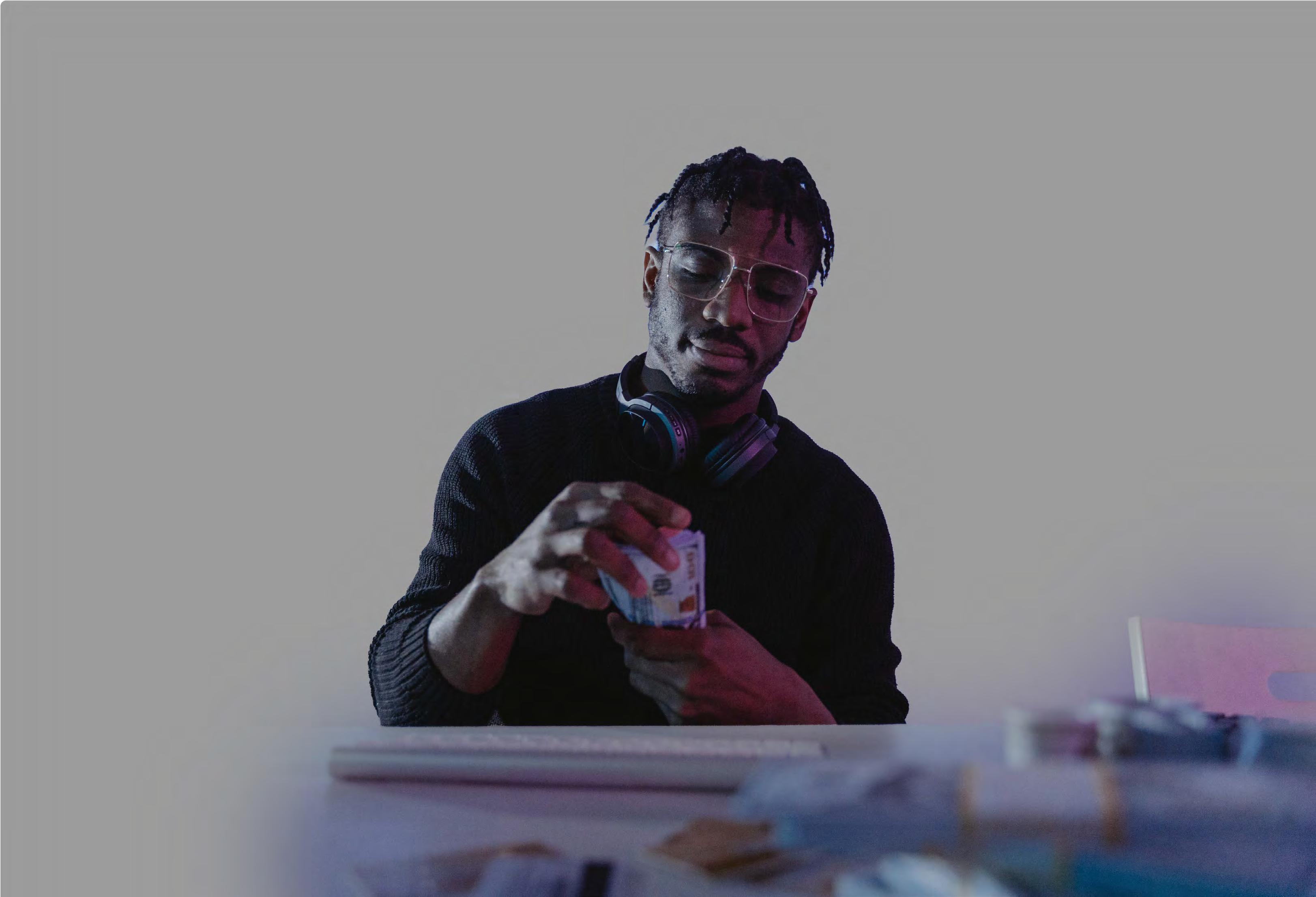
Our jurors made the final selection with support from the editorial team. We present the 2021 winners of the Africa XR micro-grants.




Our thanks to the jurors -
Brian Afande Black Rhino VR Kenya
Ohu Lagos Business School Nigeria
Maged Farrag 5d VR Egypt
Tegan Bristow Wits University South Africa
We are thrilled to offer competitive microgrants to the participants of this study. We received 58 applications representing a range of sectors, including academia, the arts, community development, and public health.

South Africa
I’m currently working on Inheritance, an AR Comic IP that builds from my Masters Research as a business model. I aim to revitalize the comic book industry and encourage a love of reading and technology among African youth. I have a small team of developers and illustrators assisting me with making a 5 page MVP that we shall use to seek funding, competitions and investment for Inheritance. Inheritance is a black and white, fantasy comic book that uses AR (Augmented Reality) elements to bring the monochrome pages and characters to life. The comic uses a smartphone app to introduce animation, interactivity and participation to the comic as a means to gamify the reading experience. The end goal is a regularly published and released series of comics and
inspiration that started his career as an artist. He’s been drawing for as long as he remembers, capturing the eye of multiple art enthusiasts and teachers who helped encourage and mentor him from Junior School till University. Well versed in both traditional and digital art, he strives to capture a level of realism that is balanced by expressive, evocative themes. Exploring multiple mediums and experimenting has always been a highlight of Athi’s inspiration, as often the best ideas are birthed from mistakes that become discovery.
The microgrant shall assist in creating an art studio dedicated towards putting Inheritance AR comics into the world. I already have a tax compliant, registered company. So the grant would primarily be used for printing, publishing, distributing and marketing the comic book globally as a 20 page Issue 1. I’d like to be able to pay my team a salary for their hard work, however we are all involved to create content first and get paid second after the content is out into the world. Any funds left after creating Issue 1 shall be split as a salary for the team. A more in depth breakdown of fund allocation and financials is available on request.
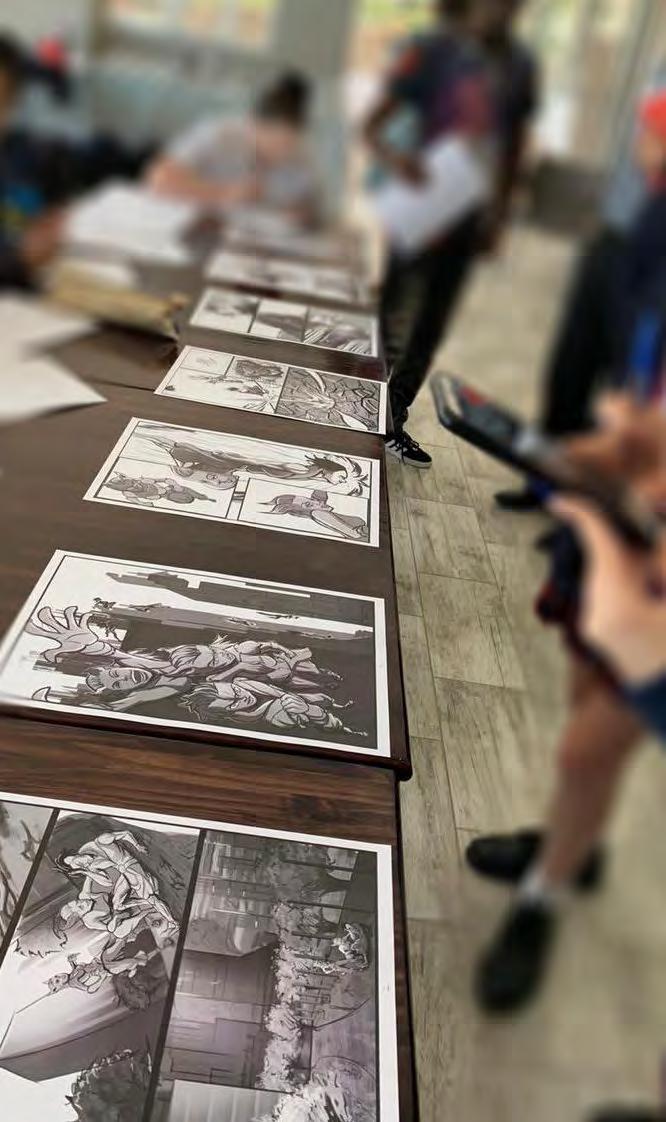


Chao Tayiana Maina is a Kenyan digital heritage specialist and digital humanities scholar working at the intersection of culture and technology. A computer scientist by profession and a historian by passion. Her work primarily focuses on the application of technology in the preservation, engagement and dissemination of African heritage. She is the founder of African Digital Heritage, a co-founder of the Museum of British Colonialism and a co-founder of the Open Restitution Africa project. She holds an MSc International Heritage Visualization (distinction) from the University of Glasgow and a BSc Mathematics and Computer Science. Her research work explored the possibilities of embedding intangible histories in 3D digital environments. She is a recipient of the Google Anita Borg scholarship for women in technology. Her work has been featured in the New York Times, Reuters, BBC news, BBC Arts, Ntv, KBC and 3Sat
This project seeks to gather knowledge on African astronomy and digitally replicate indigenous interpretations of the African sky. Africans as the earliest humans are also the oldest star gazers. Yet representation of African indigenous astronomy on a global scale is severely limited. This is further worsened by stereotypes that Africans did not have complex scientific interpretations of their natural environment before Europeans came.
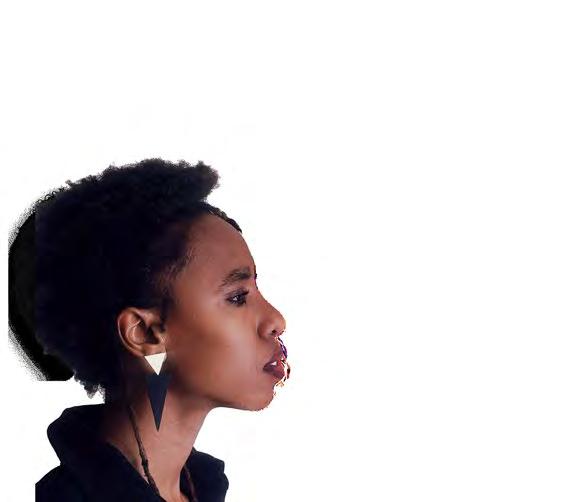
The aim of the project is to gather and digitize indigenous interpretations of the sky by gathering perspectives from various Kenyan communities. What did the Samburu see as Orion rose in the eastern sky? What did the Maasai call Venus, the morning star? How did the Borana calculate their years using stars? These are the kind of questions we would like to answer and represent in a digital format. We aim to create an VR experience that will show how different communities interpreted the sky as well as the narratives and stories they shared.


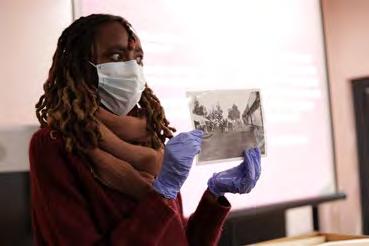
A seasoned software engineer with 2 years of experience as an XR techpreneur. Confident runs Augmented Future, a startup enabling engagement in learning, and supporting businesses to thrive using augmented reality technology.

We are developing quickAR a no code augmented reality platform for content creators. It takes high resources to develop your own AR app, high time to learn AR development as well as high resources in hosting and other IT services. We solved all of those by developing usequickar.com where creators go and upload markers (images to scan) they want as well as AR contents to display over them namely videos, images, webURL, youtube videos and audios and it becomes instantly detectable by quickAR mobile app.
We will use the microgrant in paying iOS developer account, deploying ios app , digital marketing and running awareness campaigns in content creators based in Eastern Africa who are using AR or who have not yet explored it.

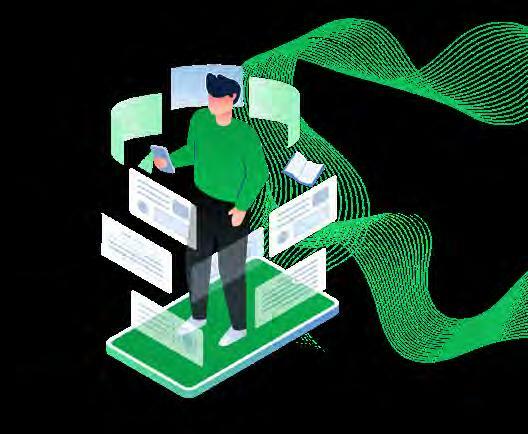

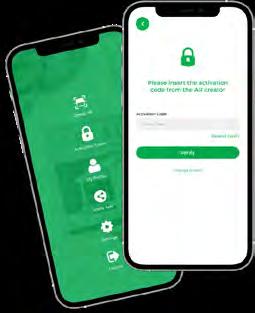
Uganda
and GIZ in Zanzibar. The short film “Crying for Help” won best short film at the prestigious Uganda Film Festival organised by the Uganda Communications Commission in 2014. Since June 2016, he has served as the festival director for the Gulu International Film Festival, an annual event that takes place at Taks Community Art Center-Gulu. He started creating VR videos in 2020.
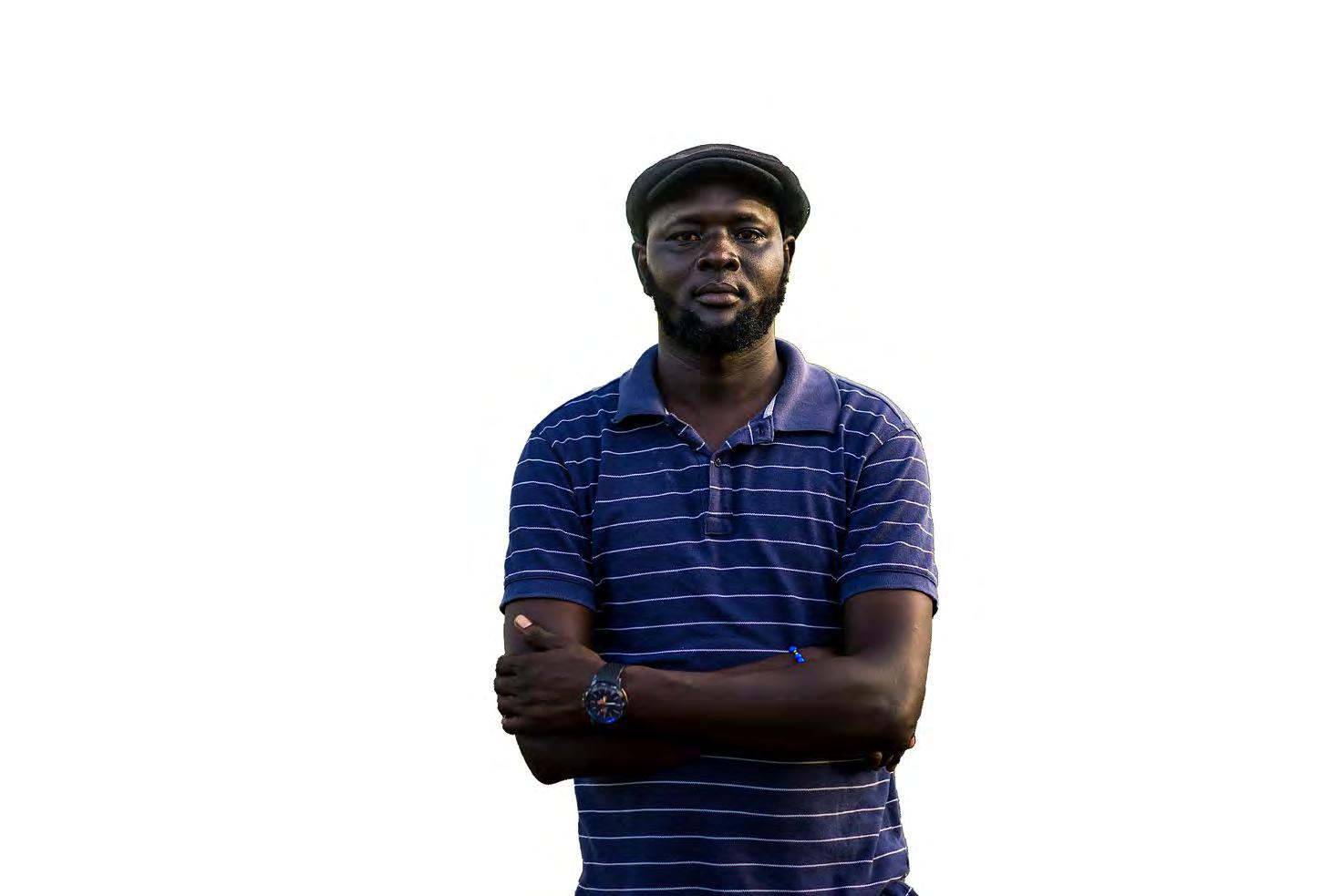
Cinematic 360

Idiat is an emerging freelance virtual designer, who is passionate about art and technology within the fashion and game industry. I specialize in 3D virtual garments creation and XR.
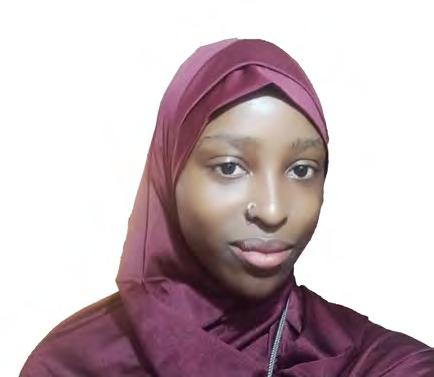
As a creator, she simply follows her curiosity by blending unique sources of inspiration that naturally evolve into more refined and distinctive concepts. I enjoy transforming, translating, and transferring talents in various digital applications to broaden my artistic horizons.
Welcome to her reality - the intersection between Technology, Art, Fashion and Games.
My concept is to create a virtual African fashion and textile museum that would feature both historic and new African fashion and textile designs. The virtual museum will be aimed at delivering a diverse, innovative, and engaging program of educational courses, talks, events, and workshops. The museum will allow African artists to co-exhibit their virtual fashion creations and offer them a permanent exhibition space where their African fashion wears can be displayed in perpetuity. This will make the virtual fashion museum a dynamic space with a broad range of innovative African fashion and textiles from across the continent. Clothing, I believe, is an important element of African culture and heritage, yet it is slowly fading. By creating this virtual museum, we will not only be preserving but also digitizing the African attires both past and present for the future generations and the audience outside of Africa.
The virtual fashion and textile museum will feature clothing from as far back as the early centuries that was known to be African clothing. I understand the importance of clothing in bringing history to life. The virtual museum will begin by publishing clothes worn by African SuperHeroes (Gods and Goddesses) like Sango. I will then proceed to occasional and daily clothing worn by individuals during those eras before working on present day clothings.
The grant would be spent on more documentation of clothing in Africa that would be included in the Virtual Fashion Museum. At the moment, I am looking to get more historical clothings from Africa and I think this grant would be a great resource for me to use to accomplish more documentation.


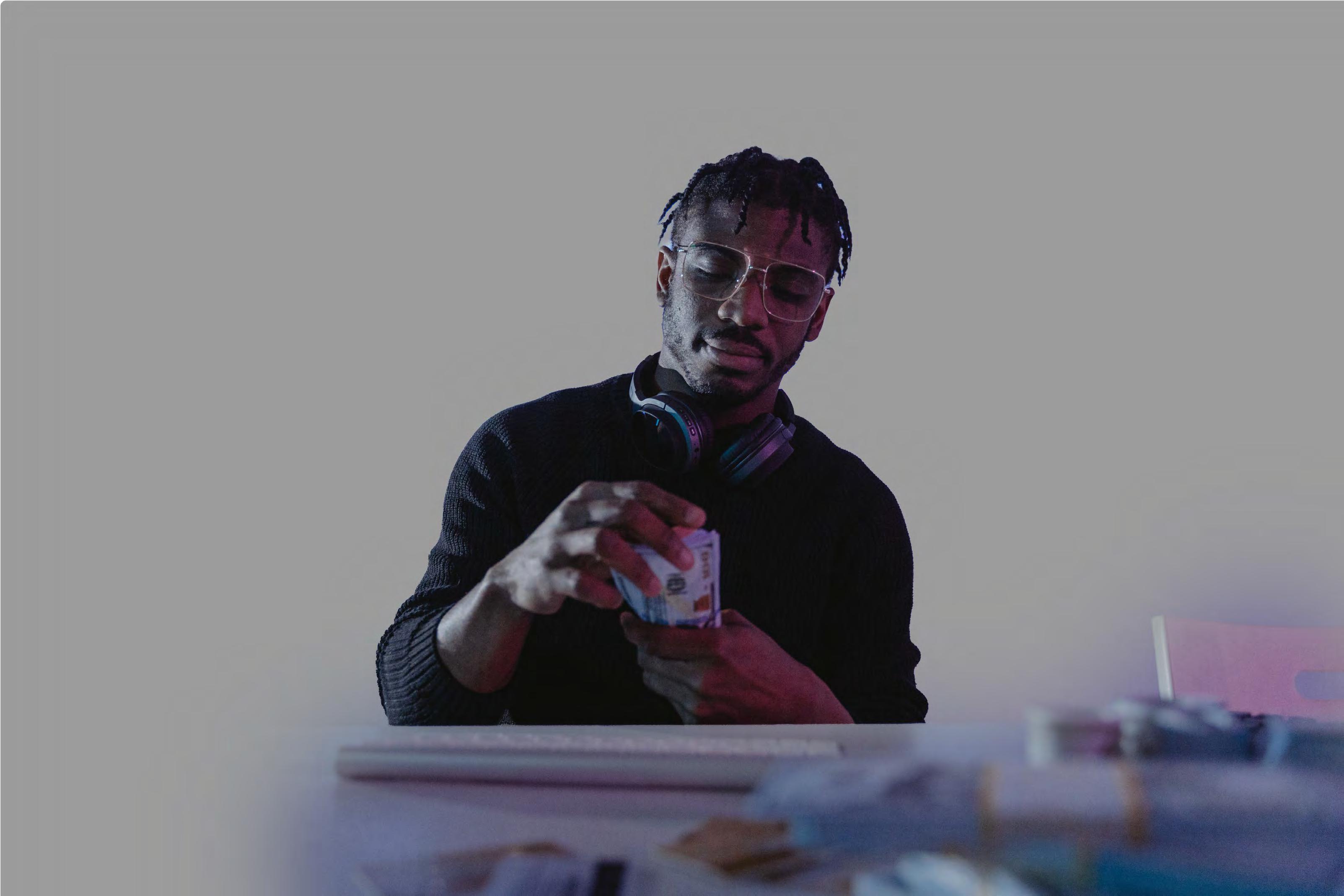
The pandemic accelerated reliance on the virtual that had been resisted in organisations for several years. While this resistance was anchored to established ways of working over the last two hundred years, it had begun to be eroded by the emergence of the digital economy, the proliferation of distributed teams, and increasing access to the internet. Closer to home, where infrastructure permitted, our children, young people and gamers connected via Roblox, Fortnite, or Fifa 22. In the end, the march towards spatial computing, engagement via virtual spaces, and utilisation of the access
technologies for this - augmented, virtual, and mixed reality, is inevitable. What then does this mean for Africa?
We asked our Creator interviewees about their thoughts for the future. In discussing what to expect in the next ten years, they were both hopeful - mass awareness and availability of XR, more training for upcoming XR talent, the impactful use of XR to tackle grand challenges, a raft of indigenous XR content and solutions; and cautious - Africa’s problems may impede the growth and development of XR, thereby
limiting the realisation of this technology’s potential for society. However, our study also shows that immediate action must be taken to tackle the persistent challenges that hamper engagement and experimentation with these technologies. The areas to address are clear: Funding; Hardware Access; XR Learning Opportunities and Resources; Infrastructure; and Policies.
We also know we must be collaborative, working hand in hand with partners and stakeholders to create the thriving ecosystem we desire. The Big Tech companies are essential in this regard; the current reality is that, in many ways, they are the gatekeepers of this technology.
“I see it helping, education, branding, and entertainment greatly. And our history, especially in storytelling.”
It is using their hardware, and via their platforms, we connect, experience and build; there is a duty then for multi-level engagement to determine how best we move forward together. To ensure that the hard lessons we have learned from previous non-inclusive approaches to technology are applied to promote fairness, equity, and justice.
Our interviewees were particularly keen to see Big Tech providing access to XR hardware on the African continent, supporting and protecting original content, and creating mutually beneficial partnerships.
“Storytelling opportunities for multidisciplinary artists on the continent. Opportunity to set our own precedence in the global XR community.”
“I think there is a big opportunity in gaming and learning platforms. I would like to see VR games imbued with our diverse African cultures. The pandemic forced people to innovate around learning while in lockdown and many adopted online learning. I dare say the next step is the adoption of AR and VR for learning.”
“Increase in jobs created, new means of storytelling and documentation, new ways of interacting with one another, new platforms to create value for customers e.g NFT’s”
“I see XR bringing much opportunity for students, as well as improving handson training efficiency + cost reduction & risk mitigation for training. I also think XR development in Africa will boost innovation in the continent in many ways.”
“The interphase of blockchain and XR will likely be very interesting, the financial incentive is going to drive adoption among the youth, who will potentially cause a tidal wave that will usher in XR as the new computing platform, just like the youth did in the 2000s with mobile.”
A number of big tech companies have been key players in developing the wider African technology ecosystem; through funding, community, and programs, they helped shape an environment that enabled a proliferation of African talent. We have seen some XR specific investments and anticipate this will be ramped up as the focus on the Metaverse increases. It is our hope that this work will be done in partnership with the many pioneers who have blazed a trail advocating for the XR technologies, building community and creating access and opportunity.
On the policy front, there is even more work to do. We are dealing with the complexity of a 54 nation continent, with its many people, language, law, and infrastructure variations. While there is sometimes hesitancy when engaging with the government, the consensus is that they are a critical ecosystem enabler and partner who must play a key role in creating the environment needed for the XR technologies to thrive. In service of this, the first requirement is an understanding of the technology. This concern is one frequently expressed when discussions of lawmakers come up in conversations about technology and society all over the world. This knowledge can then inform the funding and support to incentivise participation in the ecosystem, a move that many are hopeful will be a positive signal for potential investors. Alongside this will be the shaping of the technologies by regulation; how do we protect consumers, particularly our children.
Alongside our lawmakers and big tech, other critical stakeholders are our educators and educational institutions, industry, and of course, we, the practitioners. There is much that can be doneintroducing these technologies into existing curriculum, leveraging the strength of immersive experiential
learning for STEAM subjects and more, creating industry + business partnerships that serve as a sandbox for research and development, while building a high calibre talent pool. Wherever possible we must come together for words and action in service of this African XR ecosystem.
So, what then does this mean for Africa?
Forward! We keep moving towards the future we want. We keep documenting our progress and telling our stories in reports like this. We come together as a continent to determine an African Strategic Agenda for the Extended Reality Technologies. We reach out and join together with all stakeholders to shape our ecosystem. We start now.
“So, I really think the question should be, how can we maybe help? Or support people that are trying to do something in those fields, which is VR, XR that kind of thing, that are trying to impact positively. How can we make them a success story? Because if they are a success story, they’re going to impact. If they impact, we will not be trying to convince anyone that what we’re trying to tell them or the tech we’re trying to promote or grow is actually important.”
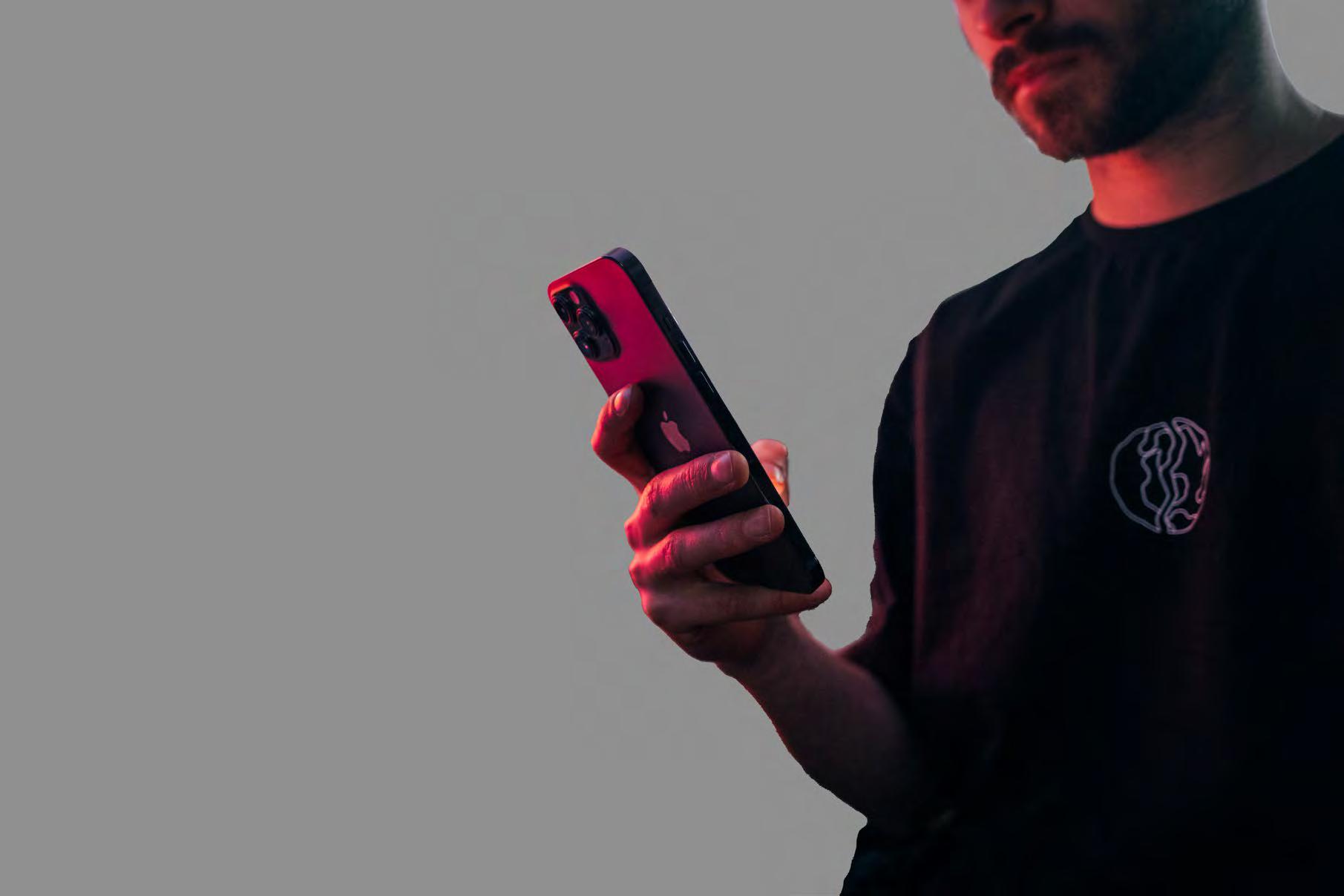
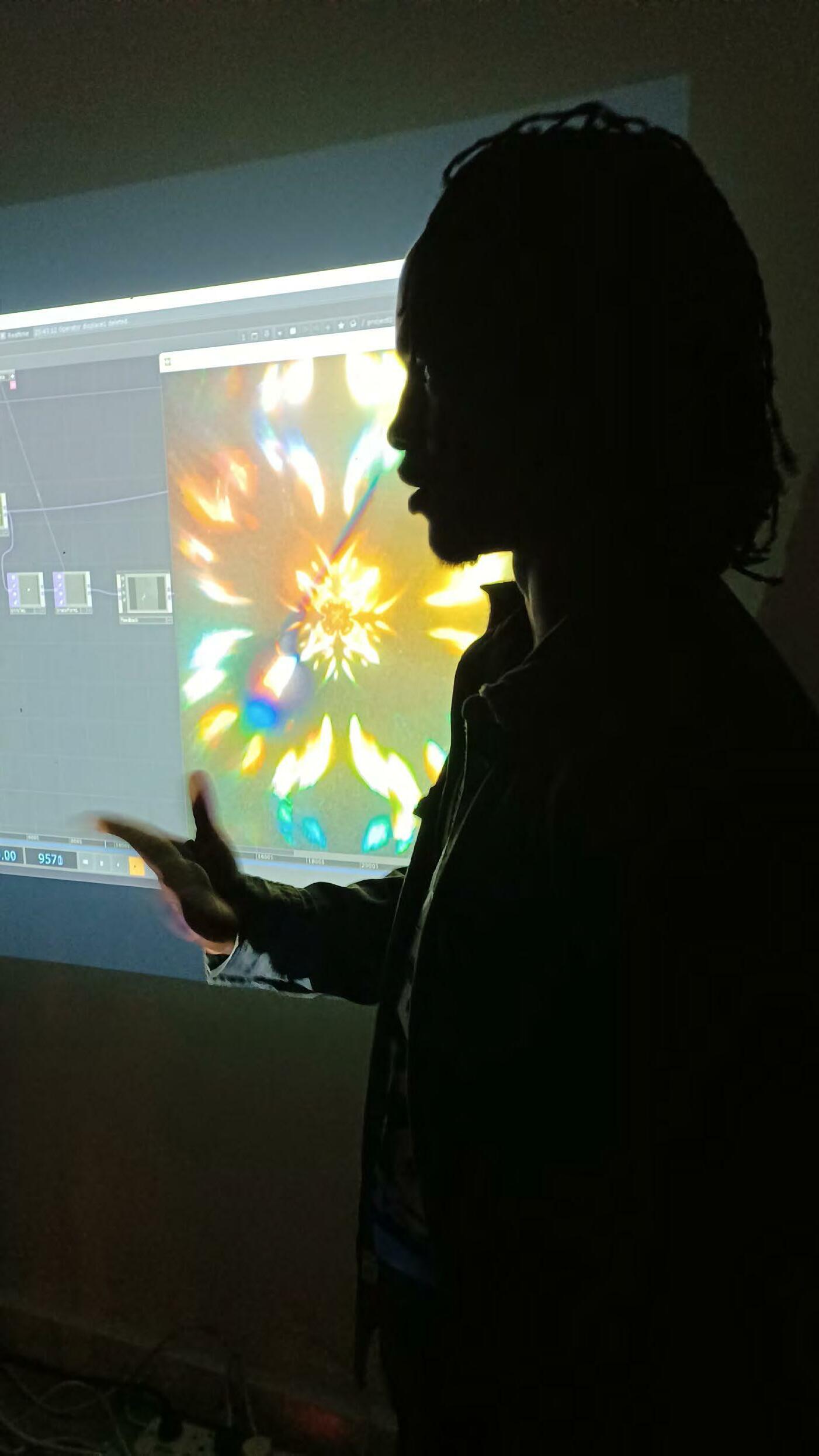
AR/VR Africa
On Twitter Facebook Instagram LinkedIn Discord
Electric South
On Twitter Facebook Instagram LinkedIn Discord
Metaverse Crew
On Twitter Facebook Instagram LinkedIn Discord
WeAReVR Africa


On Twitter Facebook Instagram LinkedIn Discord
#ImmersiveAfrica
Follow the hashtag and tag your projects on social platforms to join the conversation
Get in touch
www.Africaxrreport.com
Email: collaboration@africaxrreport.com
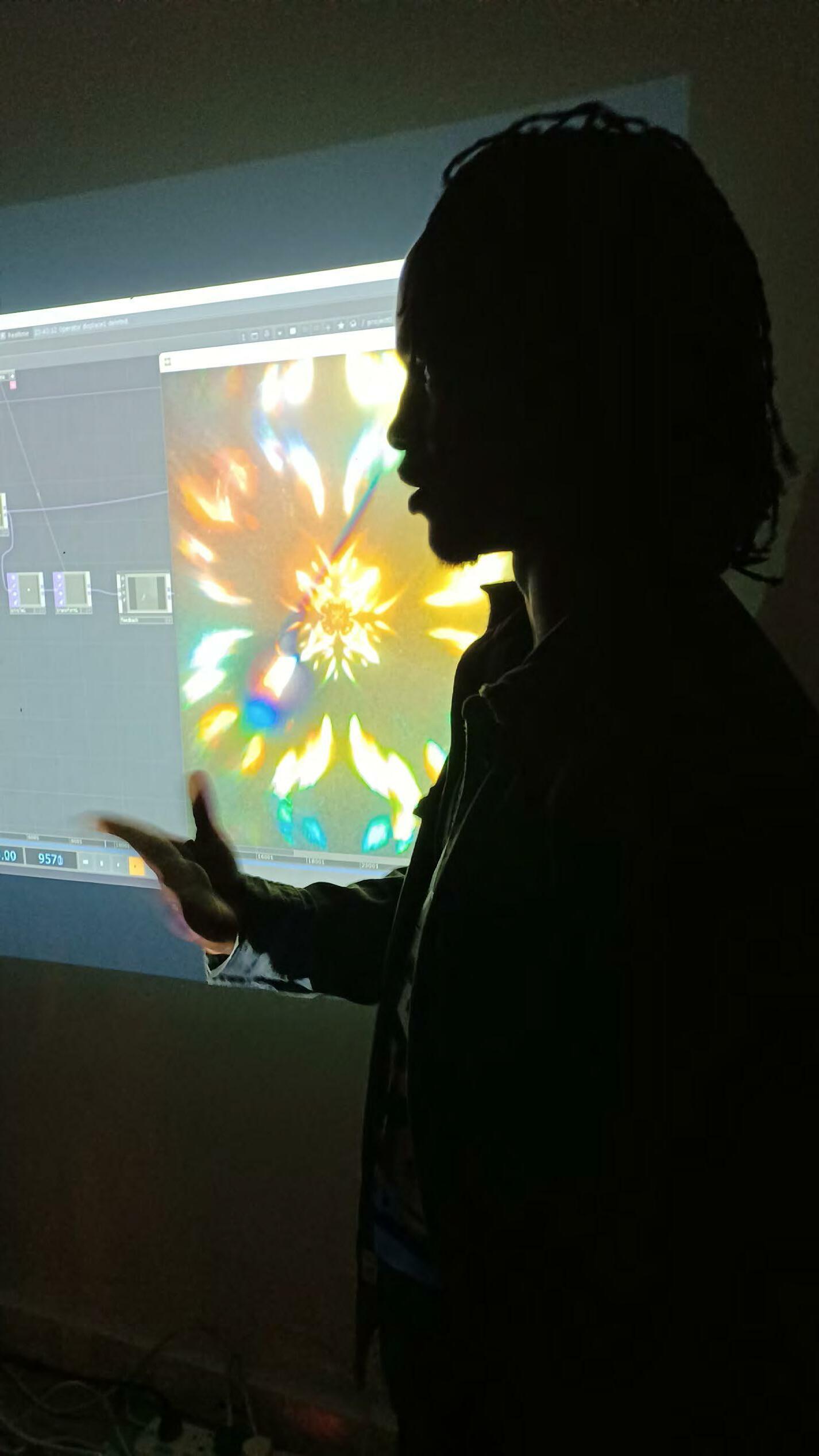
Accenture (2022). Technology Vision 2022. Web Me - Meet Me in the Metaverse. https://www.accenture.com/_acnmedia/Thought-Leadership-Assets/PDF-5/Accenture-Meet-Mein-the-Metaverse-Full-Report.pdf
Africa No Filter (2021). Focus Group Report of the African XR Ecosystem. Unpublished. November, 2021.
APO Group (2022). Africa No Filter and Meta Announce The Winners of the Future Africa Grant for Extended Reality Creators https://african.business/2022/03/apo-newsfeed/africa-no-filter-and-meta-announce-the-winnersof-the-future-africa-grant-for-extended-reality-creators

AU-EU Digital Economy Taskforce. (2019). New Africa-Europe Digital Economy Partnership : Accelerating the Achievement of the Sustainable Development Goals. https://ec.europa.eu/ international-partnerships/system/files/new-africa-eu-digital-economy_en_0.pdf
Bosworth, A., Clegg, N. (2021). Building the Metaverse Responsibly https://about.fb.com/news/2021/09/building-the-metaverse-responsibly
Cable.co.uk (2021). Worldwide mobile data pricing 2021 https://www.cable.co.uk/mobiles/worldwide-data-pricing
Carter, R. (2021). What Research Funding is Available for VR and AR? XR Today https://www.xrtoday.com/mixed-reality/what-research-funding-is-available-for-vr-and-ar/
Charlton, E (2022). 71% of executives say the Metaverse will be good for business. Here’s why. World Economic Forum Blog. https://www.weforum.org/agenda/2022/04/metaverse-will-begood-for-business/ Croll, B (2021). Industry Professionals Look to Bolster African VR Ecosystem. Variety 2021; https://variety.com/2021/digital/global/newimages-africa-vr-judith-okonkwo-1234994816/
Genesis (2022). Google’s Equiano subsea cable has landed in Lagos https://www.genesis-analytics.com/news/2022/googles-equiano-subsea-cable-has-landed-in-lagos
Google, Accenture (2022). Africa Developer Ecosystem 2021. https://nextbillionusers.google/ourresearch/africa-developer-community-2021/ IEA (2022). SDG7: Data and Projections, IEA, Paris https://www.iea.org/reports/sdg7-data-andprojections
Noble H, Heale R (2019). Triangulation in research, with examples. Evidence-Based Nursing 2019;22:67-68. https://blogs.lse.ac.uk/impactofsocialsciences/2019/06/18/using-twitter-as-a-data-sourcean-overview-of-social-media-research-tools-2019/
Oluwole, V. (2022). The Metaverse could contribute $40 billion to sub-Saharan Africa’s economy in its first decade. Africa Business Insider. https://africa.businessinsider.com/local/markets/the-metaverse-could-contributedollar40-billion-to-sub-saharan-africas-economy-in-its/0c6hx5m
Qualcomm (2022). Qualcomm Launches $100M Snapdragon Metaverse Fund https://www.qualcomm.com/news/releases/2022/03/21/qualcomm-launches-100msnapdragon-metaverse-fund
Rauschnabel, P., Felix, R., Hinsch, C., Shahab, H., Alt, F. (2022). What is XR? Towards a Framework for Augmented and Virtual Reality. Computers in Human Behaviour 133 (2022)
Sawahel, W. (2022). Universities Should Get Ready to Join the Metaverse Movement. University World News: Africa Edition. https://www.universityworldnews.com/post. php?story=20220216135957169
Statista (2022). Share of internet users in Africa 2009-2020 https://www.statista.com/ statistics/1189931/share-of-internet-users-in-africa
Hee Eun Lee, Woo Young Kim, Kangwook Han and Hyo Kang (2022). AD514: Still lacking reliable electricity from the grid, many Africans turn to other sources. Afrobarometer https://www.afrobarometer.org/publication/ad514-still-lacking-reliable-electricity-fromthe-grid-many-africans-turn-to-other-sources
The world needs fairer tech, thoughts from the 2021 GTGS in Japan on equity with advancing techn https://www.weforum.org/agenda/2021/04/a-fairer-world-requiresfairer-tech-here-is-why-gtgs/